CipherLab 1662 Bluetooth Barcode Scanner User Manual 1662 1664 Scanner User Guide
CipherLab Co., Ltd. Bluetooth Barcode Scanner 1662 1664 Scanner User Guide
manual
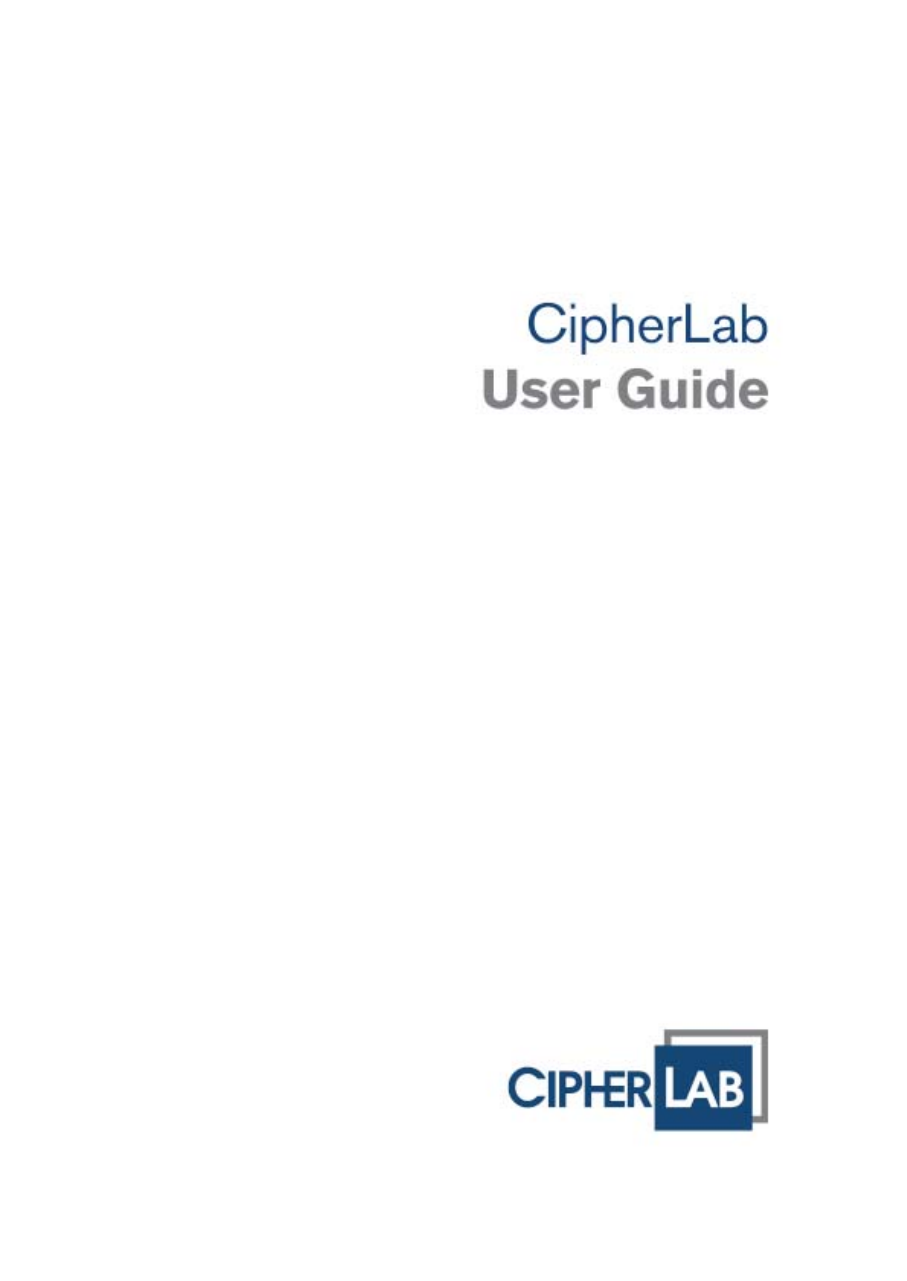
1662 L/1664 BT Barcode Scanner
Setup barcodes included.
Version 2.00

Copyright © 2011~2012 CIPHERLAB CO., LTD.
All rights reserved
The software contains proprietary information of CIPHERLAB CO., LTD.; it is provided
under a license agreement containing restrictions on use and disclosure and is also
protected by copyright law. Reverse engineering of the software is prohibited.
Due to continued product development this information may change without notice. The
information and intellectual property contained herein is confidential between CIPHERLAB
and the client and remains the exclusive property of CIPHERLAB CO., LTD. If you find
any problems in the documentation, please report them to us in writing. CIPHERLAB
does not warrant that this document is error-free.
No part of this publication may be reproduced, stored in a retrieval system, or
transmitted in any form or by any means, electronic, mechanical, photocopying,
recording or otherwise without the prior written permission of CIPHERLAB CO., LTD.
For product consultancy and technical support, please contact your local sales
representative. Also, you may visit our web site for more information.
The CipherLab logo is a registered trademark of CIPHERLAB CO., LTD.
All brand, product and service, and trademark names are the property of their registered
owners.
The editorial use of these names is for identification as well as to the benefit of the
owners, with no intention of infringement.
CIPHERLAB CO., LTD.
Website: http://www.cipherlab.com
IMPORTANT NOTICES

FOR USA
This equipment has been tested and found to comply with the limits for a Class B digital
device, pursuant to Part 15 of the FCC Rules. These limits are designed to provide
reasonable protection against harmful interference in a residential installation. This
equipment generates uses and can radiate radio frequency energy and, if not installed
and used in accordance with the instructions, may cause harmful interference to radio
communications. However, there is no guarantee that interference will not occur in a
particular installation. If this equipment does cause harmful interference to radio or
television reception, which can be determined by turning the equipment off and on, the
user is encouraged to try to correct the interference by one or more of the following
measures:
Reorient or relocate the receiving antenna.
Increase the separation between the equipment and receiver.
Connect the equipment into an outlet on a circuit different from that to which the
receiver is connected.
Consult the dealer or an experienced radio/TV technician for help.
This device complies with Part 15 of the FCC Rules. Operation is subject to the following
two conditions: (1) This device may not cause harmful interference, and (2) this device
must accept any interference received, including interference that may cause undesired
operation.
FOR CANADA
This digital apparatus does not exceed the Class B limits for radio noise emissions from
digital apparatus as set out in the interference-causing equipment standard entitled
"Digital Apparatus," ICES-003 of Industry Canada. This device complies with Part 15 of
the FCC Rules. Operation is subject to the following two conditions: (1) This device may
not cause harmful interference, and (2) this device must accept any interference received,
including interference that may cause undesired operation.
Cet appareil numerique respecte les limites de bruits radioelectriques applicables aux
appareils numeriques de Classe B prescrites dans la norme sur le material brouilleur:
"Appareils Numeriques," NMB-003 edictee par l'Industrie.

FOR HAND-HELD PRODUCT WITH RF FUNCTIONS
The 1662 L / 1664 unit (FCC ID, 1662 L : Q3N-1662; 1664 :Q3N-1664 ) complies with
FCC radiation exposure limits set forth for uncontrolled environment and meets the FCC
radio frequency (RF) Exposure Guidelines in Supplement C to OET65. The unit has very
low level of RF energy that it is deemed to comply without testing of specific absorption
ratio (SAR).
The 3610 unit (FCC ID: Q3N-3610) complies with FCC radiation exposure limits set forth
for an uncontrolled environment. This equipment should be installed and operated with
minimum distance 20 cm between the radiator & body. It only operated in hand-held
used. If only transfer data to the host cordless, please keep the minimum distance 20 cm
between machine & body.
FOR PRODUCT WITH LASER
CAUTION
This laser component emits FDA / IEC Class 2 laser light at the exit port. Do not
stare into beam.
SAFETY PRECAUTIONS
RISK OF EXPLOSION IF BATTERY IS REPLACED BY AN INCORRECT TYPE.
DISPOSE OF USED BATTERIES ACCORDING TO THE INSTRUCTIONS.
The use of any batteries or charging devices, which are not originally sold or
manufactured by CipherLab, will void your warranty and may cause damage to
human body or the product itself.
DO NOT disassemble, incinerate or short circuit the battery.
DO NOT expose the scanner or the battery to any flammable sources.
For green-environment issue, it's important that batteries should be recycled in a
proper way.
Under no circumstances, internal components are self-serviceable.
CARE & MAINTENANCE
Use a clean cloth to wipe dust off the scanning window and the body of the scanner
as well as the charging device. DO NOT use/mix any bleach or cleaner.
If you want to put away the scanner for a period of time, download the collected data
to a host computer when in the memory mode, and then take out the battery. Store
the scanner and battery separately.
When the scanner resumes its work, make sure the battery is fully charged before
use.
If you shall find the scanner malfunctioning, write down the specific scenario and
consult your local sales representative.

Version Date Notes
2.00 Mar. 20, 2012 Add: 1662 L model and Set Up Drivers License
1.03 Feb. 06, 2012 Add: Chapter 6 Fields of Time Stamp
1.02 Jan. 11, 2012 Modified: Specifications: Dimension and Weight description
1.01 Dec. 28, 2011 Add: 1.1.2 add delay note for activating the scanner from power off
mode
1.00 Nov. 30, 2011 Initial release
RELEASE NOTES

CONTENTS
IMPORTANT NOTICES ................................................................................ - 2 -
For USA .............................................................................................. - 3 -
For Canada .......................................................................................... - 3 -
For Hand-held Product with RF Functions ..................................................... - 4 -
For Product with Laser ........................................................................... - 4 -
Safety Precautions................................................................................. - 4 -
Care & Maintenance ............................................................................... - 4 -
RELEASE NOTES ....................................................................................... - 5 -
INTRODUCTION ........................................................................................... 1
Get Familiarized with 1662 L/1664 and 3610 ..................................................... 2
Install the Battery into 1662 L/1664 ............................................................ 2
Charge the Battery ................................................................................. 3
Charge the Battery via Charger .................................................................. 4
Use 3610 ............................................................................................. 5
Inside the Package .................................................................................... 6
Product Highlights ..................................................................................... 6
Symbologies Supported ............................................................................... 7
QUICK START ............................................................................................. 9
Enter Configuration Mode .......................................................................... 11
Exit Configuration Mode ............................................................................ 11
Default Settings ...................................................................................... 12
Save User Settings as Defaults ................................................................. 12
Restore User Defaults ........................................................................... 12
Restore System Defaults ........................................................................ 12
Read a Setup Barcode ............................................................................... 13
Configure Parameters ........................................................................... 13
List the Current Settings ........................................................................ 17
Create One-Scan Setup Barcodes ................................................................. 19
UNDERSTANDING THE BARCODE SCANNER ........................................................ 23
1.1 Battery ............................................................................................ 23
1.1.1 How to Operate the Scanner ............................................................ 24
1.1.2 Auto Power Off & Power-Saving ........................................................ 25
1.2 Memory ........................................................................................... 28
1.2.1 Transmit Buffer ........................................................................... 28
1.2.2 Memory Mode .............................................................................. 29
1.3 LED Indicator .................................................................................... 31
1.3.1 Good Read LED ............................................................................ 32
1.3.2 Good Read LED Duration ................................................................. 32

1662 L/1664 Barcode Scanner User Guide
1.4 Beeper ............................................................................................ 33
1.4.1 Beeper Volume ............................................................................ 34
1.4.2 Good Read Beep ........................................................................... 35
1.4.3 Low Battery Alarm ........................................................................ 36
1.5 Vibrator ........................................................................................... 36
1.5.1 Good Read Vibrator ....................................................................... 36
1.5.2 Good Read Vibrator Duration ........................................................... 36
1.6 Send “NR” to Host .............................................................................. 37
1.7 Scan Modes ....................................................................................... 38
1.7.1 Laser Mode ................................................................................. 39
1.7.2 Auto Off Mode ............................................................................. 39
1.7.3 Auto Power Off Mode ..................................................................... 39
1.7.4 Aiming Mode (1664 Only) ................................................................ 40
1.7.5 Multi-Barcode Mode ...................................................................... 40
1.7.6 Continuous Mode (1662 L Only) ......................................................... 41
1.7.7 Alternate Mode (1662 L Only) ........................................................... 41
1.8 Scanning Timeout ............................................................................... 42
1.9 Delay between Re-read ........................................................................ 43
1.10 Read Redundancy for All Symblogies ....................................................... 44
1.11 Addon Security for UPC/EAN Barcodes ..................................................... 45
1.12 Negative Barcodes ............................................................................. 45
1.13 Use Direct USB Cable ......................................................................... 46
1.13.1 Direct USB Interface .................................................................... 46
1.13.2 Disable Direct USB Interface ........................................................... 46
1.14 Picklist Mode (1664 Only) .................................................................... 47
1.15 Pager Beep Duration .......................................................................... 47
1.16 Time Stamp ..................................................................................... 48
1.16.1 DATE AND TIME SETTINGS .............................................................. 48
1.16.2 SEPARATOR FOR DATE AND TIME ...................................................... 50
1.16.3 DATE FORMAT ............................................................................ 51
1.17 2D Decode Setting (1664 Only) .............................................................. 52
1.17.1 Aiming Pattern ........................................................................... 52
1.17.2 Decoding Illumination ................................................................... 52
1.18 Hardware Reset ................................................................................ 53
1.18.1 Restore System Defaults ................................................................ 53
1.18.2 Reset Connection ........................................................................ 53
SELECTING OUTPUT INTERFACE ..................................................................... 55
2.1 Bluetooth® HID .................................................................................. 56
2.1.1 Activate Bluetooth® HID & Select Keyboard Type ................................... 57
2.1.2 Reset Connection ......................................................................... 58
2.1.3 Keyboard Settings ......................................................................... 59
2.1.4 Inter-Character Delay .................................................................... 66
2.1.5 Inter-Function Delay ...................................................................... 66
2.1.6 HID Character Transmit Mode ........................................................... 67
2.1.7 Keypad Support for iPhone/iPad ....................................................... 67
2.2 Bluetooth® SPP Slave ........................................................................... 68

1662 L/1664 Barcode Scanner User Guide
2.2.1 Activate Bluetooth® SPP Slave Mode ................................................... 68
2.2.2 Inter-Function Delay ...................................................................... 68
2.2.3 ACK/NAK Timeout ........................................................................ 69
2.3 Bluetooth® SPP Master ......................................................................... 70
2.3.1 Activate Bluetooth® SPP Master Mode ................................................. 70
2.3.2 Inter-Function Delay ...................................................................... 72
2.3.3 ACK/NAK Timeout ........................................................................ 73
2.3.4 Switch between Master/Slave Mode ................................................... 73
2.4 USB HID via 3610 ................................................................................ 74
2.4.1 Activate USB HID & Select Keyboard Type ............................................ 75
2.4.2 Keyboard Settings ......................................................................... 76
2.4.3 Inter-Character Delay .................................................................... 83
2.4.4 Inter-Function Delay ...................................................................... 83
2.4.5 HID Character Transmit Mode ........................................................... 84
2.5 USB Virtual COM via 3610 ...................................................................... 85
2.5.1 Activate USB Virtual COM ................................................................ 85
2.5.2 Inter-Function Delay ...................................................................... 85
2.5.3 ACK/NAK Timeout ........................................................................ 86
2.6 Direct USB HID ................................................................................... 87
2.6.1 Activate USB HID & Select Keyboard Type ............................................ 88
2.6.2 Keyboard Settings ......................................................................... 89
2.6.3 Inter-Character Delay .................................................................... 96
2.6.4 Inter-Function Delay ...................................................................... 96
2.6.5 HID Character Transmit Mode ........................................................... 97
2.7 Direct USB Virtual COM ........................................................................ 98
2.7.1 Activate USB Virtual COM ................................................................ 98
2.7.2 Inter-Function Delay ...................................................................... 98
2.7.3 ACK/NAK Timeout ........................................................................ 99
SET UP A WPAN CONNECTION ..................................................................... 101
3.1 Connecting via 3610 ........................................................................... 102
3.1.1 Connect to 3610 .......................................................................... 102
3.1.2 Change Interface ......................................................................... 103
3.1.3 Configure Related Settings ............................................................. 104
3.2 Connecting via Bluetooth® Dongle .......................................................... 105
3.2.1 Change Interface ......................................................................... 105
3.2.2 Configure Related Settings ............................................................. 106
3.2.3 Connect to Dongle ....................................................................... 109
SPECIFICATIONS ....................................................................................... 117

1
Update
CipherLab’s small-form-factor 1600 Series Barcode Scanners are specifically designed to
answer the mobile demands. The palm-sized scanners are designed to help accelerate
productivity while lowering the total cost of ownership. Intensive data collection jobs are
made easier with fast, accurate barcode scanning in various working environments,
especially in small businesses. Integrating short-distance cordless technology to
small-form-factor scanners, the scanners are ideal for carrying as in pocket, and thus
give workers tether-free mobility anytime anywhere and get job done more efficiently.
This line of scanners deliver data over a cordless personal network at a range of up to 10
meters and a prolonged battery life to keep business running. 1662 L/1664 is a new
ordering option provided for adapting a advanced scan engine to read both 1D and 2D
barcodes.
Owing to the compact design, extremely low power consumption, and powerful decoding
capability, the 1600 Series Barcode Scanners are the best choice for the following
applications –
Receiving in Retail
Product labeling & Tracking
Shelf Product Replenishment
Mobile Point of Sale (POS)
Mobile Inventory Management
Order Picking & Staging
Work-In-Process Tracking
Material Flow Control
Transportation & Distribution
Warehousing
Asset Management
This manual contains information on operating the scanner and using its features. We
recommend you to keep one copy of the manual at hand for quick reference or
maintenance purposes. To avoid any improper disposal or operation, please read the
manual thoroughly before use.
Thank you for choosing CipherLab products!
INTRODUCTION
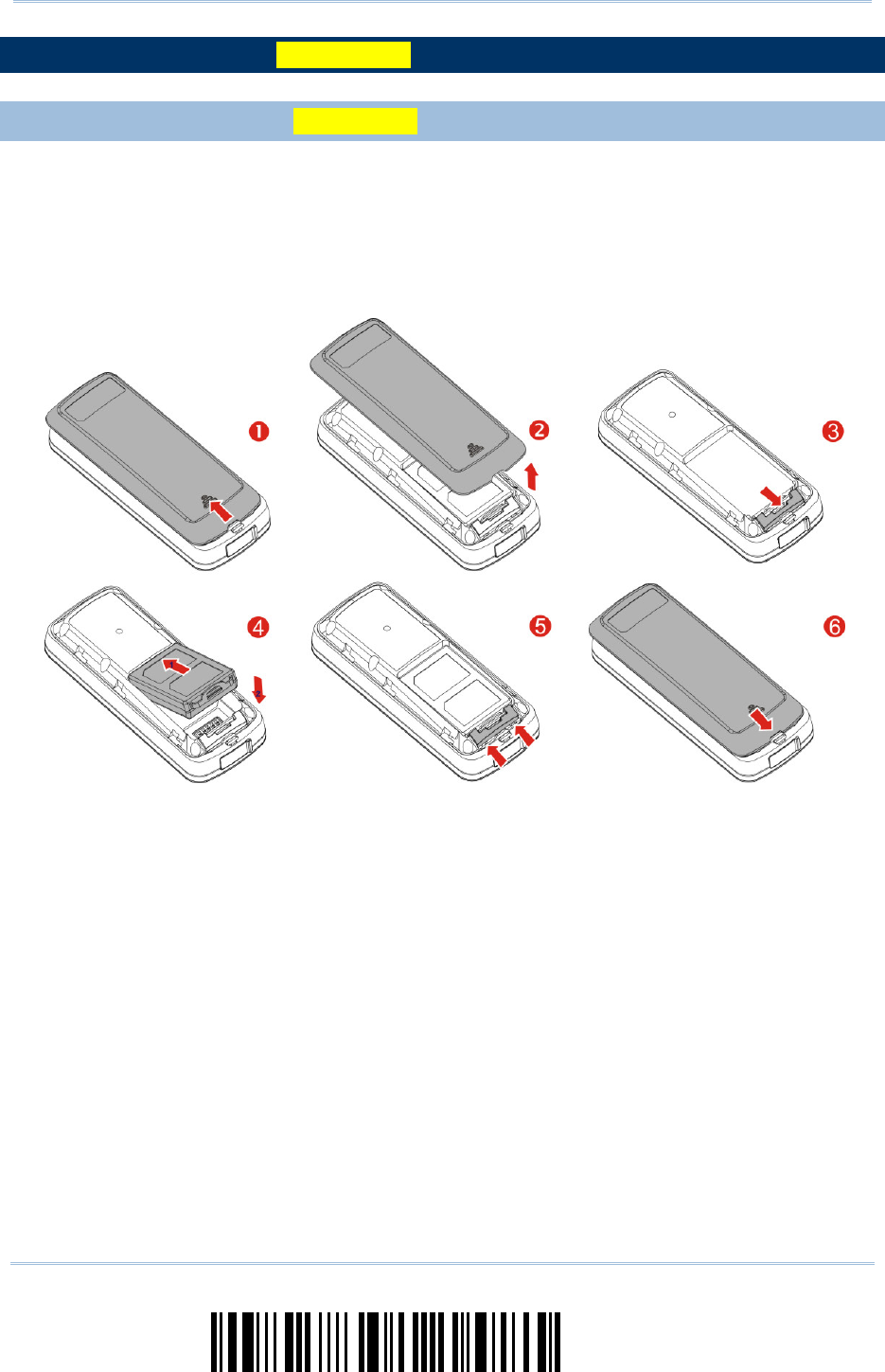
2
Enter Setup
1662 L/1664 Barcode Scanner User Guide
GET FAMILIARIZED WITH 1662 L/1664 AND 3610
INSTALL THE BATTERY INTO 1662 L/1664
1) Hold the scanner face down in one hand, press the battery cover, and slide the
battery cover.
2) Remove the battery cover.
3) Push battery lock to unlocked position.
4) Insert the battery into the battery compartment.
Install the supplied 3.7V/850mAh Li-ion battery into the battery compartment.
5) Push battery lock to lock the battery firmly.
6) Replace the battery cover.
7) Hold down the [Power/Delete] key for about 2 seconds to turn on the scanner.
The scanner will respond with a long beep (high tone) and its LED indicator will
become solid red and go off.
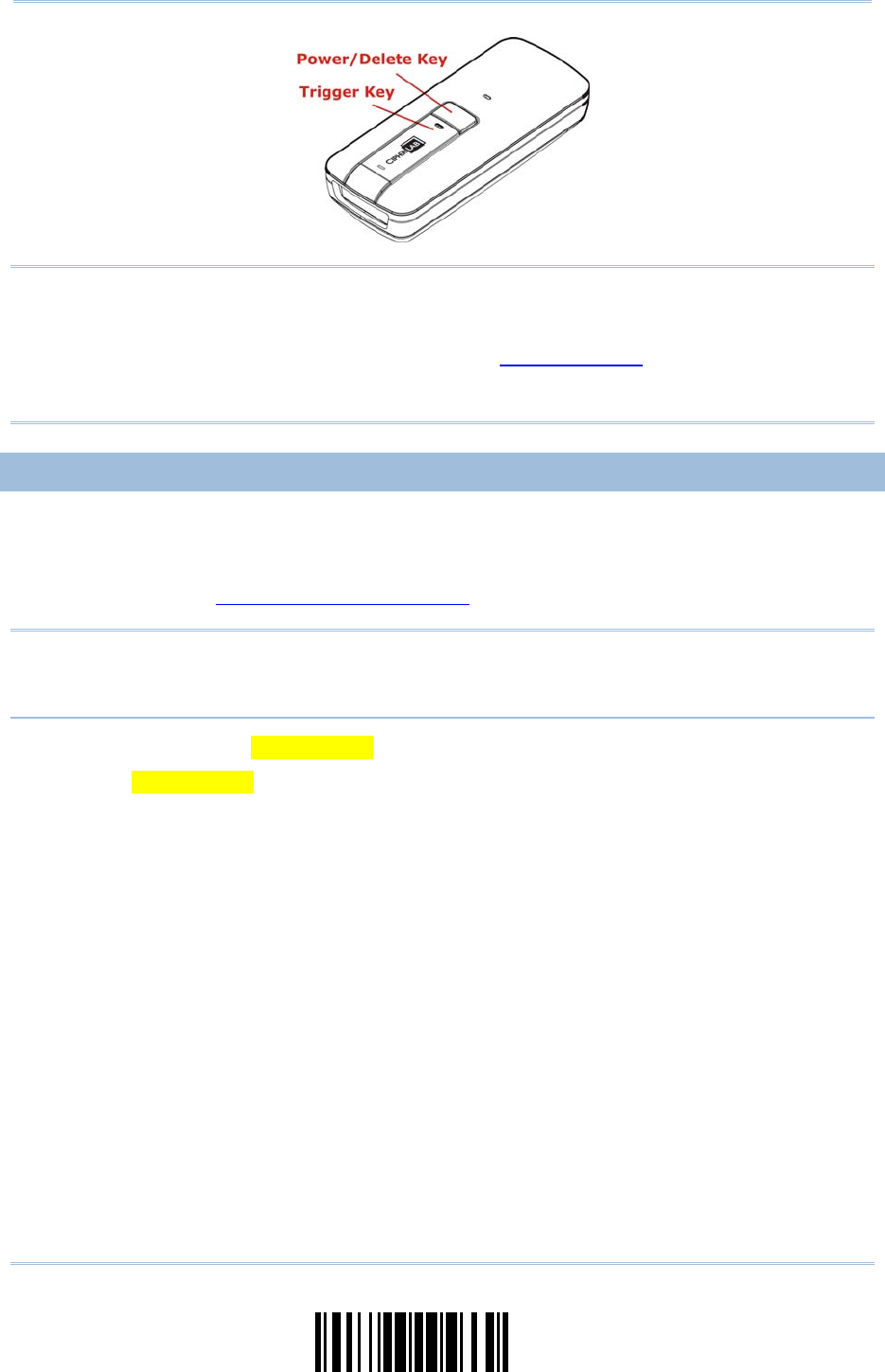
3
Update
Introduction
Note: (1) To turn off the scanner, press the [Power/Delete] key for 2 seconds. The
scanner will respond with two short beeps (high tone) and the LED will become
solid red. Release the key. Otherwise, let the scanner turn off automatically in
specific circumstances. Refer to settings of “Auto Power Off”. (2)
For shipping and storage purposes, remove the battery from the scanner. This will
keep the batteries in good condition for future use.
CHARGE THE BATTERY
The battery may not be fully charged for shipment. For initial use, it is recommended to
fully charge the battery before using the scanner. You can use the Direct USB cable to
connect the scanner to PC for charging. It takes approximately 4 hours to fully charge
the battery. Refer to 1.13 Use Direct USB Cable.
Note: Battery charging stops when the temperature drops below 0°C or exceeds 40°C. It
is recommended to charge the battery at room temperature (18°C to 25°C) for
optimal performance.
1) Install the battery to 1662 L/1664.
2) Connect 1662 L/1664 to host computer or notebook via the USB cable.
3) The scanner LED will flash red during charging.
When the charging is complete, the LED will turn off.
When charging errors occur, the LED will turn solid red.
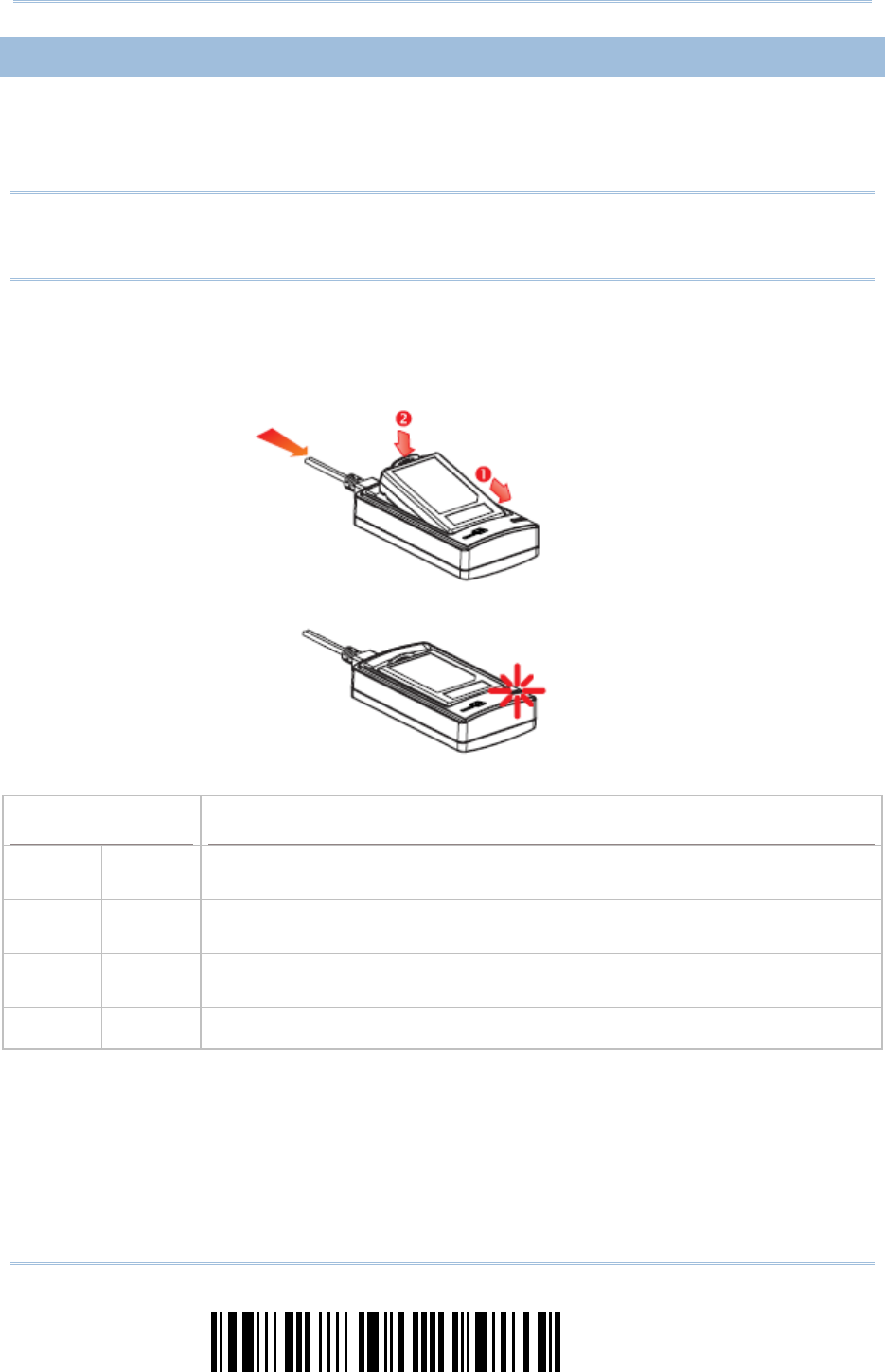
4
Enter Setup
1662 L/1664 Barcode Scanner User Guide
CHARGE THE BATTERY VIA CHARGER
The battery charger is provided for charging the battery outside of the scanner. You may
purchase the charger separately. It takes approximately 3 hours to charge the battery to
full.
Note: Battery charging stops when the temperature drops below 0°C or exceeds 40°C. It
is recommended to charge the battery at room temperature (18°C to 25°C) for
optimal performance.
1) Insert the battery.
2) Connect the power supply cord to the charger.
3) Connect the other end of the power cord to a suitable power outlet.
Status LED Meaning
Red,
solid --- Charger power ON (LED on for 0.5 second)
Red,
solid --- Charging battery
--- Green,
solid Charging done
--- --- Power or battery not ready
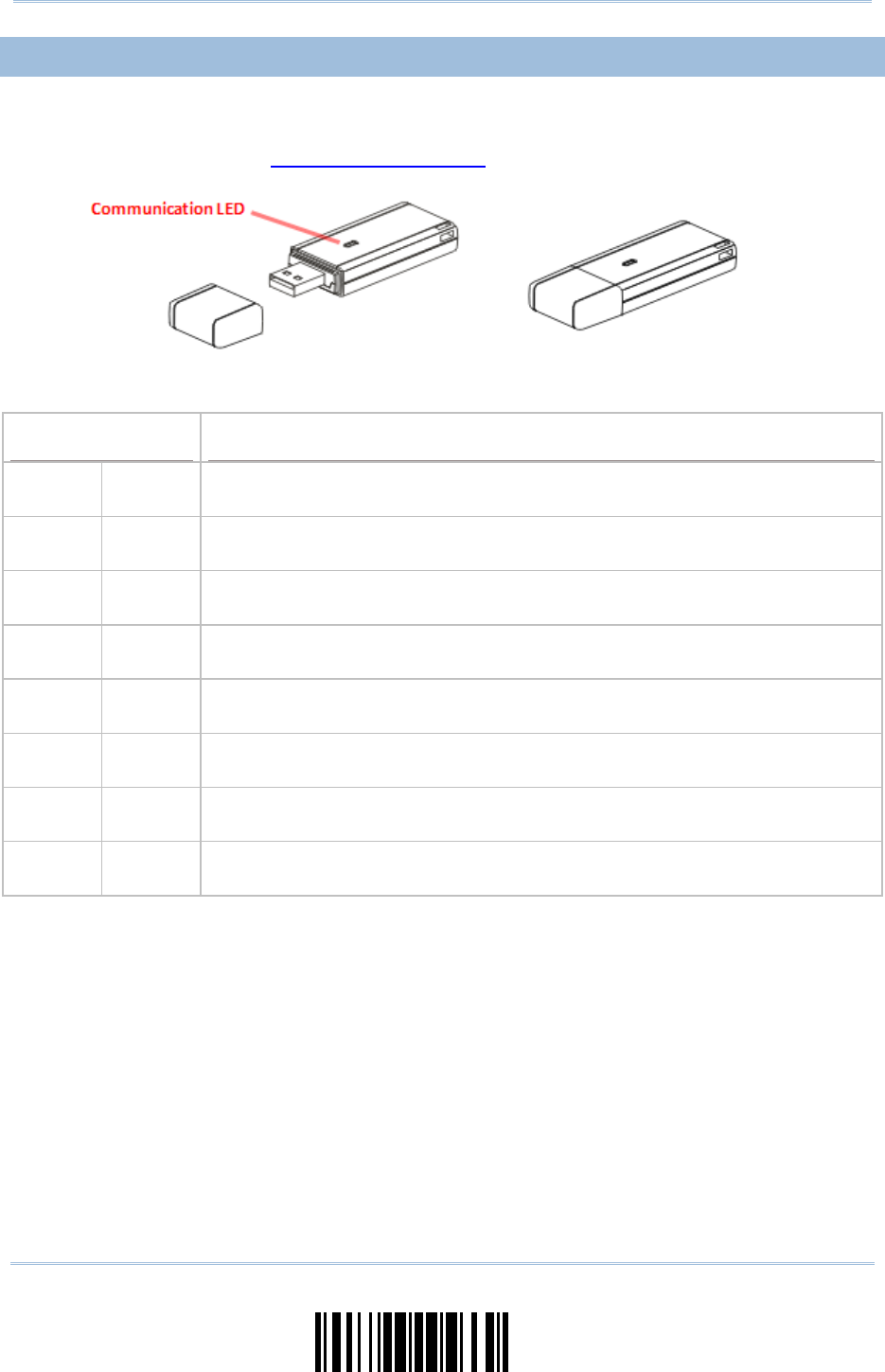
5
Update
Introduction
USE 3610
The CipherLab Dongle (3610) is specifically designed for the scanner to communicate
with a host computer cordless. The connection between the scanners and 3610 is made
easy and reliable. Refer to 3.1.1 Connect to 3610.
There is one LED indicator provided for communications status.
Communication LED Meaning
--- Blue,
solid Initialize
Red,
solid --- Failed to establish a USB connection
Red,
solid Blue,
flashing Serial command mode with USB Virtual COM: wait 3 seconds for starting a
serial command
Red,
flashing Blue,
flashing Serial command mode with USB HID: wait 3 seconds for pressing [Num
Lock] or [Caps Lock] 5 times via keyboard
--- Blue,
flashing Wait for connection request from the scanner (Slow flash at 0.5 Hz)
--- Blue,
flashing Connected with the scanner (Fast flash at 1 Hz)
Red,
solid Blue,
flashing Failed to send data to host via USB Virtual COM (Fast flash at 1 Hz)
Red,
flashing --- Enter Download Mode
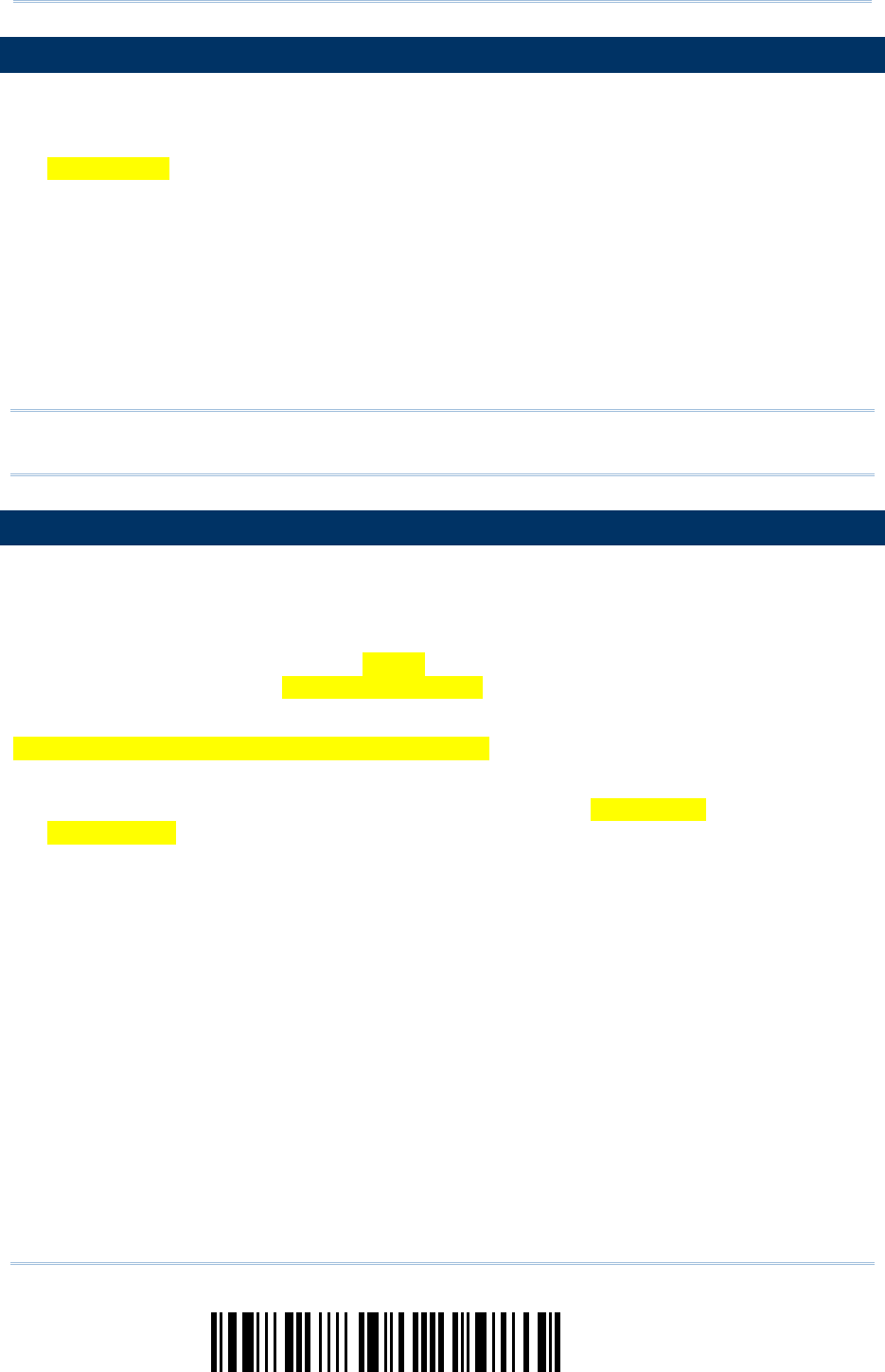
6
Enter Setup
1662 L/1664 Barcode Scanner User Guide
INSIDE THE PACKAGE
The items included in the package may be different, depending on your order. Save the
box and packaging material for future use in case you need to store or ship the scanner.
1662 L/1664 Scanner
CipherLab Dongle (3610) Optional
Rechargeable Li-ion Battery Pack
Direct USB Cable
Wristband
Setup Cards
Quick Start Guide
Product CD
Note: The CD-ROM includes this manual and Windows-based ScanMaster software for
configuration, as well as the USB Virtual COM driver.
PRODUCT HIGHLIGHTS
Small-form-factor and built tough to survive drop test.
Extremely low power consumption.
Firmware upgradeable.
Support most popular barcode 1D/2D symbologies, including GS1-128 (EAN-128),
GS1 DataBar (RSS), etc (2D is for 1664 only).
Support negative barcodes.
Support US driver license decode (1664 only).
Support a variety of 2D symbologies, Time Stamp and Paging function.
Support different scan modes, including Aiming Mode (1664 only), Alternate Mode
(1662 L only) and Multi-Barcode Mode Note.
User feedback via LED indicator, beeper and vibrator.
Beeping tone and duration programmable for Good Read.
4MB flash memory for Memory Mode operation, storing over 240,000 scans based on
EAN-13 barcodes.
Provides up to 10 KB SRAM for reserve buffer while getting out of range over a
wireless personal area network (WPAN), storing up to 640 scans based on EAN-13
barcodes.
Capable of transmitting scanned data, emulating a serial cable (Bluetooth® SPP) or as
keyboard input (Bluetooth® HID), to a notebook computer or PDA with Bluetooth®
wireless technology.
Programmable parameters include data output format, editing format, symbologies.
Easy configuration through ScanMaster.
Easy connection through CipherConnect, available via online marketplace for mobile
devices running on Android 2.x, BlackBerry 5.x, or Windows Mobile 6.x.
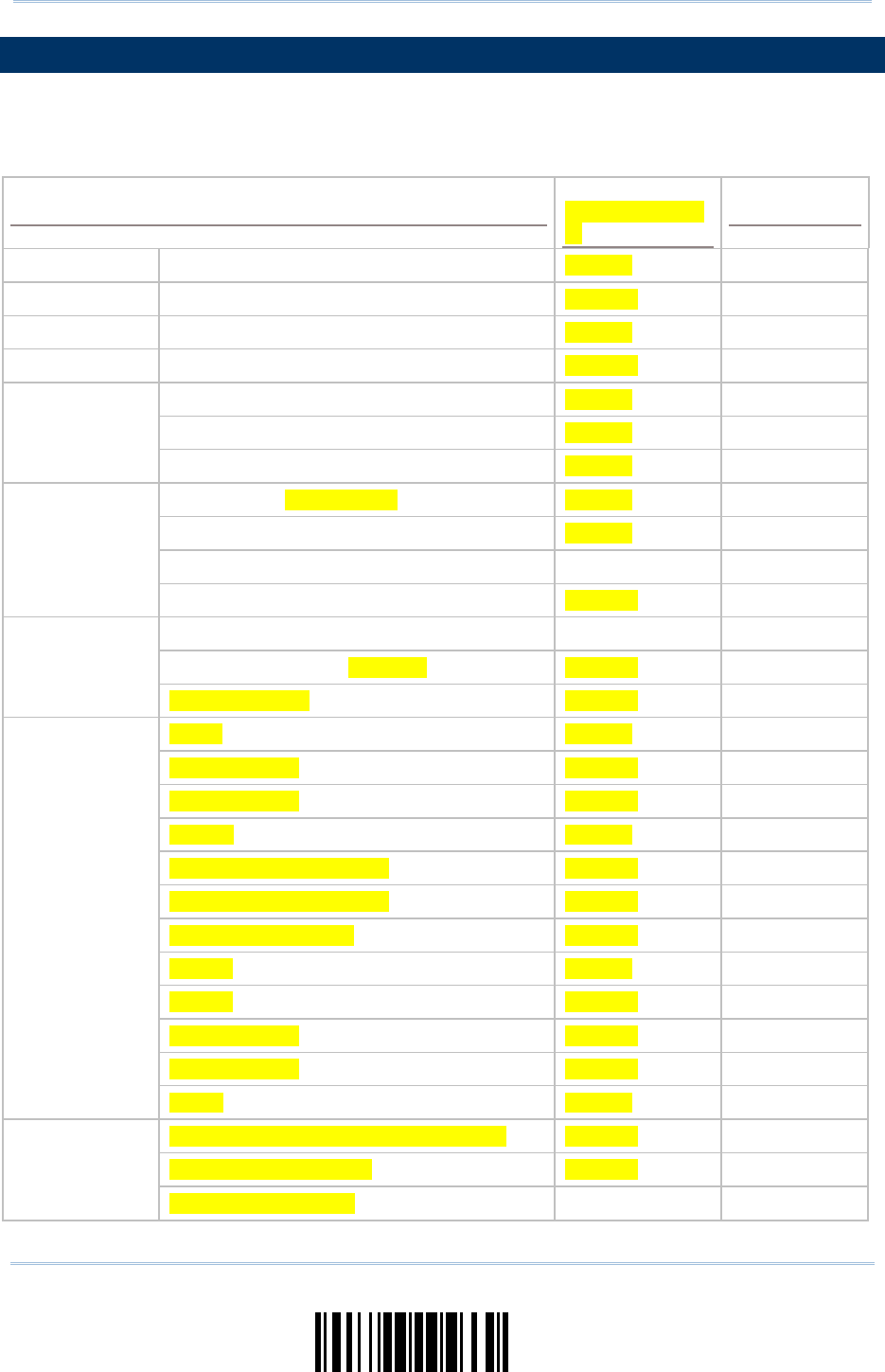
7
Update
Introduction
SYMBOLOGIES SUPPORTED
Most of the popular barcode symbologies are supported, as listed below. Each can be
individually enabled or disabled. The scanner will automatically discriminate and
recognize all the symbologies that are enabled.
Symbologies Supported: Enable/Disable 1D Laser (1662
L) 2D (1664)
Codabar Enabled Enabled
Code 11 Disabled Disabled
Code 93 Enabled Enabled
MSI Disabled Disabled
Code 128 Code 128 Enabled Enabled
GS1-128 (EAN-128) Enabled Enabled
ISBT 128 Enabled Enabled
Code 2 of 5 Industrial 25 (Discrete 25) Enabled Enabled
Interleaved 25 Enabled Enabled
Matrix 25 Disabled
Chinese 25 Disabled Disabled
Code 3 of 9 Code 39 Enabled Enabled
Italian Pharmacode (Code 32) Disabled Disabled
Trioptic Code 39 Disabled Disabled
EAN/UPC EAN-8 Enabled Enabled
EAN-8 Addon 2 Disabled Disabled
EAN-8 Addon 5 Disabled Disabled
EAN-13 Enabled Enabled
EAN-13 & UPC-A Addon 2 Disabled Disabled
EAN-13 & UPC-A Addon 5 Disabled Disabled
Bookland EAN (ISBN) Disabled Disabled
UPC-E0 Enabled Enabled
UPC-E1 Disabled Disabled
UPC-E Addon 2 Disabled Disabled
UPC-E Addon 5 Disabled Disabled
UPC-A Enabled Enabled
GS1 DataBar
(RSS) GS1 DataBar Omnidirectional (RSS-14) Disabled Disabled
GS1 DataBar Truncated Disabled Disabled
GS1 DataBar Stacked Disabled
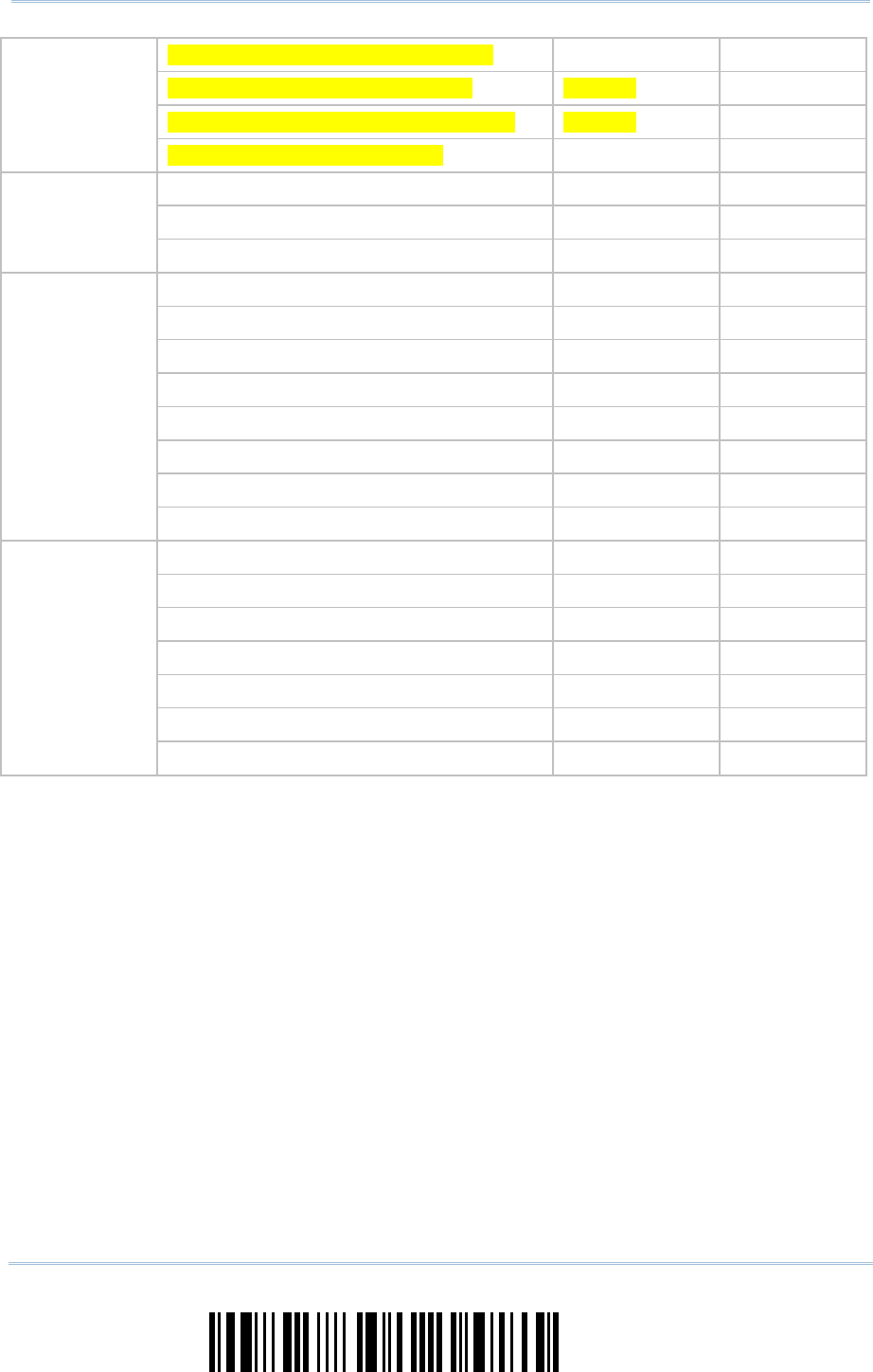
8
Enter Setup
1662 L/1664 Barcode Scanner User Guide
GS1 DataBar Stacked Omnidirectional Disabled
GS1 DataBar Limited (RSS Limited) Disabled Disabled
GS1 DataBar Expanded (RSS Expanded) Disabled Disabled
GS1 DataBar Expanded Stacked Disabled
Composite
Code Composite CC-A/B Disabled
Composite CC-C Disabled
Composite TLC-39 Disabled
Postal Code US Postnet Enabled
US Planet Enabled
UK Postal Enabled
Japan Postal Enabled
Australian Postal Enabled
Dutch Postal Enabled
USPS 4CB/One Code/Intelligent Mail Disabled
UPU FICS Postal Disabled
2D
Symbologies PDF417 Enabled
MicroPDF417 Disabled
Data Matrix Enabled
Maxicode Enabled
QR Code Enabled
MicroQR Enabled
Aztec Enabled
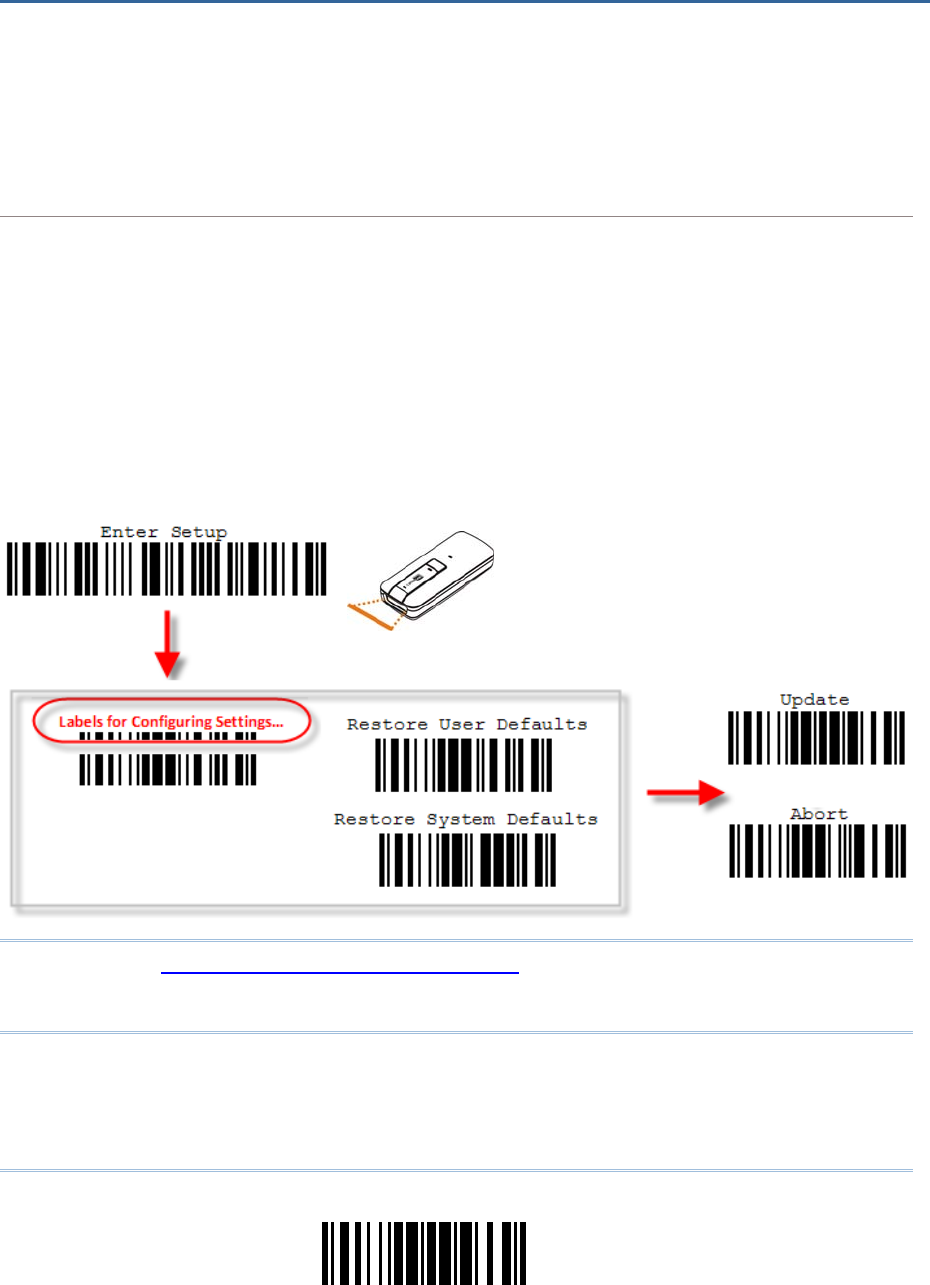
9
Update
The configuration of the scanner can be done by reading the setup barcodes contained in
this manual or via the ScanMaster software.
This section describes the procedure of configuring the scanner by reading the setup
barcodes and provides some examples for demonstration.
Configuration Mode
1) Hold down the [Power/Delete] key for 2 seconds to turn on the scanner. It will respond with a
long beep and its LED will come on-off.
2) Read the “Enter Setup” barcode. It will respond with six beeps and its LED indicator will
become flashing red after reading the barcode.
3) Read more setup barcodes… Most of the setup barcodes are normal, and the scanner will
respond with two beeps (low-high tone). For special setup barcodes, it requires reading more
than one setup barcode to complete the setting.
4) Read the “Update” or “Abort” barcode. It will respond with six beeps and its LED indicator will
become flashing red after reading the barcode.
5) The scanner will restart automatically upon reading the “Update” or “Abort” barcode. It will
respond with a long beep and its LED will come on-off.
Note: Refer to Appendix II Host Serial Commands for how to configure the 3610 dongle
by having the scanner read 3610-related setup barcodes or using serial
commands.
QUICK START
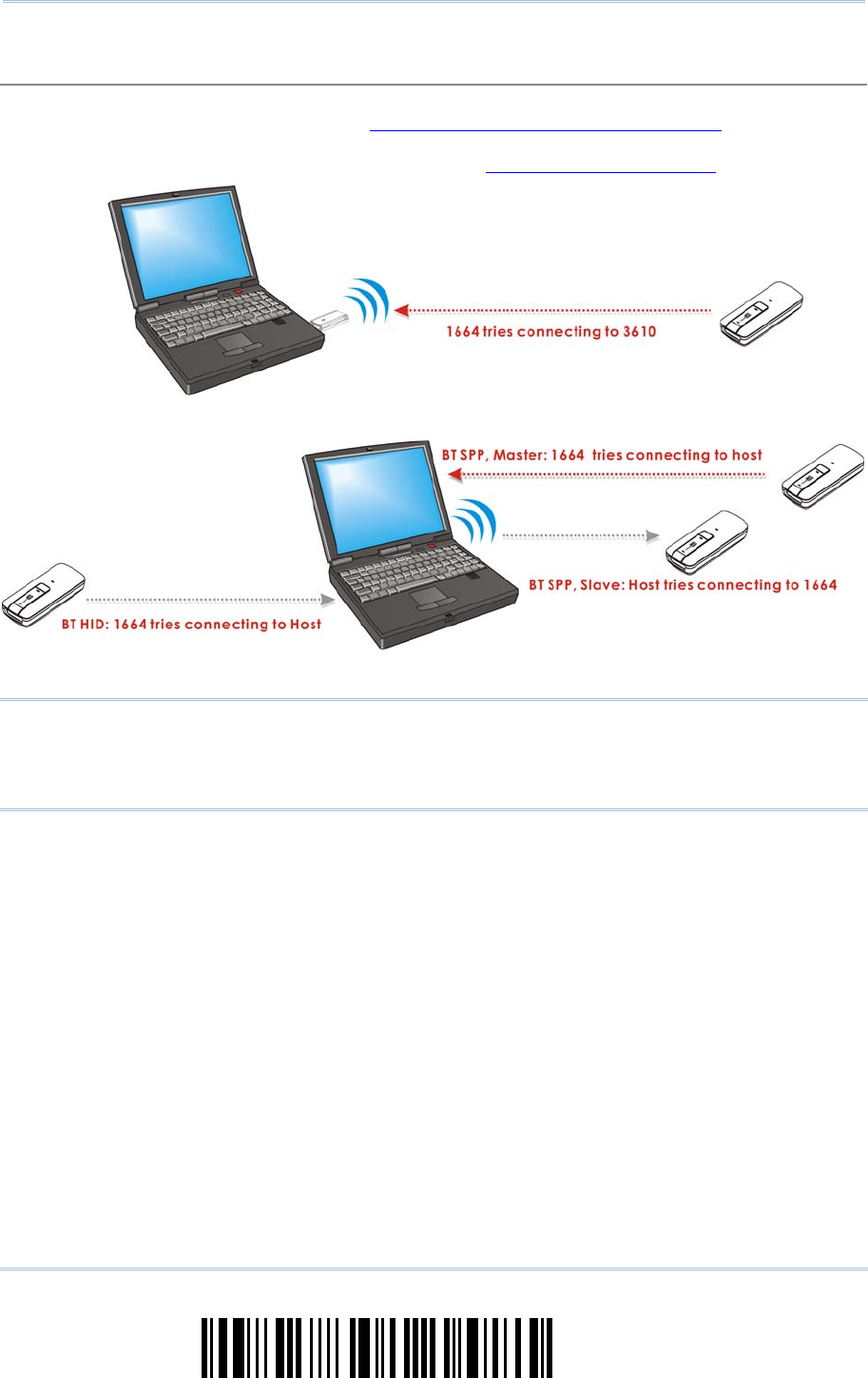
10
Enter Setup
1662 L/1664 Barcode Scanner User Guide
Working Mode
Upon powering up, the scanner will try to establish a connection with 3610 or a computer with
Bluetooth® wireless technology. Refer to Chapter 3 - Set up a WPAN Connection for details. The
connection between the scanners and 3610 is made easy and reliable. Now, it also supports
Bluetooth® SPP Master Mode as an alternative. Refer to 2.3 Bluetooth® SPP Master.
Note: If USB Virtual COM or Bluetooth® SPP is selected for output interface, the host can
directly send serial commands to configure the scanner. For example, run
HyperTerminal.exe and type the 6-digit command located under each setup
barcode.
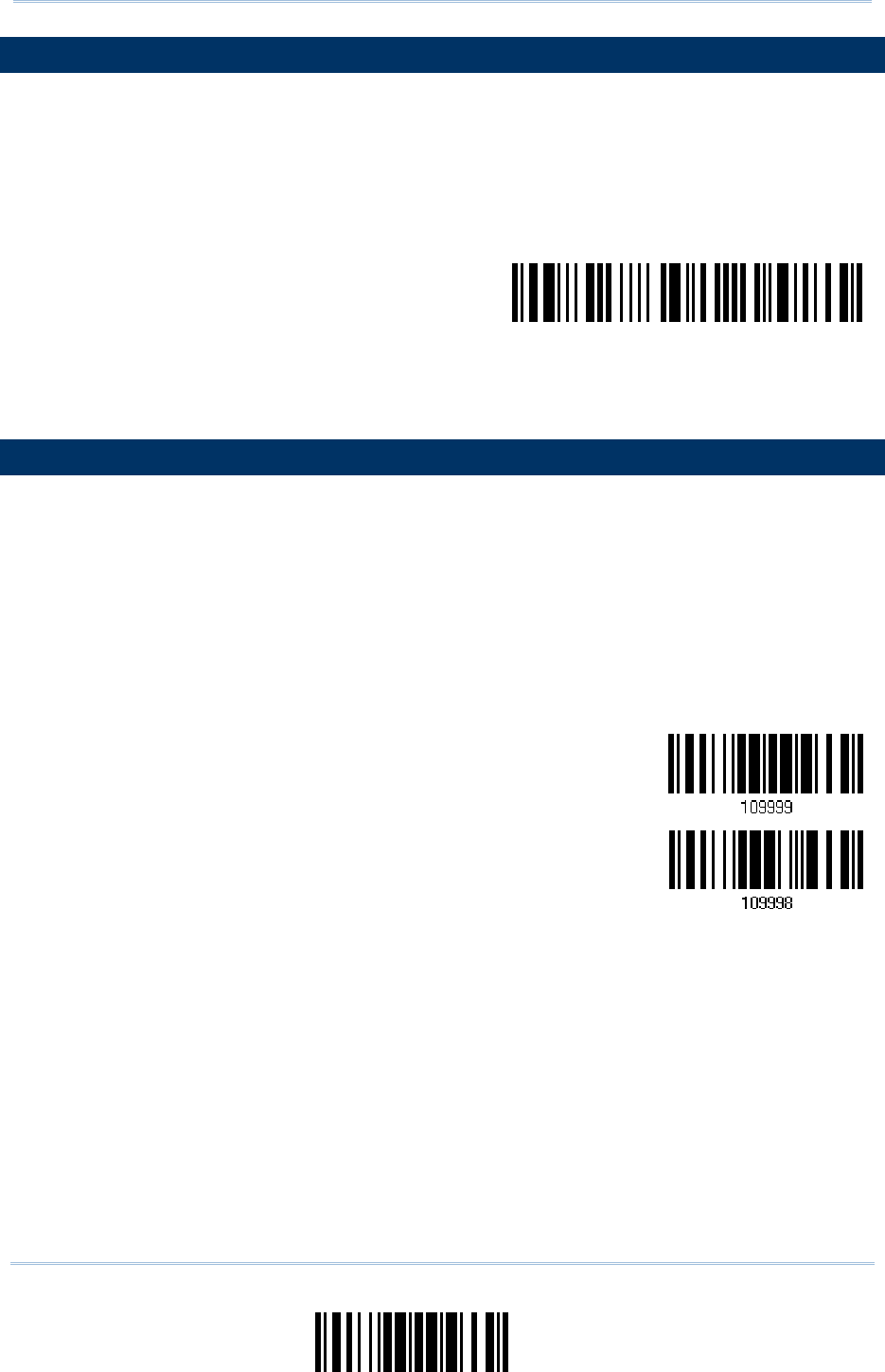
11
Update
Quick Start
ENTER CONFIGURATION MODE
For the scanner to enter the configuration mode, read the "Enter Setup" barcode, which
can be located at the bottom of almost every even page of this manual.
The scanner will respond with six beeps and its LED indicator will become flashing red
after reading the barcode.
Enter Setup
For configuring scanner parameters, see “Read a Setup Barcode” below.
EXIT CONFIGURATION MODE
For the scanner to save settings and exit the configuration mode, read the “Update”
barcode, which can be located at the bottom of almost every odd page of this manual.
Exit the configuration mode without saving any changes; read the “Abort” barcode
instead.
Just like reading the “Enter Setup” barcode, the scanner will respond with six beeps
and its LED indicator will become flashing red after reading the barcode. Wait for a
few seconds for the scanner to restart itself.
Update
Abort
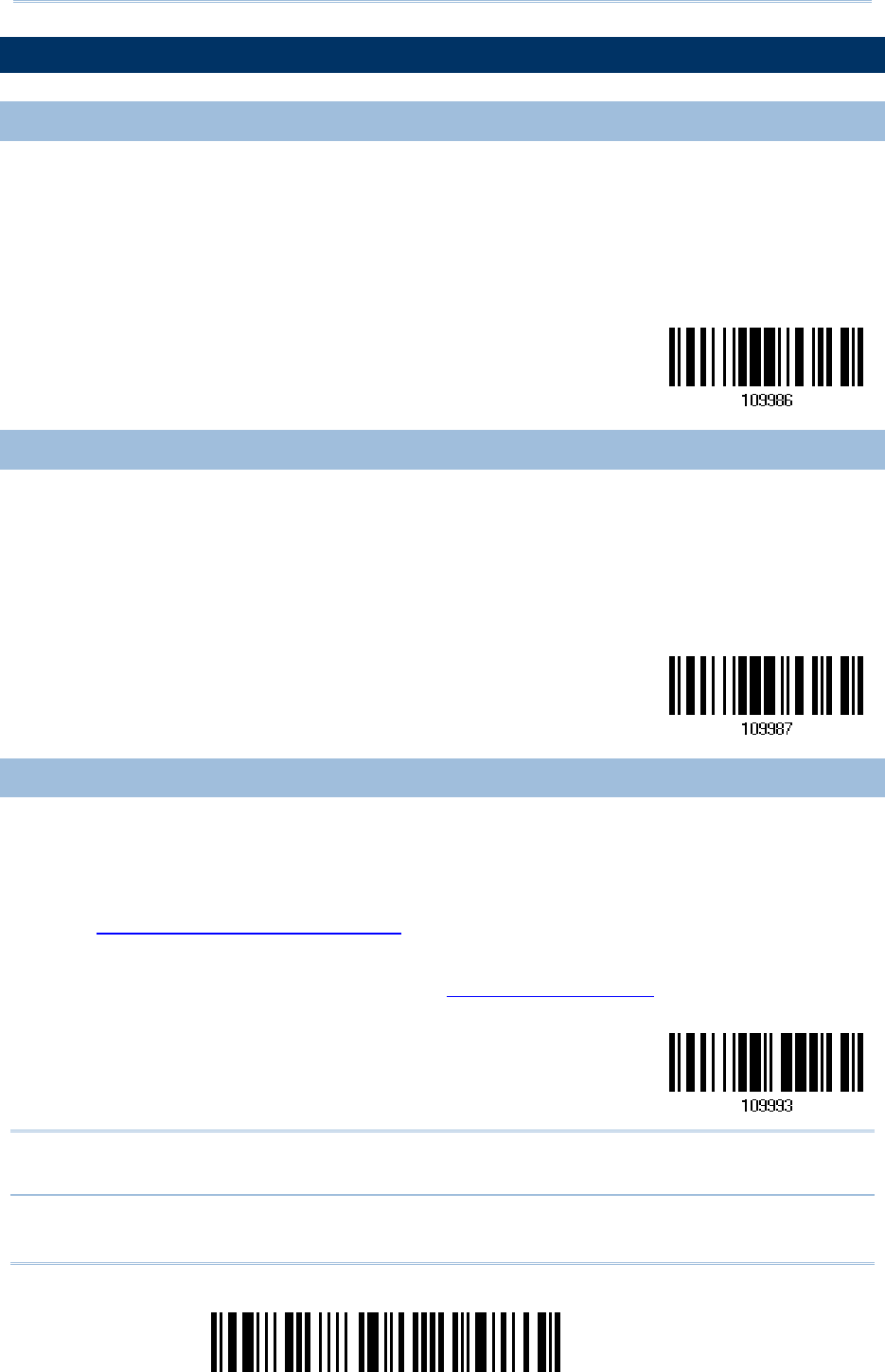
12
Enter Setup
1662 L/1664 Barcode Scanner User Guide
DEFAULT SETTINGS
SAVE USER SETTINGS AS DEFAULTS
For the scanner to keep the customized settings as user defaults, you must read the
“Save as User Defaults” barcode. This is a normal setup barcode, and the scanner will
respond with two beeps (low-high tone).
After reading the “Update” barcode, the current settings will be saved as user
defaults.
S
ave as User
Defaults
RESTORE USER DEFAULTS
For the scanner to restore the user defaults, which you have saved earlier, you must
read the “Restore User Defaults” barcode. This is a normal setup barcode, and the
scanner will respond with two beeps (low-high tone).
After reading the “Update” barcode, all the parameters of the scanner will return to
their customized values.
Restore User
Defaults
RESTORE SYSTEM DEFAULTS
For the scanner to restore the factory defaults, read the “Restore System Defaults”
barcode. This is a normal setup barcode, and the scanner will respond with two beeps
(low-high tone). After reading the “Update” barcode, all the parameters of the scanner
will return to their default values. The current connection record will be cleared as well.
Refer to 1.18.1 Restore System Defaults for the key combination used to restore defaults
during operation.
For 3610 to restore factory defaults, refer to 錯誤! 找不到參照來源。.
Restore System
Defaults
Note: The system default value (if there is one) for each setting is indicated by an
asterisk “*”.
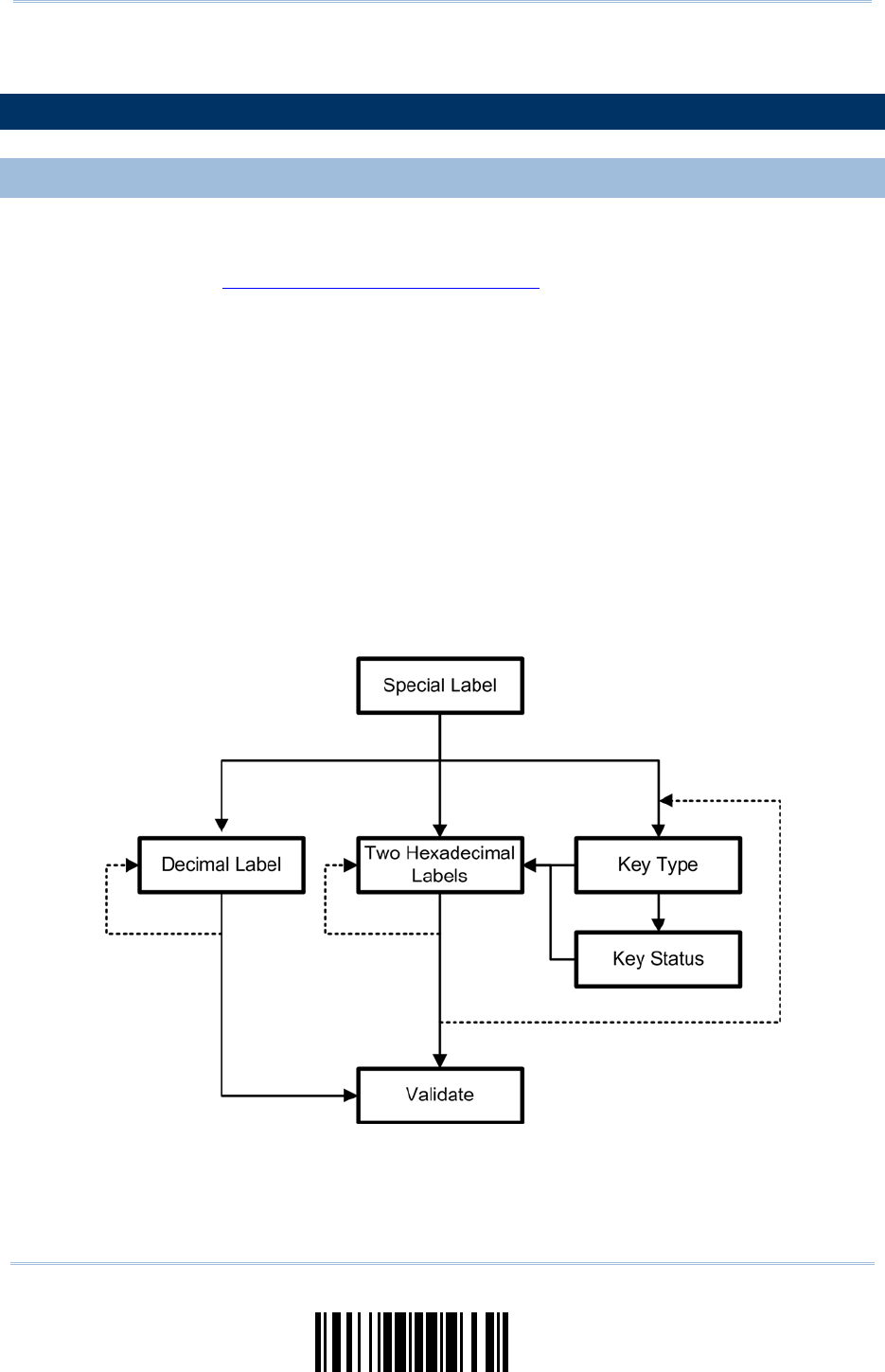
13
Update
Quick Start
READ A SETUP BARCODE
CONFIGURE PARAMETERS
For most of the scanner parameters, only one read is required to set them to new values.
The scanner will respond with two beeps (low-high tone) when each parameter is set
successfully. Refer to Create One-Scan Setup Barcodes.
But for a number of special parameters, multiple reads are required to complete the
setting. In this case, the scanner will respond with a short beep to indicate it needs to
read more setup barcodes. These special parameters may require reading one or more
setup barcodes, such as
Numeric barcodes, say, for keyboard type, inter-character delay, length qualification
Hexadecimal barcodes, say, for character strings as prefix, suffix, etc.
When “Bluetooth® HID” or “USB HID” is configured for interface, Key Type and Key
Status will then become applicable. Decide whether to change key status when
“Normal Key” is selected for Key Type.
To complete the configuration of these special parameters, it requires reading the
“Validate” barcode, and the scanner will respond with two beeps (low-high tone) to
indicate the input values are validated.
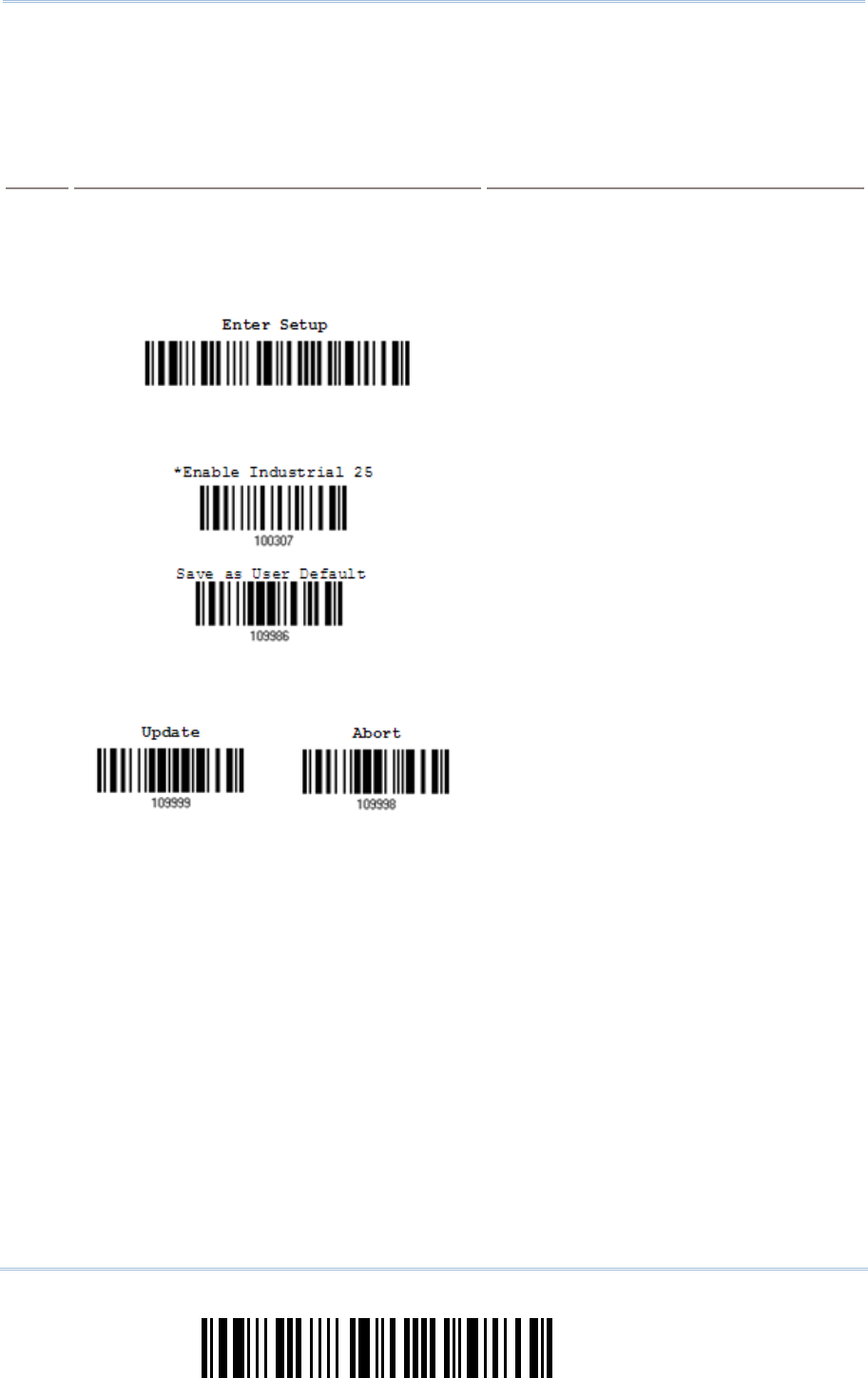
14
Enter Setup
1662 L/1664 Barcode Scanner User Guide
The example below shows how to save your settings as “User Default” so that you may
restore user defaults at a later time:
Steps Action User Feedback if Successful
1) Power on the scanner…
T
he scanner will respond with a long beep
(high tone) and its LED indicator will
become solid red and go off.
2) Enter the Configuration Mode…
T
he scanner will respond with six beeps
(high-low tone repeats three times), and
its LED indicator will be flashing red.
3) Read a Setup barcode…
For example,
T
he scanner will respond with two beeps
(low-high tone) if reading a normal setup
barcode.
4) Exit the Configuration Mode…
OR
Same as for Enter the Configuration Mode.
5) The scanner will automatically restart itself… Same as for Power on the scanner.
* When any configuration error occurs...
T
he scanner will respond with one long
beep (low tone).
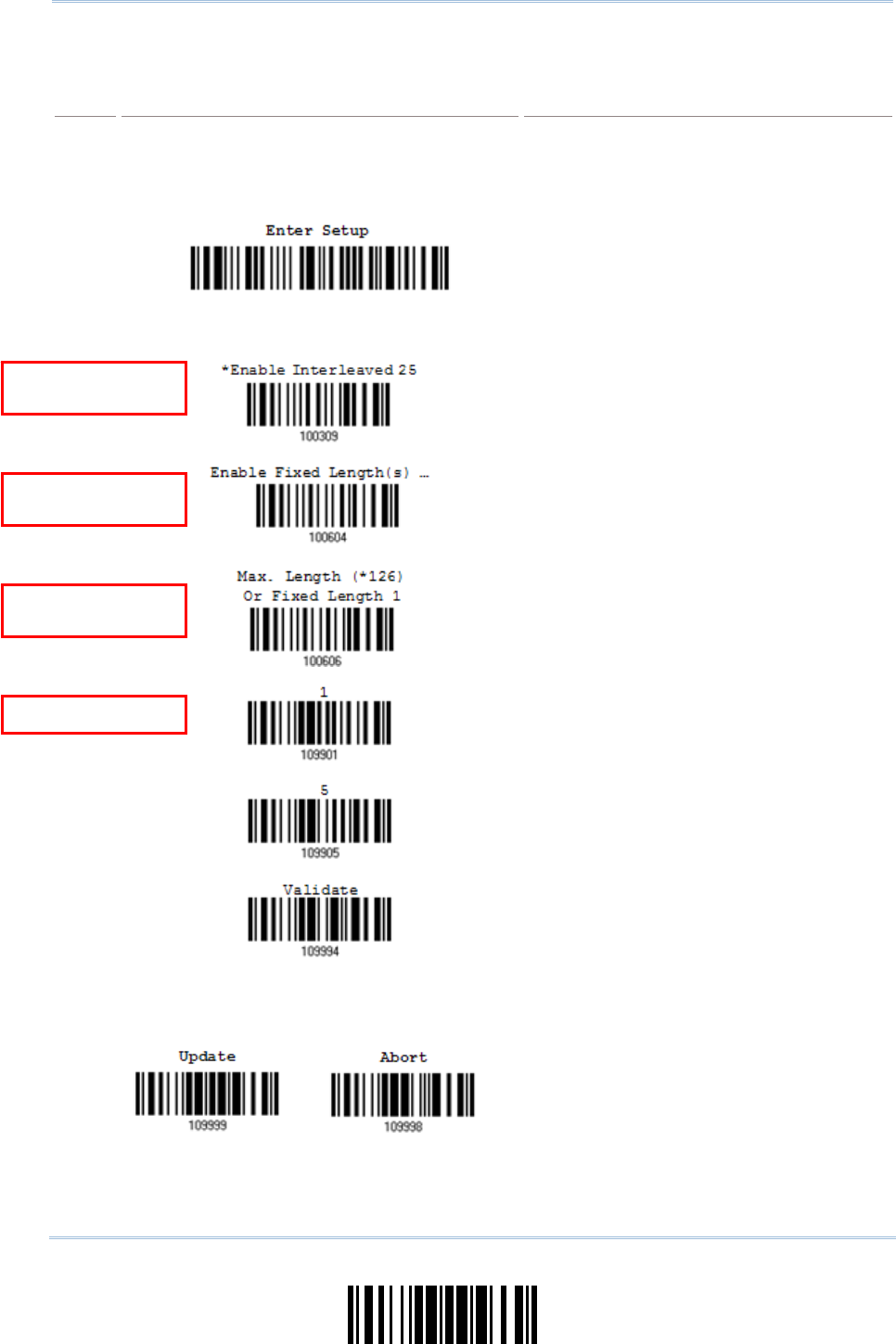
15
Update
Quick Start
The example below shows how to set numeric parameters:
Steps Action User Feedback if Successful
1) Power on the scanner... The scanner will respond with a long beep
(high tone) and its LED indicator will
become solid red and go off.
2) Enter the Configuration Mode…
T
he scanner will respond with six beeps
(high-low tone repeats three times), and
its LED indicator will become flashing red.
3) Read a Setup barcode...
For example,
T
he scanner will respond with two beeps
(low-high tone) if reading a normal setup
barcode.
T
he scanner will respond with one short
beep if reading a special setup barcode
such as “Max. Length”, indicating the
setup requires reading more barcodes.
Read the “Decimal Value” barcode(s).
T
he scanner will respond with two beeps
(low-high tone) when the input values are
validated.
4) Exit the Configuration Mode…
OR
Same as for Enter the Configuration Mode.
5) The scanner will automatically restart itself… Same as for Power on the scanner.
N
ormal setup
barcode
N
ormal setup
barcode
Special setup
barcode
Decimal barcodes

16
Enter Setup
1662 L/1664 Barcode Scanner User Guide
The example below shows how to set string parameters:
Steps Action User Feedback if Successful
1) Power on the scanner... The scanner will respond with a long beep
(high tone) and its LED indicator will
become solid red and go off.
2) Enter the Configuration Mode…
T
he scanner will respond with six beeps
(high-low tone repeats three times), and
its LED indicator will become flashing red.
3) Read a Setup barcode...
For example,
T
he scanner will respond with one short
beep if reading a special setup barcode
such as “Prefix Code”, indicating the setup
requires reading more barcodes.
When “Bluetooth® HID” or “USB HID” is
configured for interface, Key Type and Key
Status will then become applicable. You
may decide whether or not to change key
status when “Normal Key” is selected for
Key Type.
Read the “Hexadecimal Value” barcodes
for the desired character string. For
example, read “2” and “B” for the scanner
to prefix the character “+”.
The scanner will respond with two beeps
(low-high tone) when the input values are
validated.
4) Exit the Configuration Mode…
OR
Same as for Enter the Configuration Mode.
5) The scanner will automatically restart itself… Same as for Power on the scanner.
Special setup
barcodes
Hexadecimal
barcodes

17
Update
Quick Start
LIST THE CURRENT SETTINGS
The current settings of all scanner parameters can be sent to the host computer for user
inspection. The listing includes pages as shown below. You can select the page of interest
by having the scanner read the “List Page x” barcode. The scanner will respond with two
beeps (low-high tone) and send the selected page to the host immediately.
List settings regarding Firmware Version, Serial
Number, Interface, Buzzer, and Other Scanner
Parameters List Page 1
List settings regarding Prefix, Suffix, and Length
Code Setting (1/2) List Page 2
List settings regarding Prefix, Suffix, and Length
Code Setting (2/2) List Page 3
List settings regarding Code ID List Page 4
List settings regarding Readable Symbologies
(1/2) List Page 5
List settings regarding Readable Symbologies
(2/2) List Page 6
List settings regarding Symbology Parameters
(1/3) List Page 7
List settings regarding Symbology Parameters
(2/3) List Page 8
List settings regarding Symbology Parameters
(3/3) List Page 9
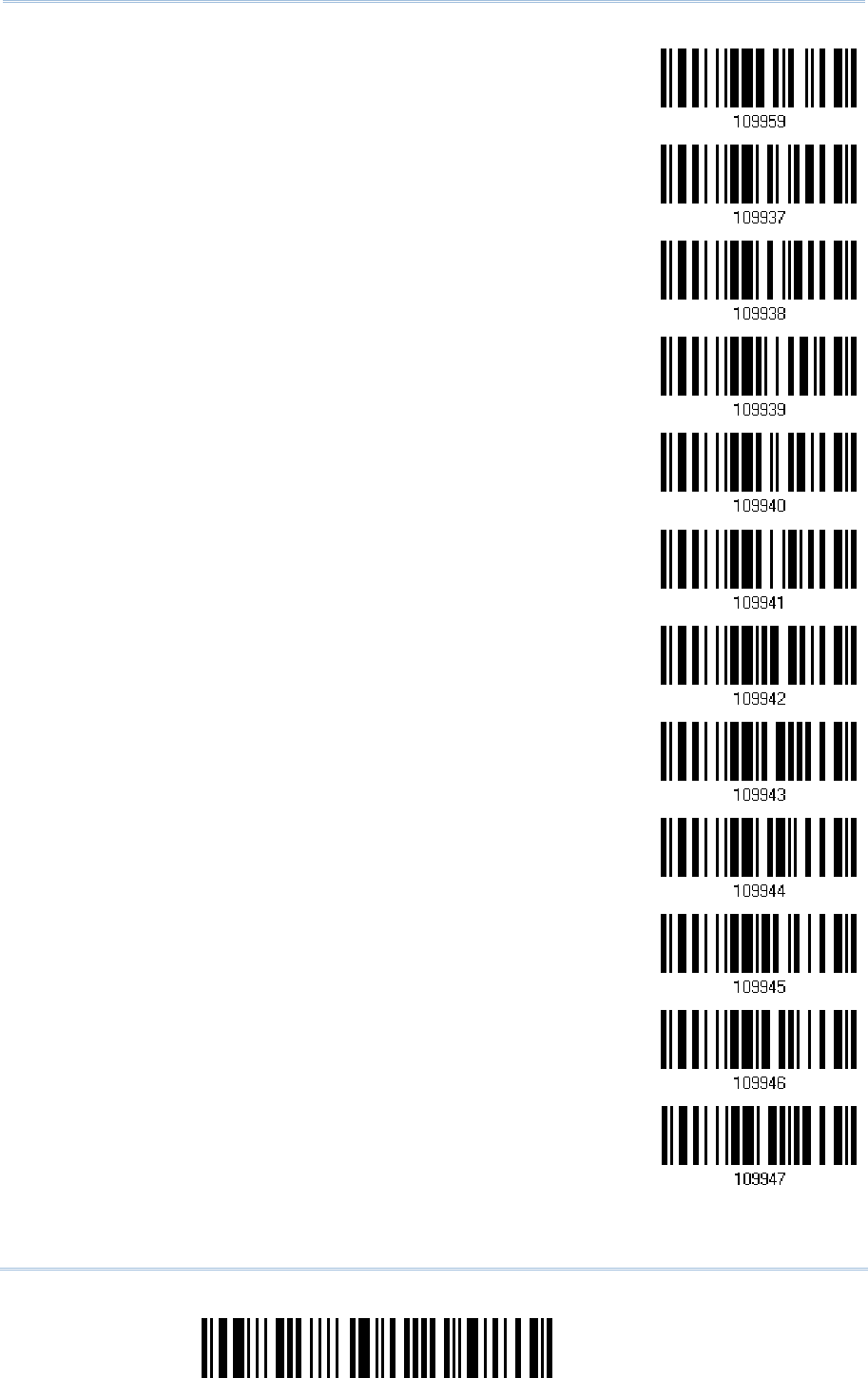
18
Enter Setup
1662 L/1664 Barcode Scanner User Guide
Reserved List Page 10
List settings regarding Editing Format 1
(1/2) List Page 11
List settings regarding Editing Format 1
(2/2) List Page 12
List settings regarding Editing Format 2
(1/2) List Page 13
List settings regarding Editing Format 2
(2/2) List Page 14
List settings regarding Editing Format 3
(1/2) List Page 15
List settings regarding Editing Format 3
(2/2) List Page 16
List settings regarding Editing Format 4
(1/2) List Page 17
List settings regarding Editing Format 4
(2/2) List Page 18
List settings regarding Editing Format 5
(1/2) List Page 19
List settings regarding Editing Format 5
(2/2) List Page 20
List current settings
List Page 21
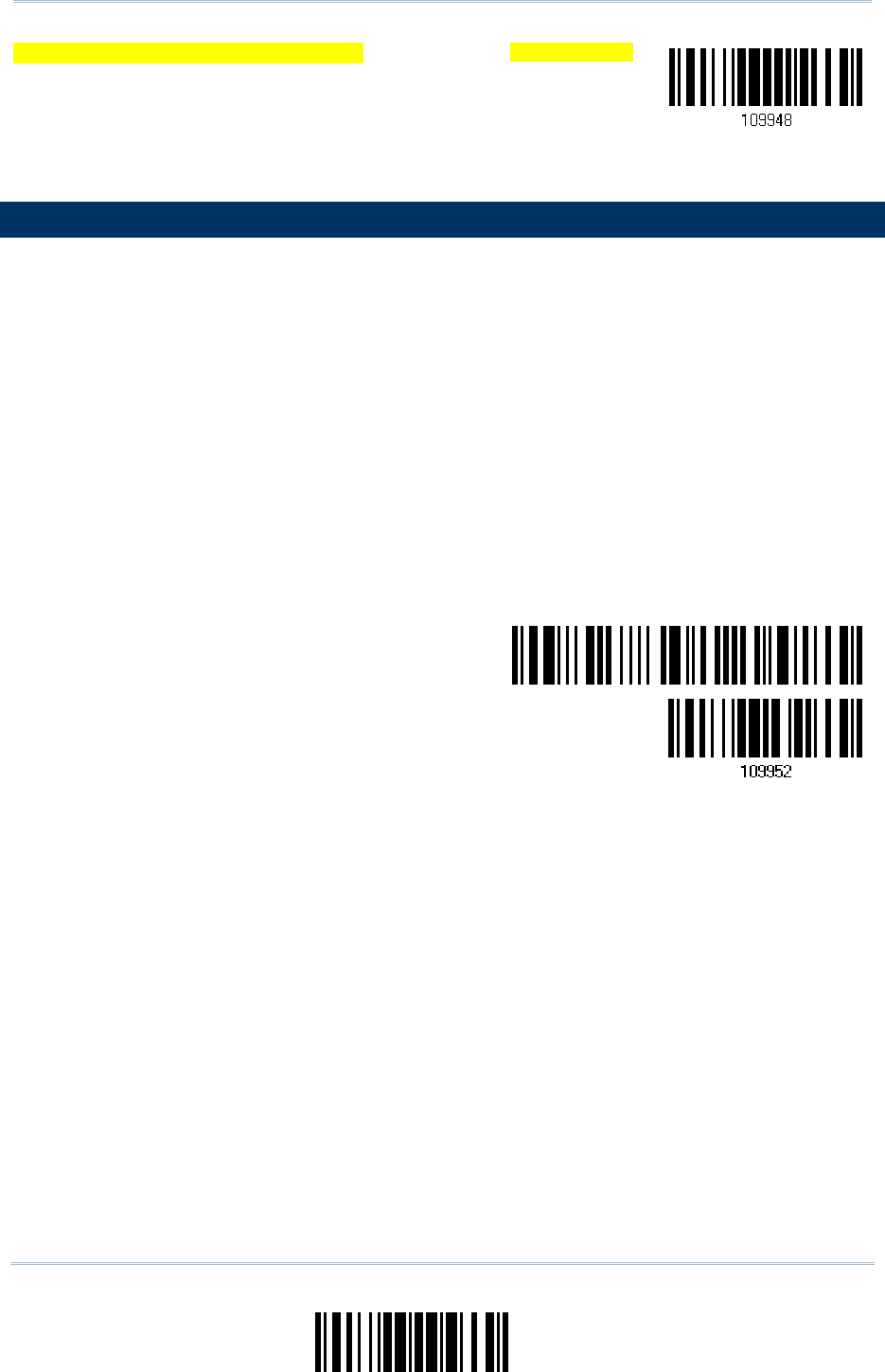
19
Update
Quick Start
List information regarding Driver License List Page 22
CREATE ONE-SCAN SETUP BARCODES
The fact is most of the scanner parameters require only one read for setting new values.
To facilitate configuring the scanner, you may create One-Scan setup barcodes for use.
The requirements of a One-Scan setup barcode are:
a prefix of the “#@” characters
the six digits of command parameters
a suffix of the “#”character
For example, the scanner needs the reading of three setup barcodes for the command
parameter “109952” to take effect:
Enter Setup
List Page 3

20
Enter Setup
1662 L/1664 Barcode Scanner User Guide
Update
Now, it requires only one read:
One-Scan Setup Barcode
for 109952
Note: The scanner will restart automatically upon reading the One-Scan setup barcode
for (1) changing the interface or (2) setting memory mode, enable or disable. It
will respond with a long beep and its LED will come on-off.

21
Update
Quick Start
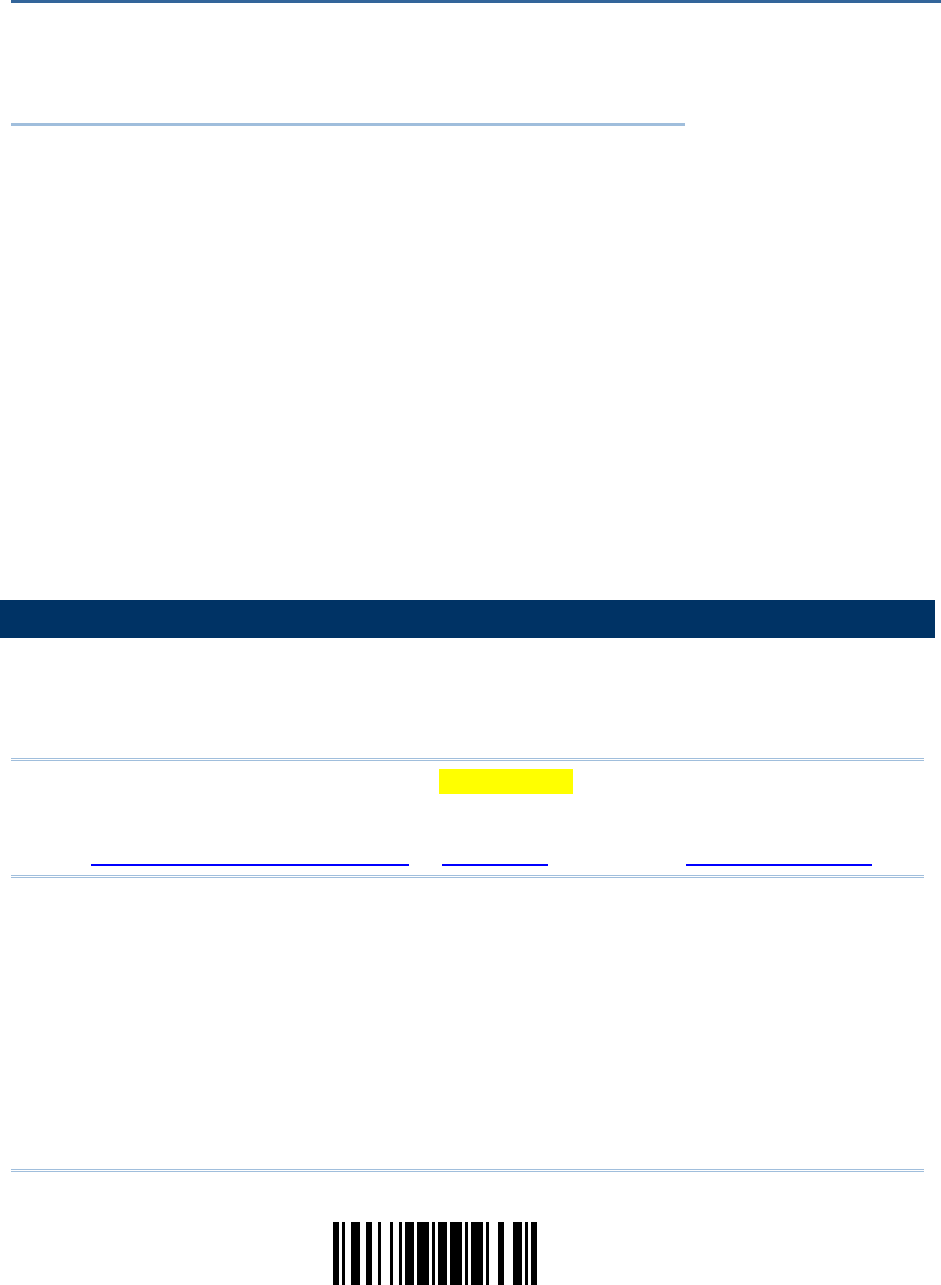
23
Update
This chapter explains the features and usage of the barcode scanner.
IN THIS CHAPTER
1.1 Battery ..................................................................... 23
1.2 Memory .................................................................... 28
1.3 LED Indicator ............................................................ 31
1.4 Beeper ..................................................................... 33
1.5 Vibrator .................................................................... 36
1.6 Send “NR” to Host ..................................................... 37
1.7 Scan Modes .............................................................. 38
1.8 Scanning Timeout ...................................................... 42
1.9 Delay between Re-read............................................... 43
1.10 Read Redundancy for All Symblogies ........................... 44
1.11 Addon Security for UPC/EAN Barcodes ........................ 45
1.12 Negative Barcodes ................................................... 45
1.13 Use Direct USB Cable................................................ 46
1.14 Picklist Mode ........................................................... 47
1.15 Pager Beep Duration ................................................. 47
1.16 Time Stamp ............................................................ 48
1.17 2D Decode Setting ................................................... 52
1.18 Hardware Reset ....................................................... 53
1.1 BATTERY
The scanner is battery-powered: Use a rechargeable 3.7 V/850 mAh Li-ion battery. For
intensive data collection, please prepare spare battery or batteries for non-stop
operation.
Note: (1) The rechargeable battery for 1662 L/1664 may not be fully charged when
shipped. We suggest charging it to full before use.
(2) The scanner can be configured to save battery power. Refer to settings of
“Auto Power Off & Power-Saving”, “Sniff Mode”, as well as “Low Battery Alarm”.
Chapter 1
UNDERSTANDING THE BARCODE SCANNER
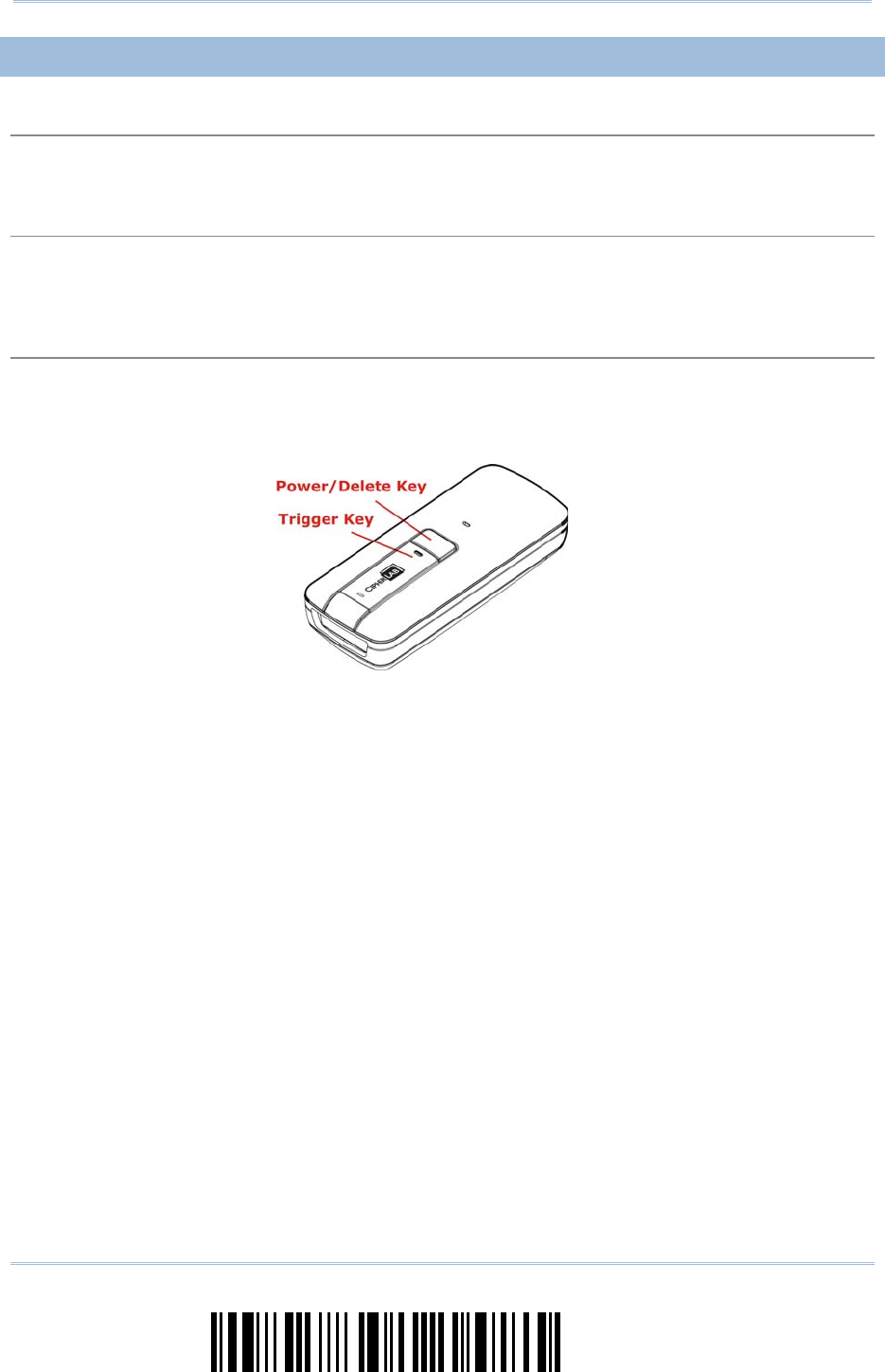
24
Enter Setup
1662 L/1664 Barcode Scanner User Guide
1.1.1 HOW TO OPERATE THE SCANNER
Turn on the scanner…
Press the [Power/Delete] key for 2 seconds. The scanner will respond with a long beep (high tone),
and its LED indicator will become solid red and go off.
Turn off the scanner…
Press the [Power/Delete] key for 2 seconds. The scanner will respond with two short beeps (high
tone) and the LED will become solid red. Release the key then. Otherwise, let the scanner turn off
automatically in specific circumstances.
Delete the last collected data when in memory mode …
Press the [Power/Delete] key. The scanner will respond with two short beeps (high tone) and the
LED will become solid red. Before the LED goes off (within 1 second), press the [Power/Delete] key
again to confirm the deletion.

25
Update
Chapter 1
Understanding the Barcode Scanner
1.1.2 AUTO POWER OFF & POWER-SAVING
The scanner will stay active at power-on, which may be followed by a transition from full
CPU speed to low CPU speed (Power-Saving) to auto shutdown (Auto Power Off).
Power-Saving (1~254 min.; 0= Disable): By default, it is set to stand by at full-speed
for 2 minutes before it enters low-speed mode. If this feature is not desired, set it to
0.
Auto Power Off (1~254 min.; 0= Disable): By default, it is set to automatically shut
down after 10 minutes. If this feature is not desired, set it to 0.
Note: 1. The Power-Saving setting will still take effect once a connection has been
established successfully, via Bluetooth® HID or SPP. 2.
There will be a time delay to reactivate 2D scan engine when scanner comes back
from power off mode.
Before establishing a WPAN connection successfully…
1) The scanner will stay active for a specified period of time (2 minutes by default) for the
following scenarios. Its CPU is running at full speed, and the LED is flashing blue (On/Off ratio
0.5 s: 0.5 s).
(a) waiting for a connection request from the host (Bluetooth® SPP Slave Mode)
(b) trying to connect to the host (Bluetooth® HID or Bluetooth® SPP Master Mode)
(c) trying to connect to 3610
2) If it fails to connect within 2 minutes, the scanner will become inactive to save power for the
remaining period of time (the specified value minus 2 minutes). Its CPU is running at low
speed, and the LED is flashing red (On/Off ratio 0.3 s: 2.5 s).
Press the [Trigger] key to wake up the scanner when it becomes inactive, and the scanner will
stay active again.
3) If it fails to connect again and again, and finally stays inactive until the specified time interval
for Auto Power Off has elapsed, the scanner will automatically turn off in order to conserve
battery power.
Hold down the [Power/Delete] key for 2 seconds to turn it on.
Note: For scenarios (a) and (b) in step 1, on your computer you may need to search for
the scanner again.

26
Enter Setup
1662 L/1664 Barcode Scanner User Guide
After establishing a WPAN connection successfully…
1) Once a WPAN connection is established successfully, the scanner will stay active for a specified
period of time (2 minutes by default) for data transmission. Its CPU is running at full speed,
and the LED is flashing blue (On/Off ratio 0.02 s: 3 s).
2) If it is idle within 2 minutes, the scanner will become inactive to save power for the remaining
period of time (the specified value minus 2 minutes). Its CPU is running at low speed, and the
LED is flashing red (On/Off ratio 0.3 s: 2.5 s).
Press the [Trigger] key to wake up the scanner when it becomes inactive, and the scanner will
stay active again.
3) If it is idle and finally stays inactive until the specified time interval for Auto Power Off has
elapsed, the scanner will automatically turn off in order to conserve battery power. The three
short beeps will ring out, tone descending from high to low.
Hold down the [Power/Delete] key for 2 seconds to turn it on.
For Bluetooth® HID, the scanner will resume connection with the host upon powering on
again, as long as the host application is running. The three short beeps will ring out, tone
ascending from low to high. If the scanner fails to resume connection, it will try every 5
seconds to re-connect to the host unless the “Reset Connection” barcode has been
scanned.
For Bluetooth® SPP Slave Mode, the scanner must wait for the host to re-connect.
For Bluetooth® SPP Master Mode, the scanner will resume connection with the host upon
powering on again, as long as the host application is running. The three short beeps will
ring out, tone ascending from low to high. If the scanner fails to resume connection, it will
try every 5 seconds to re-connect to the host unless the “Reset Connection” or “Restore
System Defaults” barcode has been scanned.
With the use of 3610, the scanner will try re-connecting to 3610 whilst the scanner is
active.
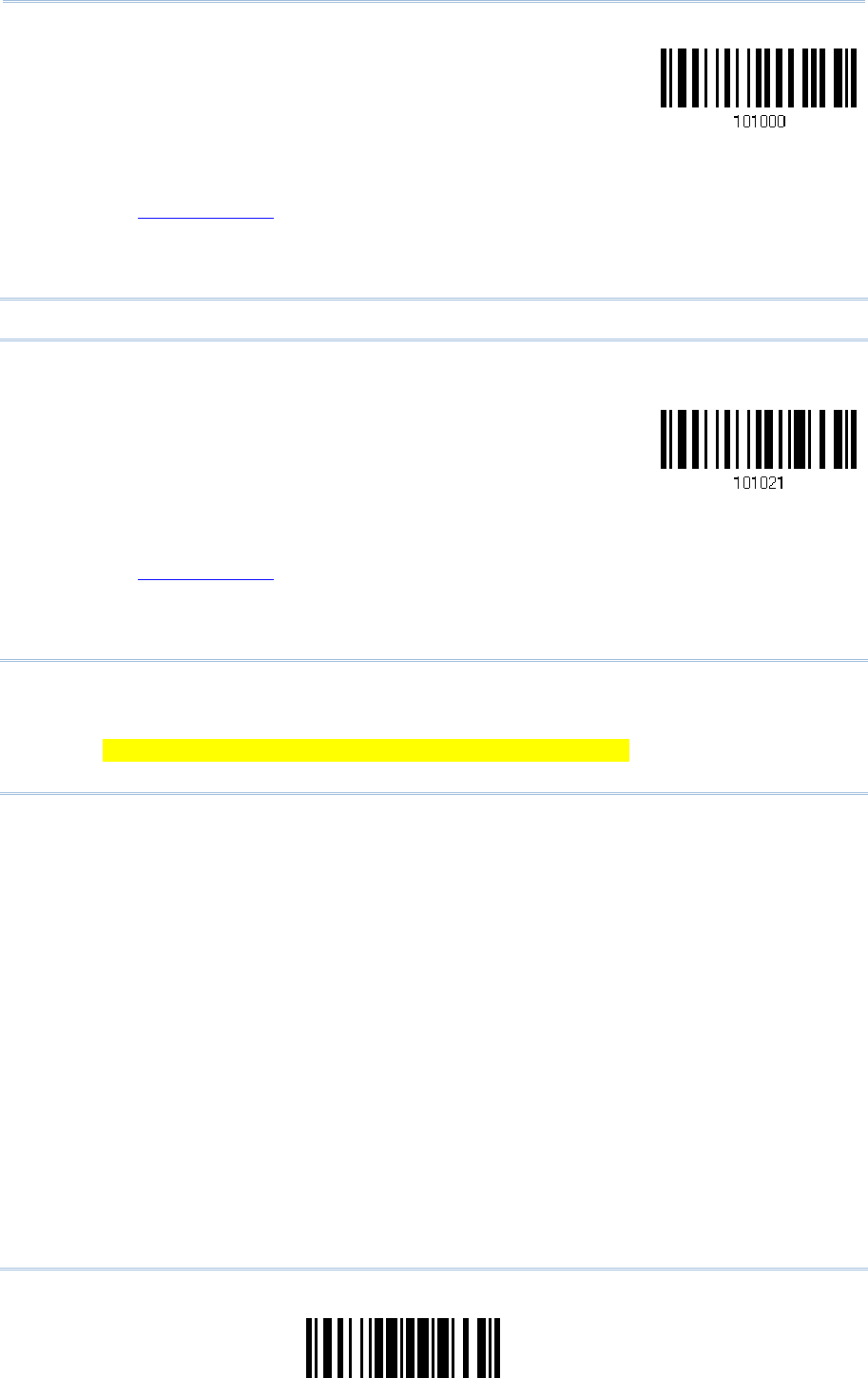
27
Update
Chapter 1
Understanding the Barcode Scanner
Auto Off after
0~254 min. (*10)
1) Read the barcode above to specify the time interval in minutes before the scanner
automatically turns off.
2) Read the “Decimal Value” barcode on page 錯誤! 尚未定義書籤。. For example, read “1”
and “5” for the scanner to automatically turn off after being idle for 15 minutes.
3) Read the “Validate” barcode on the same page to complete this setting.
Note: Auto Power Off will not take effect when the scanner is in the configuration mode.
Power-
S
aving after
0~254 min. (*2)
1) Read the barcode above to specify the time interval in minutes before the scanner
enters low-speed mode.
2) Read the “Decimal Value” barcode on page 錯誤! 尚未定義書籤。. For example, read “5”
for the scanner to enter low-speed mode after being idle for 5 minutes.
3) Read the “Validate” barcode on the same page to complete this setting.
Note: Power-Saving will not take effect when one of the following conditions is met:
(1) The scanner is in the configuration mode.
(2) The Power-Saving value is set to 0.
(3) The scan mode is set to Continuous or Alternate Mode.
(4) The setting value of Power-Saving is greater than that of Auto Power Off.
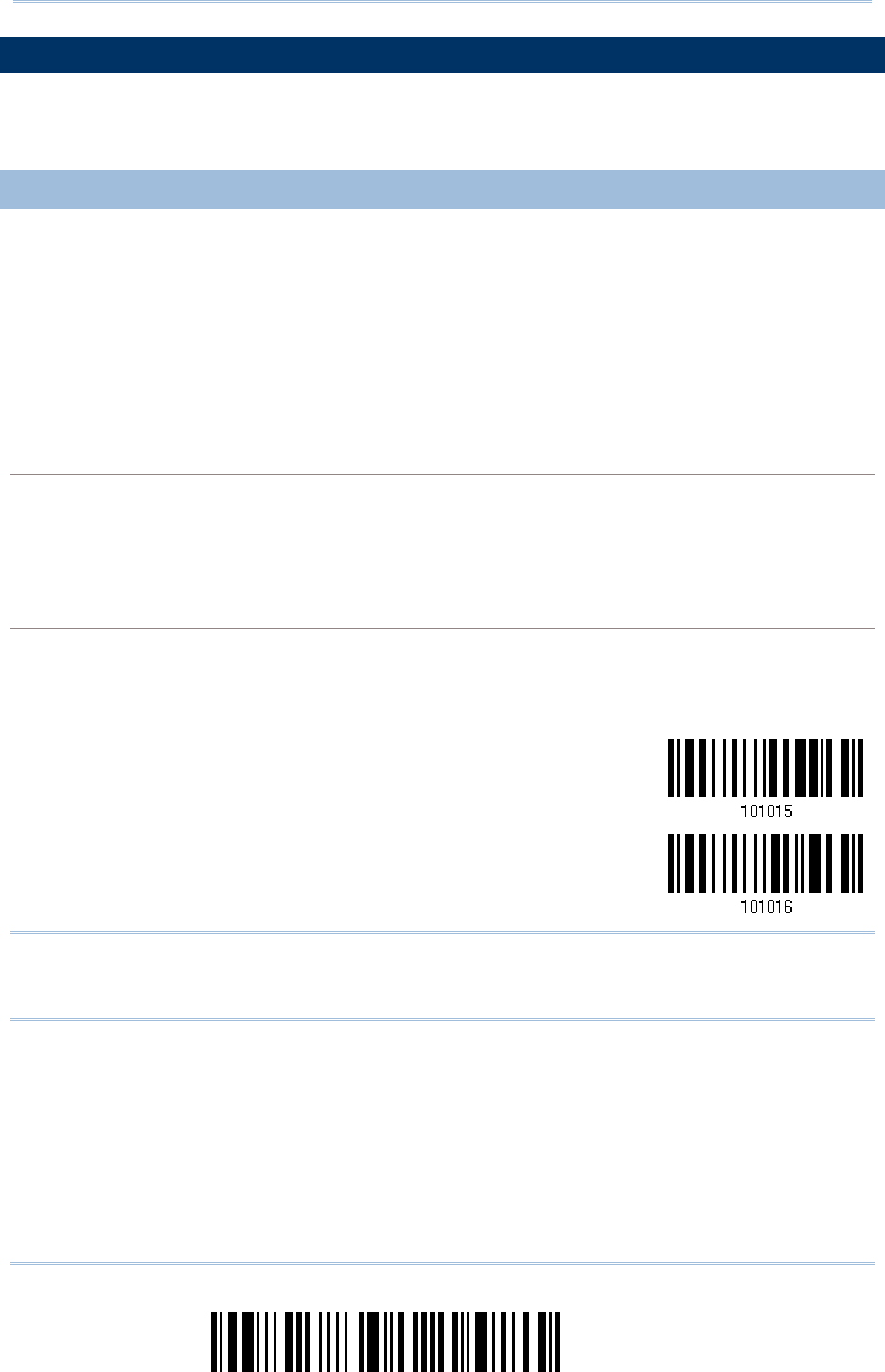
28
Enter Setup
1662 L/1664 Barcode Scanner User Guide
1.2 MEMORY
The scanned data can be sent to a host computer immediately via the WPAN connection
or stored in flash memory when the scanner is set to Memory mode.
1.2.1 TRANSMIT BUFFER
By default, the transmit buffer is enabled and ready for use when the scanner is out of
range. Upon reading a barcode successfully within range, the scanner responds with one
short beep (high tone) and its LED indicator becomes solid green and goes off. However,
the host computer may not receive the data immediately if the scanner is out of range.
With the 10 KB transmit buffer, the scanner can ignore the transmission status and keep
on reading barcodes until the buffer is full.
When transmit buffer is enabled…
If the scanner is out of range, it will respond with two short beeps, high-low tone, upon reading a
barcode successfully.
When transmit buffer is full, the scanner will respond with one long beep (low tone) and its LED
indicator will become solid red and go off. You are advised to get back into range.
When transmit buffer is disabled…
If the scanner is out of range, it will respond with one long beep (low tone) and its LED indicator
will become solid red and go off. You are advised to get back into range.
*Enable
Disable
Note: The 10 KB transmit buffer on the scanner can hold as many as 640 scans based on
EAN-13 barcodes. Data will be cleared out once the scanner is turned off or
running out of battery power!
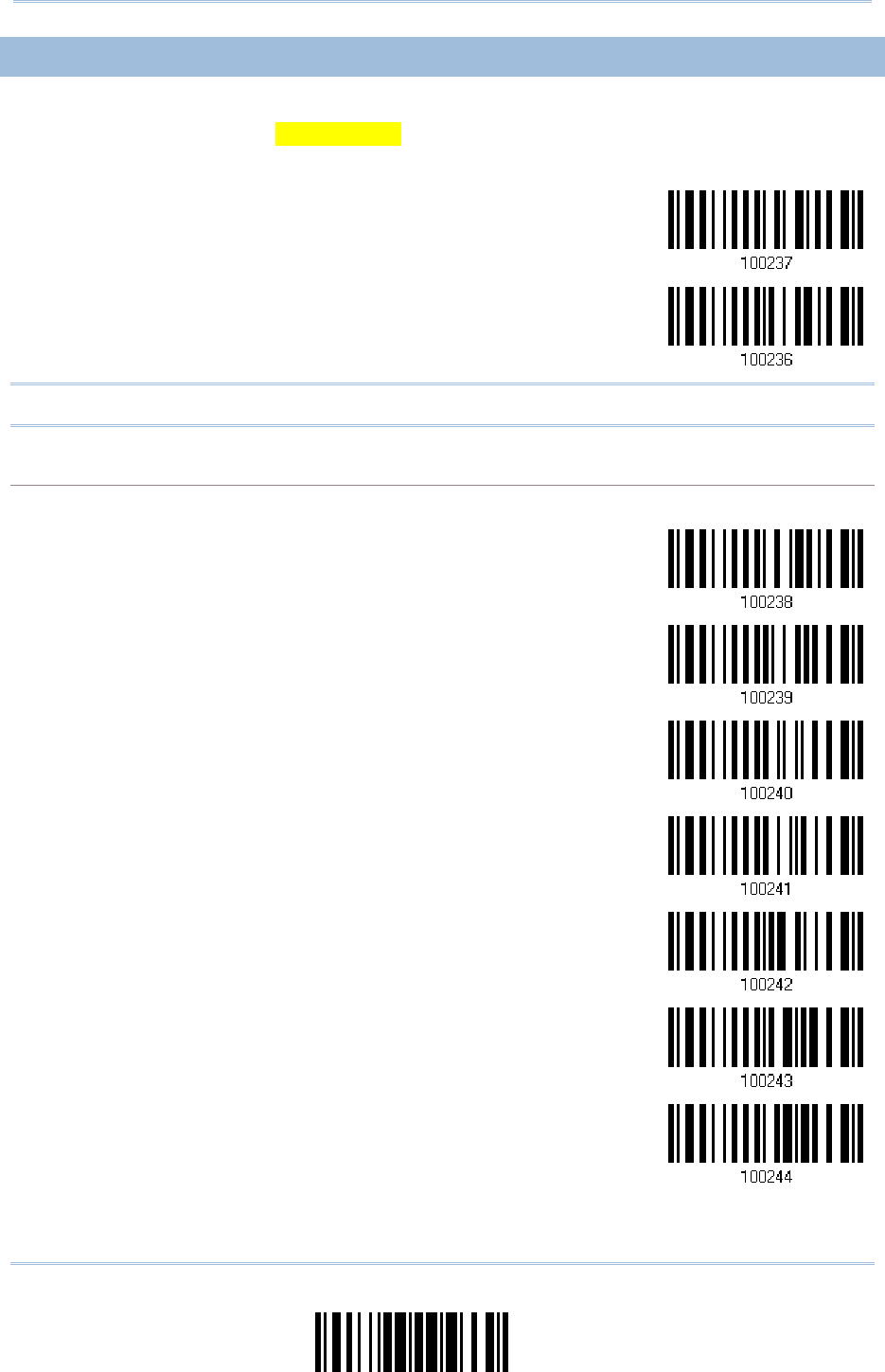
29
Update
Chapter 1
Understanding the Barcode Scanner
1.2.2 MEMORY MODE
When the scanner is in memory mode, it means any real-time connection established
with the host is disabled. 1662 L/1664 scanner keeps 4MB flash memory for memory
mode operation, which can store over 240,000 scans based on EAN-13 barcodes.
Enable
*Disable
Warning: No real-time connection is allowed unless the memory mode is disabled.
Memory Data Delay
You may set a delay between each data record while transmitting data back to the host.
*None
250 ms
500 ms
1 sec
2 sec
3 sec
5 sec
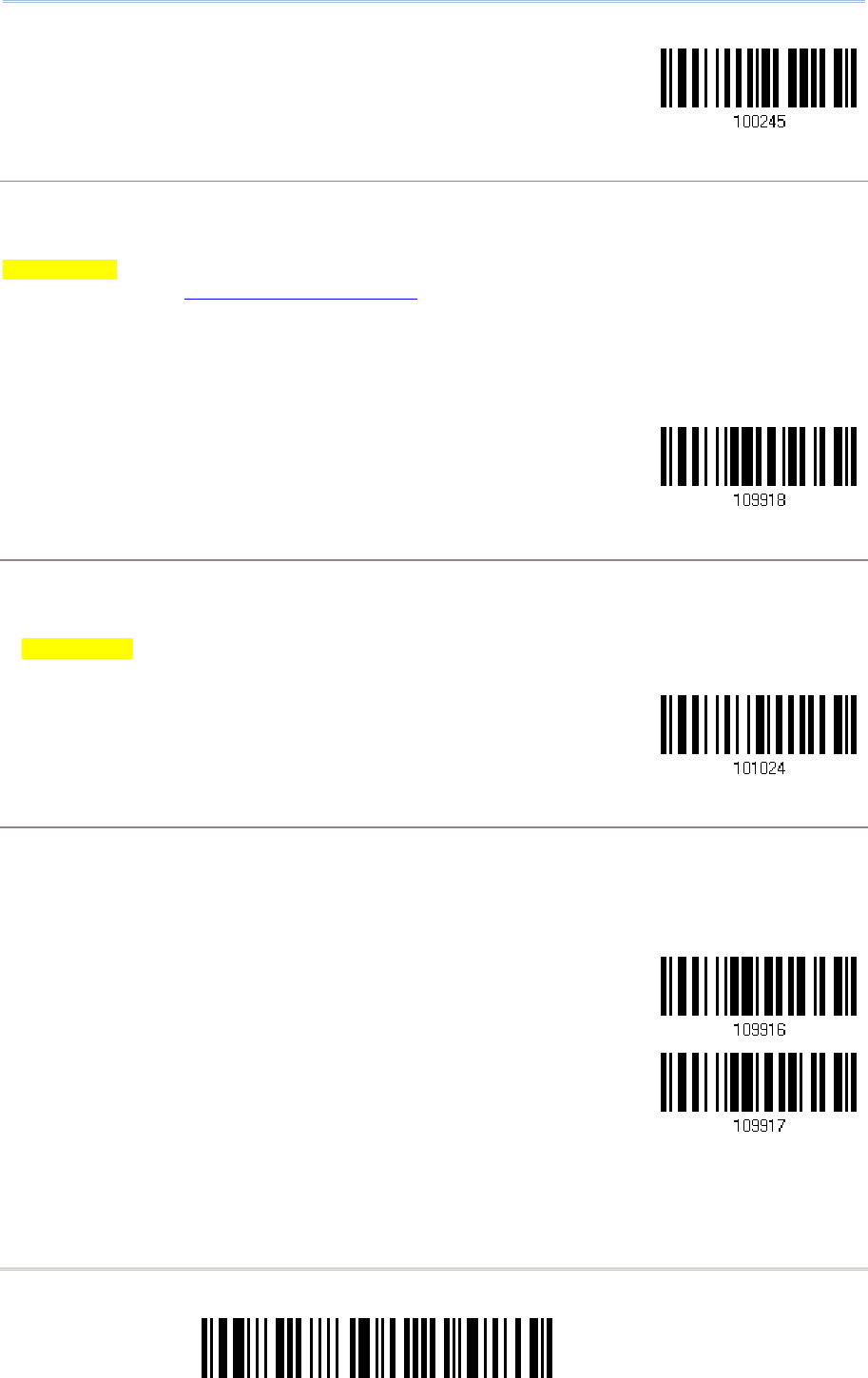
30
Enter Setup
1662 L/1664 Barcode Scanner User Guide
8 sec
Send Data
When the memory is used up, the scanner will respond with two short beeps (high-low tone) as a
warning. It is advised to send data to the host immediately by having the scanner read the “Send
Data” barcode below.
1662 L/1664 can send data via “Direct USB” interface once the computer has found the USB
connection. Refer to 1.13 Use Direct USB Cable. Because the time-out value is set to 0 by default,
connect the cable before having the scanner read the “Send Data” barcode. Otherwise, the scanner
will try to temporarily resume the previous WPAN connection with the host, if there is any.
During transmission of data collected in memory mode, if the transmission fails, the scanner will
flash red (On/Off ratio 0.2 s: 0.2 s) after responding with two short beeps (high-low tone) and go
back to previous working mode. Press trigger or power key to stop flashing.
Send Data
Send Data Time-out
If a time-out value other than zero is given, it will first try to send data via “Direct USB” interface
within the specified period of time. Connect the cable before it times out. When the attempt fails, it
will try to temporarily resume the previous WPAN connection with the host, if there is any.
If 1662 L/1664 has never been connected to the host cordless, it will not be able to send data until
it is connected using the Direct USB cable!
Send Data Time-Out
a
fter 0~15 sec.
(*0)
Clear Data & Confirm
Even though data has been sent to the host, the flash memory is still occupied unless you erase
the memory by reading two barcodes – “Clear Data” and “Confirm”.
1) Read the “Clear Data” barcode to clear the flash memory.
2) Read the “Confirm” barcode to confirm the action.
Clear Data
Confirm

31
Update
Chapter 1
Understanding the Barcode Scanner
1.3 LED INDICATOR
The triple-color LED on top of the scanner is used to provide user feedback. For example,
the LED becomes solid red and goes off upon powering on or running out of transmit
buffer. You may tell the difference by the beeps – you will hear a long beep of high tone
when powering on the scanner, and a long beep of low tone when the transmit buffer
becomes full.
Scanner LED Meaning
Red,
on-off --- --- Power on, with one long beep (high tone, LED on for 1
second)
Data saved to buffer when transmit buffer is enabled and the
scanner is out of range, with two short beeps (high-low tone)
Transmit buffer full, with one long beep (low tone)
Transmit buffer disabled, with one long beep (low tone)
Delete the last collected data in memory mode, with two
short beeps (high tone, LED on for 1 second)
Memory full in memory mode, with two short beeps (high-low
tone)
Red,
flashing --- --- Flashing red (On/Off ratio 0.3 s: 2.5 s) indicates the scanner
is inactive and its CPU running at low speed to save power
(because no WPAN connection is established after waiting for
two minutes)
Configuration Mode (On/Off ratio 0.5 s: 0.5 s)
--- --- Green,
on-off Good Read, with one short beep (high tone) and beeper pitch and
duration programmable
--- Blue,
flashing --- First, flashing blue (On/Off ratio 0.5 s: 0.5 s) for two minutes
indicates the scanner is waiting for connection, and goes off if no
connection is established, then flashing red (On/Off ratio 0.3 s:
2.5 s) indicates the scanner is inactive.
It is ready for connection only while the LED is flashing blue —
SPP Slave: waiting host to connect
HID or SPP Master: trying to connect to host
Using 3610: trying to connect to 3610
--- Blue,
flashing --- Flashing blue (On/Off ratio 0.1 s: 0.1 s) indicates the scanner
receives a PIN code request from host (flashing more quickly
than waiting connection).
--- Blue,
flashing --- Flashing blue (On/Off ratio 0.02 s: 3 s) indicates the scanner has
established a WPAN connection successfully.
--- Blue,
flashing Green,
flashing Flashing blue and green (On/Off ratio 0.1 s: 0.1 s) indicates an
error occurs while entering the PIN code. Press the [Trigger] key
to try and re-connect.
Red,
flashing --- --- Flashing red (On/Off ratio 0.2 s: 0.2 s) indicates the scanner has
failed to transmit data stored in memory. Press any key to stop
flashing.
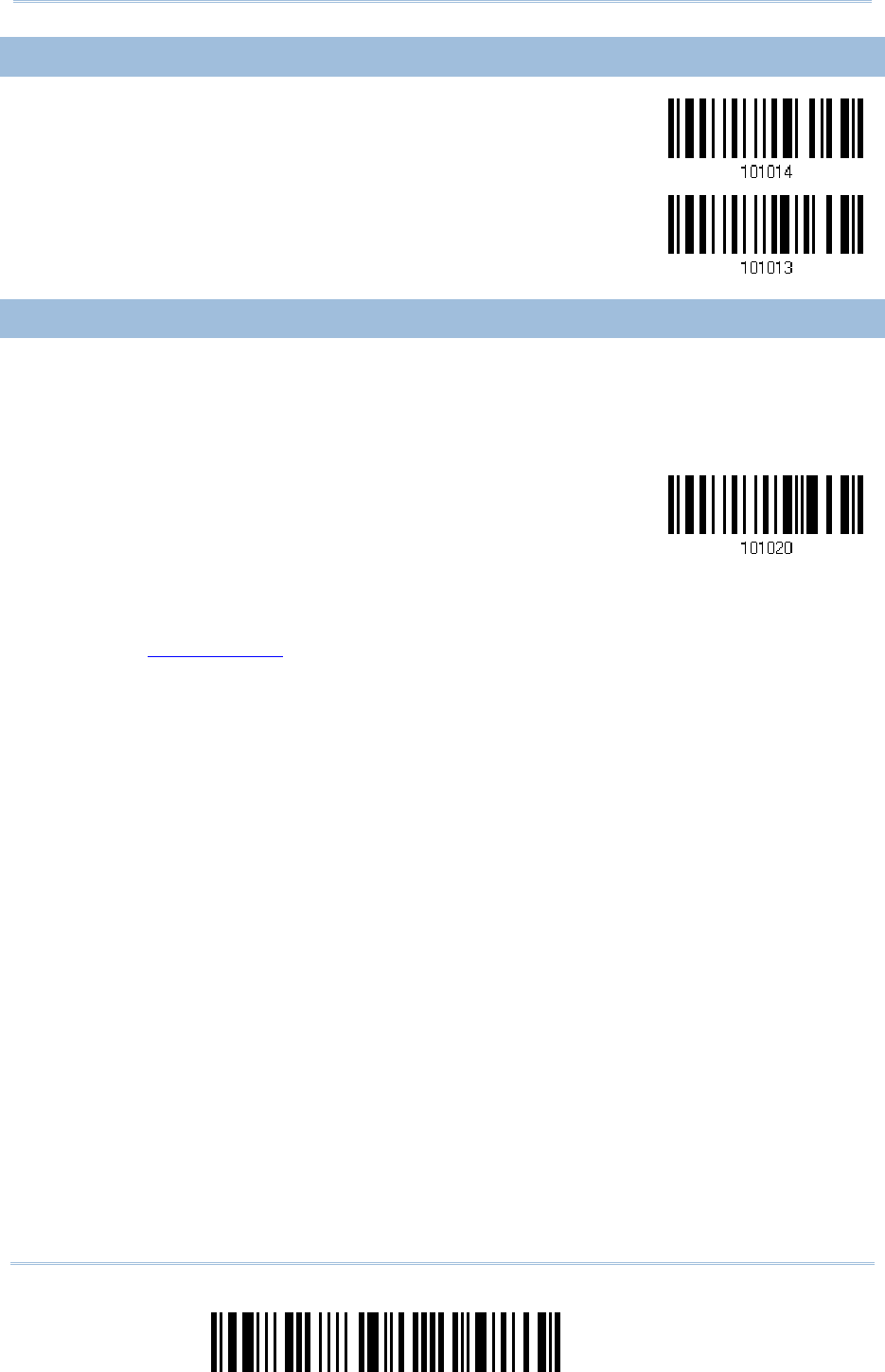
32
Enter Setup
1662 L/1664 Barcode Scanner User Guide
1.3.1 GOOD READ LED
*
Enable
Good Read LED
D
isable
Good Read LED
1.3.2 GOOD READ LED DURATION
By default, the Good Read LED stays on for 40 milliseconds. Specify a value, ranging
from 1 to 254 in units of 10 milliseconds.
Good Read LED
Time-out after
0
.01~2.54 sec.
(*40 ms)
1) Read the barcode above to specify the time interval before the Good Read LED goes
off.
2) Read the “Decimal Value” barcode on page 錯誤! 尚未定義書籤。. For example, read “1”
and “5” for the LED to go off after 150 milliseconds.
3) Read the “Validate” barcode on the same page to complete this setting.
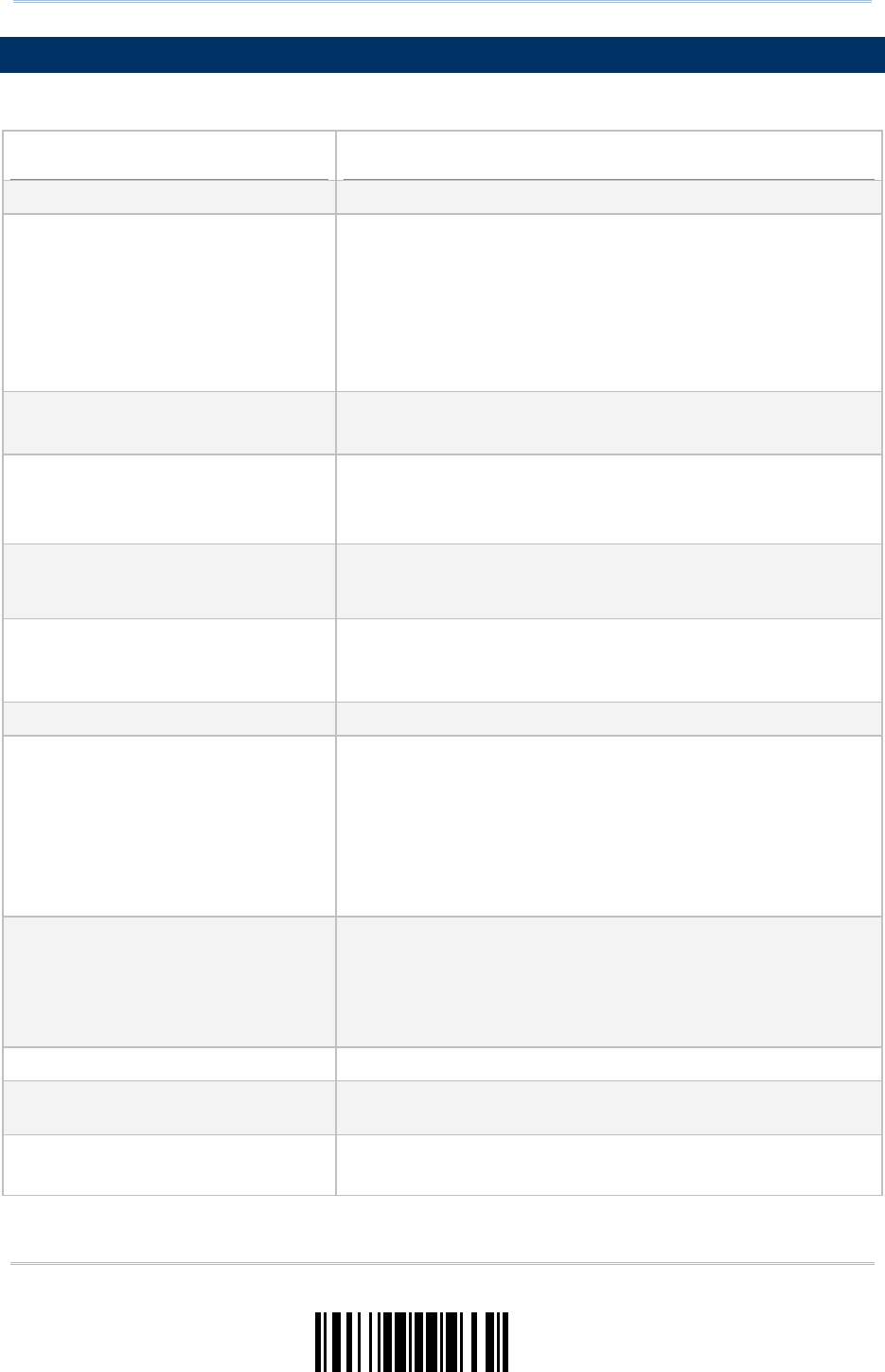
33
Update
Chapter 1
Understanding the Barcode Scanner
1.4 BEEPER
The scanner has a buzzer to provide user feedback in various operating conditions.
Beeping Meaning
One long beep, high tone Power on, with red LED on (1 second) and off quickly
One long beep, low tone Transmit buffer full, with red LED on-off
Transmit buffer disabled, with red LED on-off
Configuration error (Wrong barcode…)
PIN code input error
Reject random PIN request
Failed to send data in memory mode
One short beep, high tone
Programmable, default to 4 KHz
Good Read, with green LED on-off
One short beep, high tone More setup barcodes required
Input PIN code
Clear PIN code
One short beep, low tone More barcodes required to complete the “output sequence”
requirements of Multi-Barcode Editor, with green LED on-off
(Upon completion, same as Good Read.)
Six short beeps
High-low tone repeats three
times
Enter Configuration Mode, with red LED flashing
Exit Configuration Mode
Two short beeps, low-high tone Setup barcode read successfully
Two short beeps, high tone Low Battery Alarm
Power off, with red LED on (until the key is released)
Delete the last collected data in memory mode, with red
LED on (1 second) and off
Wake up the scanner depends on the paging setting
value until the power key is pressed or the sleeping time
out is reached
Two short beeps, high-low tone Data saved to buffer when transmit buffer is enabled
and the scanner is out of range, with red LED on-off
Memory Mode – Memory full, with red LED on-off
Memory Mode – Transmission failed, with red LED
flashing
Two long beeps, high-low tone Multi-Barcode Mode – Buffer full
Three short beeps, tone ascending
from high to low WPAN connection out of range or suspended
Three short beeps, tone ascending
from low to high
WPAN connection established, with blue LED flashing
WPAN connection resumed, with blue LED flashing

34
Enter Setup
1662 L/1664 Barcode Scanner User Guide
1.4.1 BEEPER VOLUME
Mute
Minimum Volume
Medium Volume
*Maximum Volume
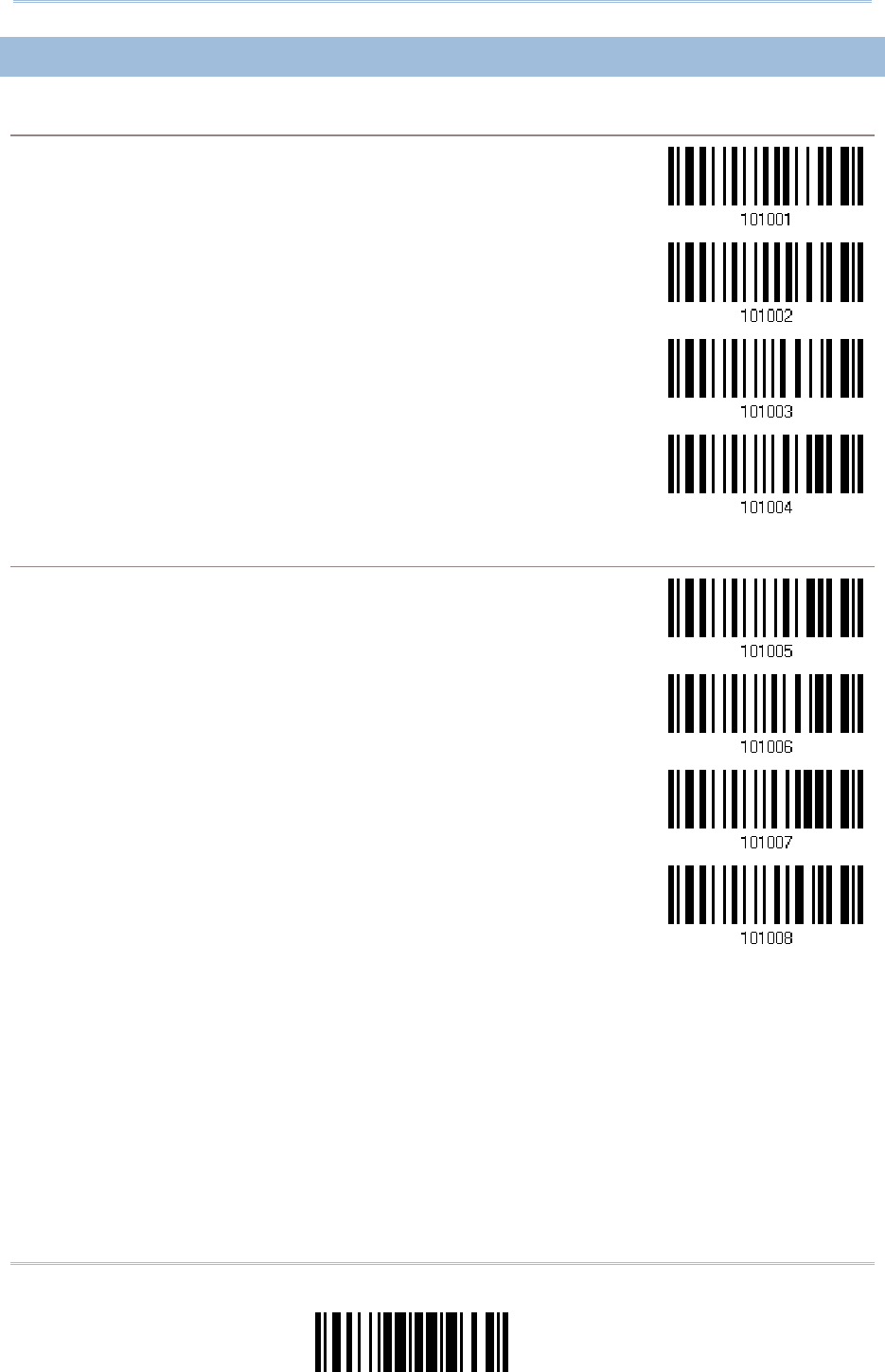
35
Update
Chapter 1
Understanding the Barcode Scanner
1.4.2 GOOD READ BEEP
Frequency
8 kHz
*4 kHz
2 kHz
1 kHz
Duration
*Shortest
Shorter
Longer
Longest
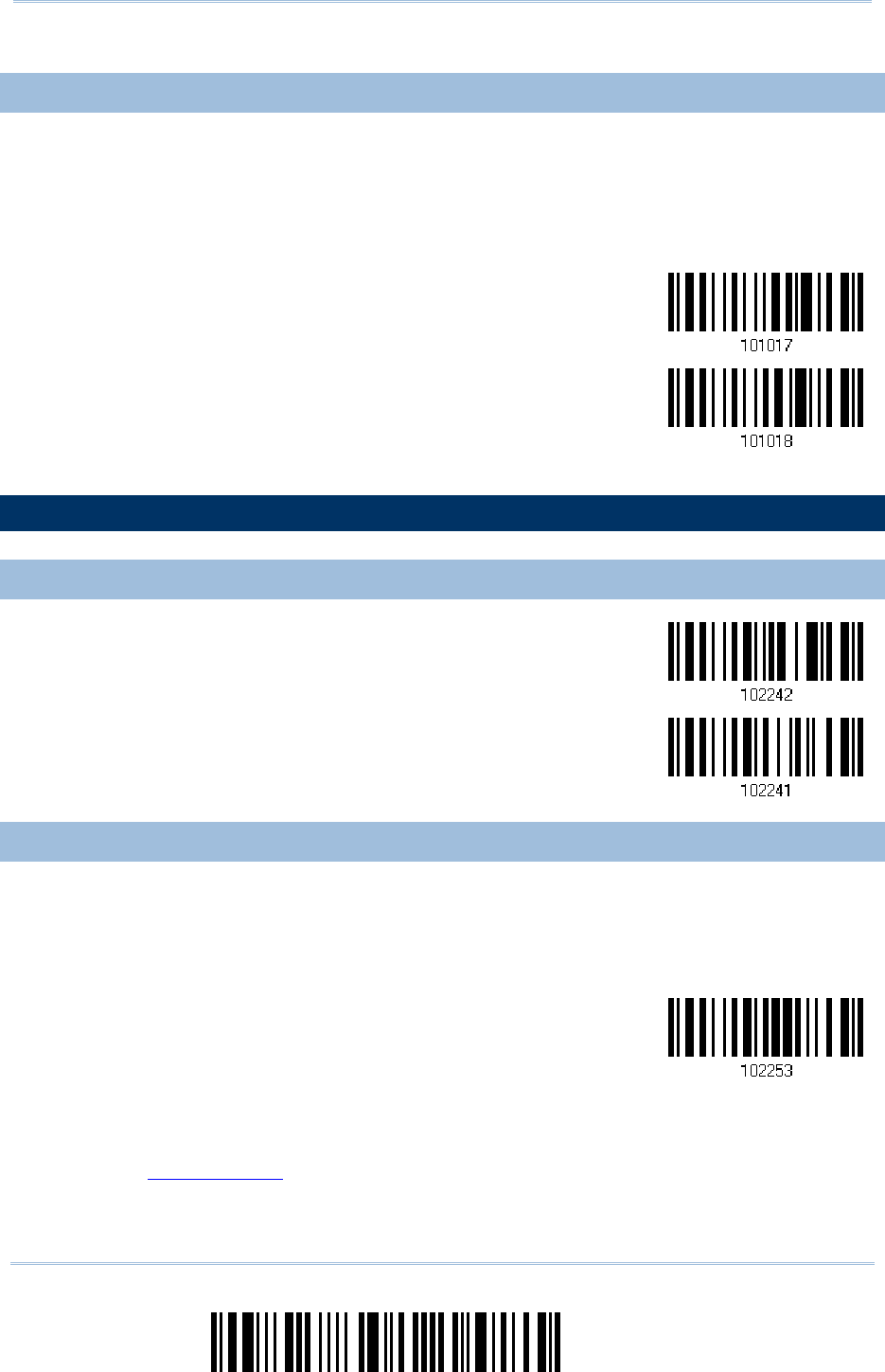
36
Enter Setup
1662 L/1664 Barcode Scanner User Guide
1.4.3 LOW BATTERY ALARM
By default, the built-in battery alarm will sound when the battery charge gets low. In
order to prevent data loss, it is advised to replace the battery immediately when hearing
two short beeps (high tone).
Disable
*Enable
1.5 VIBRATOR
1.5.1 GOOD READ VIBRATOR
E
nable
Good Read Vibrator
*
Disable
Good Read Vibrator
1.5.2 GOOD READ VIBRATOR DURATION
By default, the Good Read Vibrator stays on for 1 second. Specify a value, ranging from
1 to 254 in units of 100 milliseconds.
Good Read Vibrator
Time-out after
0
.1~25.4 sec.
(*1 s)
1) Read the barcode above to specify the time interval, in tenths of seconds before the
Good Read Vibrator goes off.
2) Read the “Decimal Value” barcode on page 錯誤! 尚未定義書籤。. For example, read “1”
and “5” for the vibrator to vibrate after 1.5 seconds good read.

37
Update
Chapter 1
Understanding the Barcode Scanner
3) Read the “Validate” barcode on the same page to complete this setting.
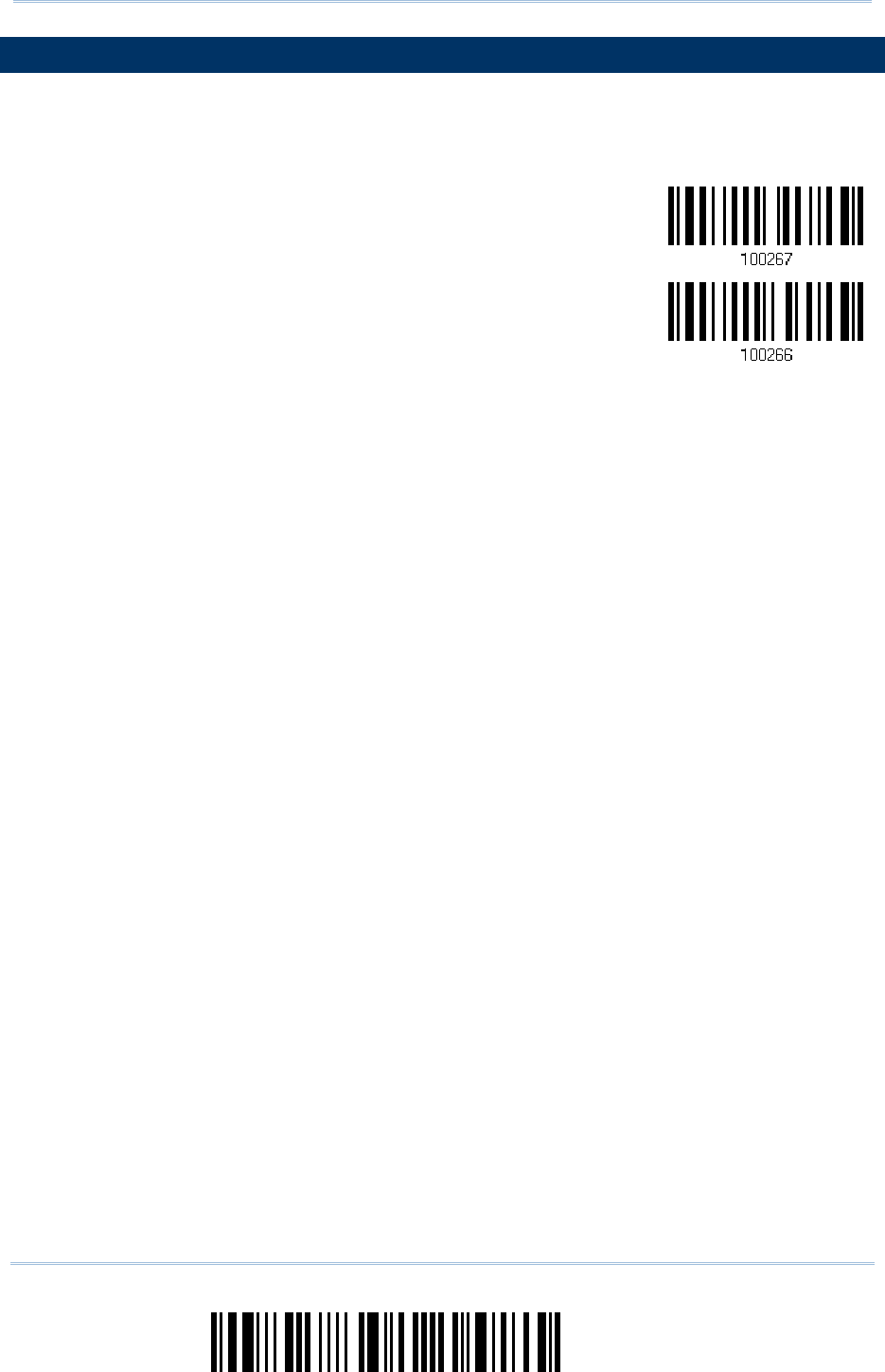
38
Enter Setup
1662 L/1664 Barcode Scanner User Guide
1.6 SEND “NR” TO HOST
The scanner can send a “NR” string to the host to notify a No Read event.
Enable
*Disable
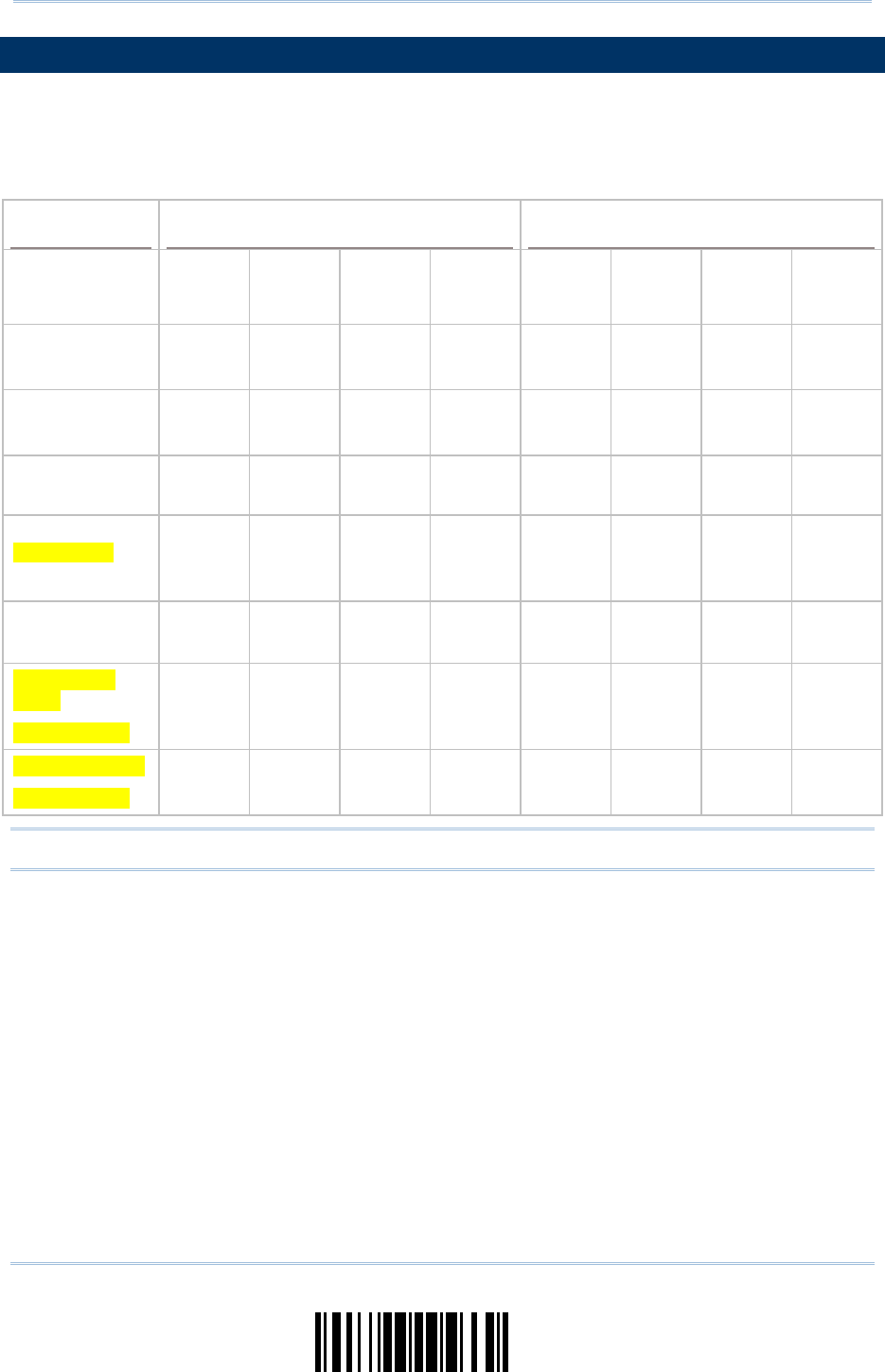
39
Update
Chapter 1
Understanding the Barcode Scanner
1.7 SCAN MODES
Different scan modes are supported – select the scan mode that best suits the
requirements of a specific application. Refer to the comparison table below.
Scan Mode Start to Scan Stop Scanning
Always Press
trigger
once
Hold
trigger Press
trigger
twice
Release
trigger Press
trigger
once
Barcode
being
read
Timeout
Laser mode
Auto Off mode
Auto Power Off
mode
Aiming mode
(1664 only)
Multi-Barcode
mode
Continuous
mode
(1662 L only)
Alternate mode
(1662 L only)
Note: By default, the scan mode is set to Laser mode.
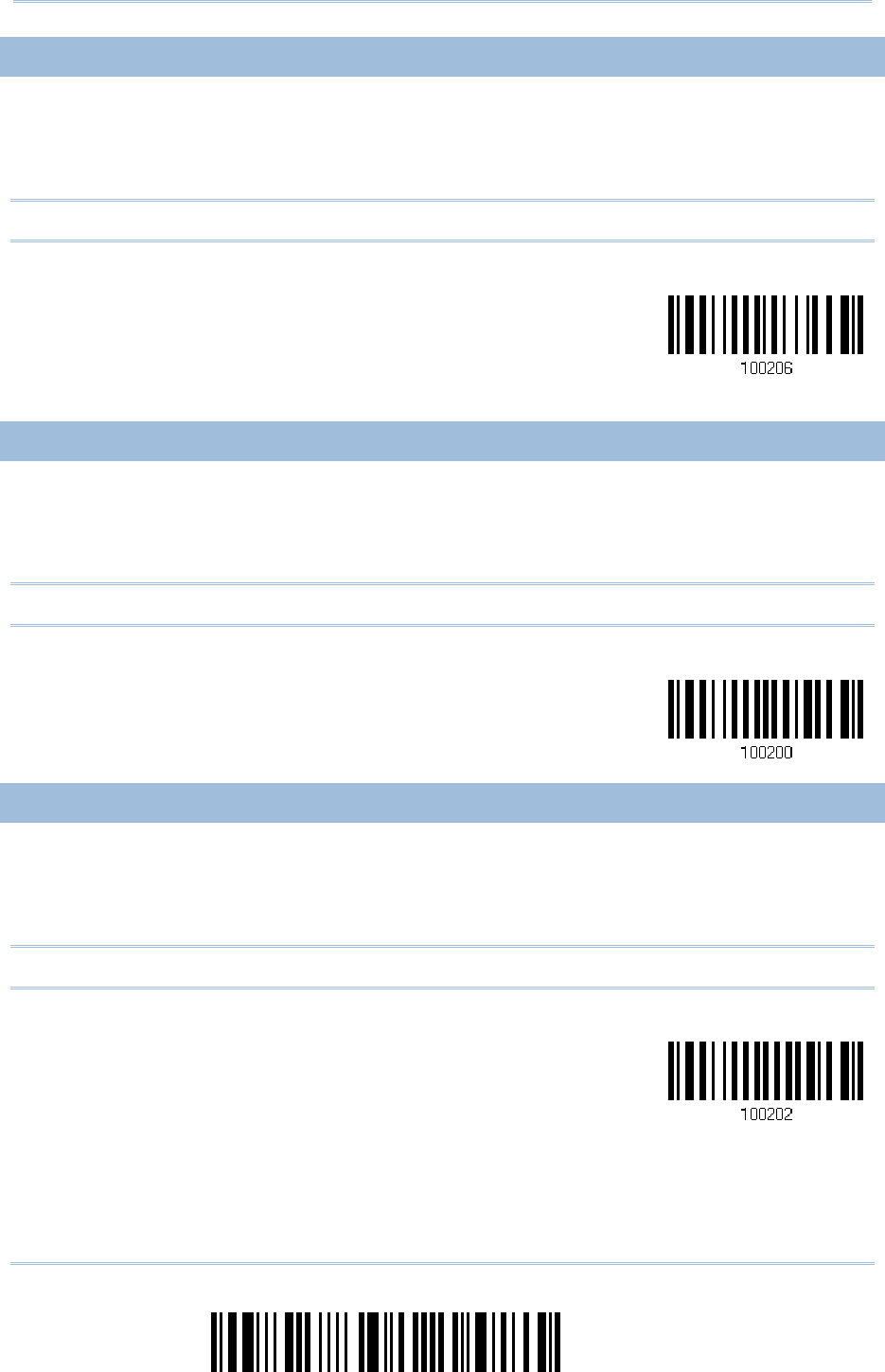
40
Enter Setup
1662 L/1664 Barcode Scanner User Guide
1.7.1 LASER MODE
The scanner will start scanning once the trigger is held down.
The scanning won't stop until (1) a barcode is decoded, (2) the pre-set timeout
expires, or (3) you release the trigger.
Note: Refer to “Scanning Timeout”.
*Laser Mode
1.7.2 AUTO OFF MODE
The scanner will start scanning once the trigger is pressed.
The scanning won't stop until (1) a barcode is decoded, and (2) the pre-set timeout
expires.
Note: Refer to “Scanning Timeout”.
Auto Off Mode
1.7.3 AUTO POWER OFF MODE
The scanner will start scanning once the trigger is pressed.
The scanning won't stop until the pre-set timeout expires, and, the pre-set timeout
period re-counts after each successful decoding.
Note: Refer to “Delay between Re-read” and “Scanning Timeout”.
Auto Power Off Mode
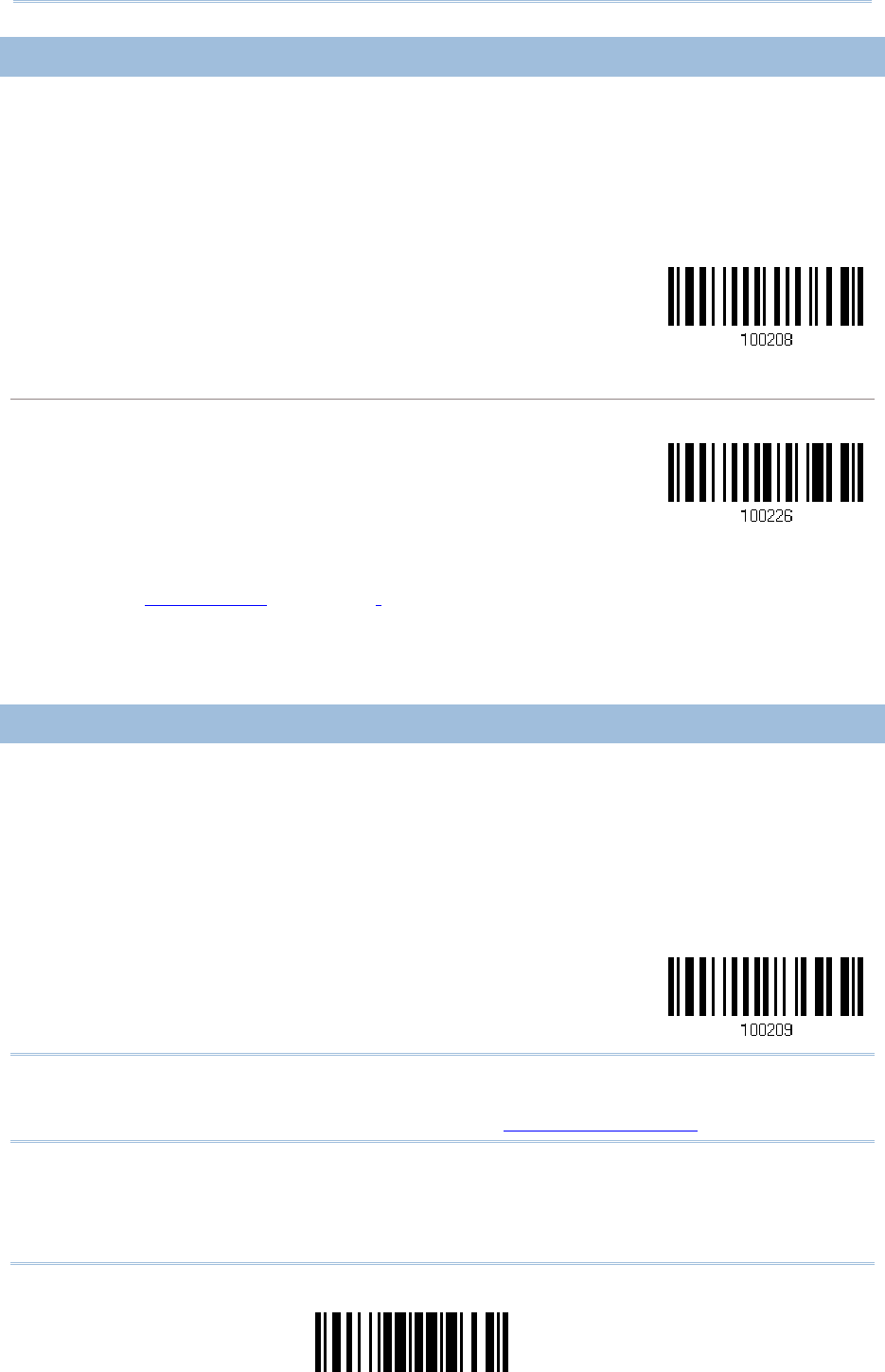
41
Update
Chapter 1
Understanding the Barcode Scanner
1.7.4 AIMING MODE (1664 ONLY)
The scanner will aim at a barcode once the trigger is pressed, and start scanning when
the trigger is pressed again within one second.
The scanning won't stop until (1) a barcode is decoded, and (2) the pre-set timeout
expires.
Aiming Mode
Aiming Timeout
You can limit the aiming time interval (1~15). By default, the scanner time-out is set to 1 second.
Aiming Time-out
a
fter 1~15 sec.
(*1)
1) Read the barcode above to specify the time interval in seconds before aiming ends. (It is set
to 1 by default.)
2) Read the “Decimal Value” barcode on page 錯誤! 尚未定義書籤。. For example, read “1” and “0”
for the scanner to automatically shut down after being idle for 10 seconds.
3) Read the “Validate” barcode on the same page to complete this setting.
1.7.5 MULTI-BARCODE MODE
The scanner will be scanning as long as the trigger is held down, capable of decoding one
single barcode, as well as multiple unique barcodes one at a time. While decoding a
bunch of unique barcodes, if a barcode is decoded twice, its subsequent decoding will be
ignored and the scanner is expecting another unique barcode.
The scanning won't stop until you release the trigger.
Multi-Barcode Mode
Note: (1) A barcode is considered unique when its Code Type or data is different from
others.
(2) Multi-Barcode Mode is not related to the Multi-Barcode Editor.
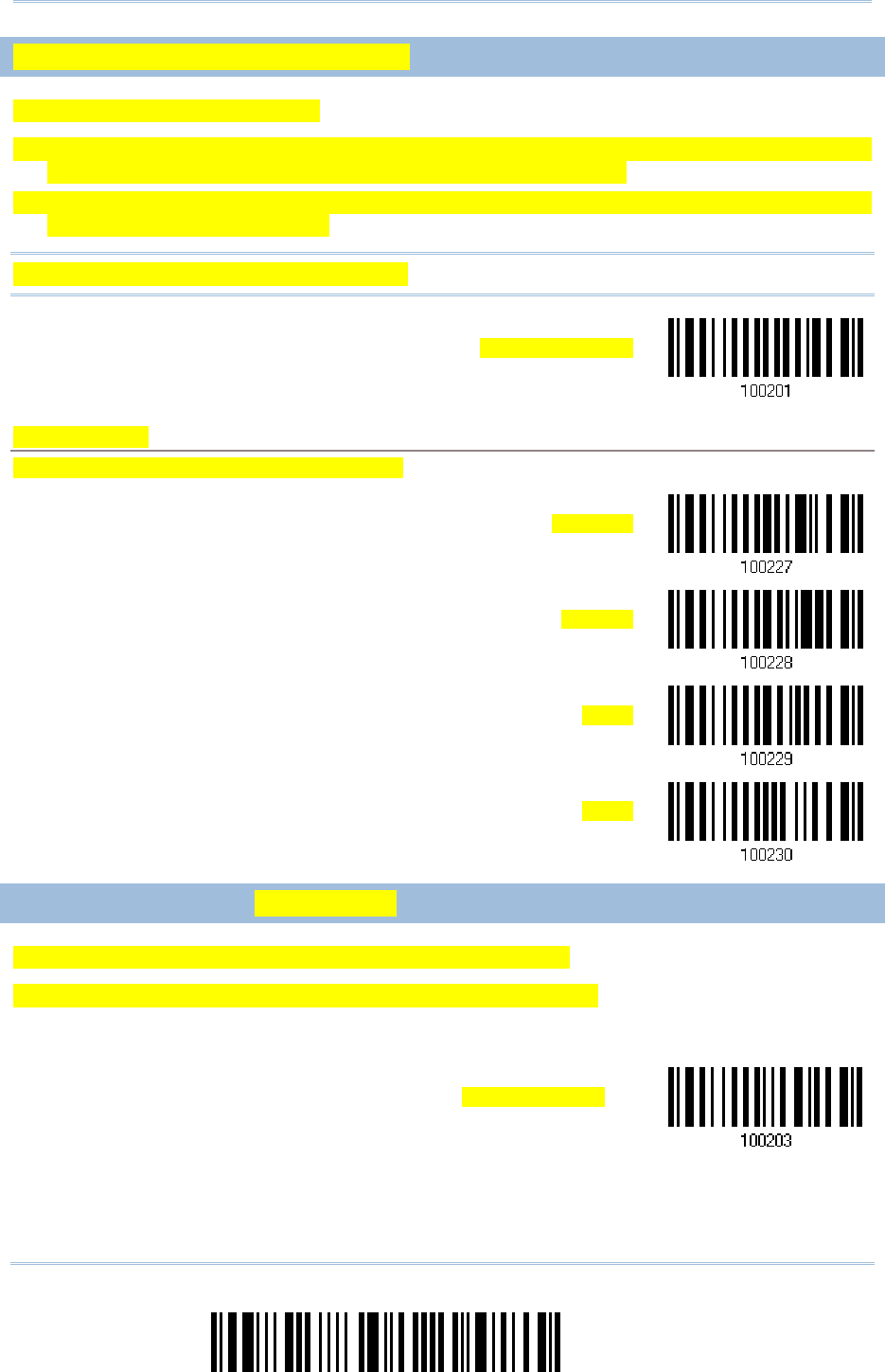
42
Enter Setup
1662 L/1664 Barcode Scanner User Guide
1.7.6 CONTINUOUS MODE (1662 L ONLY)
The scanner is always scanning.
After a successful decoding, the removal of barcode is required. It is not allowed to
proceed to decode until the decoding delay time has passed.
To decode the same barcode repeatedly, move away the barcode and put it back
again and again for scanning.
Note: Refer to “Delay between Re-read”.
Continuous Mode
Decoding Delay
Set the time interval between each decoding.
*Disable
0.5 sec
1 sec
2 sec
1.7.7 ALTERNATE MODE (1662 L ONLY)
The scanner will start scanning once the trigger is pressed
The scanning won't stop until you press the trigger again.
Alternate Mode
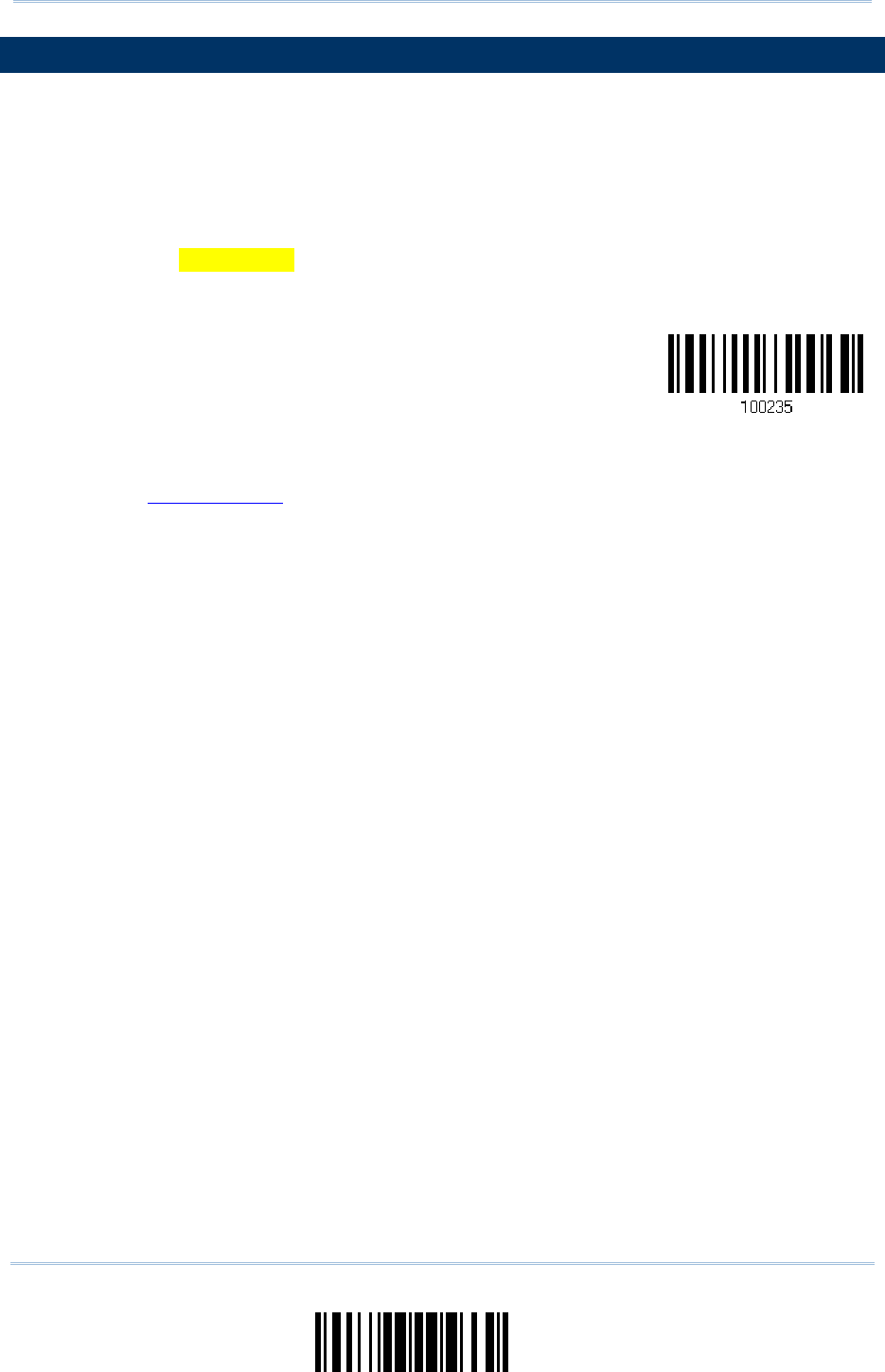
43
Update
Chapter 1
Understanding the Barcode Scanner
1.8 SCANNING TIMEOUT
Specify the scanning time interval (1~254 sec.; 0= Disable) when the scan mode is set
to any of the following –
Laser mode
Auto Off mode
Auto Power Off mode
Aiming mode (1664 Only)
Scanner Time-out
a
fter 0~254 sec.
(*10)
1) Read the barcode above to specify the time interval in seconds before the scan
engine times out.
2) Read the “Decimal Value” barcode on page 錯誤! 尚未定義書籤。. For example, read “1”
and “5” for the scanner to shut down automatically after being idle for 15 seconds.
3) Read the “Validate” barcode on the same page to complete this setting.
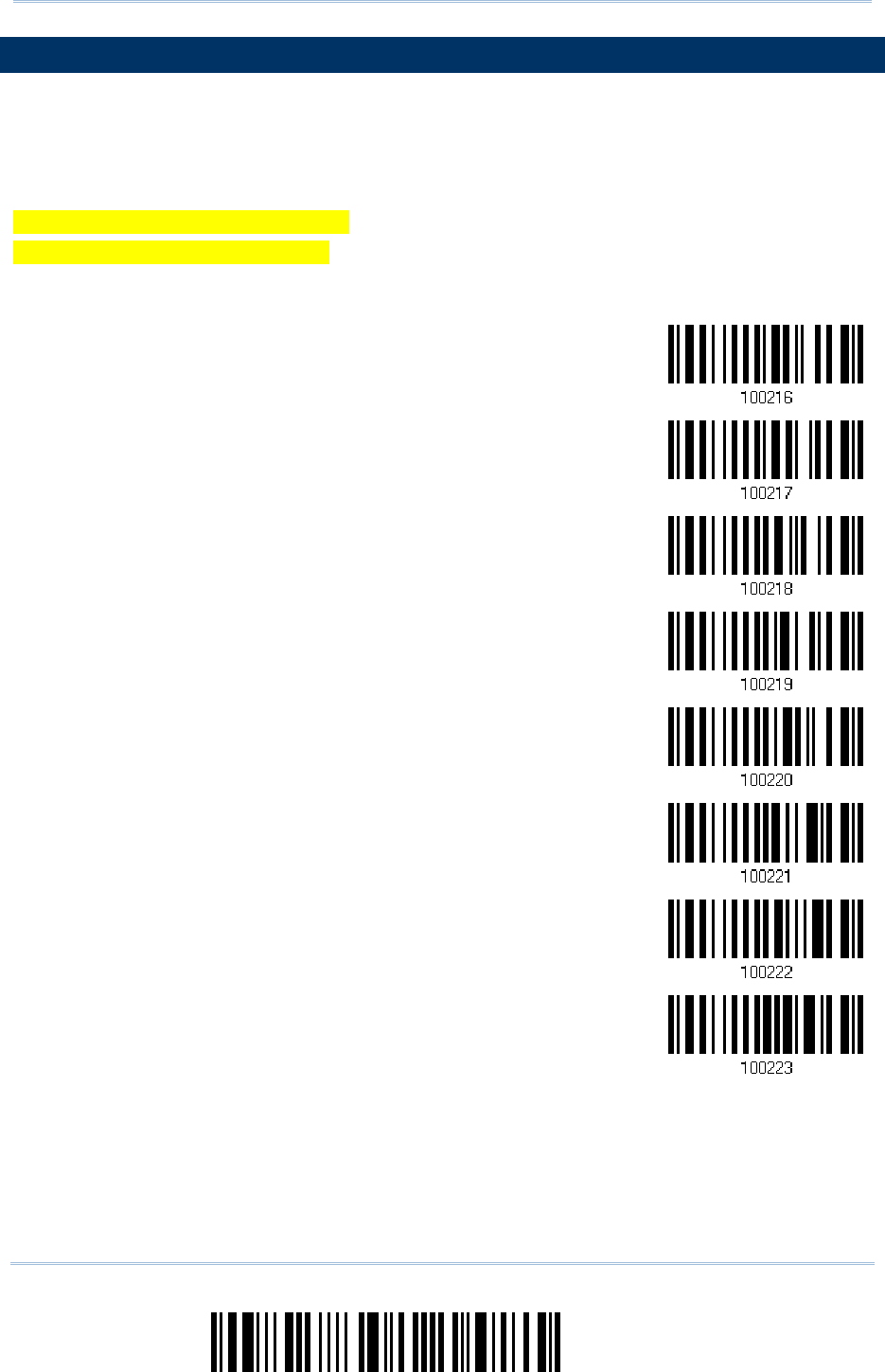
44
Enter Setup
1662 L/1664 Barcode Scanner User Guide
1.9 DELAY BETWEEN RE-READ
This is also referred to as the “Blocking Time”, which is used to prevent the scanner from
accidentally reading the same barcode twice when the scan mode is set to any of the
following –
Auto Power Off mode
Continuous mode (1662 L only)
Alternate mode (1662 L only)
100 ms
200 ms
*400 ms
800 ms
1 sec
2 sec
3 sec
5 sec
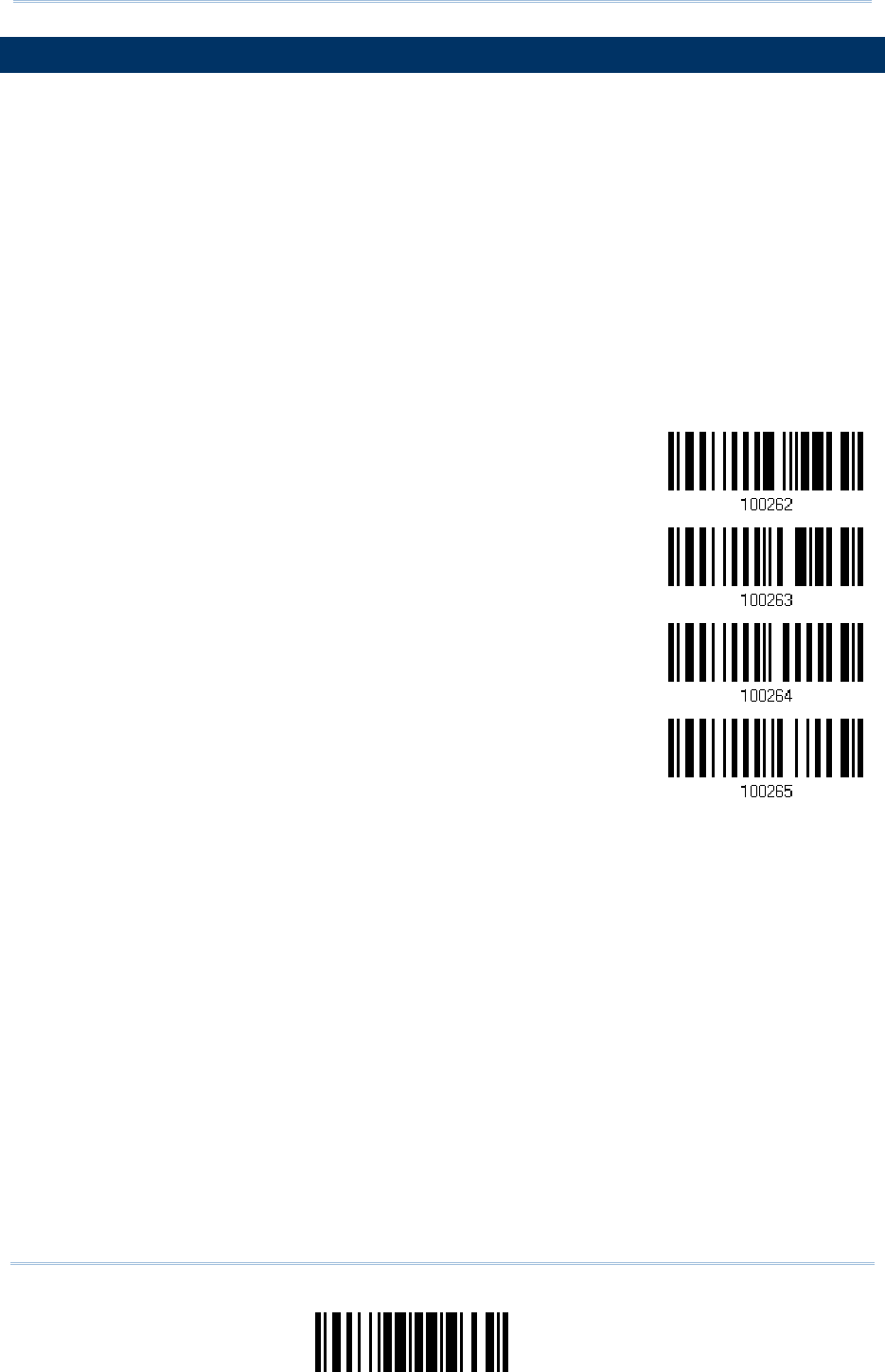
45
Update
Chapter 1
Understanding the Barcode Scanner
1.10 READ REDUNDANCY FOR ALL SYMBLOGIES
Select the level of reading security. For example,
If "No Redundancy" is selected, one successful decoding will make the reading valid
and induce the "READER Event".
If "Three Times" is selected, it will take a total of four consecutive successful
decoding of the same barcode to make the reading valid. The higher the reading
security is (that is, the more redundancy the user selects), the slower the reading
speed gets.
It is obvious that the more redundancy selected, the higher the reading security is, and
thus, the slower the reading speed becomes. It has to compromise between reading
security and decoding speed.
*No Redundancy
One Time
Two Times
Three Times
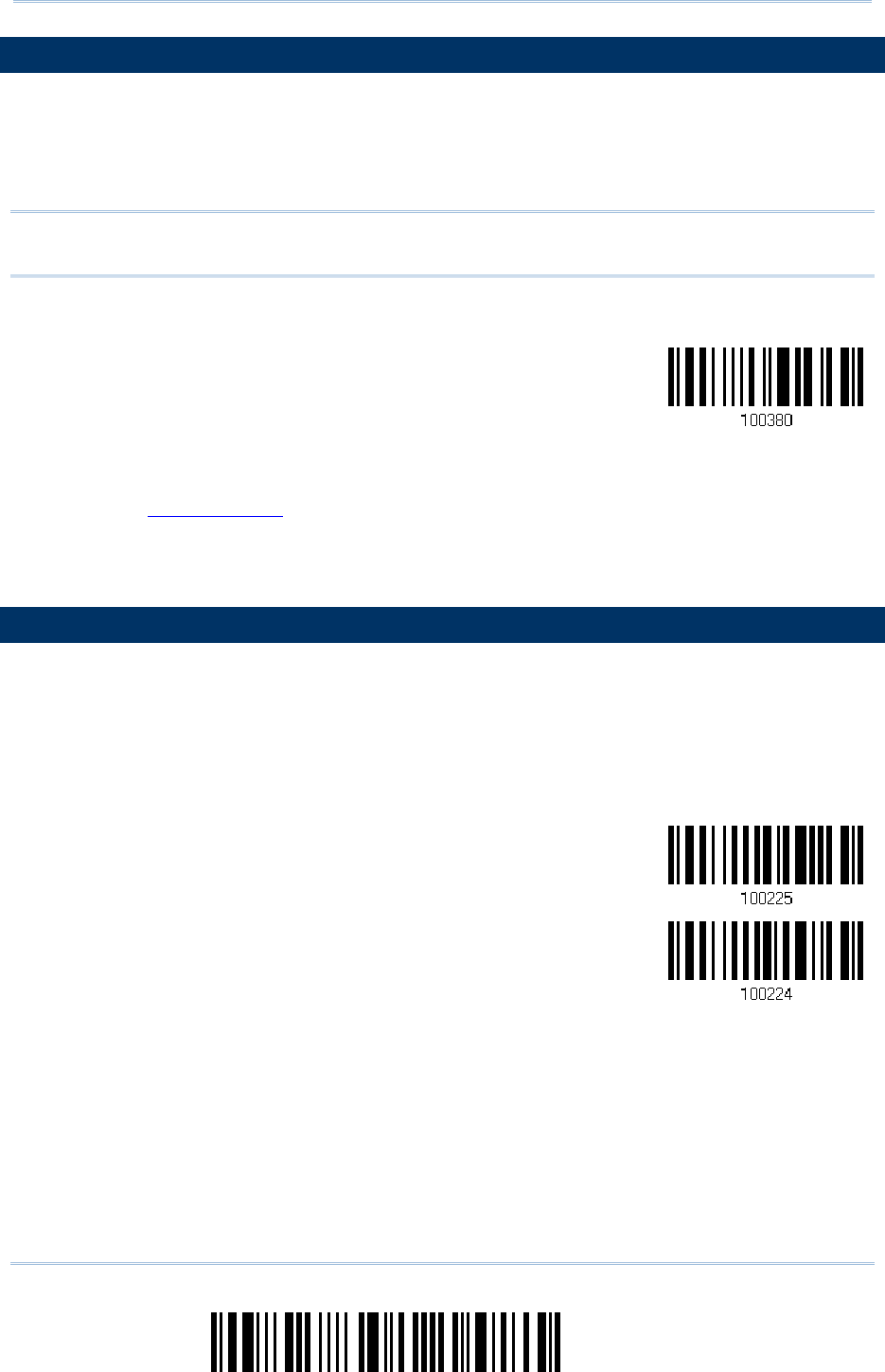
46
Enter Setup
1662 L/1664 Barcode Scanner User Guide
1.11 ADDON SECURITY FOR UPC/EAN BARCODES
The scanner is capable of decoding a mix of UPC/EAN barcodes with and without addons.
The read redundancy (0~30 times) allows changing the number of times to decode a
UPC/EAN barcode before transmission. The more redundancy selected, the higher the
reading security is, and thus, the slower the reading speed becomes.
Note: UPC/EAN Addon 2 and Addon 5 must be enabled individually for this setting to
take effect.
Addon Security Level
(*0~30)
1) Read the barcode above to specify the read redundancy for UPC/EAN barcodes. (It is
set to 0 by default.)
2) Read the “Decimal Value” barcode on page 錯誤! 尚未定義書籤。. For example, read “1”
and “2” for the scanner to re-read the barcode for 12 times.
3) Read the “Validate” barcode on the same page to complete this setting.
1.12 NEGATIVE BARCODES
Normally, barcodes are printed with the color of the bars darker than that of the spaces.
But for negative barcodes, they are printed in the opposite sense just like negative films.
The spaces of negative barcodes are printed with a color darker than that of the bars.
Configure the scanner to be able to read negative barcodes if required.
Enable
*Disable
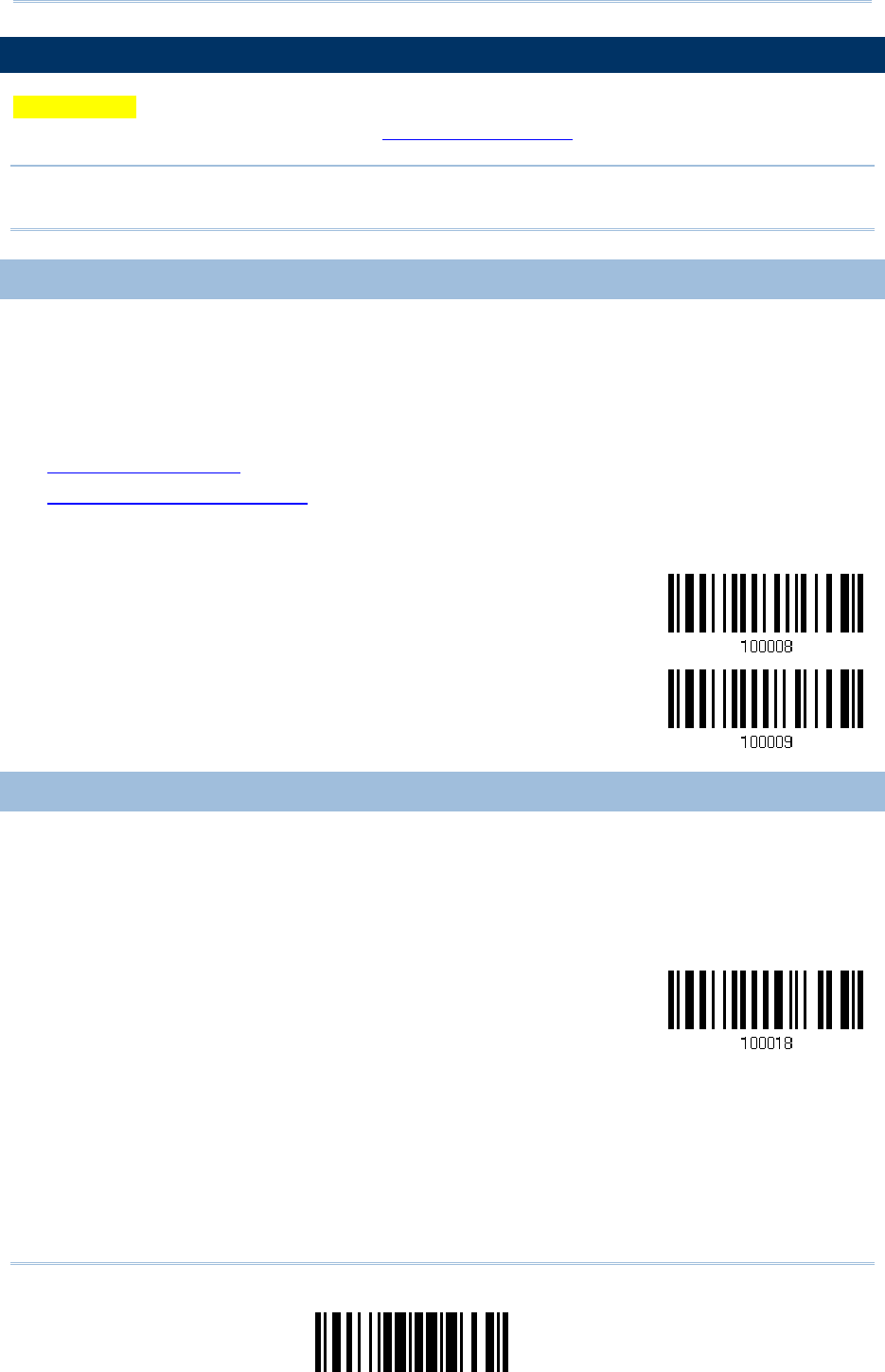
47
Update
Chapter 1
Understanding the Barcode Scanner
1.13 USE DIRECT USB CABLE
1662 L/1664 supports Direct USB interface for charging the battery and/or sending data
to the host in memory mode. Refer to 1.2.2 Memory Mode.
Note: The scanner will not function when it is solely on USB power and without a battery
loaded.
1.13.1 DIRECT USB INTERFACE
When it is set to Memory Mode and connected to computer via the Direct USB cable, the
default output interface becomes “Direct USB Virtual COM”, change it to “Direct USB
HID” if required.
For details on configuring the interface settings, refer to the following sections:
2.6 Direct USB HID
2.7 Direct USB Virtual COM
*Activate Direct
USB Virtual COM
Activate Direct
USB HID
1.13.2 DISABLE DIRECT USB INTERFACE
When connecting the USB cable to the scanner for charging the battery, ensure the
“Disable Direct USB” barcode has been scanned to avoid sending data to the host in
memory mode. In this mode the USB cable function will be charging the battery only.
Disable Direct USB
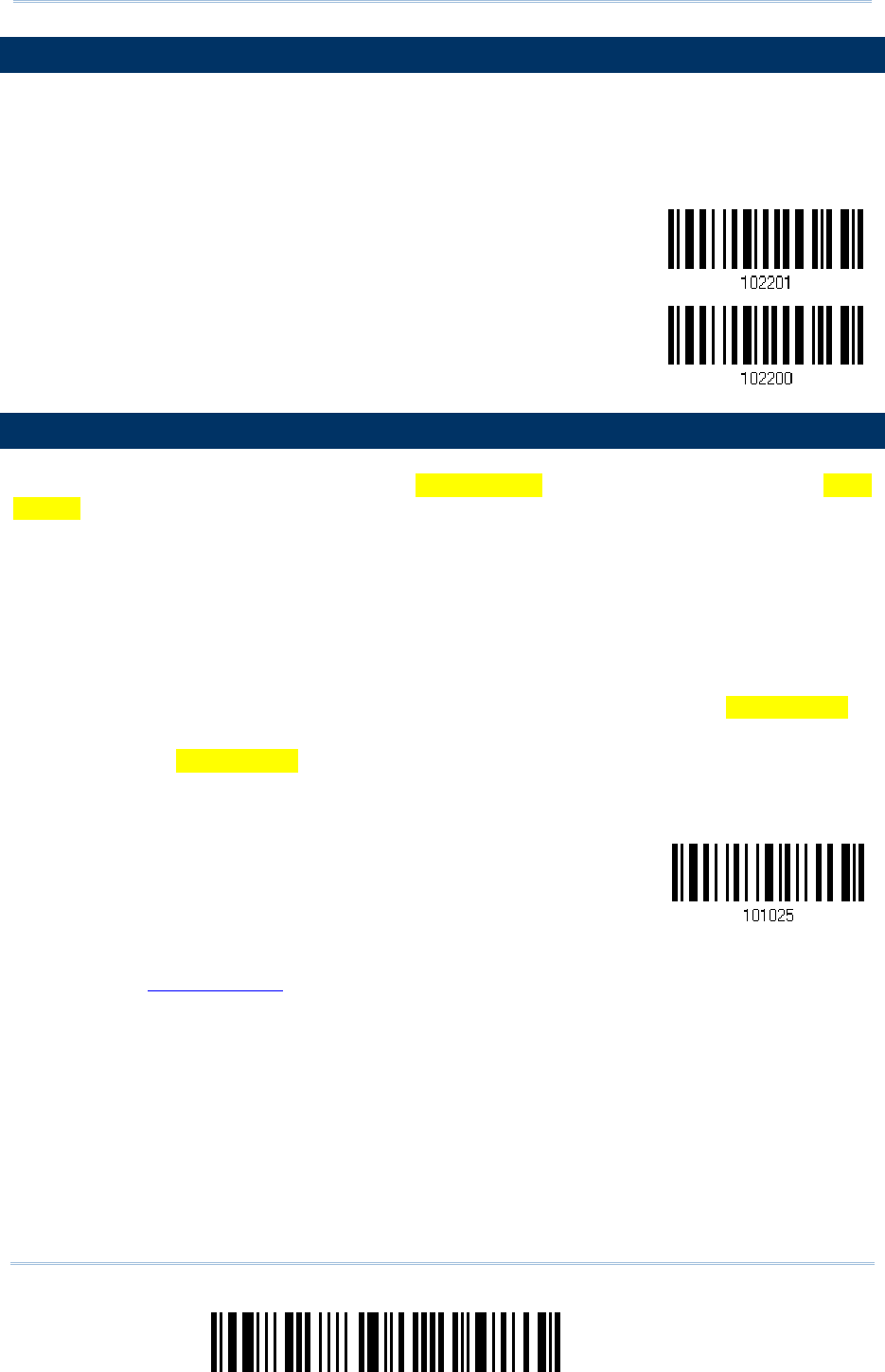
48
Enter Setup
1662 L/1664 Barcode Scanner User Guide
1.14 PICKLIST MODE (1664 ONLY)
Picklist mode enables the decoder to decode only the barcodes aligned under the center
of the laser aiming pattern.
Enable
*Disable
1.15 PAGER BEEP DURATION
Paging function is only activated when 1662 L/1664 is in Power-Saving mode. 1662
L/1664 can be woken up via receiving any Bluetooth® status command by pressing a key
on the host keyboard. The buzzer will continuously sound two short high tone beeps until
the power key is pressed on the scanner or the timeout is reached, and the scanner
re-enters power saving mode.
By default, the pager beep duration is 5 seconds. Specify a value, ranging from 0 to 15.
(0~15 sec.; 0= Disable)
Bluetooth® HID profile: Press any one of the following keys “Scroll Lock”, “Number
Lock” or “Caps Lock” on the host computer to trigger the waking up of 1662 L/1664.
Bluetooth® SPP Profile: Any command sent using Bluetooth® SPP will trigger the
waking up of 1662 L/1664.
Pager Beep Duration
0
~15 sec.
(*5 s)
1) Read the barcode above to specify the desired beep active time.
2) Read the “Decimal Value” barcode on page 錯誤! 尚未定義書籤。. For example, read “1”
and “5” for the pager beep function to be activated each 15 seconds after entering
Power-Saving mode.
3) Read the “Validate” barcode on the same page to complete this setting.
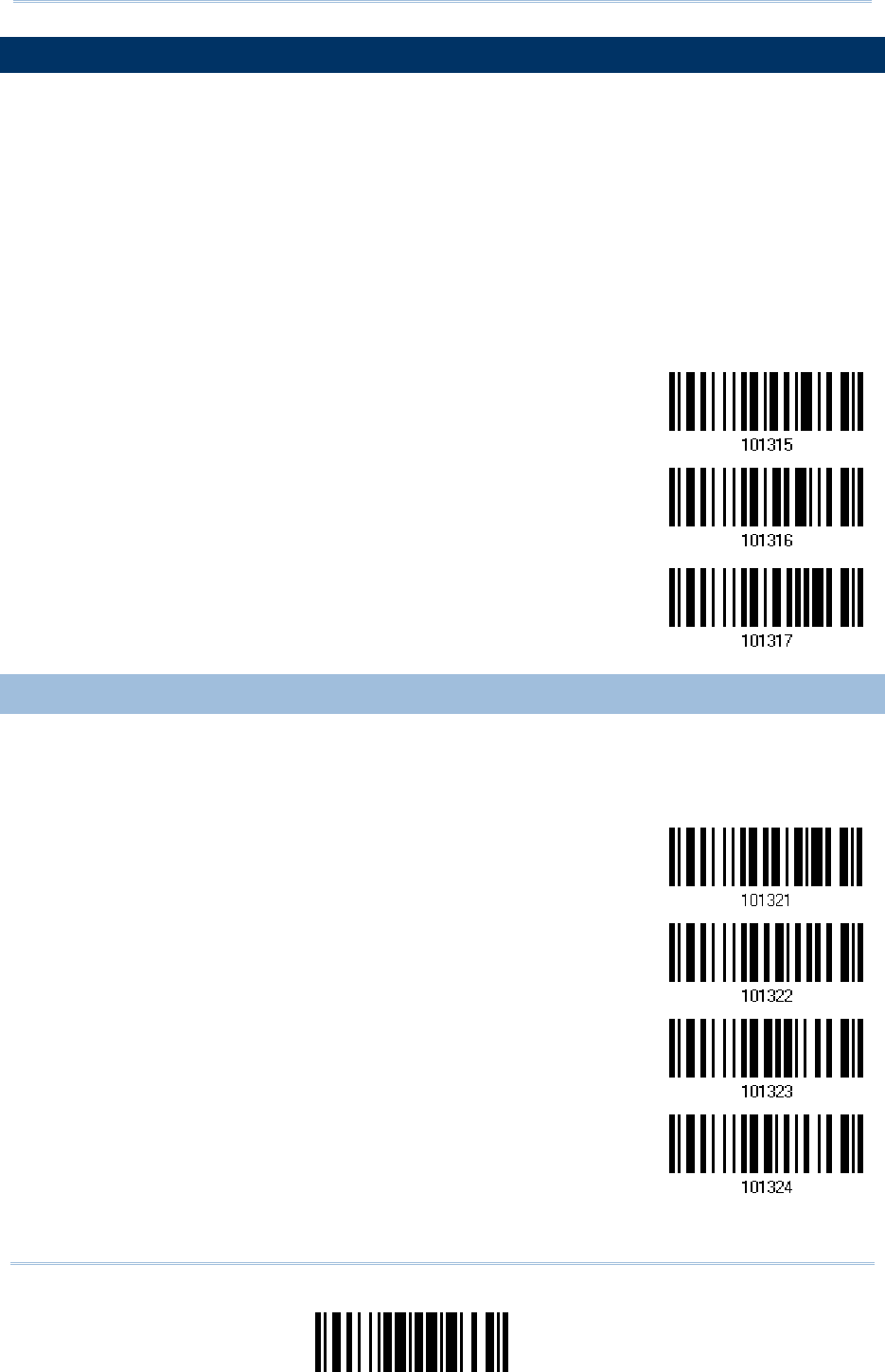
49
Update
Chapter 1
Understanding the Barcode Scanner
1.16 TIME STAMP
Specify time stamp format added to the prefix or suffix of a data. Up to three settings
can be configured:
No Time Stamp
Add Time Stamp in front of data
Add Time Stamp to the end of data
If added in front of data, it means prior to the prefix field. Alternatively, to the end of
data.
No Time Stamp
*Disable
Add Time Stamp
in front of Data
Add Time Stamp
to the end of Data
1.16.1 DATE AND TIME SETTINGS
Read the barcode below to enable/disable Date and Time function.
Year Output
*Enable
Year Output
Disable
Month Output
*Enable
Month Output
Disable
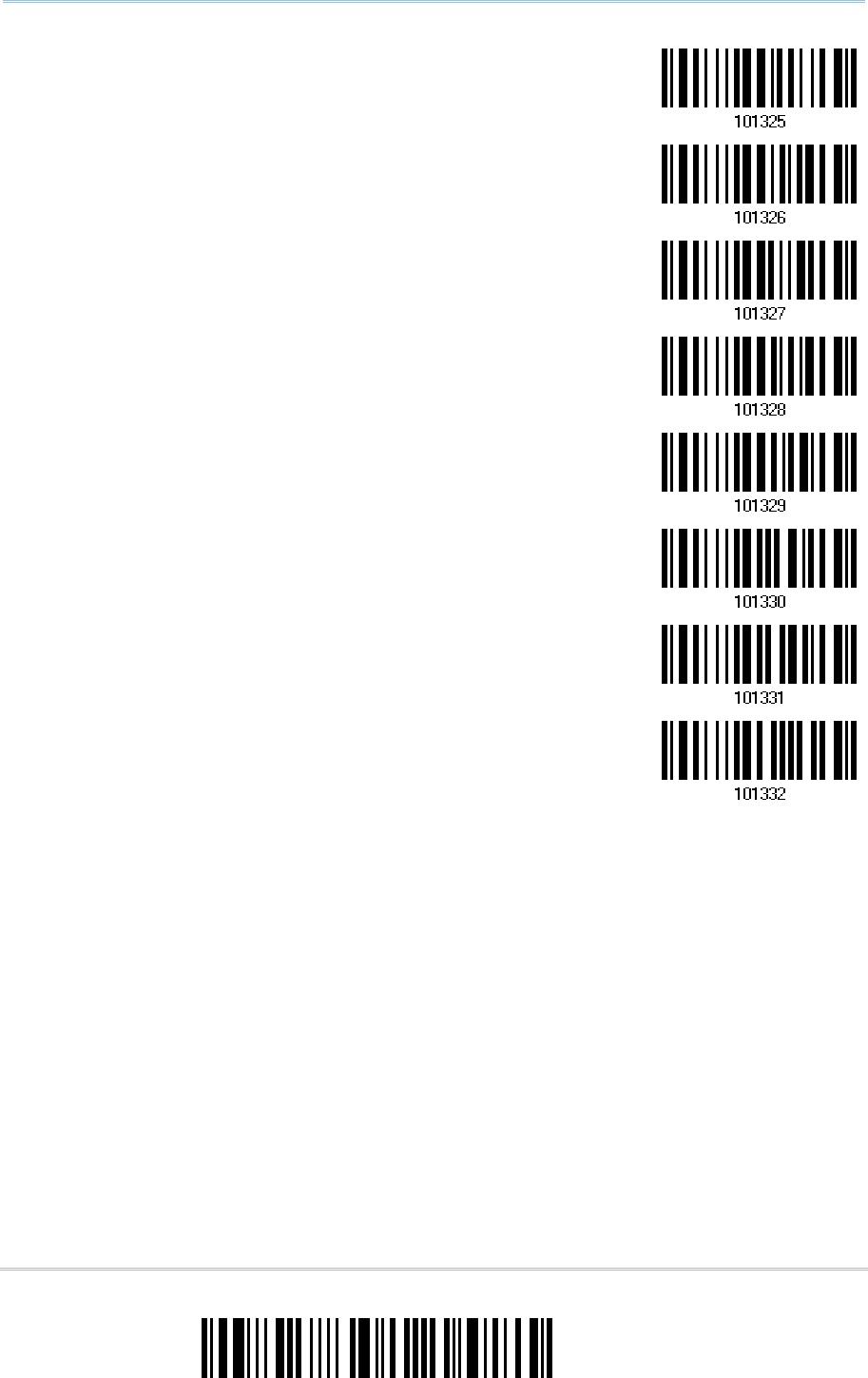
50
Enter Setup
1662 L/1664 Barcode Scanner User Guide
Date Output
*Enable
Date Output
Disable
Hour Output
*Enable
Hour Output
Diable
Minute Output
*Enable
Minute Output
Disalbe
Second Output
*Enable
Second Output
Diable
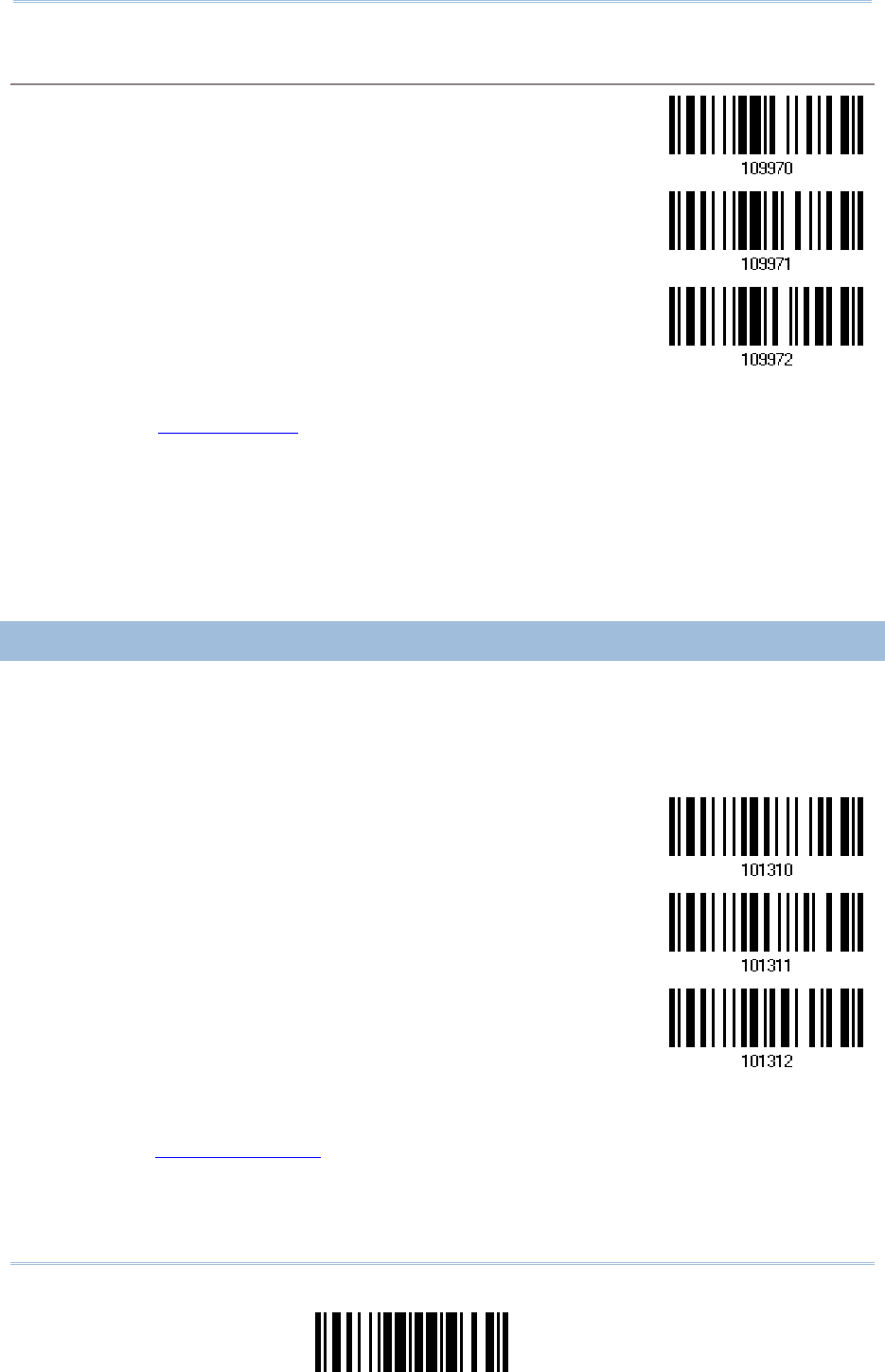
51
Update
Chapter 1
Understanding the Barcode Scanner
Decoding Data and Time
Year Setup
Date Setup
Time Setup
1) Read the barcode above to apply time or date code separately, and follow steps 2~3.
2) Read the “Decimal Value” barcode on page 錯誤! 尚未定義書籤。 for the desired
character string. For example:
Year: Read “2”, “0”, “1”, “1” for the year setting as year=2011.
Date: Read “1”, “1”, ”2”, “0” for the date setting as date=Nov.20.
Time: Read “1”, “8”, “5”, “9” for the time setting as time=18:59.
3) Read the “Validate” barcode for each setting on the same page.
1.16.2 SEPARATOR FOR DATE AND TIME
The Date and Time can be split with a pre-selected separator, for example, “/” as
YYYY/MM/DD or “:” as HH:MM:SS
Separator for
Date/Time
*“-”
Separator for
Month/Date
*“/”
Separator for
Hour/Minute
*“:”
1) Read the barcode above to apply separator to date or time separately, and follow
steps 2~3.
2) Read the “Hexadecimal Value” barcode on page 錯誤! 尚未定義書籤。 for the desired
character string. For example, read “3” and “A” for the separator to split the data with
character [:].
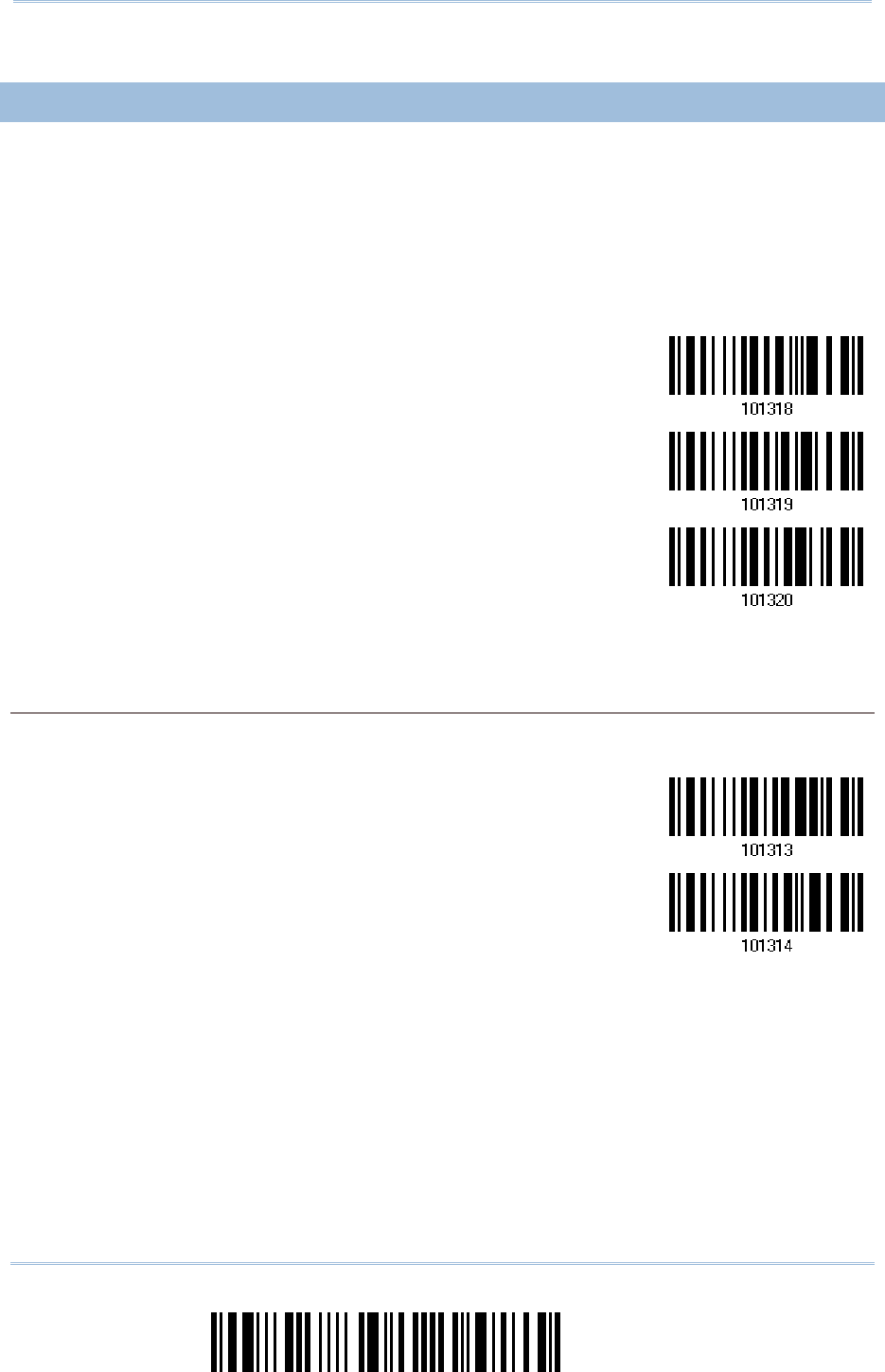
52
Enter Setup
1662 L/1664 Barcode Scanner User Guide
3) Read the “Validate” barcode on the same page to complete this setting.
1.16.3 DATE FORMAT
The date format includes year, month and day. There are three kinds of combinations
can be configured to specify Year, Month and Day:
Year/Month/Day (YYYY/MM/DD) or (YY/MM/DD)
Month/Day/Year (MM/DD/YYYY) or (MM/DD/YY)
Day/Month/Year (DD/MM/YYYY) or (DD/MM/YY)
*Year/Month/Day
Month/Day/Year
Day/Month/Year
About Year Format:
Year format can be pre-selected as 2-digit or 4-digit. For example, if year format is YYYY, the
output year is 2011 for 4-digit, alternatively is 11 for 2-digit.
*Year for 4-digit
Year for 2-digit
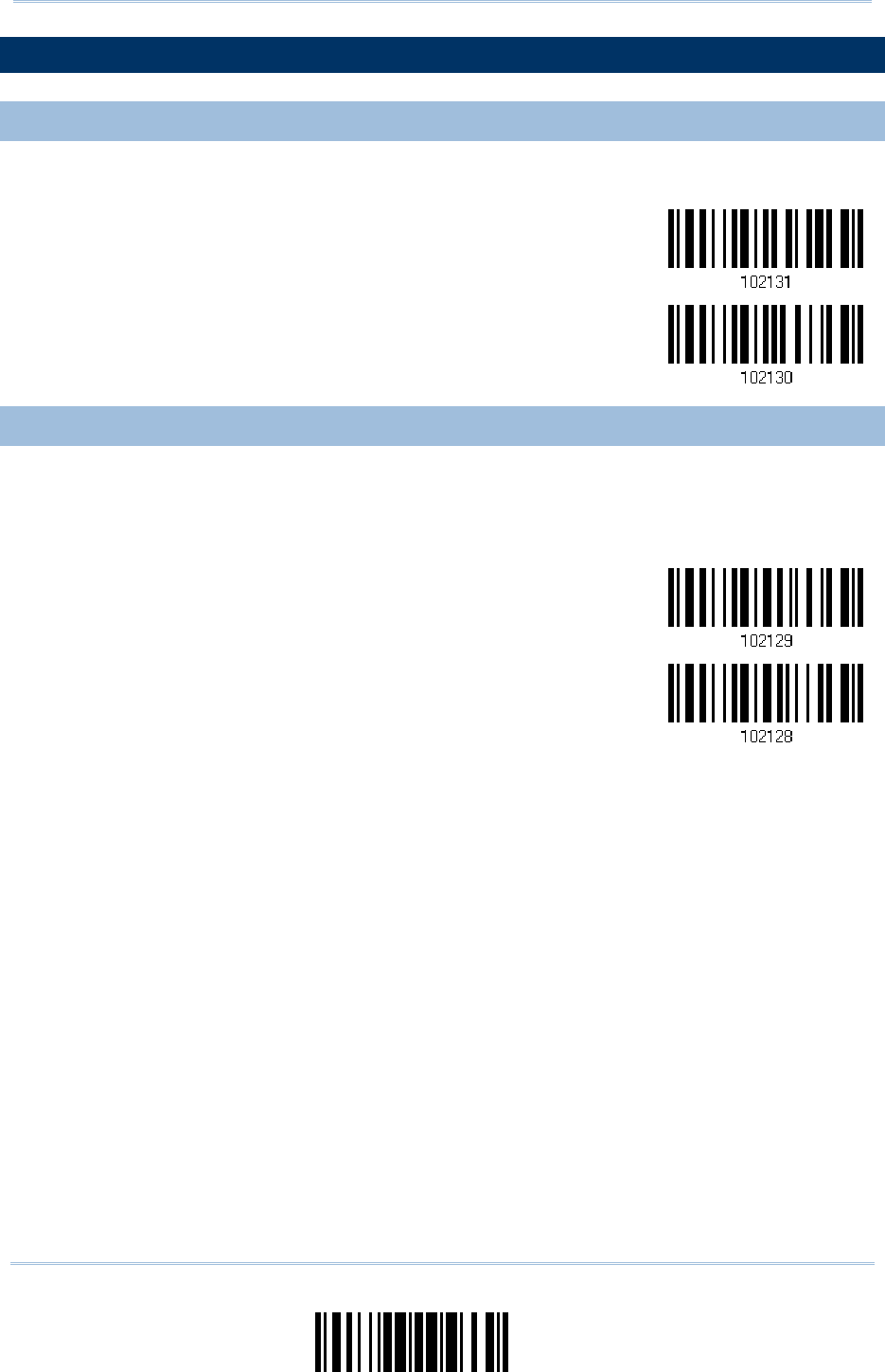
53
Update
Chapter 1
Understanding the Barcode Scanner
1.17 2D DECODE SETTING (1664 ONLY)
1.17.1 AIMING PATTERN
Enable/Disable the aiming pattern during scanning.
*Enable
Disable
1.17.2 DECODING ILLUMINATION
Enable/Disable illumination during scanning.
Enabling illumination usually results in superior images. The effectiveness of the
illumination decreases as the distance to the target increases.
*Enable
Disable
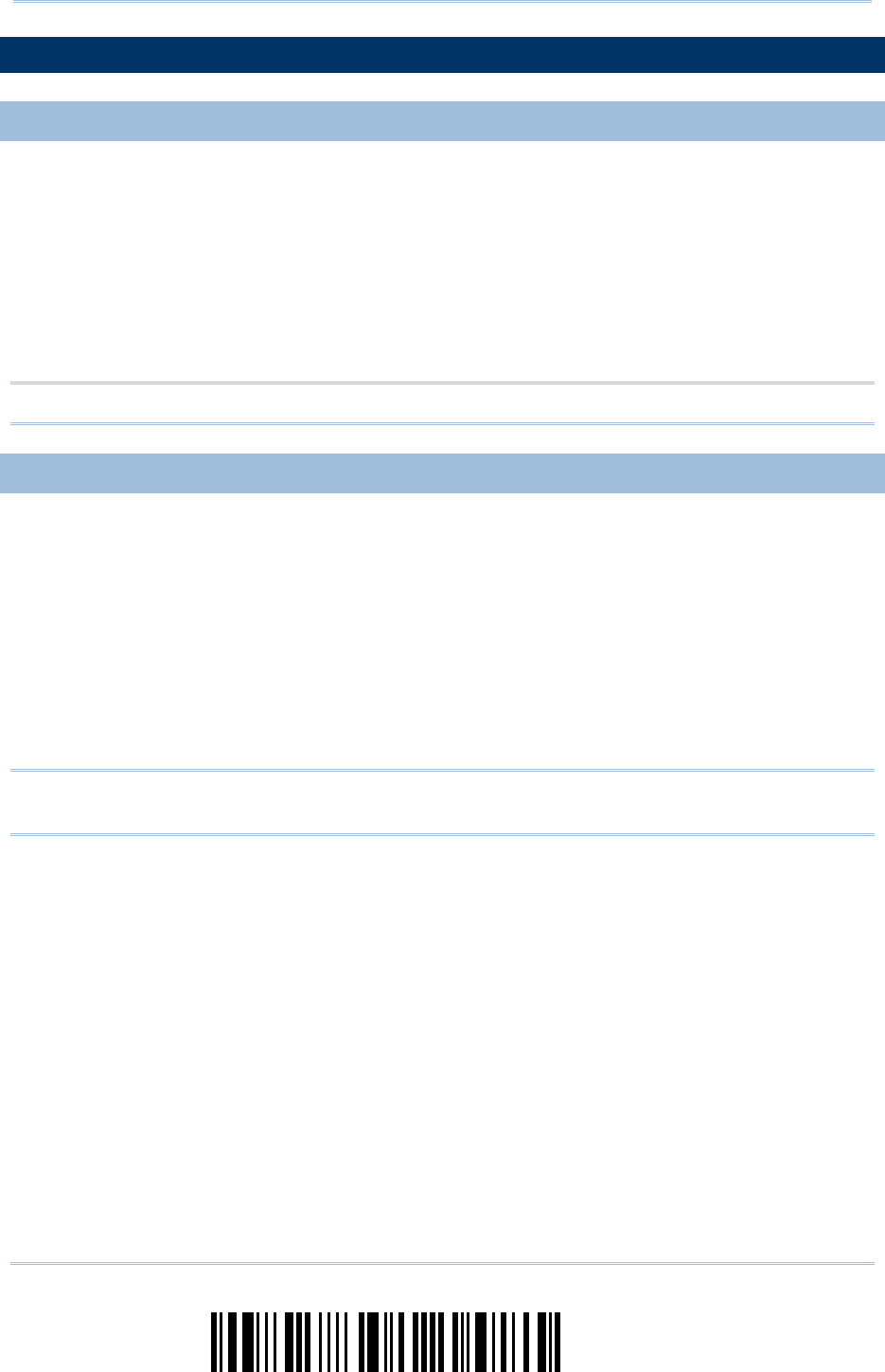
54
Enter Setup
1662 L/1664 Barcode Scanner User Guide
1.18 HARDWARE RESET
1.18.1 RESTORE SYSTEM DEFAULTS
In addition to using the “Restore System Defaults” barcode, the following procedure
using key combinations, can be used to restore the system defaults during operation.
1) Hold down the [Power/Delete] key.
2) When the scanner responds with two short beeps (high tone), press the [Trigger] key
for 5 seconds. The scanner LED indicator becomes solid red and then goes off.
3) When the scanner responds with a long beep (high tone), release the keys. Its LED
indicator becomes solid red and goes off.
Note: The scanner will restart itself automatically.
1.18.2 RESET CONNECTION
When the output interface is Bluetooth® HID or Bluetooth® SPP Master, the scanner will
attempt to maintain an established connection. To stop such re-connection, read the
“Reset Connection” or “Restore System Defaults” barcode to clear the current connection
record. Alternatively, use the key combination as described below to reset connection
during operation.
1) Hold down the [Trigger] key, and then press the [Power/Delete] key for at least 5
seconds.
2) The scanner will respond with two short beeps (high tone). Wait until the scanner
responds with a long beep (high tone), release the keys.
Note: After reset connection by hardware, the scanner will not restart itself automatically.
It will resume to its previous operation except no connection.

55
Update
Chapter 1
Understanding the Barcode Scanner

57
Update
In order to establish a proper connection between host computer and the scanner, we
suggest following these instructions –
1) Install battery and hold down the [Power/Delete] key for 2 seconds to turn on the
scanner.
2) Read the “Enter Setup” barcode to enter the configuration mode.
3) Read the associated barcodes to activate the desired interface.
See the following sections for output interfaces supported.
4) Read the barcodes for related settings.
5) Read the “Update” barcode to exit the configuration mode.
6) Turn on host computer or laptop and establish a WPAN connection with the scanner.
Refer to Chapter 3 – Setting up a WPAN Connection.
Note: (1) By default, the output interface is set to “Bluetooth® HID”.
(2) When set to Memory Mode and connected to computer via the Direct USB
cable, the default output interface becomes “Direct USB Virtual COM”.
IN THIS CHAPTER
2.1 Bluetooth® HID ......................................................... 56
2.2 Bluetooth® SPP Slave ................................................. 68
2.3 Bluetooth® SPP Master ............................................... 70
2.4 USB HID via 3610 ...................................................... 74
2.5 USB Virtual COM via 3610 ........................................... 85
2.6 Direct USB HID .......................................................... 87
2.7 Direct USB Virtual COM ............................................... 98
Chapter 2
SELECTING OUTPUT INTERFACE
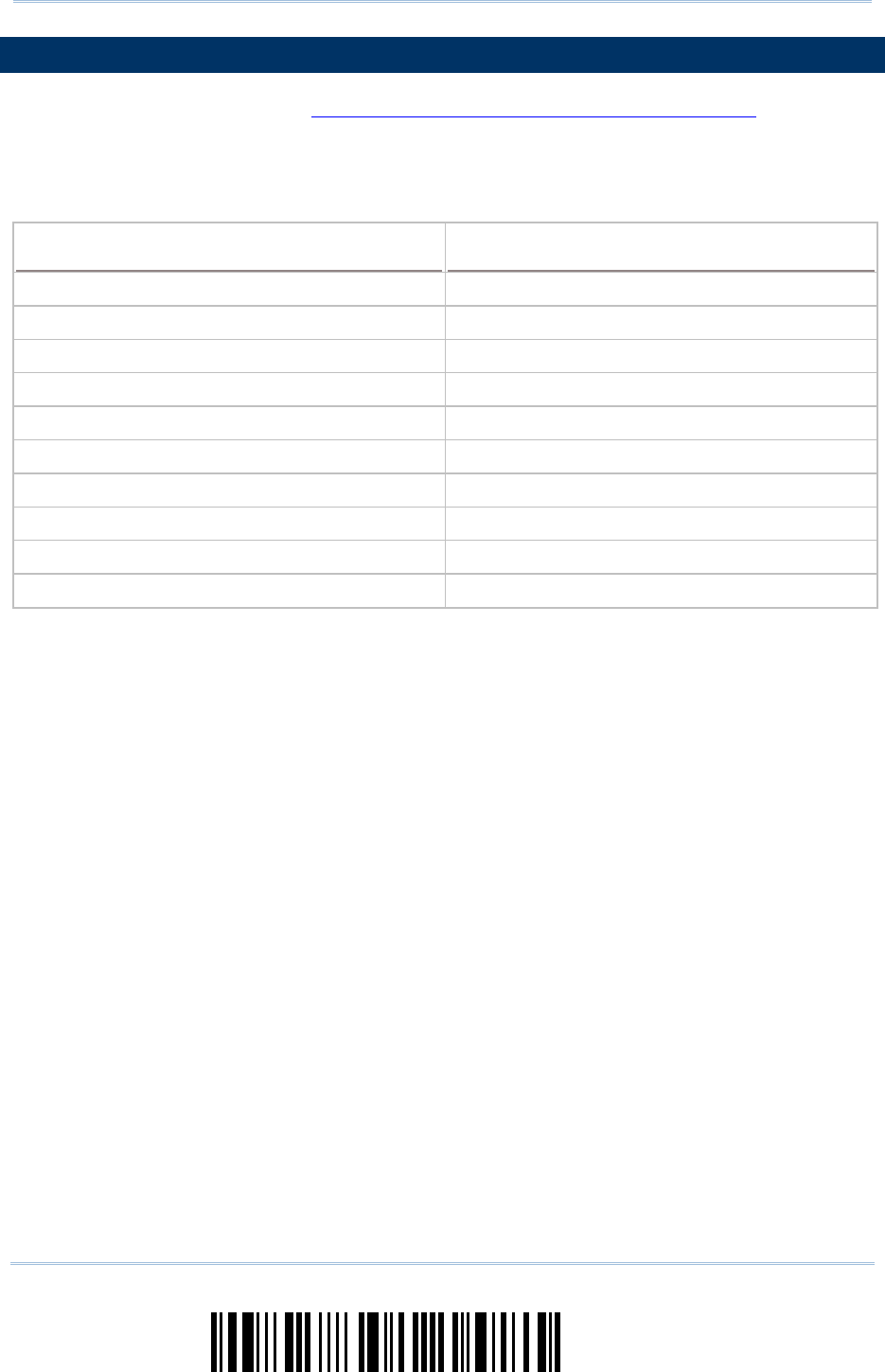
58
Enter Setup
1662 L/1664 Barcode Scanner User Guide
2.1 BLUETOOTH® HID
For Bluetooth® HID, refer to Chapter 3 – Setting up a WPAN Connection for related
connection settings. The scanned data will be transmitted to the computer. To capture
the data run any text editor on your computer.
HID Settings Defaults
Keyboard Type PCAT (US)
Alphabet Layout Normal
Numeric Layout Normal
Capital Lock Type Normal
Capital Lock State Off
Alphabet Transmission Case-sensitive
Numeric Transmission Alphanumeric keypad
Kanji Transmission Disable
Inter-Character Delay 0 (ms)
Inter-Function Delay 0 (ms)
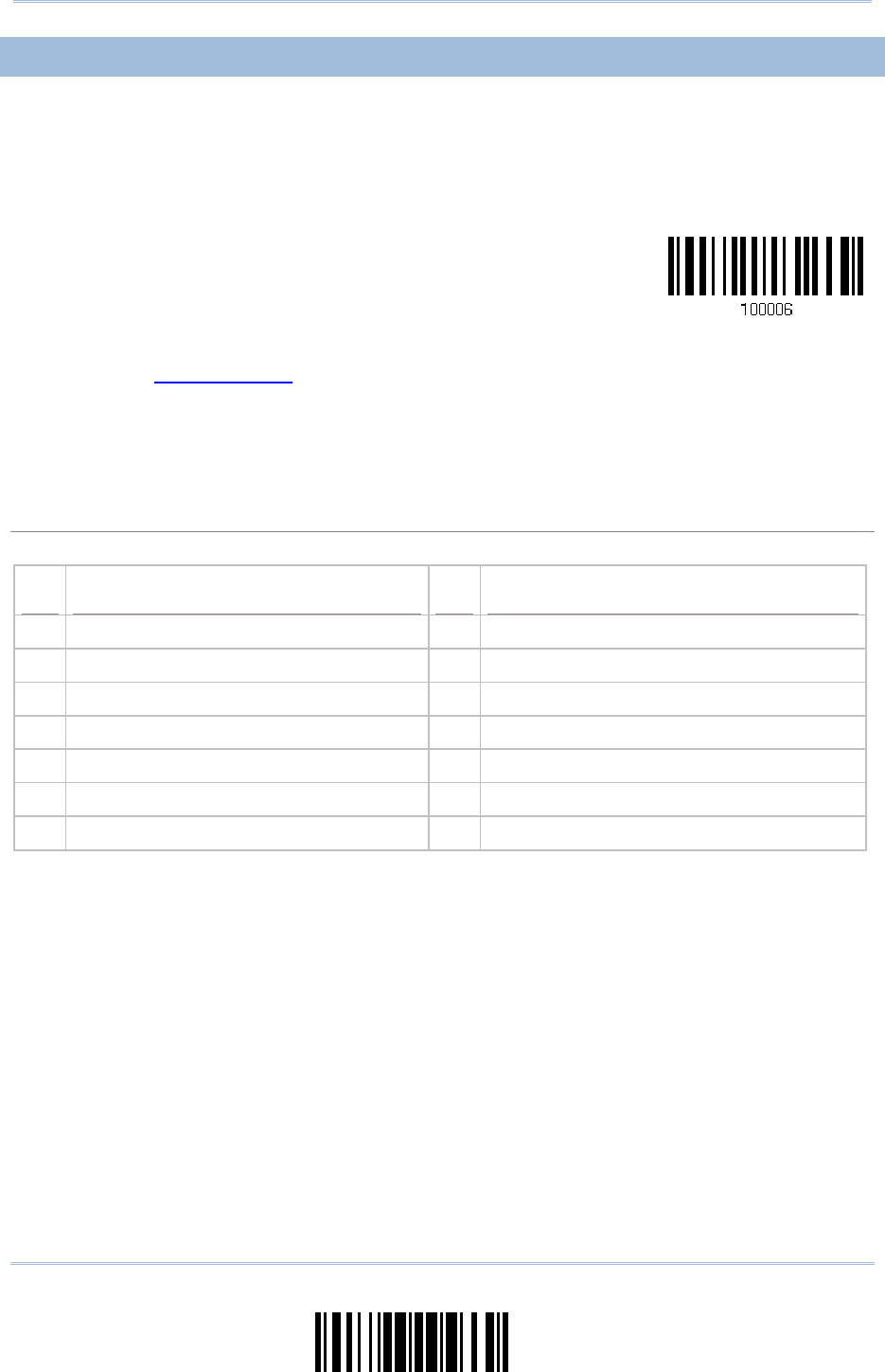
59
Update
Chapter 2
Selecting Output Interface
2.1.1 ACTIVATE BLUETOOTH® HID & SELECT KEYBOARD TYPE
When Bluetooth® HID interface is activated, you will have to select a keyboard type to
complete this setting. By default, Bluetooth® HID is activated on the scanner, and the
keyboard type is set to PCAT (US).
Activate Bluetooth®
HID & Select Keyboard
Type…
1) Read the barcode above to activate Bluetooth® HID and select a keyboard type.
2) Read the “Decimal Value” barcode on page 錯誤! 尚未定義書籤。. Refer to the table
below for the number of desired keyboard type.
3) Read the “Validate” barcode on the same page to complete this setting.
Bluetooth® HID
The following keyboard types are supported —
No. Keyboard Type No.
Keyboard Type
64 PCAT (US) 71 PCAT (Belgium)
65 PCAT (French) 72 PCAT (Spanish)
66 PCAT (German) 73 PCAT (Portuguese)
67 PCAT (Italy) 74 PS55 A01-2 (Japanese)
68 PCAT (Swedish) 75 User-defined table
69 PCAT (Norwegian) 76 PCAT (Turkish)
70 PCAT (UK) 77 PCAT (Hungarian)
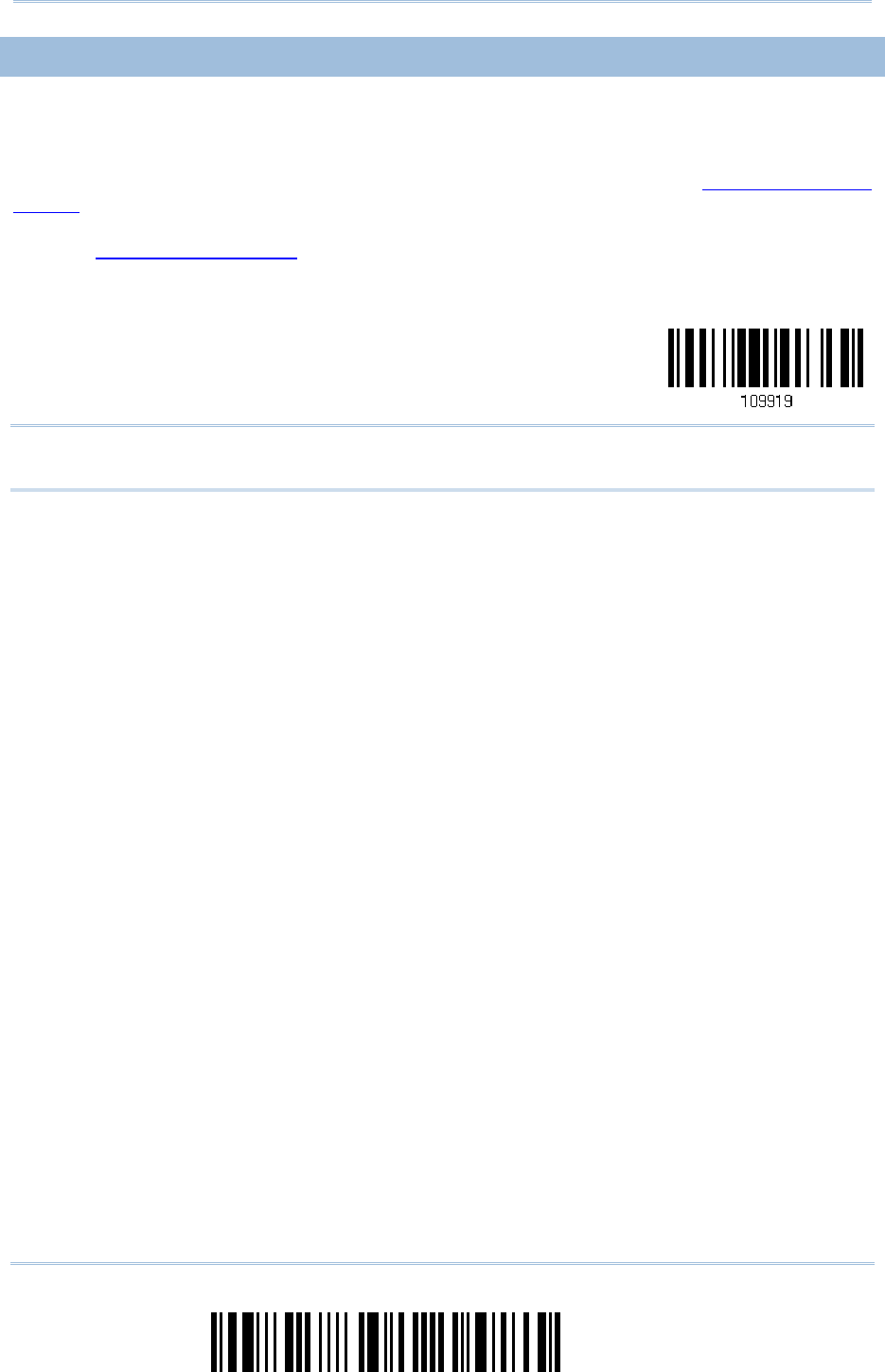
60
Enter Setup
1662 L/1664 Barcode Scanner User Guide
2.1.2 RESET CONNECTION
For Bluetooth® HID, you can only have the scanner connected to one computer at a time.
If you want to connect the scanner to another host, you must read the “Reset
Connection” barcode so that the current connection record will be cleared. Then, the
scanner will restart itself automatically. Go through the process in 3.2.3 Connect to
Dongle to establish a new connection.
Refer to 1.18 Hardware Reset.
Reset Connection
Note: The “Restore System Defaults” barcode will also clear the current connection
record.
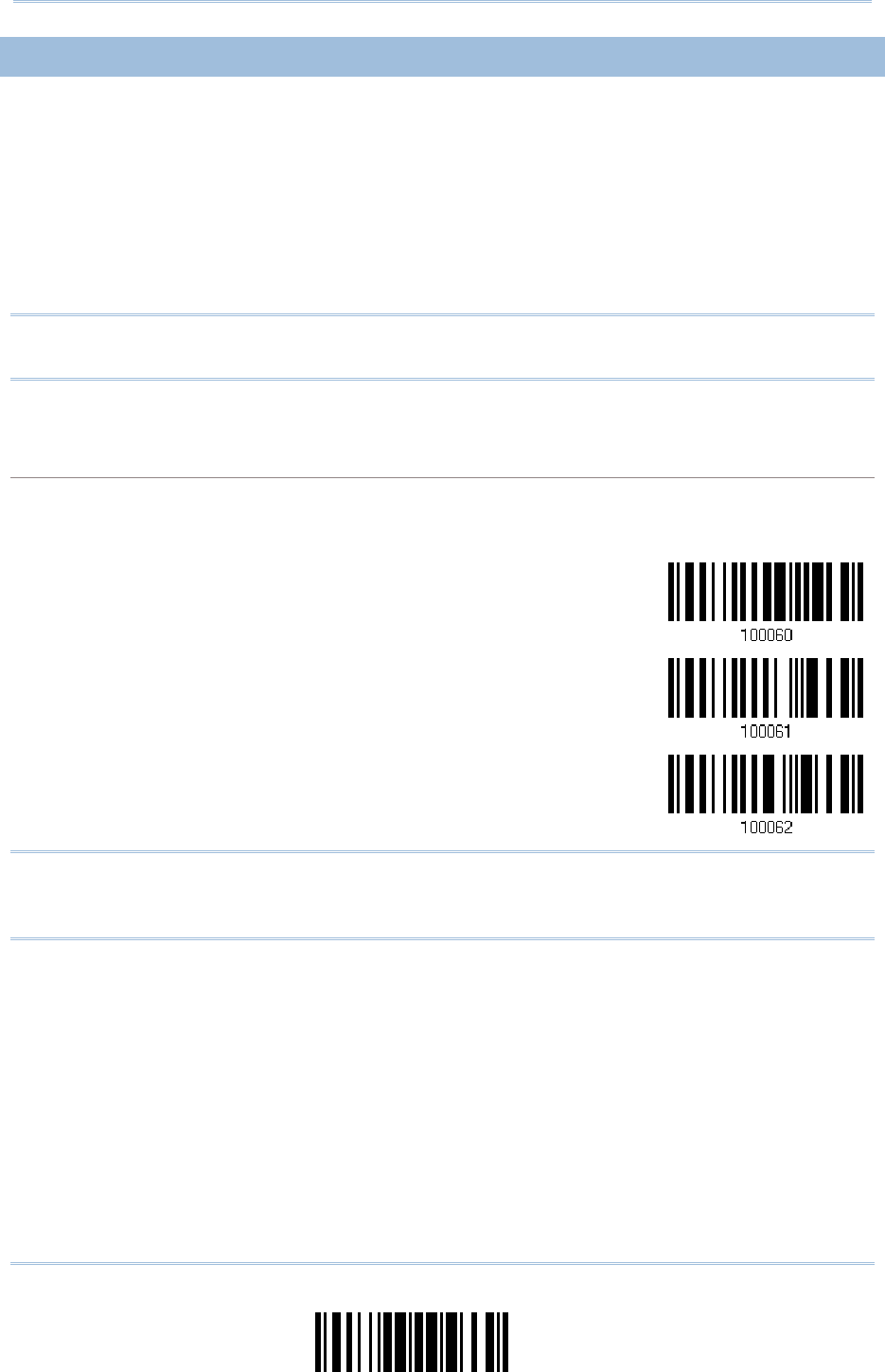
61
Update
Chapter 2
Selecting Output Interface
2.1.3 KEYBOARD SETTINGS
Alphabet Layout
Numeric Layout
Capital Lock Type
Capital Lock Setting
Alphabet Transmission
Numeric Transmission
Kanji Transmission
Note: Bluetooth® HID does not support these functions on PDAs – (1) Capital Lock
Setting: Auto Detection (2) Numeric Transmission: Numeric Keys
Alphabet Layout
By default, the alphabet layout is set to normal mode, also known as the standard English layout.
Select French or German keyboard layout if necessary. The scanner will make adjustments when
sending the "A", "Q", "W", "Z", "Y", and "M" characters according to this setting.
*Normal
AZERTY
QWERTZ
Note: This setting only works when the keyboard type selected is US keyboard, such as
PCAT (US). The Alphabet Layout and Numeric Layout setting must match your
keyboard.
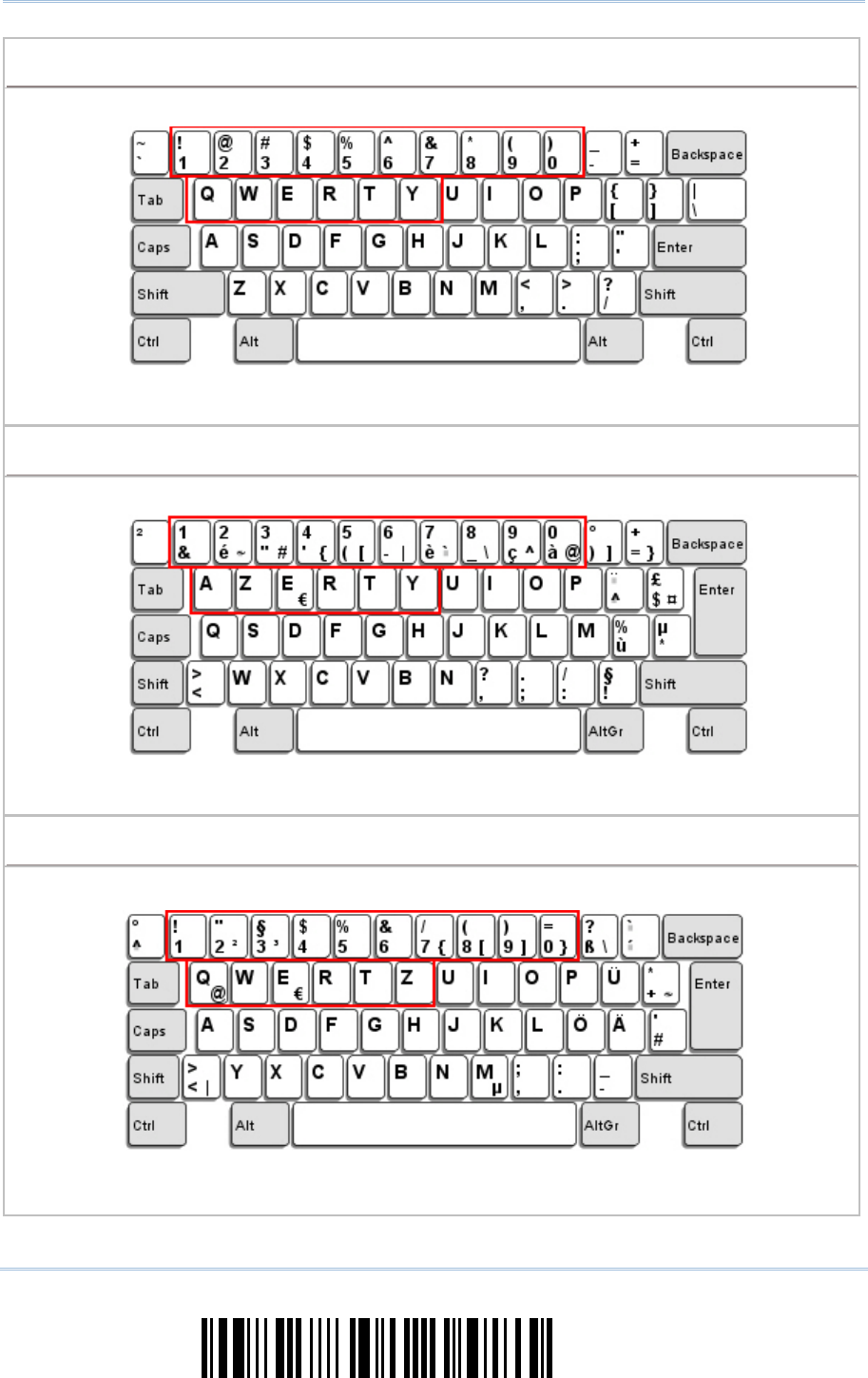
62
Enter Setup
1662 L/1664 Barcode Scanner User Guide
US Keyboard Style – Normal
QWERTY layout, which is normally used in western countries.
Select “Lower Row” for the “Numeric Layout” setting for the upper row is for special
characters.
French Keyboard Style – AZERTY
French layout; see below for French Keyboard Style.
Select “Upper Row” for the “Numeric Layout” setting for the lower row is for special
characters.
German Keyboard Layout – QWERTZ
German layout; see below for German Keyboard Style.
Select “Lower Row” for the “Numeric Layout” setting for the upper row is for special
characters.
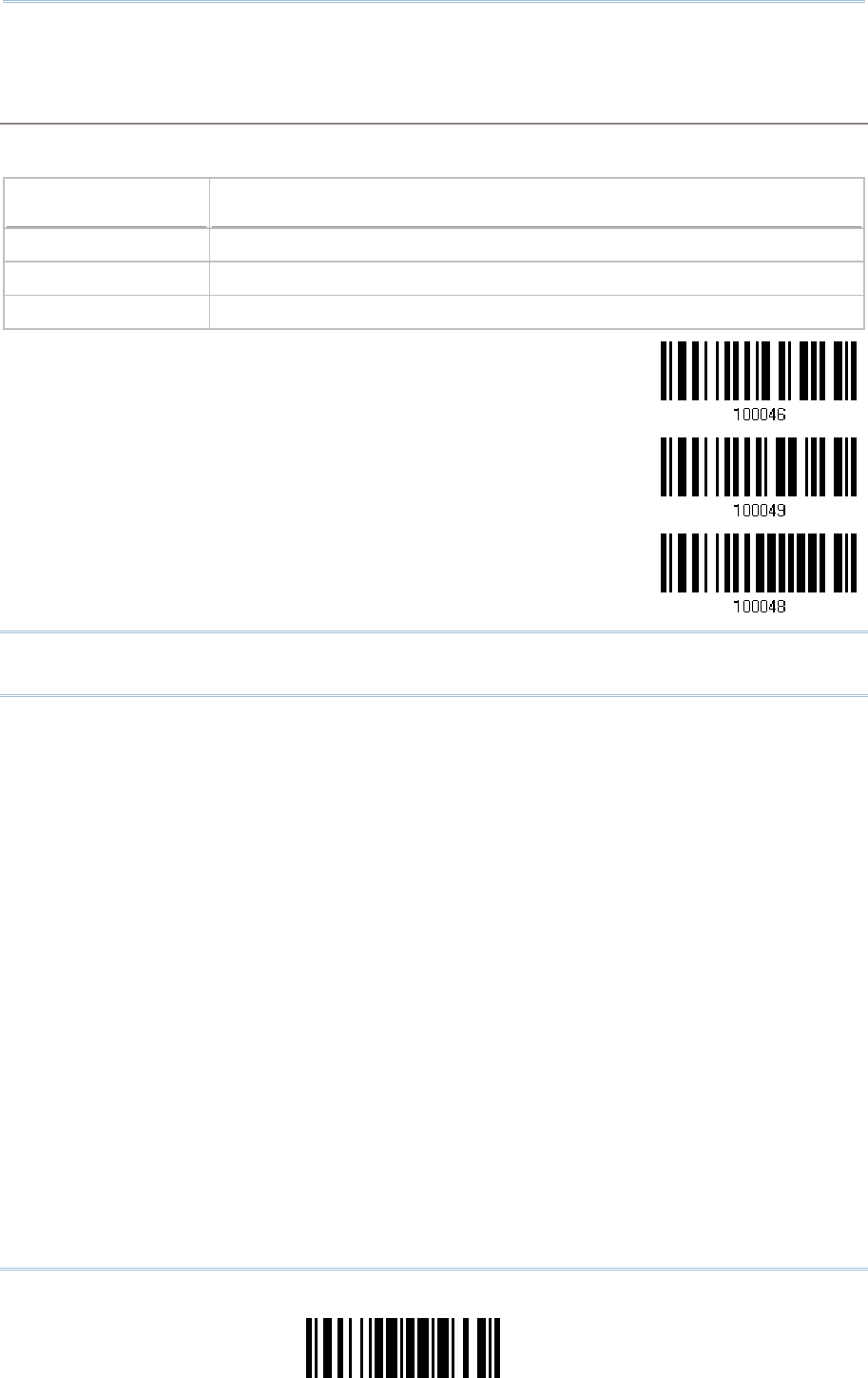
63
Update
Chapter 2
Selecting Output Interface
Numeric Layout
Select a proper layout that matches the alphabet layout. The scanner will make adjustments
according to this setting.
Options Description
Normal Depends on the [Shift] key or [Shift Lock] setting
Lower Row For QWERTY or QWERTZ keyboard
Upper Row For AZERTY keyboard
*Normal
Upper Row
Lower Row
Note: This setting is to be used with the Character Substitution setting when support for
certain keyboard types (languages) is unavailable but required.
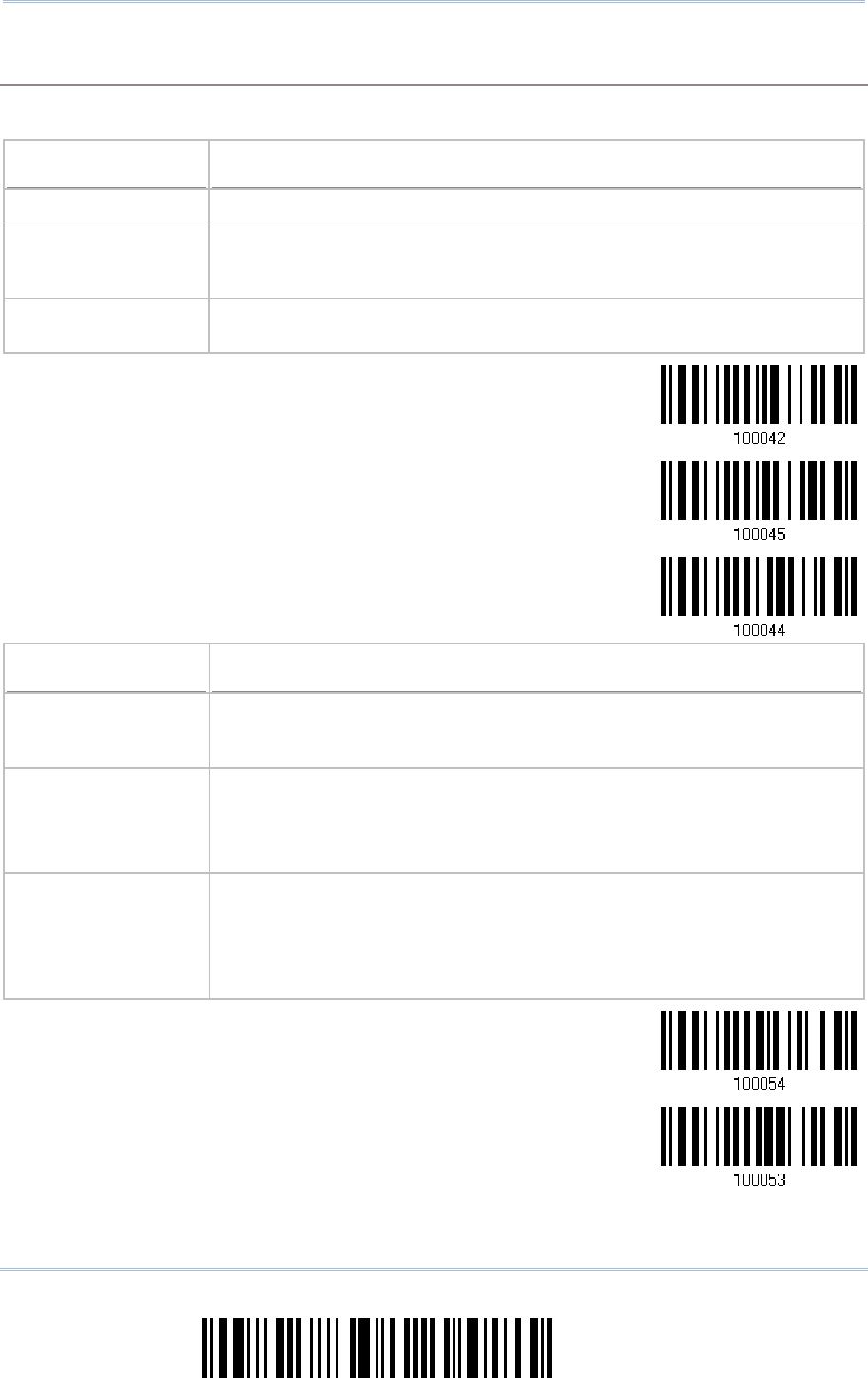
64
Enter Setup
1662 L/1664 Barcode Scanner User Guide
Capital Lock Type & Setting
In order to send the alphabet with correct case, the scanner needs to know the status of Caps Lock
on the keyboard. Incorrect settings may result in reversed case of the alphabet being transmitted.
Cap Lock Type Description
Normal Normal type
Capital Lock When enabled, the keys of alphabetic characters will be interpreted as
capital letters. However, this does not affect the number or punctuation
keys.
Shift Lock When enabled, the keys of alphabetic characters will be interpreted as
capital letters. In addition, this affects the number or punctuation keys.
*Normal
Shift Lock
Capital Lock
Capital Lock State Description
Capital Lock OFF Assuming that the status of Caps Lock on the keyboard is OFF,
transmitted characters are exactly the same as in the barcode (when
"case-sensitive" is selected for Alphabet Transmission).
Capital Lock ON Assuming that the status of Caps Lock on the keyboard is ON, transmitted
characters are exactly the same as in the barcode (when "case-sensitive"
is selected for Alphabet Transmission).
Refer to the Capital Lock Type above.
Auto Detection
(Suggested use for
most applications)
T
he scanner will automatically detect the status of Caps Lock on the
keyboard before data is transmitted; transmitted characters are exactly
the same as in the barcode (when "case-sensitive" is selected for
Alphabet Transmission).
This setting is not supported on PDAs.
Auto Detect
Capital Lock ON

65
Update
Chapter 2
Selecting Output Interface
*Capital Lock OFF
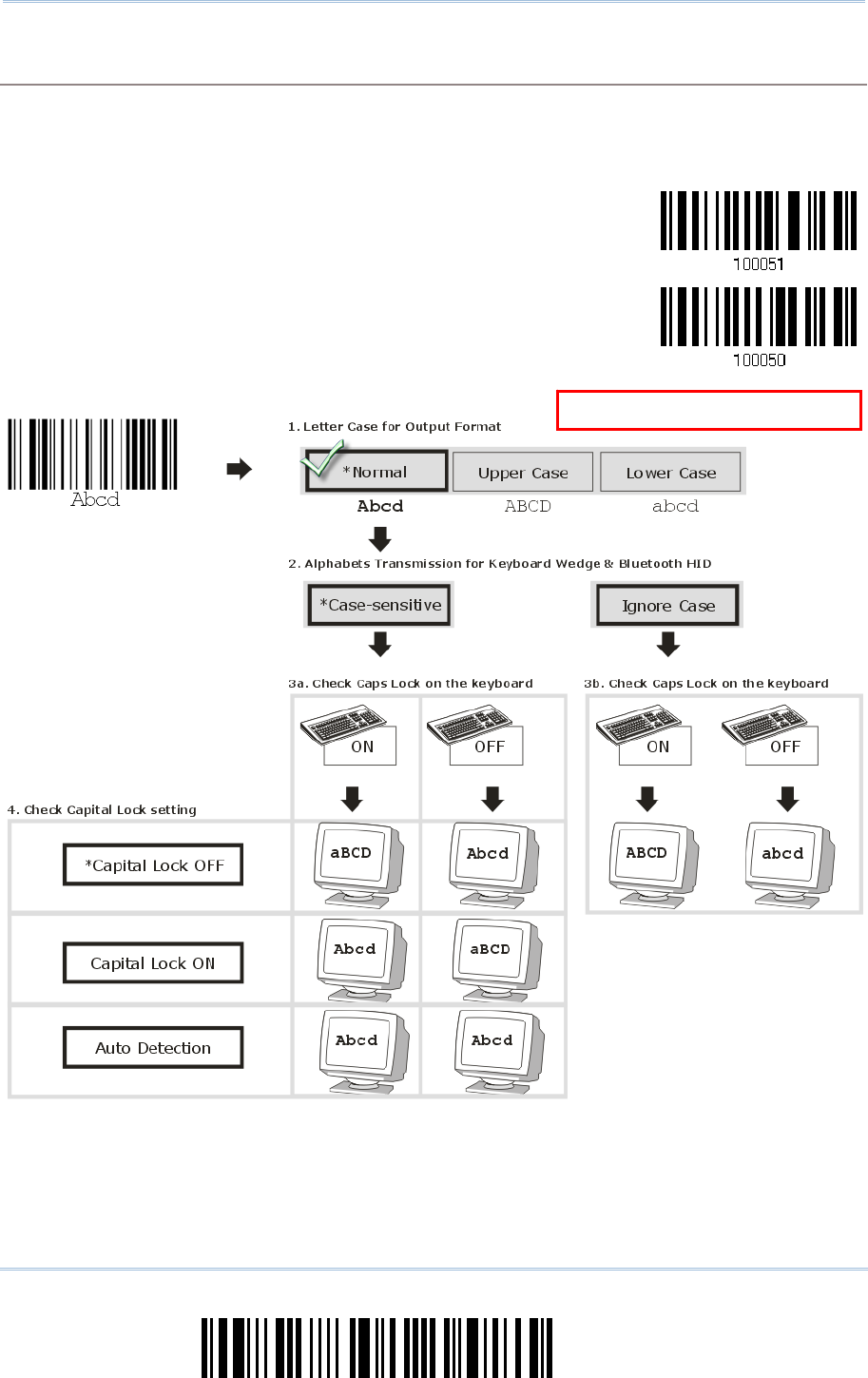
66
Enter Setup
1662 L/1664 Barcode Scanner User Guide
Alphabet Transmission
By default, the alphabet transmission is case-sensitive, meaning that the alphabet will be
transmitted according to the original case, the status of Caps Lock on the keyboard, as well as the
Capital Lock setting. Select [Ignore Case] to have alphabet transmitted according to the status of
Caps Lock on the keyboard only.
Ignore Case
*Case-sensitive
R
efer to 5.1 Letter Case.
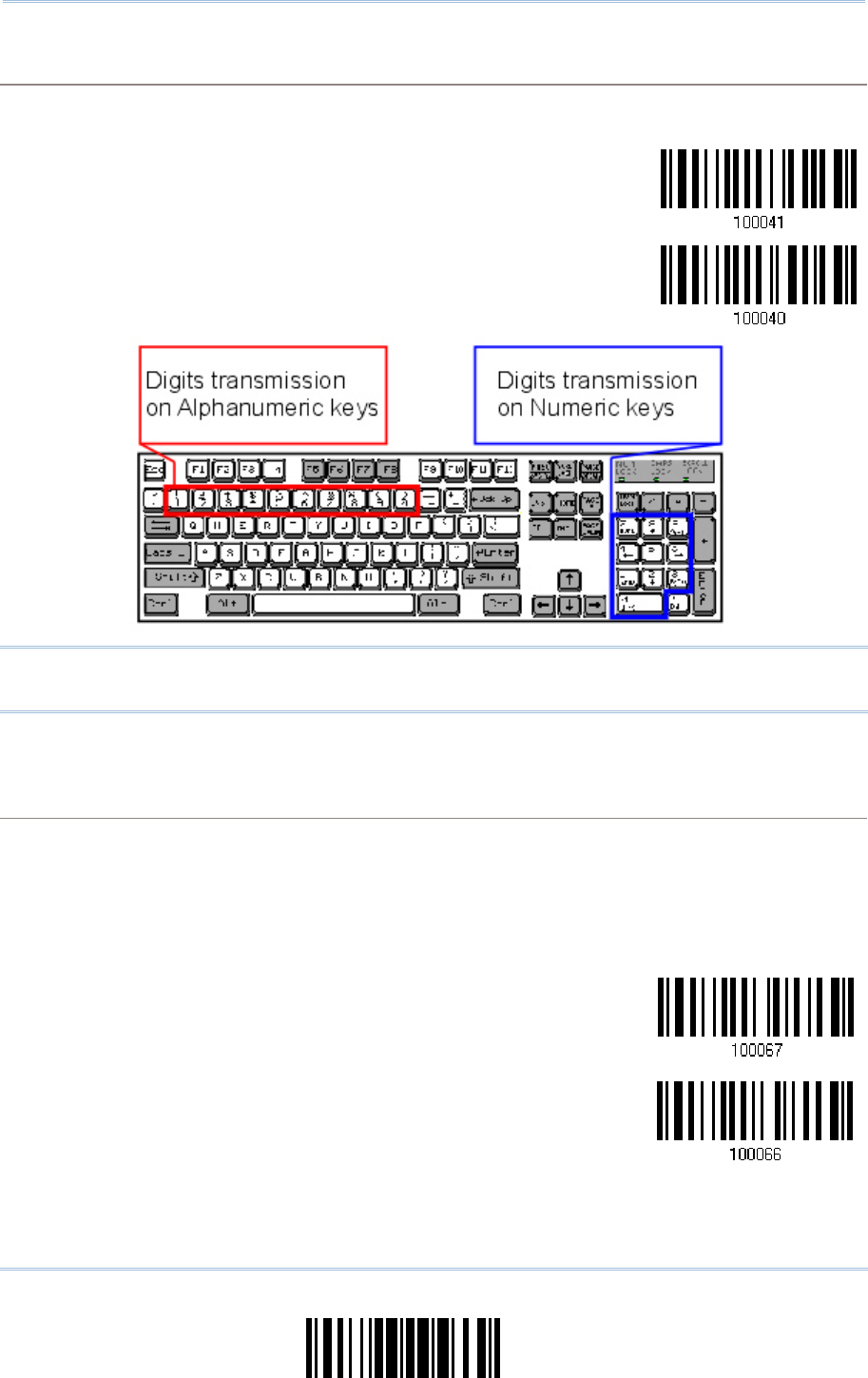
67
Update
Chapter 2
Selecting Output Interface
Numeric Transmission
By default, the alphanumeric keypad is used for transmitting digits. Select “Numeric Keypad” if you
wish to use the keys on the numeric keypad.
Numeric Key
*Alphanumeric Key
Note: If you select “Numeric Keypad”, the Num Lock status of the physical keyboard
should be “ON”. This setting is not supported on PDAs.
Kanji Transmission
Kanji Transmission is supported by the scanner when either Bluetooth® HID or USB HID is selected
for the output interface. By Kanji Transmission, when the host computer is running on Japanese
Windows O.S., the scanner is able to transmit Japanese characters including the Chinese
characters used in modern Japanese writing system.
Kanji Transmission is disabled by default. Enable/disable scanner’s Kanji Transmission by reading
the following barcodes:
Enable
*Disable
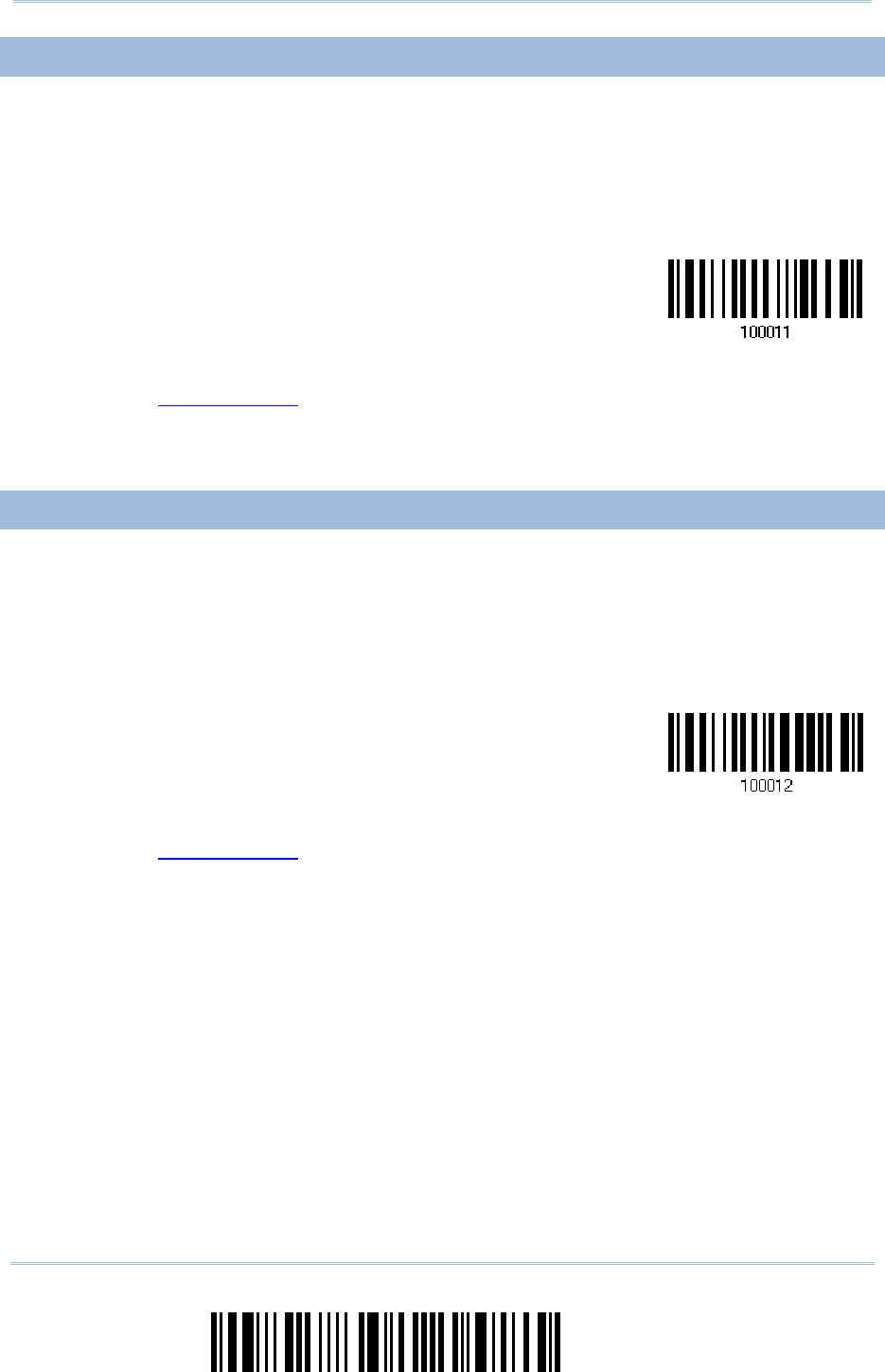
68
Enter Setup
1662 L/1664 Barcode Scanner User Guide
2.1.4 INTER-CHARACTER DELAY
By default, the inter-character delay is set to zero. Specify a value, ranging from 0 to
254 in units of milliseconds, to match the computer response time of the keyboard
interface. Such delay time is inserted between every character being transmitted. The
longer the delay time is, the slower the transmission speed will be.
Inter-Character
Delay… (*0~254)
1) Read the barcode above to specify the inter-character delay.
2) Read the “Decimal Value” barcode on page 錯誤! 尚未定義書籤。 for the desired
inter-character delay (in milliseconds).
3) Read the “Validate” barcode on the same page to complete this setting.
2.1.5 INTER-FUNCTION DELAY
By default, the inter-function delay is set to zero. Specify a value, ranging from 0 to 254
in units of milliseconds, to match the computer response time of the keyboard interface.
Such delay time is inserted between every function code (0x01 ~ 0x1F) being
transmitted. The longer the delay time is, the slower the transmission speed will be.
Inter-Function
Delay… (*0~254)
1) Read the barcode above to specify the inter-function delay.
2) Read the “Decimal Value” barcode on page 錯誤! 尚未定義書籤。 for the desired
inter-function delay (in milliseconds).
3) Read the “Validate” barcode on the same page to complete this setting.
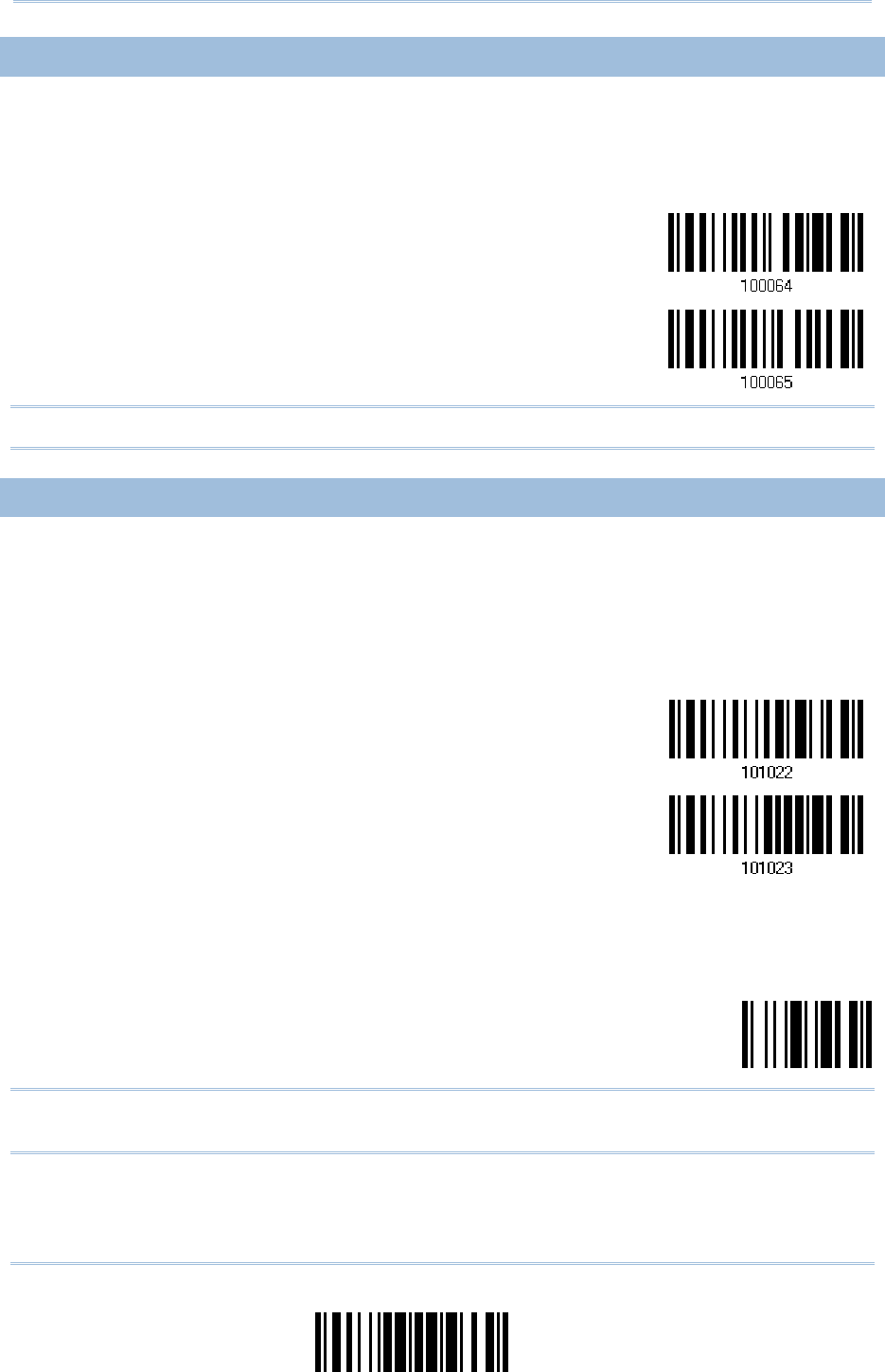
69
Update
Chapter 2
Selecting Output Interface
2.1.6 HID CHARACTER TRANSMIT MODE
By default, HID interface sends data to the host in batch. You may read the “By
Character” barcode to process data one character at a time.
*Batch Processing
By Character
Note: “By Character” transmit mode is required when working with iPhone or iPad.
2.1.7 KEYPAD SUPPORT FOR IPHONE/IPAD
When the scanner has been successfully connected to iPhone or iPad for data collection,
the onscreen keypad of iPhone or iPad will disappear. Read the “Use POWER Key to Show
or Hide Keypad” barcode in advance. Then, it will allow pressing the [Power/Delete] key
to show or hide the onscreen keypad.
*Normal
Use POWER Key to
Show or Hide Keypad
In addition to using the [Power/Delete] key, you may also show or hide the keypay by
reading the following barcode.
Show or Hide Keypad
Note: This function only works for
(1) iPhone 4 and 3GS version 4.1 or later, and (2) iPad version 4.2 or later.
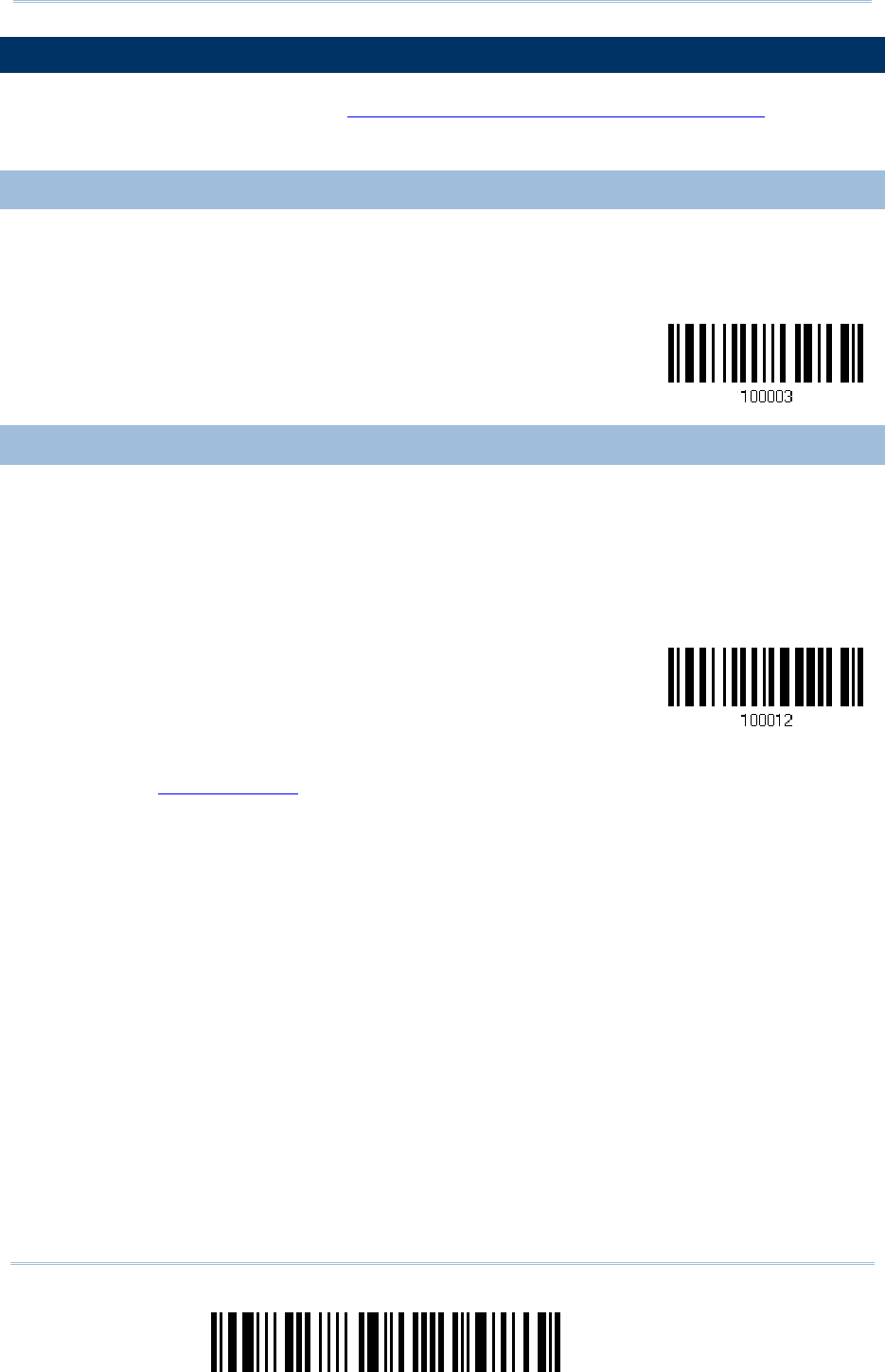
70
Enter Setup
1662 L/1664 Barcode Scanner User Guide
2.2 BLUETOOTH® SPP SLAVE
For Bluetooth® SPP Slave, refer to Chapter 3 – Setting up a WPAN Connection for related
connection settings.
2.2.1 ACTIVATE BLUETOOTH® SPP SLAVE MODE
This is SPP Slave Mode.
Activate Bluetooth®
SPP, Slave Mode
2.2.2 INTER-FUNCTION DELAY
By default, the inter-function delay is set to zero. Specify a value, ranging from 0 to 254
in units of milliseconds, to match the computer response time of the keyboard interface.
Such delay time is inserted between every function code (0x01 ~ 0x1F) being
transmitted. The longer the delay time is, the slower the transmission speed will be.
Inter-Function
Delay… (*0~254)
1) Read the barcode above to specify the inter-function delay.
2) Read the “Decimal Value” barcode on page 錯誤! 尚未定義書籤。 for the desired
inter-function delay (in milliseconds).
3) Read the “Validate” barcode on the same page to complete this setting.
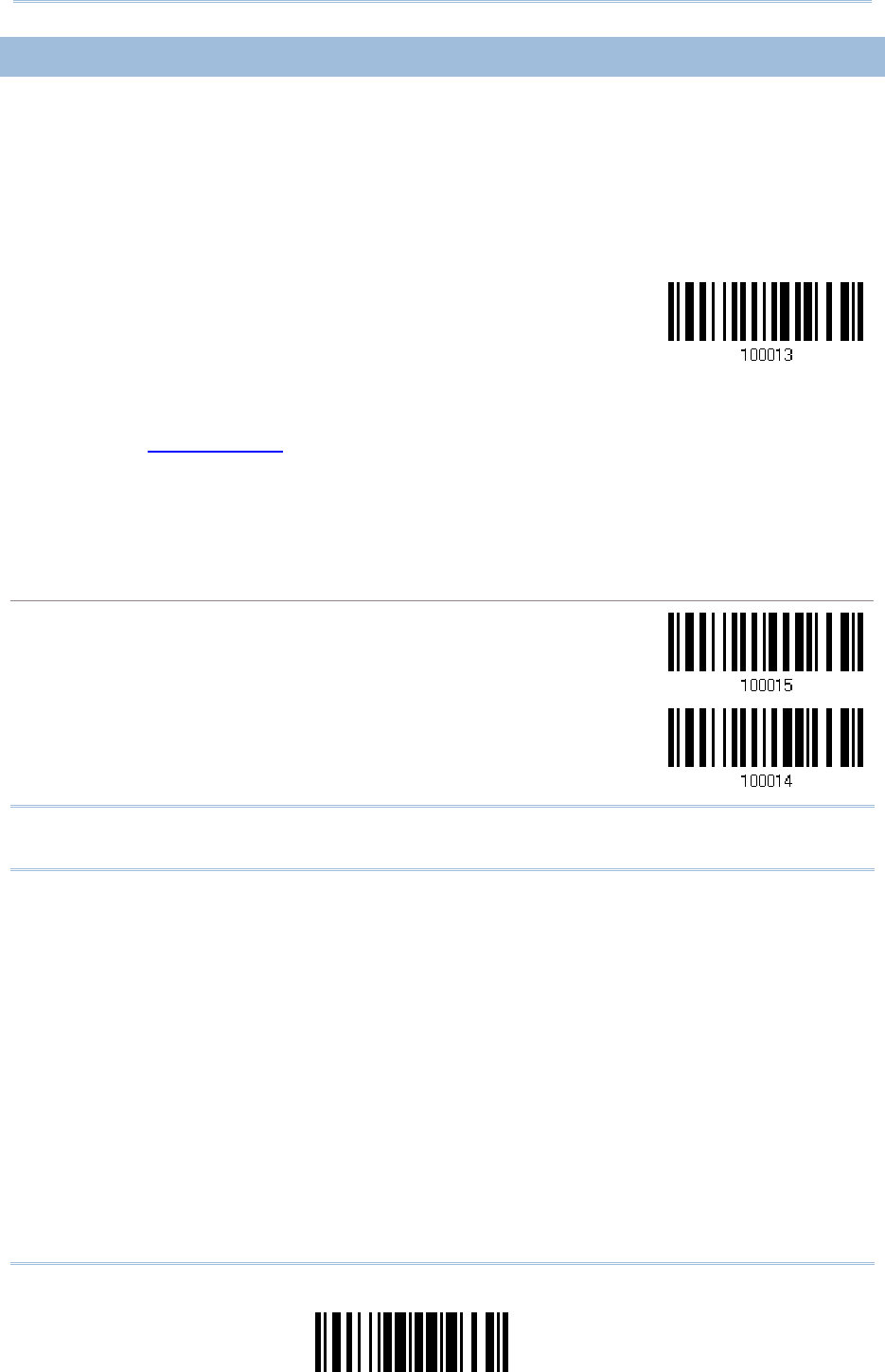
71
Update
Chapter 2
Selecting Output Interface
2.2.3 ACK/NAK TIMEOUT
By default, the scanner sends data to the host without waiting for an ACK/NAK response
before sending more data. Specify a value, ranging from 1 to 99 in units of 0.1 second. If
no response within the specified period of time, the scanner will attempt to send the
same data two more times. If all three attempts fail without any notification, data loss
will occur.
ACK/NAK Time-out
after … (*0~99)
1) Read the barcode above to specify the time interval for the scanner to send data and
wait for a response from the host.
2) Read the “Decimal Value” barcode on page 錯誤! 尚未定義書籤。. For example, read “1”
and “0” for the scanner to automatically shut down after being idle for 1 second.
3) Read the “Validate” barcode on the same page to complete this setting.
ACK/NAK Error Beep
Enable Error Beep
*Disable Error Beep
Note: We suggest enabling the error beep so that you will be notified of such data loss
and have the scanner re-read data.
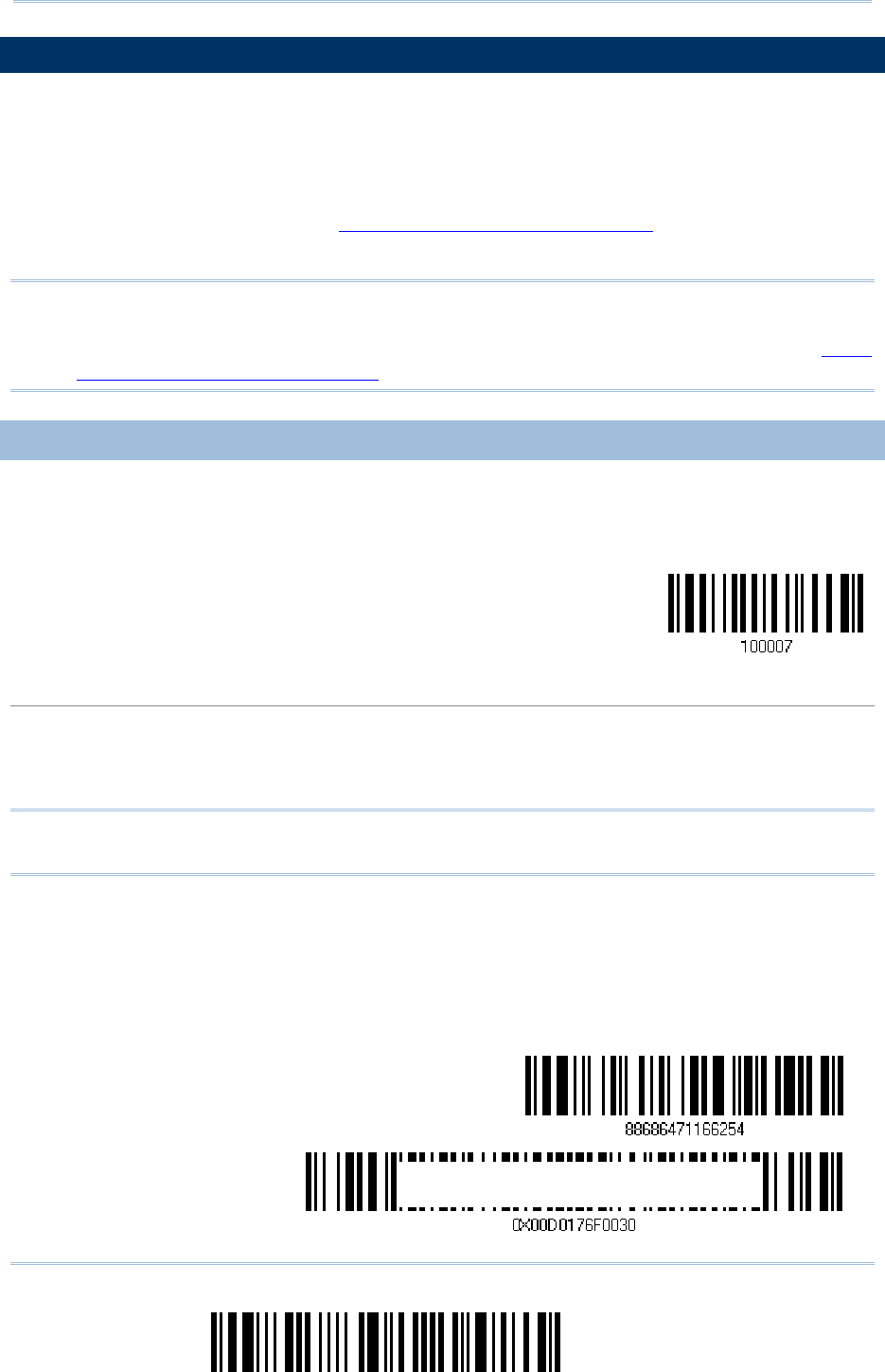
72
Enter Setup
1662 L/1664 Barcode Scanner User Guide
2.3 BLUETOOTH® SPP MASTER
As a SPP master device, the scanner will be able to resume connection with the host
upon powering on again, as long as the host application is running. If the scanner fails to
resume connection, it will try every 5 seconds to re-connect to the host unless you read
the “Reset Connection” or “Restore System Defaults” barcode.
For Bluetooth® SPP Master, refer 3.2.2 Configure Related Settings for related connection
settings.
Note: In SPP Master Mode, scanner has to connect within the specified period of time (2
minutes by default). During the connection, the scanner will enter into idle mode
to save power. It will automatically turn off when the time is up. Refer to 1.1.2
Auto Power Off & Power-Saving.
2.3.1 ACTIVATE BLUETOOTH® SPP MASTER MODE
This is SPP Master Mode.
Activate Bluetooth®
SPP, Master Mode
How to connect with the target device?
Produce two setup barcodes for the target SPP slave device, just like what we do for 3610.
“Set Connection”
“MAC ID”
Note: The “MAC ID” barcode must have a prefix of two characters, either “0x” or “0X”,
followed by the real MAC address of the target device.
Usage:
1) Read the “Activate Bluetooth® SPP, Master Mode” barcode above and barcodes for connection
settings, such as authentication and preset PIN. Skip this step if no connection settings are
desired.
2) Read the “Set Connection” and “MAC ID” barcodes. The scanner will respond with one beep
upon reading each of the barcodes.
Set Connection
Prefix “0X” to target MAC address
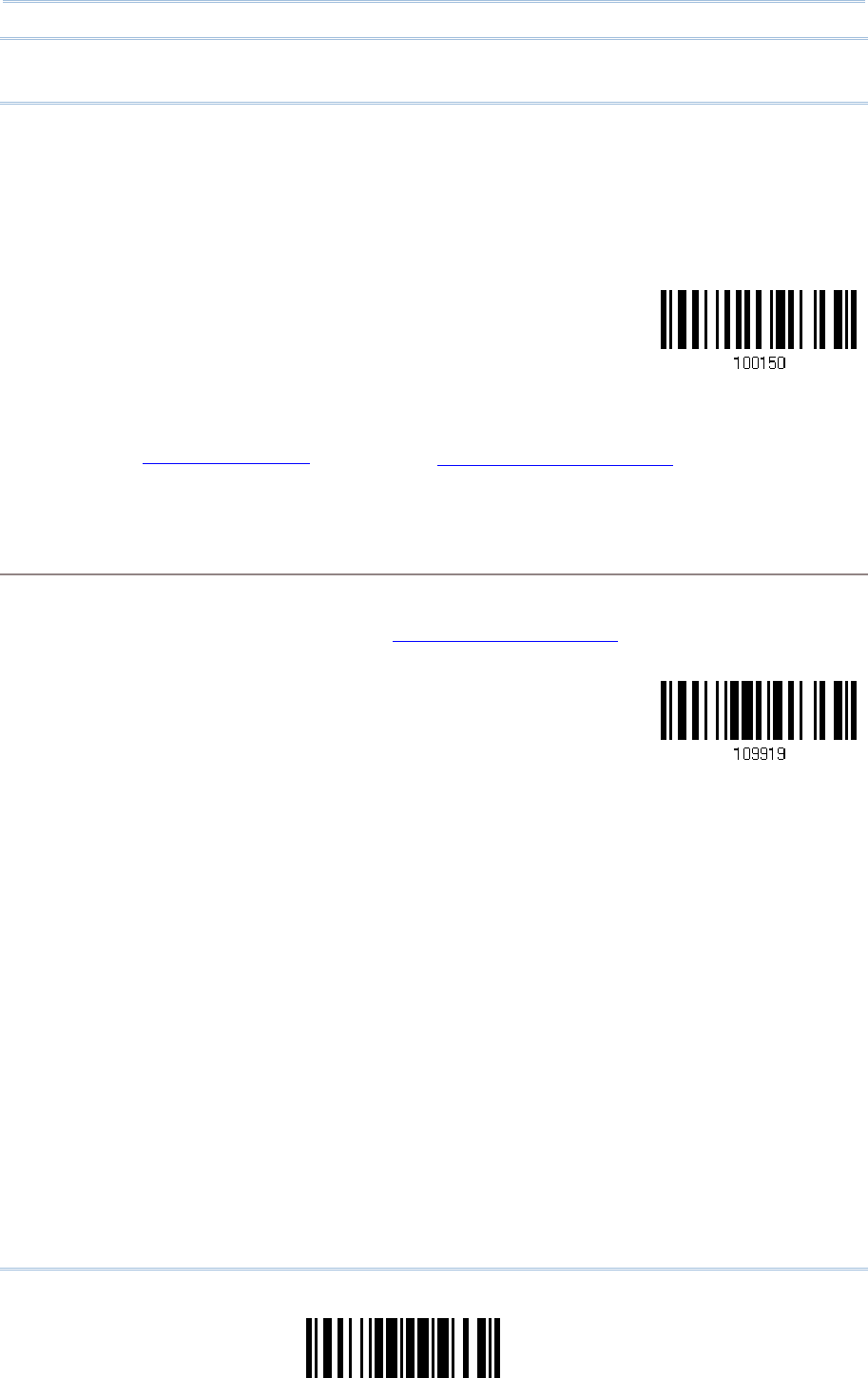
73
Update
Chapter 2
Selecting Output Interface
Note: Read the “Set Connection” barcode first, and then the “MAC ID” barcode within 10
seconds.
Instead of producing the “MAC ID” barcode, you may read the setup barcodes for entering the MAC
address.
Read the “Abort” barcode to cancel the operation at any time while reading setup barcodes for
the MAC address. If the MAC address has not been completed yet, reading the “Validate”
barcode can cancel the operation as well.
Enter MAC ID in
Hexadecimal…
Usage:
1) Read the barcode above.
2) Read the “Hexadecimal Value” barcode on page 錯誤! 尚未定義書籤。 for the desired MAC
address.
3) Read the “Validate” barcode on the same page to complete this setting.
Exit SPP Master Mode
To stop such re-connection, read “Reset Connection” or “Restore System Defaults” barcode so that
the current connection record (= MAC ID) will be cleared. Then, the scanner will restart itself
automatically. Go through the process in 3.2.3 Connect to Dongle to establish a new WPAN
connection.
Reset Connection

74
Enter Setup
1662 L/1664 Barcode Scanner User Guide
2.3.2 INTER-FUNCTION DELAY
By default, the inter-function delay is set to zero. Specify a value, ranging from 0 to 254
in units of milliseconds, to match the computer response time of the keyboard interface.
Such delay time is inserted between every function code (0x01 ~ 0x1F) being
transmitted. The longer the delay time is, the slower the transmission speed will be.
Inter-Function
Delay… (*0~254)
1) Read the barcode above to specify the inter-function delay.
2) Read the “Decimal Value” barcode on page 錯誤! 尚未定義書籤。 for the desired
inter-function delay (in milliseconds).
3) Read the “Validate” barcode on the same page to complete this setting.
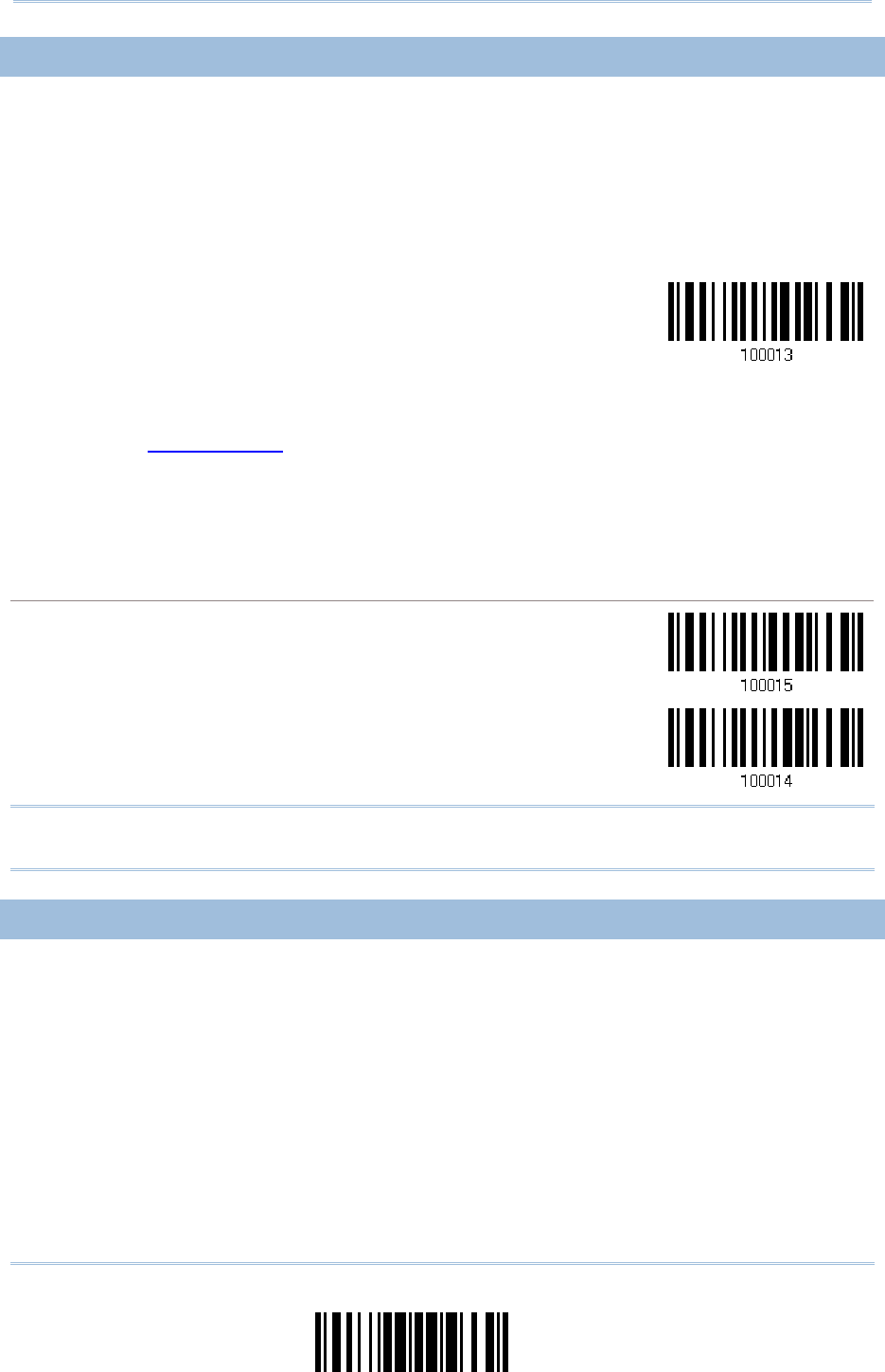
75
Update
Chapter 2
Selecting Output Interface
2.3.3 ACK/NAK TIMEOUT
By default, the scanner sends data to the host without waiting for an ACK/NAK response
before sending more data. Specify a value, ranging from 1 to 99 in units of 0.1 second. If
no response within the specified period of time, the scanner will attempt to send the
same data two more times. If all three attempts fail without any notification, data loss
will occur.
ACK/NAK Time-out
after … (*0~99)
1) Read the barcode above to specify the time interval for the scanner to send data and
wait for a response from the host.
2) Read the “Decimal Value” barcode on page 錯誤! 尚未定義書籤。. For example, read “1”
and “0” for the scanner to automatically shut down after being idle for 1 second.
3) Read the “Validate” barcode on the same page to complete this setting.
ACK/NAK Error Beep
Enable Error Beep
*Disable Error Beep
Note: We suggest enabling the error beep so that you will be notified of such data loss
and have the scanner re-read data.
2.3.4 SWITCH BETWEEN MASTER/SLAVE MODE
After the scanner has established a connection as a SPP slave device, you may read the
“Activate Bluetooth® SPP, Master Mode” setup barcode to switch to SPP Master Mode.
This will result in easy and reliable re-connection, just like connecting with 3610.
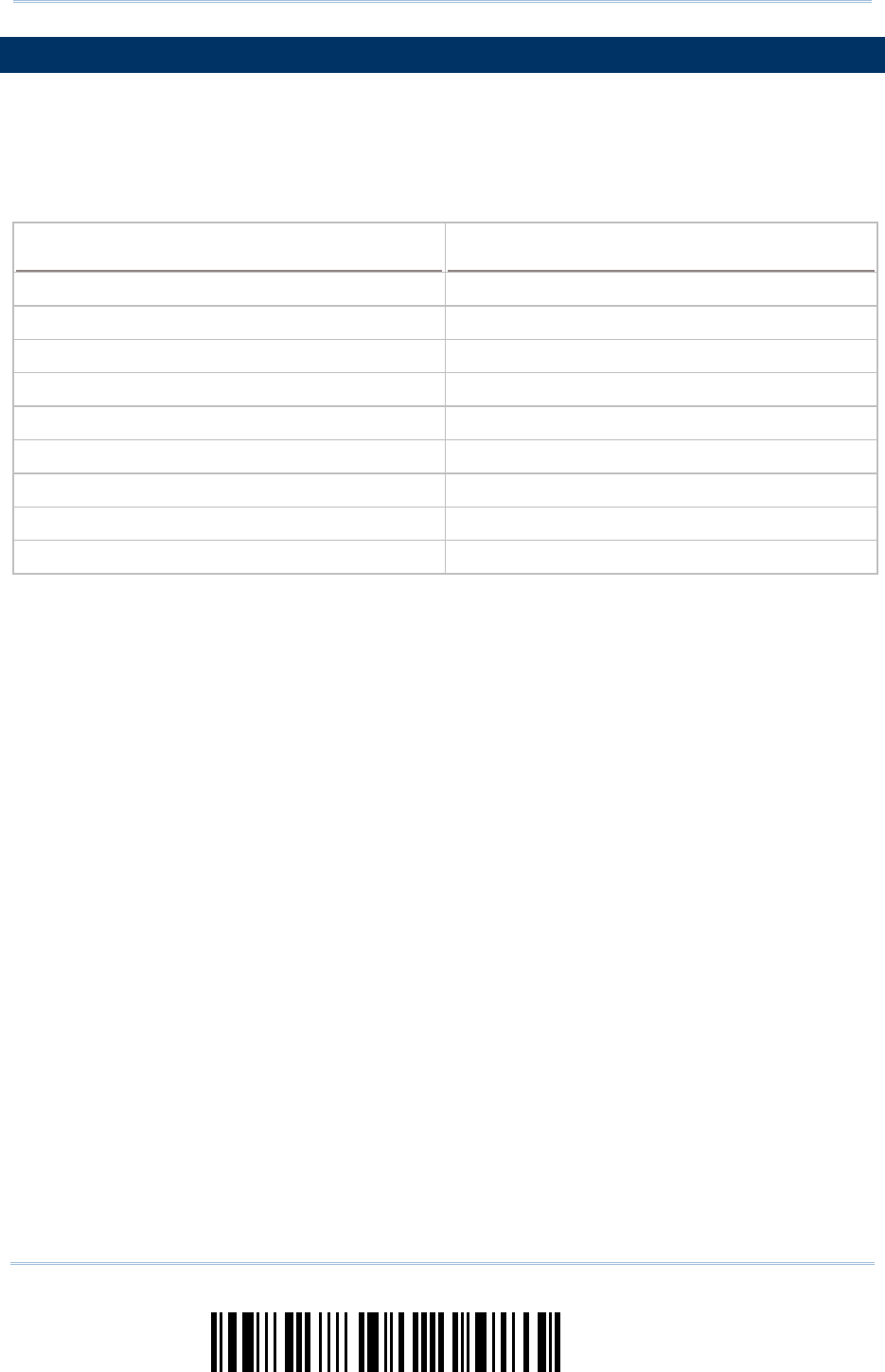
76
Enter Setup
1662 L/1664 Barcode Scanner User Guide
2.4 USB HID VIA 3610
For USB HID, connect 3610 to the USB port of PC, and then connect the scanner to 3610.
The scanned data will be transmitted to the computer. To capture the data run any text
editor on your computer.
HID Settings Defaults
Keyboard Type PCAT (US)
Numeric Layout Normal
Capital Lock Type Normal
Capital Lock State Off
Alphabet Transmission Case-sensitive
Numeric Transmission Alphanumeric keypad
Kanji Transmission Disable
Inter-Character Delay 0 (ms)
Inter-Function Delay 0 (ms)
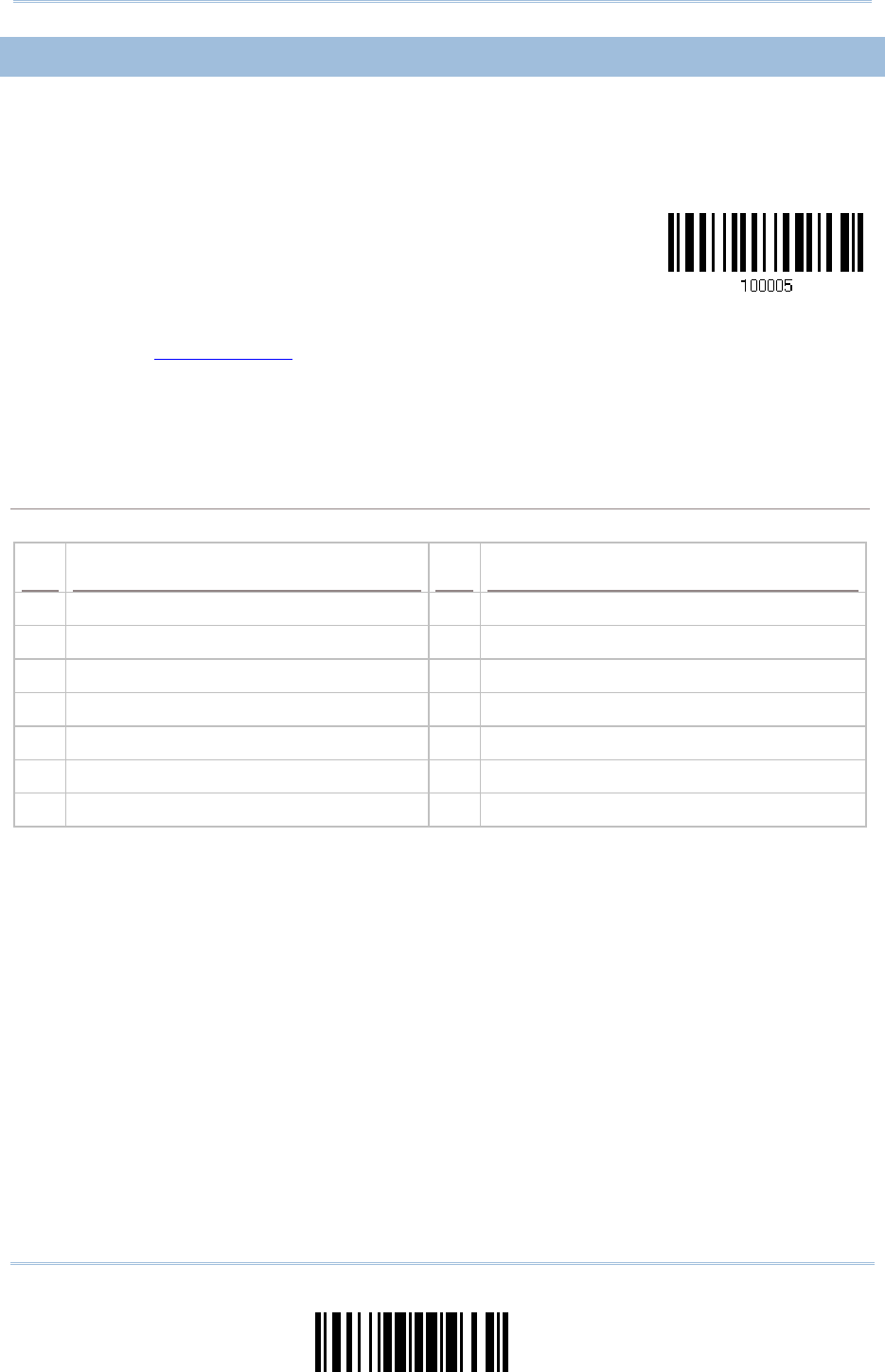
77
Update
Chapter 2
Selecting Output Interface
2.4.1 ACTIVATE USB HID & SELECT KEYBOARD TYPE
When USB HID interface is activated, you will have to select a keyboard type to complete
this setting.
Activate
3610 USB HID & Select
Keyboard Type…
1) Read the barcode above to activate USB HID and select a keyboard type.
2) Read the “Decimal Value” barcode on page 錯誤! 尚未定義書籤。. Refer to the table
below for the number of desired keyboard type.
3) Read the “Validate” barcode on the same page to complete this setting.
USB HID
The following keyboard types are supported —
No. Keyboard Type No.
Keyboard Type
64 PCAT (US) 71 PCAT (Belgium)
65 PCAT (French) 72 PCAT (Spanish)
66 PCAT (German) 73 PCAT (Portuguese)
67 PCAT (Italy) 74 PS55 A01-2 (Japanese)
68 PCAT (Swedish) 75 User-defined table
69 PCAT (Norwegian) 76 PCAT (Turkish)
70 PCAT (UK) 77 PCAT (Hungarian)
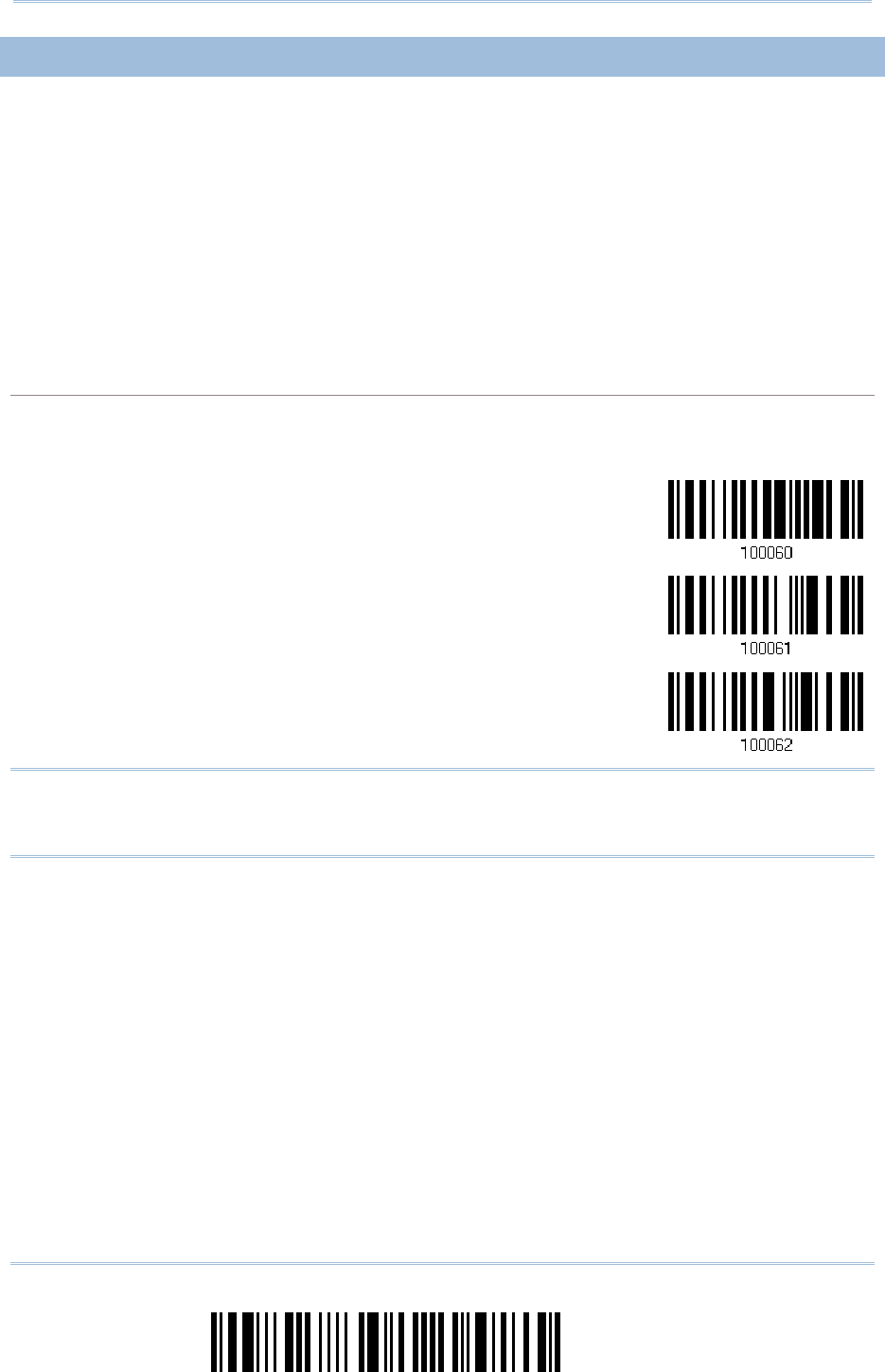
78
Enter Setup
1662 L/1664 Barcode Scanner User Guide
2.4.2 KEYBOARD SETTINGS
Alphabet Layout
Numeric Layout
Capital Lock Type
Capital Lock Setting
Alphabet Transmission
Numeric Transmission
Kanji Transmission
Alphabet Layout
By default, the alphabet layout is set to normal mode, also known as the standard English layout.
Select French or German keyboard layout if necessary. The scanner will make adjustments when
sending the "A", "Q", "W", "Z", "Y", and "M" characters according to this setting.
*Normal
AZERTY
QWERTZ
Note: This setting only works when the keyboard type selected is US keyboard, such as
PCAT (US). The Alphabet Layout and Numeric Layout setting must match your
keyboard.
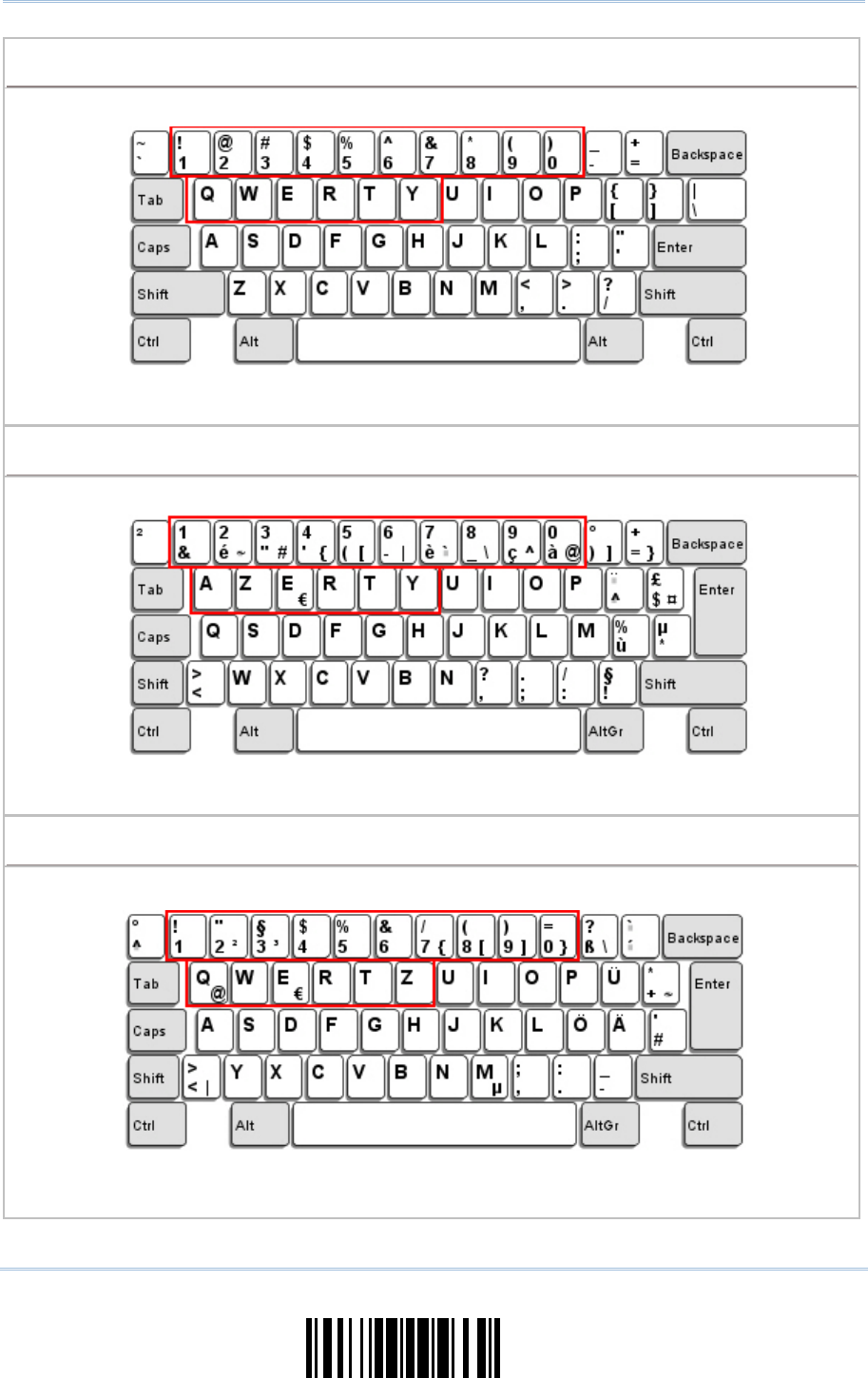
79
Update
Chapter 2
Selecting Output Interface
US Keyboard Style – Normal
QWERTY layout, which is normally used in western countries.
Select “Lower Row” for the “Numeric Layout” setting for the upper row is for special
characters.
French Keyboard Style – AZERTY
French layout; see below for French Keyboard Style.
Select “Upper Row” for the “Numeric Layout” setting for the lower row is for special
characters.
German Keyboard Layout – QWERTZ
German layout; see below for German Keyboard Style.
Select “Lower Row” for the “Numeric Layout” setting for the upper row is for special
characters.
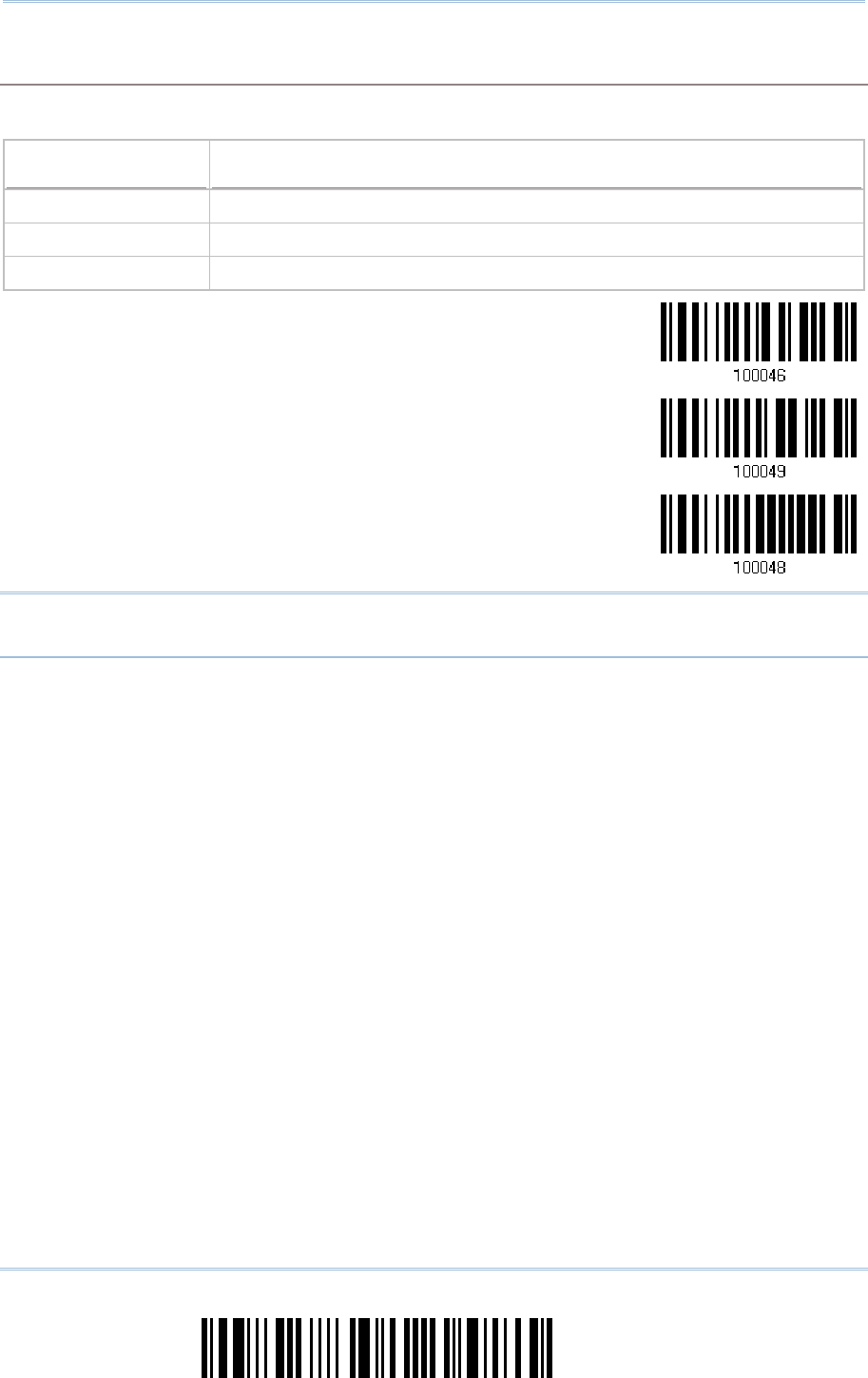
80
Enter Setup
1662 L/1664 Barcode Scanner User Guide
Numeric Layout
Select a proper layout that matches the alphabet layout. The scanner will make adjustments
according to this setting.
Options Description
Normal Depends on the [Shift] key or [Shift Lock] setting
Lower Row For QWERTY or QWERTZ keyboard
Upper Row For AZERTY keyboard
*Normal
Upper Row
Lower Row
Note: This setting is to be used with the Character Substitution setting when support for
certain keyboard types (languages) is unavailable but required.
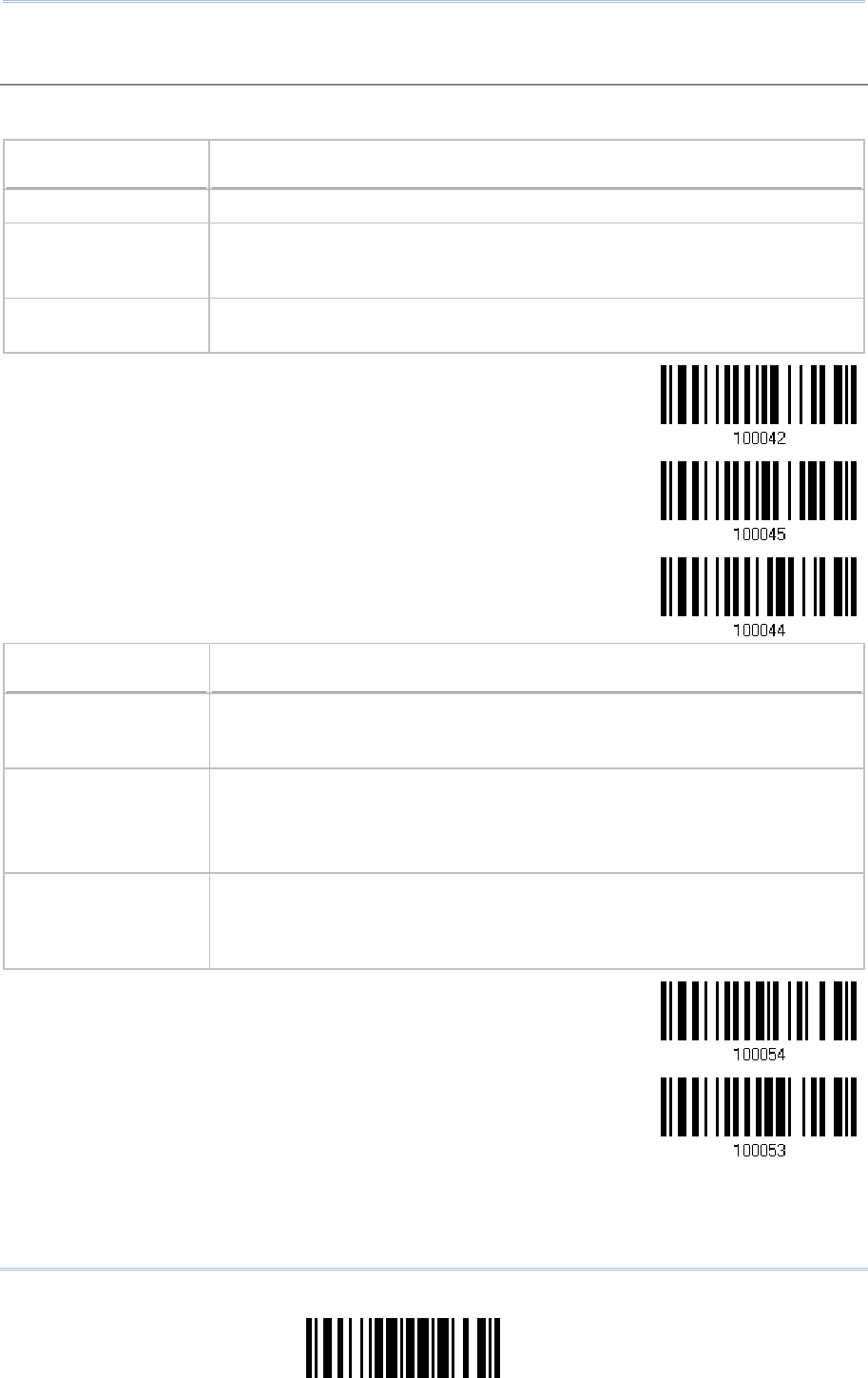
81
Update
Chapter 2
Selecting Output Inte
r
face
Capital Lock Type & Setting
In order to send the alphabet with correct case, the scanner needs to know the status of Caps Lock
on the keyboard. Incorrect settings may result in reversed case of the alphabet being transmitted.
Cap Lock Type Description
Normal Normal type
Capital Lock When enabled, the keys of alphabetic characters will be interpreted as
capital letters. However, this does not affect the number or punctuation
keys.
Shift Lock When enabled, the keys of alphabetic characters will be interpreted as
capital letters. In addition, this affects the number or punctuation keys.
*Normal
Shift Lock
Capital Lock
Capital Lock State Description
Capital Lock OFF Assuming that the status of Caps Lock on the keyboard is OFF,
transmitted characters are exactly the same as in the barcode (when
"case-sensitive" is selected for Alphabet Transmission).
Capital Lock ON Assuming that the status of Caps Lock on the keyboard is ON, transmitted
characters are exactly the same as in the barcode (when "case-sensitive"
is selected for Alphabet Transmission).
Refer to the Capital Lock Type above.
Auto Detection
(suggested use for
most applications)
T
he scanner will automatically detect the status of Caps Lock on the
keyboard before data is transmitted; transmitted characters are exactly
the same as in the barcode (when "case-sensitive" is selected for
Alphabet Transmission).
Auto Detect
Capital Lock ON

82
Enter Setup
1662 L/1664 Barcode Scanner User Guide
*Capital Lock OFF
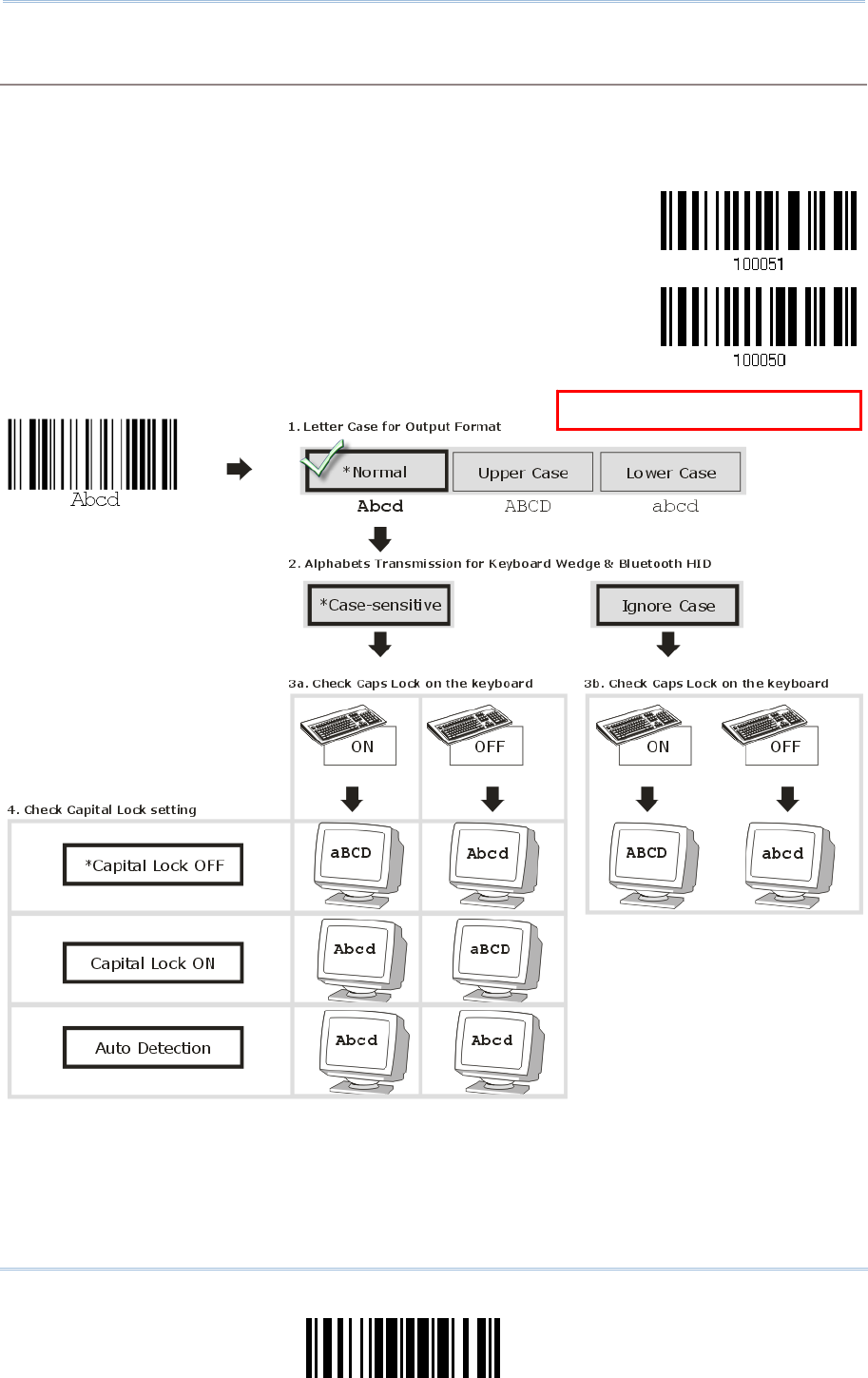
83
Update
Chapter 2
Selecting Output Interface
Alphabet Transmission
By default, the alphabet transmission is case-sensitive, meaning that the alphabet will be
transmitted according to the original case, the status of Caps Lock on the keyboard, as well as the
Capital Lock setting. Select [Ignore Case] to have alphabet transmitted according to the status of
Caps Lock on the keyboard only.
Ignore Case
*Case-sensitive
R
efer to 5.1 Letter Case.
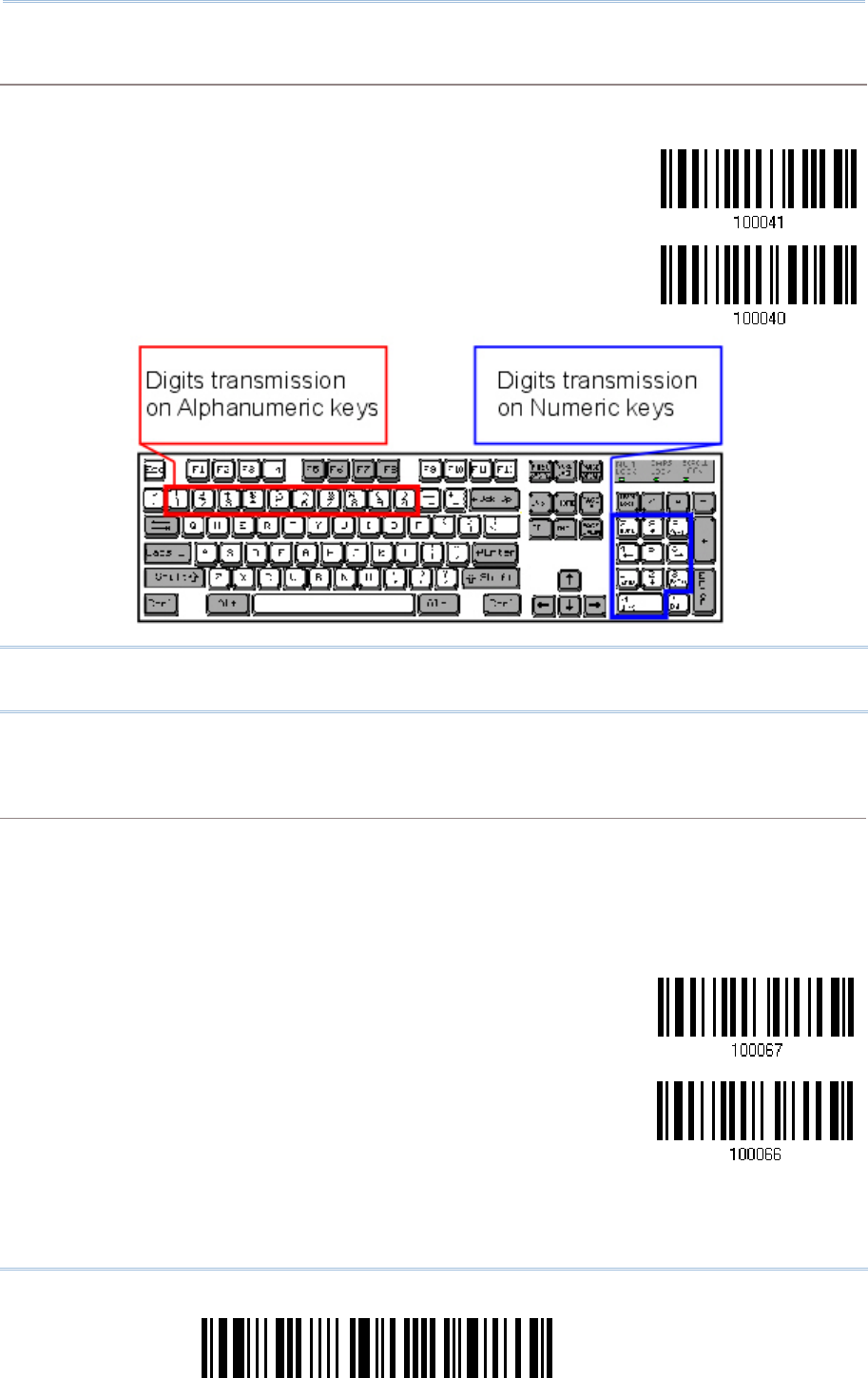
84
Enter Setup
1662 L/1664 Barcode Scanner User Guide
Numeric Transmission
By default, the alphanumeric keypad is used for transmitting digits. Select “Numeric Keypad” if you
wish to use the keys on the numeric keypad.
Numeric Key
*Alphanumeric Key
Note: If you select “Numeric Keypad”, the Num Lock status of the physical keyboard
should be "ON".
Kanji Transmission
Kanji Transmission is supported by the scanner when either Bluetooth® HID or USB HID is selected
for the output interface. By Kanji Transmission, when the host computer is running on Japanese
Windows O.S., the scanner is able to transmit Japanese characters including the Chinese
characters used in modern Japanese writing system.
Kanji Transmission is disabled by default. Enable/disable scanner’s Kanji Transmission by reading
the following barcodes:
Enable
*Disable
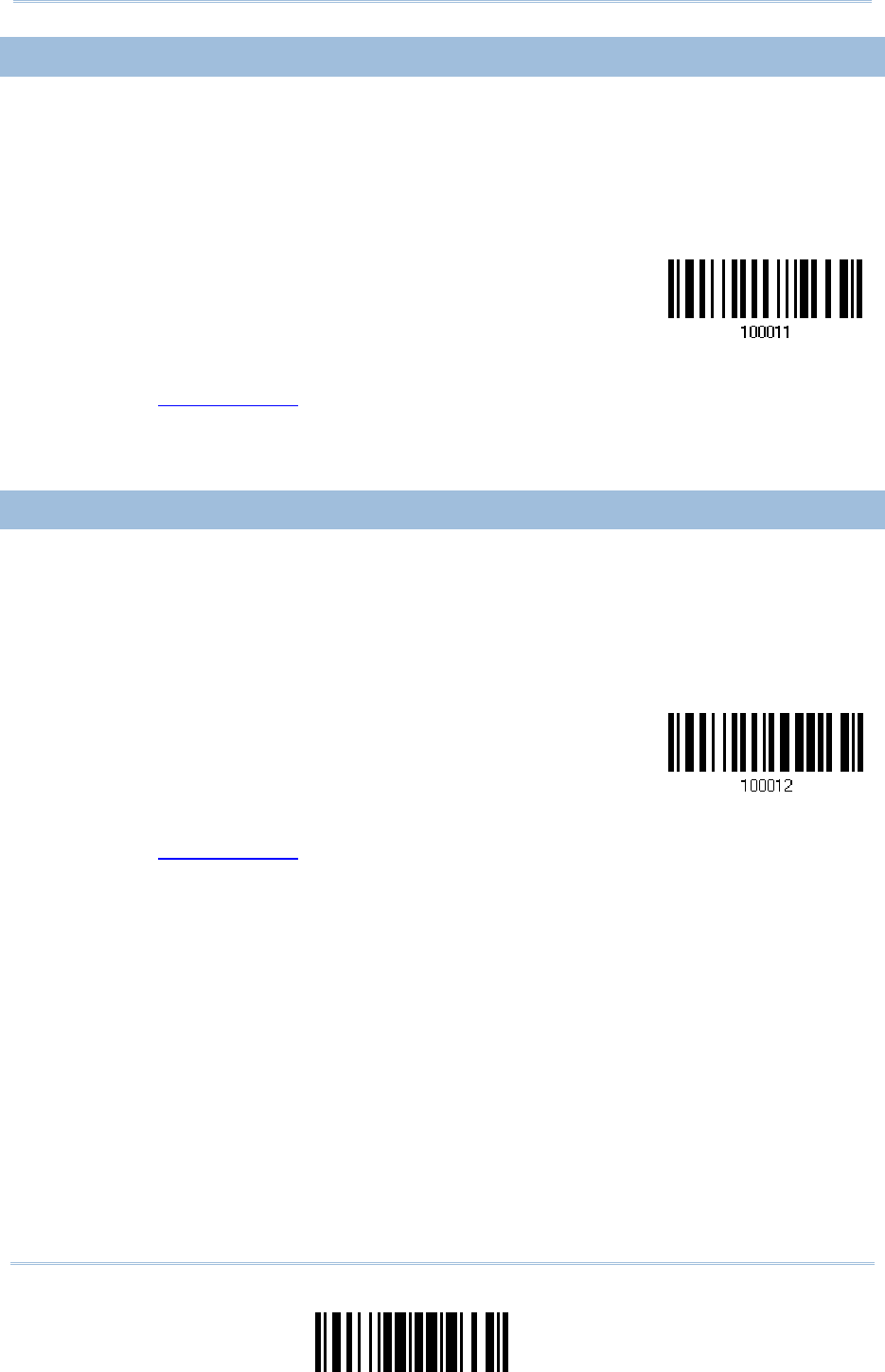
85
Update
Chapter 2
Selecting Output Interface
2.4.3 INTER-CHARACTER DELAY
By default, the inter-character delay is set to zero. Specify a value, ranging from 0 to
254 in units of milliseconds, to match the computer response time of the keyboard
interface. Such delay time is inserted between every character being transmitted. The
longer the delay time is, the slower the transmission speed will be.
Inter-Character
Delay… (*0~254)
1) Read the barcode above to specify the inter-character delay.
2) Read the “Decimal Value” barcode on page 錯誤! 尚未定義書籤。 for the desired
inter-character delay (in milliseconds).
3) Read the “Validate” barcode on the same page to complete this setting.
2.4.4 INTER-FUNCTION DELAY
By default, the inter-function delay is set to zero. Specify a value, ranging from 0 to 254
in units of milliseconds, to match the computer response time of the keyboard interface.
Such delay time is inserted between every function code (0x01 ~ 0x1F) being
transmitted. The longer the delay time is, the slower the transmission speed will be.
Inter-Function
Delay… (*0~254)
1) Read the barcode above to specify the inter-function delay.
2) Read the “Decimal Value” barcode on page 錯誤! 尚未定義書籤。 for the desired
inter-function delay (in milliseconds).
3) Read the “Validate” barcode on the same page to complete this setting.

86
Enter Setup
1662 L/1664 Barcode Scanner User Guide
2.4.5 HID CHARACTER TRANSMIT MODE
By default, HID interface sends data to the host in batch. Read the “By Character”
barcode will send the data one character at a time.
*Batch Processing
By Character
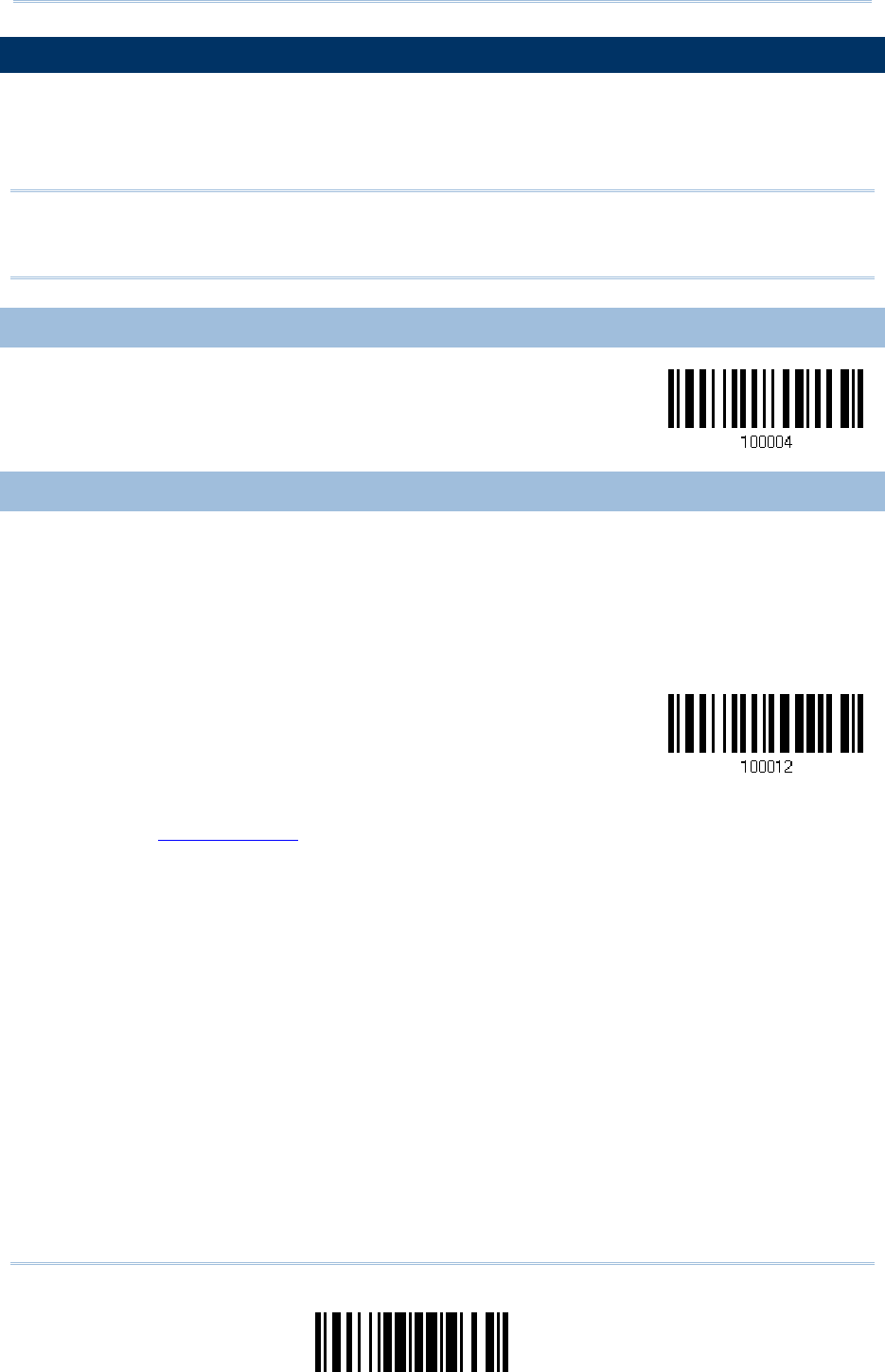
87
Update
Chapter 2
Selecting Output Interface
2.5 USB VIRTUAL COM VIA 3610
Connect 3610 to the USB port of PC, and then connect the scanner to 3610. You may run
HyperTerminal.exe on the computer to view and capture the data transmission from the
scanner.
Note: If you are using USB Virtual COM for the first time, you must install its driver from
the CD-ROM. Driver version 5.3 or later is required. Please remove older versions
before installing new ones!
2.5.1 ACTIVATE USB VIRTUAL COM
Activate 3610
USB Virtual COM
2.5.2 INTER-FUNCTION DELAY
By default, the inter-function delay is set to zero. Specify a value, ranging from 0 to 254
in units of milliseconds, to match the computer response time of the keyboard interface.
Such delay time is inserted between every function code (0x01 ~ 0x1F) being
transmitted. The longer the delay time is, the slower the transmission speed will be.
Inter-Function
Delay… (*0~254)
1) Read the barcode above to specify the inter-function delay.
2) Read the “Decimal Value” barcode on page 錯誤! 尚未定義書籤。 for the desired
inter-function delay (in milliseconds).
3) Read the “Validate” barcode on the same page to complete this setting.
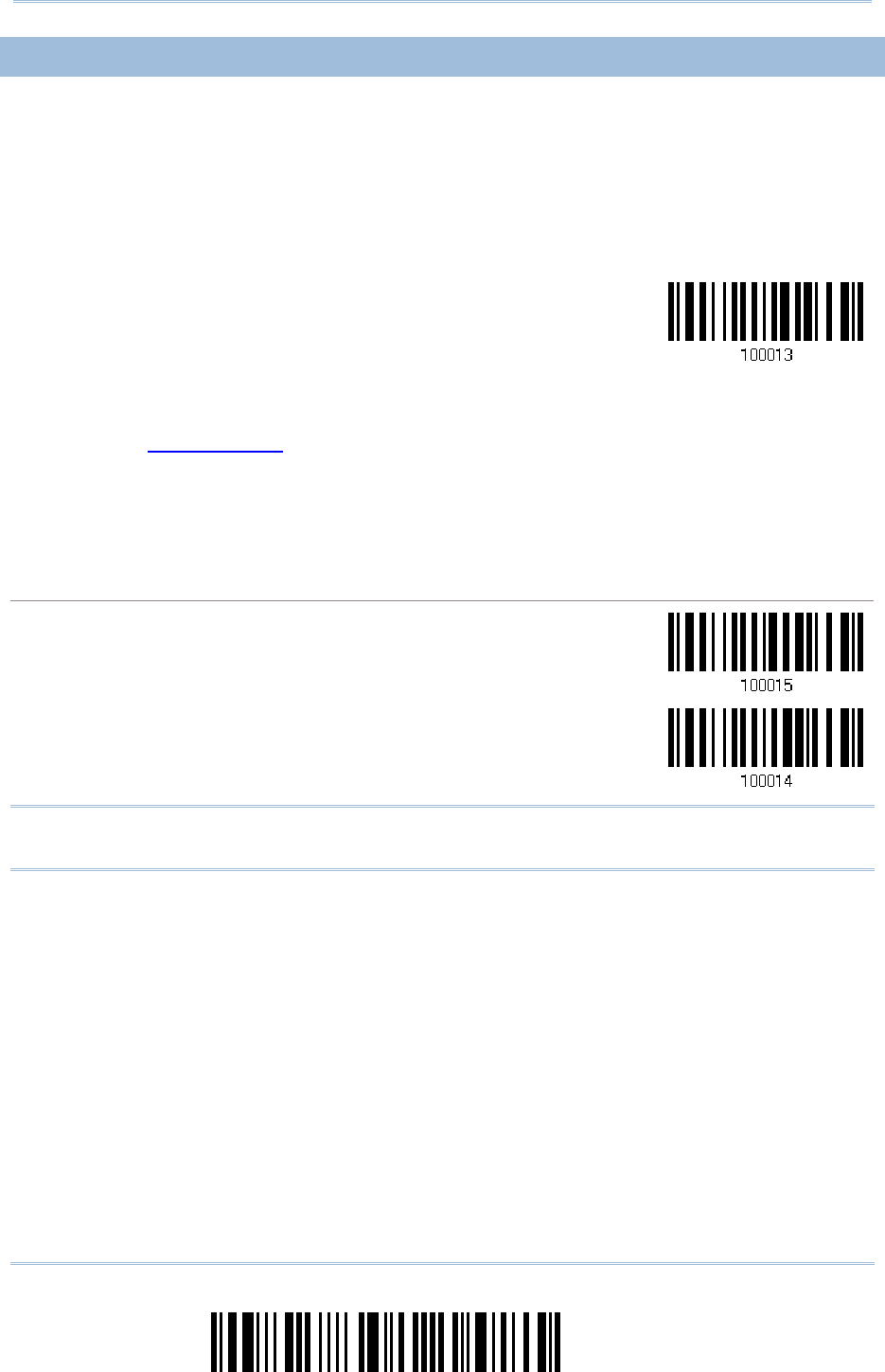
88
Enter Setup
1662 L/1664 Barcode Scanner User Guide
2.5.3 ACK/NAK TIMEOUT
By default, the scanner sends data to the host without waiting for an ACK/NAK response
before sending more data. Specify a value, ranging from 1 to 99 in units of 0.1 second. If
no response within the specified period of time, the scanner will attempt to send the
same data two more times. If all three attempts fail without any notification, data loss
will occur.
ACK/NAK Time-out
after … (*0~99)
1) Read the barcode above to specify the time interval for the scanner to send data and
wait for a response from the host.
2) Read the “Decimal Value” barcode on page 錯誤! 尚未定義書籤。. For example, read “1”
and “0” for the scanner to automatically shut down after being idle for 1 second.
3) Read the “Validate” barcode on the same page to complete this setting.
ACK/NAK Error Beep
Enable Error Beep
*Disable Error Beep
Note: We suggest enabling the error beep so that you will be notified of such data loss
and have the scanner re-read data.
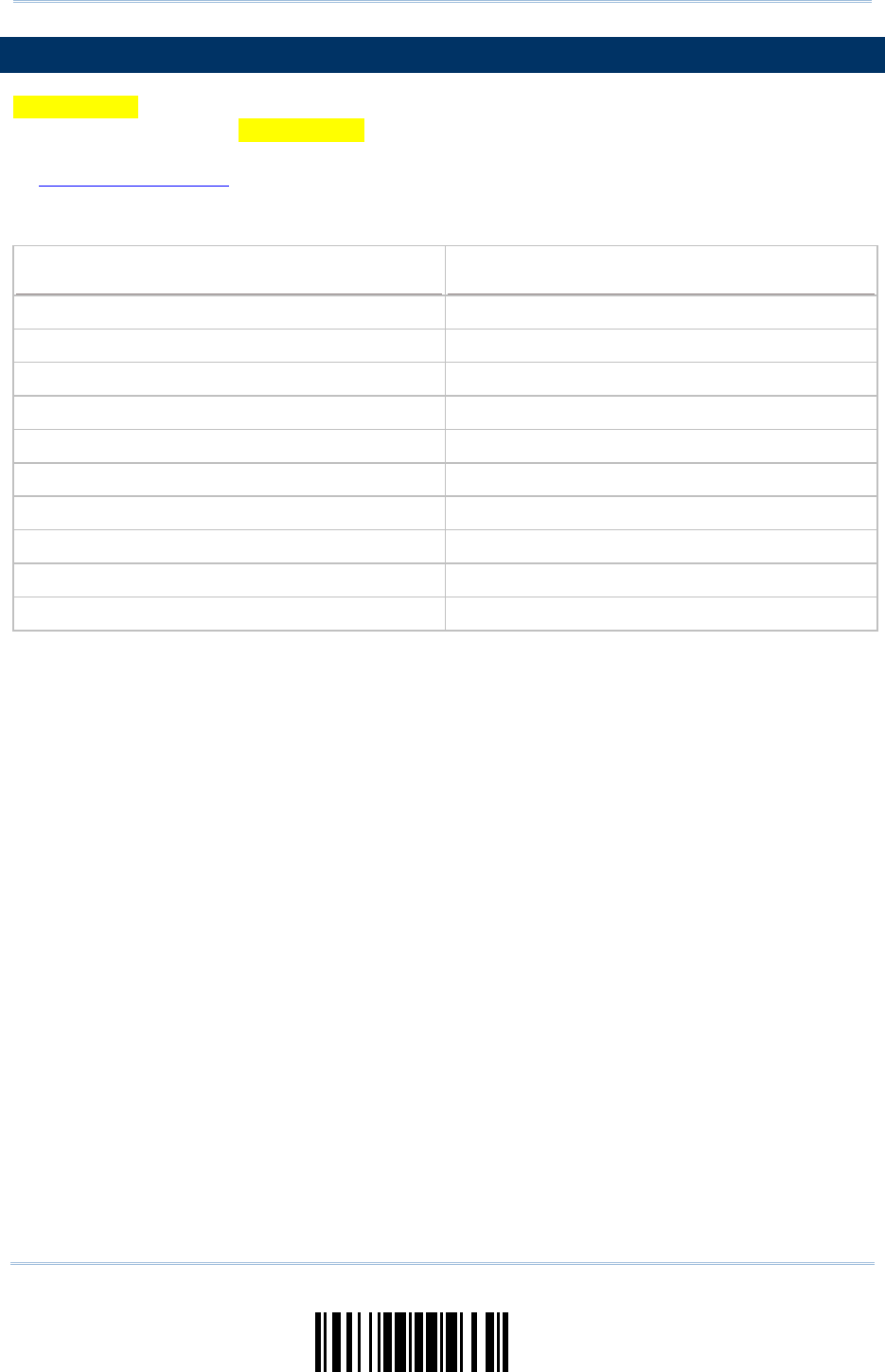
89
Update
Chapter 2
Selecting Output Interface
2.6 DIRECT USB HID
1662 L/1664 supports “Direct” USB HID interface for memory mode. Use the provided
USB cable to connect 1662 L/1664 to the USB port of PC. Run any text editor on a
computer to view and capture the scanned data being transmitted to the computer. Refer
to 1.2.2 Memory Mode.
HID Settings Defaults
Keyboard Type HID PCAT (US)
Numeric Layout Normal
Capital Lock Type Normal
Capital Lock State OFF
Alphabet Transmission Case Sensitive
Numeric Transmission Alphanumeric Keypad
Kanji Transmission Disable
Alphabet Layout Normal
Inter-Character Delay 0 (ms)
Inter-Function Delay 0 (ms)
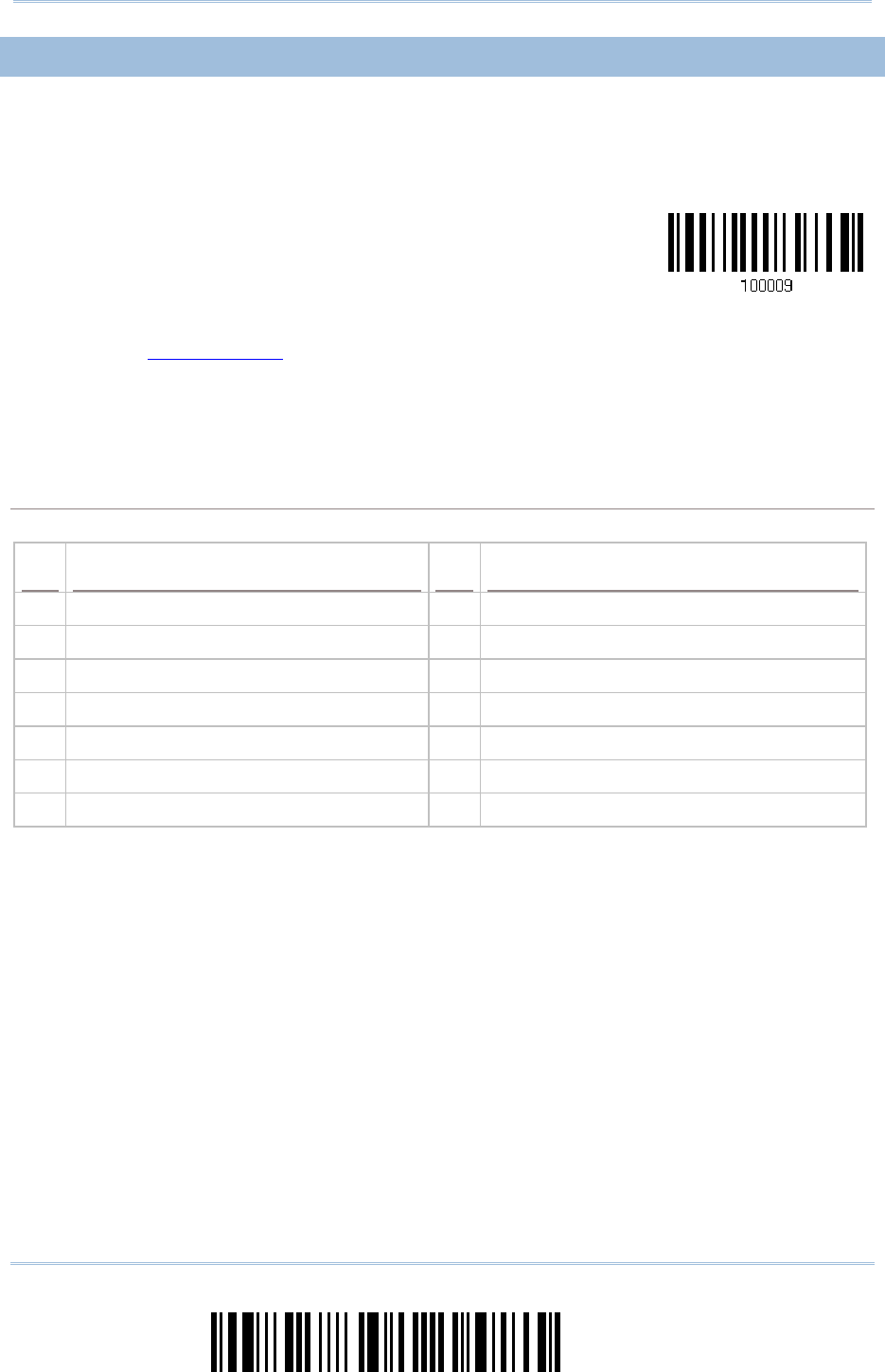
90
Enter Setup
1662 L/1664 Barcode Scanner User Guide
2.6.1 ACTIVATE USB HID & SELECT KEYBOARD TYPE
When USB HID interface is activated, please select a keyboard type to complete this
setting.
Act
i
vate
Direct USB HID &
Select Keyboard
Type…
1) Read the barcode above to activate USB HID and select a keyboard type.
2) Read the “Decimal Value” barcode page 錯誤! 尚未定義書籤。 . Refer to the table below
for the number of desired keyboard type.
3) Read the “Validate” barcode on the same page to complete this setting.
USB HID
By default, the keyboard type is set to PCAT (US). The following keyboard types are supported —
No. Keyboard Type No.
Keyboard Type
64 HID PCAT (US) 71 HID PCAT (Belgium)
65 HID PCAT (French) 72 HID PCAT (Spanish)
66 HID PCAT (German) 73 HID PCAT (Portuguese)
67 HID PCAT (Italy) 74 HID A01-2 (Japanese)
68 HID PCAT (Swedish) 75 User-Defined Table
69 HID PCAT (Norwegian) 76 HID PCAT (Turkish)
70 HID PCAT (UK) 77 HID PCAT (Hungarian)
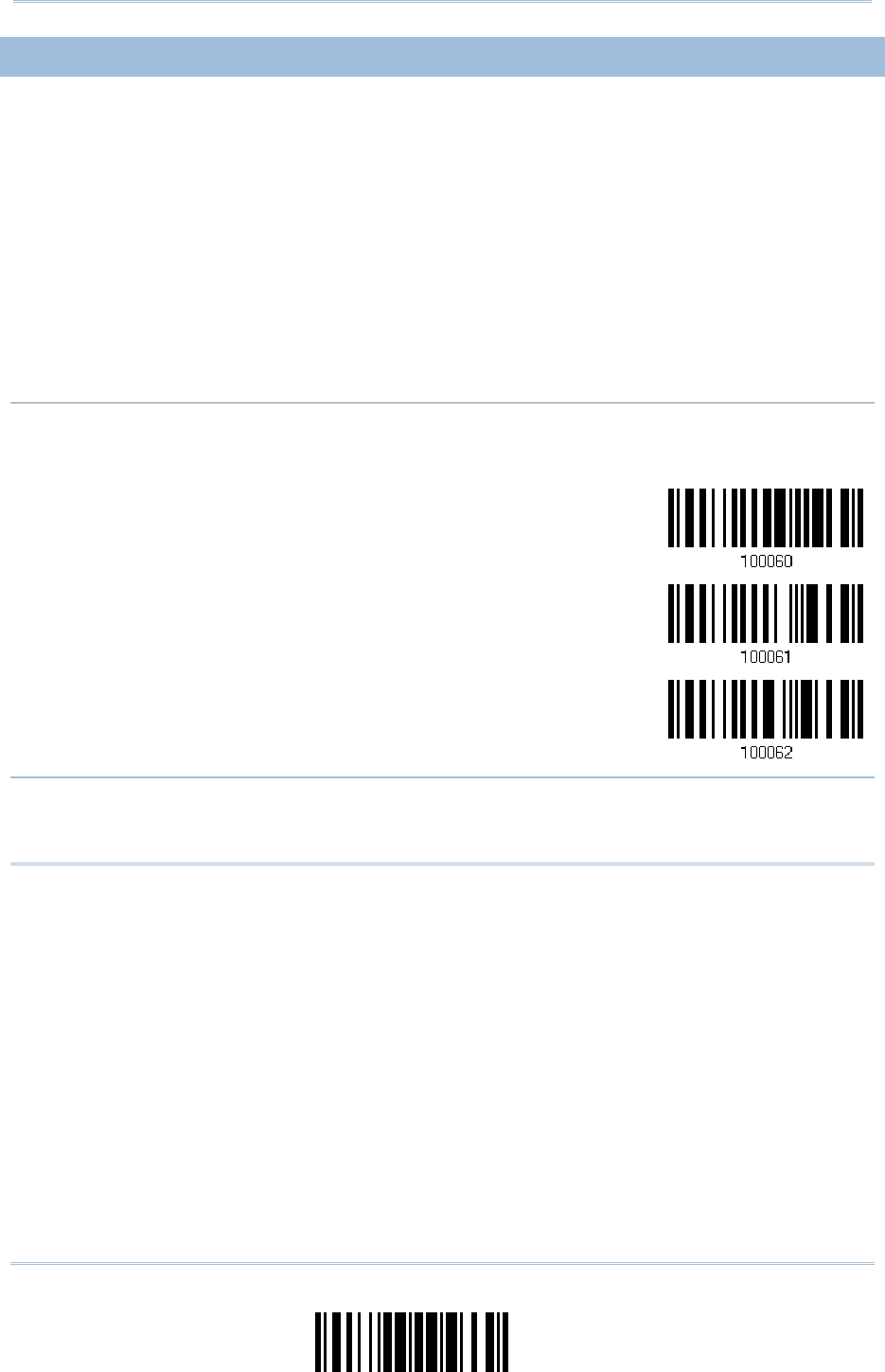
91
Update
Chapter 2
Selecting Output Interface
2.6.2 KEYBOARD SETTINGS
Alphabet Layout
Numeric Layout
Capital Lock Type
Capital Lock Setting
Alphabet Transmission
Numeric Transmission
Kanji Transmission
Alphabet Layout
By default, the alphabet layout is set to normal mode, also known as the standard English layout.
Select French or German keyboard layout if necessary. The scanner will make adjustments when
sending the "A", "Q", "W", "Z", "Y", and "M" characters according to this setting.
*Normal
AZERTY
QWERTZ
Note: This setting only works when the keyboard type selected is US keyboard, such as
PCAT (US). The Alphabet Layout and Numeric Layout setting must match using
keyboard.
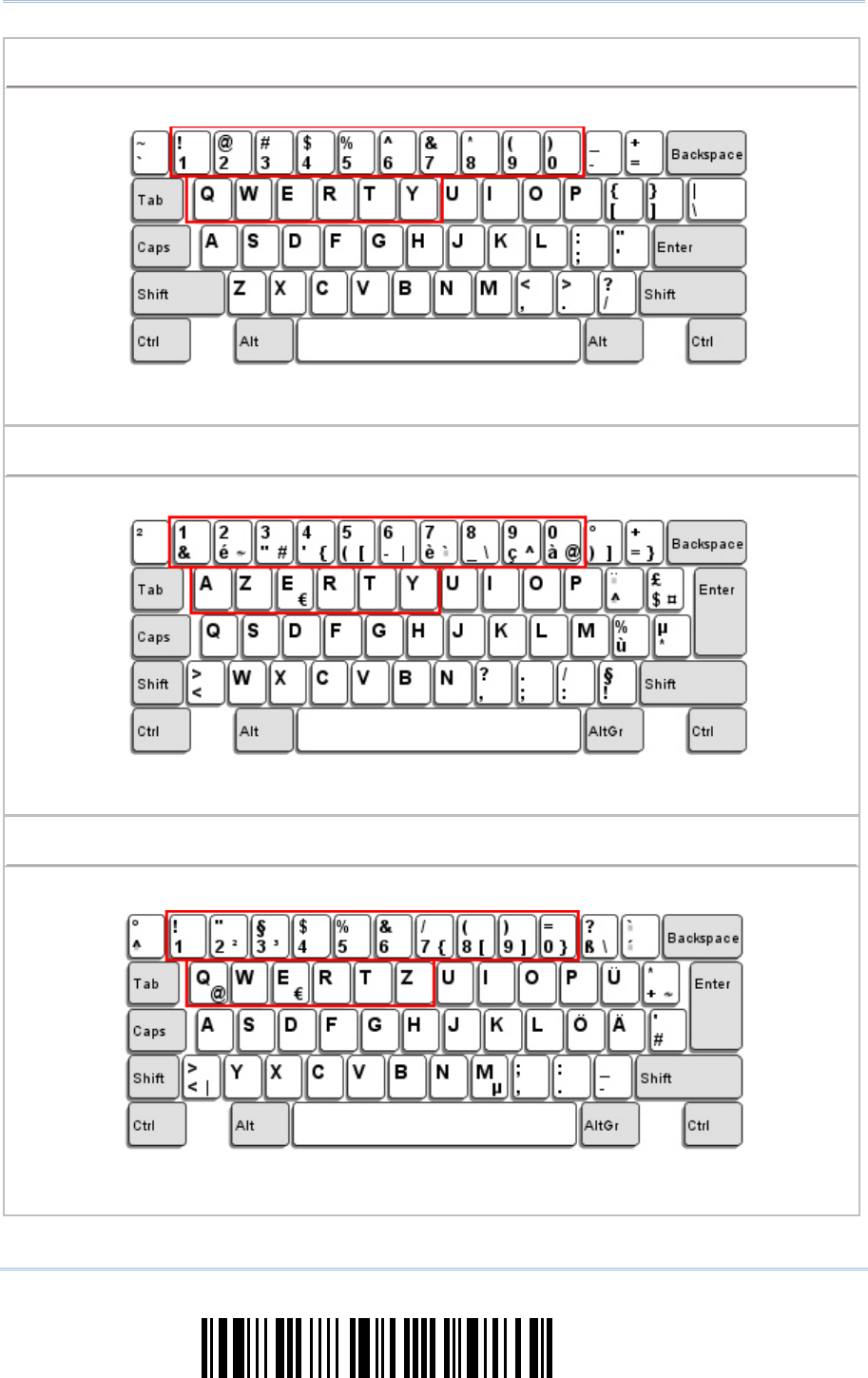
92
Enter Setup
1662 L/1664 Barcode Scanner User Guide
US Keyboard Style – Normal
QWERTY layout, which is normally used in western countries.
Select “Lower Row” for the “Numeric Layout” setting for the upper row is for special
characters.
French Keyboard Style – AZERTY
French layout; see below for French Keyboard Style.
Select “Upper Row” for the “Numeric Layout” setting for the lower row is for special
characters.
German Keyboard Layout – QWERTZ
German layout; see below for German Keyboard Style.
Select “Lower Row” for the “Numeric Layout” setting for the upper row is for special
characters.
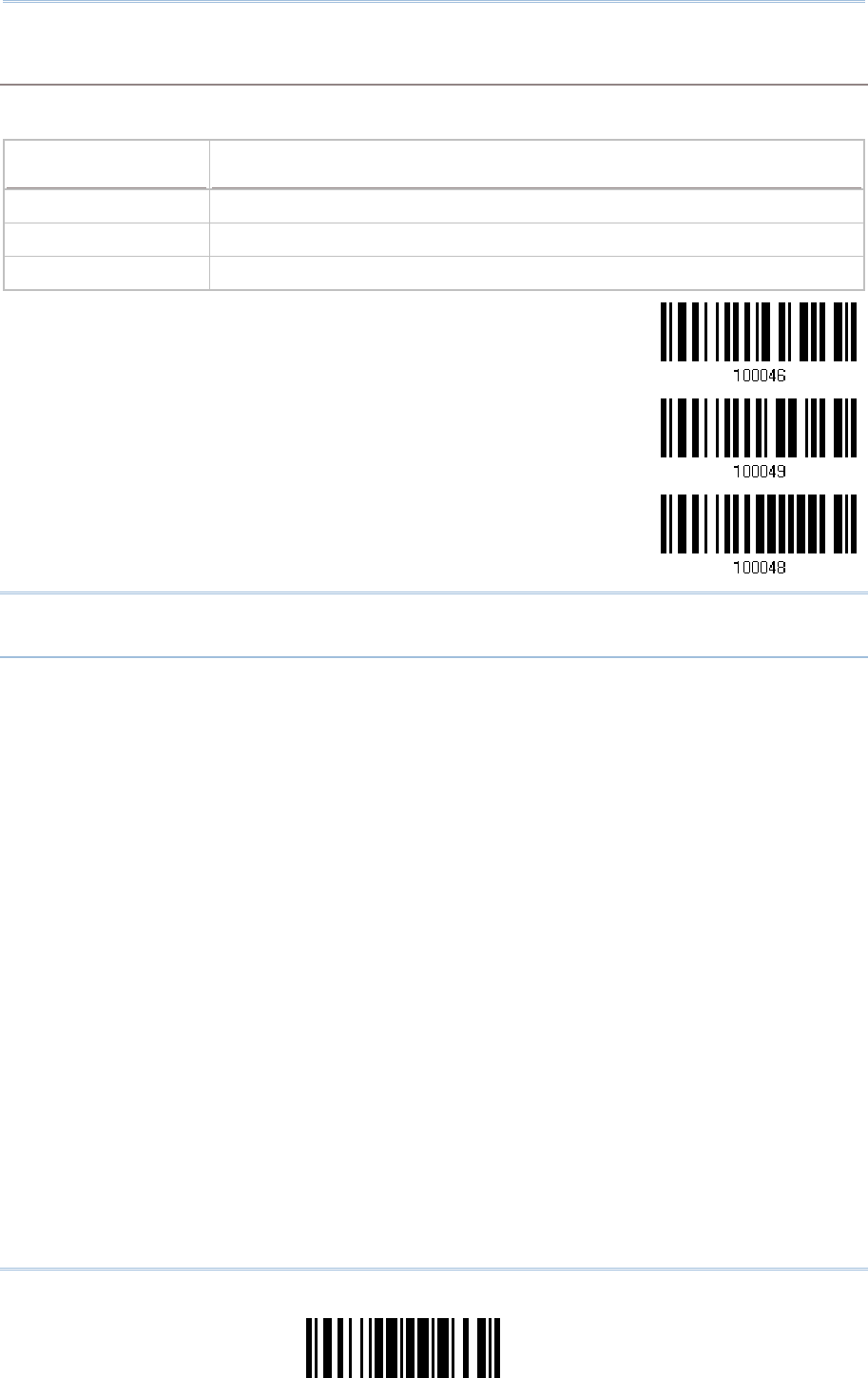
93
Update
Chapter 2
Selecting Output Interface
Numeric Layout
Select a proper layout that matches the alphabet layout. The scanner will make adjustments
according to this setting.
Options Description
Normal Depends on the [Shift] key or [Shift Lock] setting
Lower Row For QWERTY or QWERTZ keyboard
Upper Row For AZERTY keyboard
*Normal
Upper Row
Lower Row
Note: This setting is to be used with the Character Substitution setting when support for
certain keyboard types (languages) is unavailable but required.
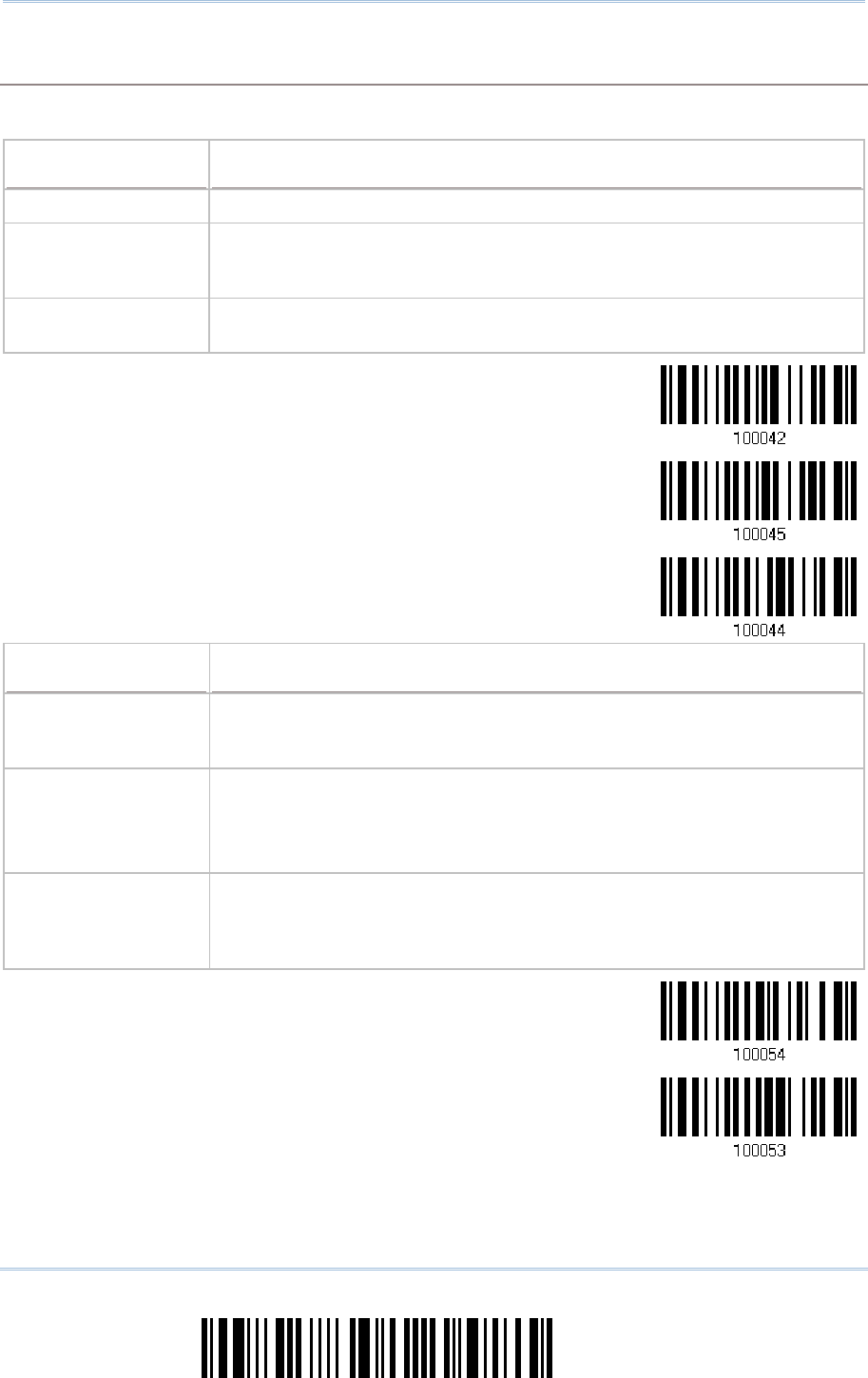
94
Enter Setup
1662 L/1664 Barcode Scanner User Guide
Capital Lock Type & Setting
In order to send the alphabet with correct case, the scanner needs to know the status of Caps Lock
on the keyboard. Incorrect settings may result in reversed case of the alphabet being transmitted.
Cap Lock Type Description
Normal Normal type
Capital Lock When enabled, the keys of alphabetic characters will be interpreted as
capital letters. However, this does not affect the number or punctuation
keys.
Shift Lock When enabled, the keys of alphabetic characters will be interpreted as
capital letters. In addition, this affects the number or punctuation keys.
*Normal
Shift Lock
Capital Lock
Capital Lock State Description
Capital Lock OFF Assuming that the status of Caps Lock on the keyboard is OFF,
transmitted characters are exactly the same as in the barcode (when
"case-sensitive" is selected for Alphabet Transmission).
Capital Lock ON Assuming that the status of Caps Lock on the keyboard is ON, transmitted
characters are exactly the same as in the barcode (when "case-sensitive"
is selected for Alphabet Transmission).
Refer to the Capital Lock Type above.
Auto Detection
(suggested use for
most applications)
The scanner will automatically detect the status of Caps Lock on the
keyboard before data is transmitted; transmitted characters are exactly
the same as in the barcode (when "case-sensitive" is selected for
Alphabet Transmission).
Auto Detect
Capital Lock ON

95
Update
Chapter 2
Selecting Output Interface
*Capital Lock OFF

96
Enter Setup
1662 L/1664 Barcode Scanner User Guide
Alphabet Transmission
By default, the alphabet transmission is case-sensitive, meaning that the alphabet will be
transmitted according to the original case, the status of Caps Lock on the keyboard, as well as the
Capital Lock setting. Select [Ignore Case] to have alphabet transmitted according to the status of
Caps Lock on the keyboard only.
Ignore Case
*Case-sensitive
R
efer to 5.1 Letter Case.
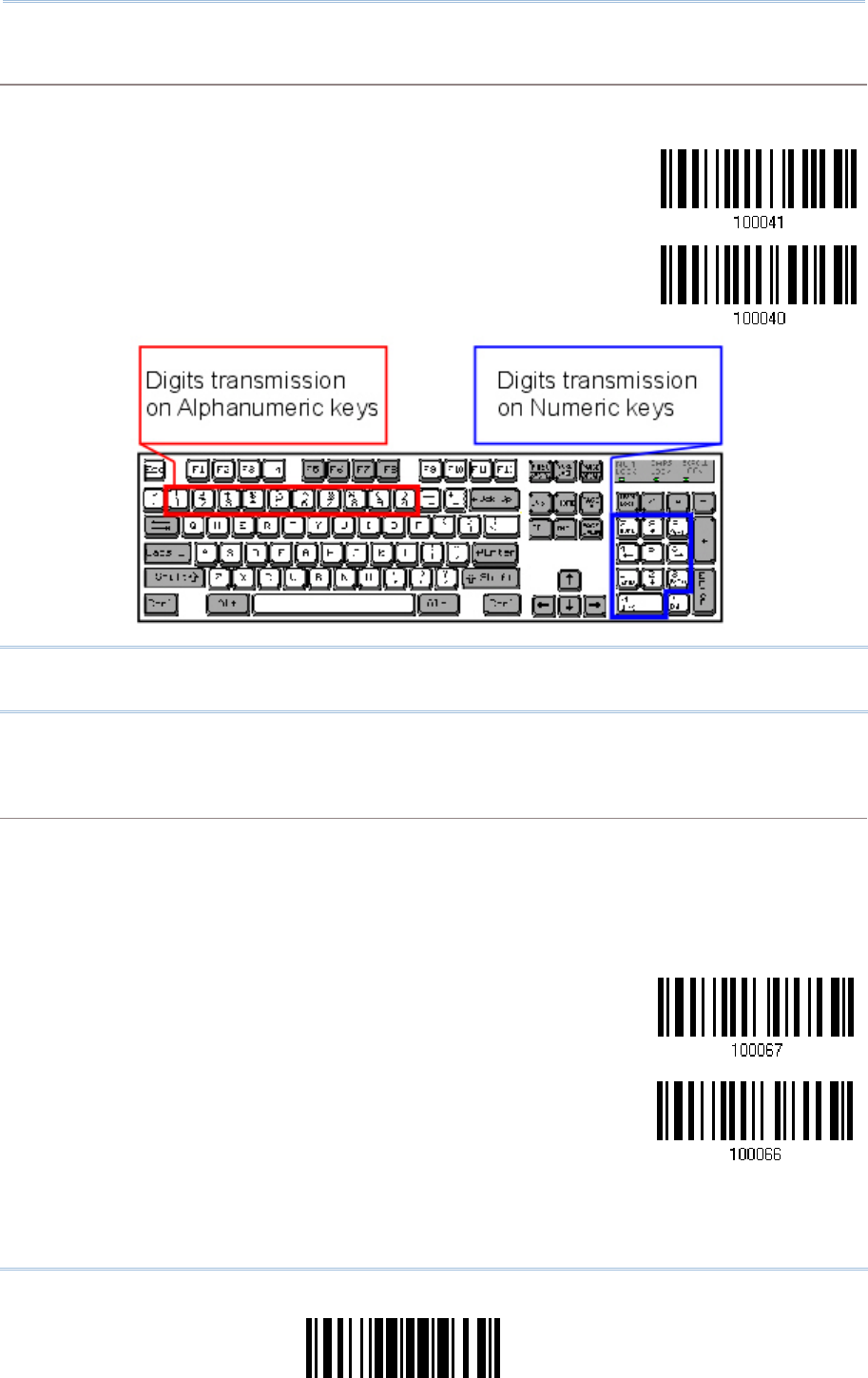
97
Update
Chapter 2
Selecting Output Interface
Numeric Transmission
By default, the alphanumeric keypad is used for transmitting numerics. Select “Numeric Keypad” if
want to use the keys on the numeric keypad.
Numeric Key
*Alphanumeric Key
Note: If selecting “Numeric Keypad”, the Num Lock status of the physical keyboard
should be "ON".
Kanji Transmission
Kanji Transmission is supported by the scanner when either Bluetooth® HID or USB HID is selected
for the output interface. By Kanji Transmission, when the host computer is running on Japanese
Windows O.S., the scanner is able to transmit Japanese characters including the Chinese
characters used in modern Japanese writing system.
Kanji Transmission is disabled by default. Enable/disable scanner’s Kanji Transmission by reading
the following barcodes:
Enable
*Disable
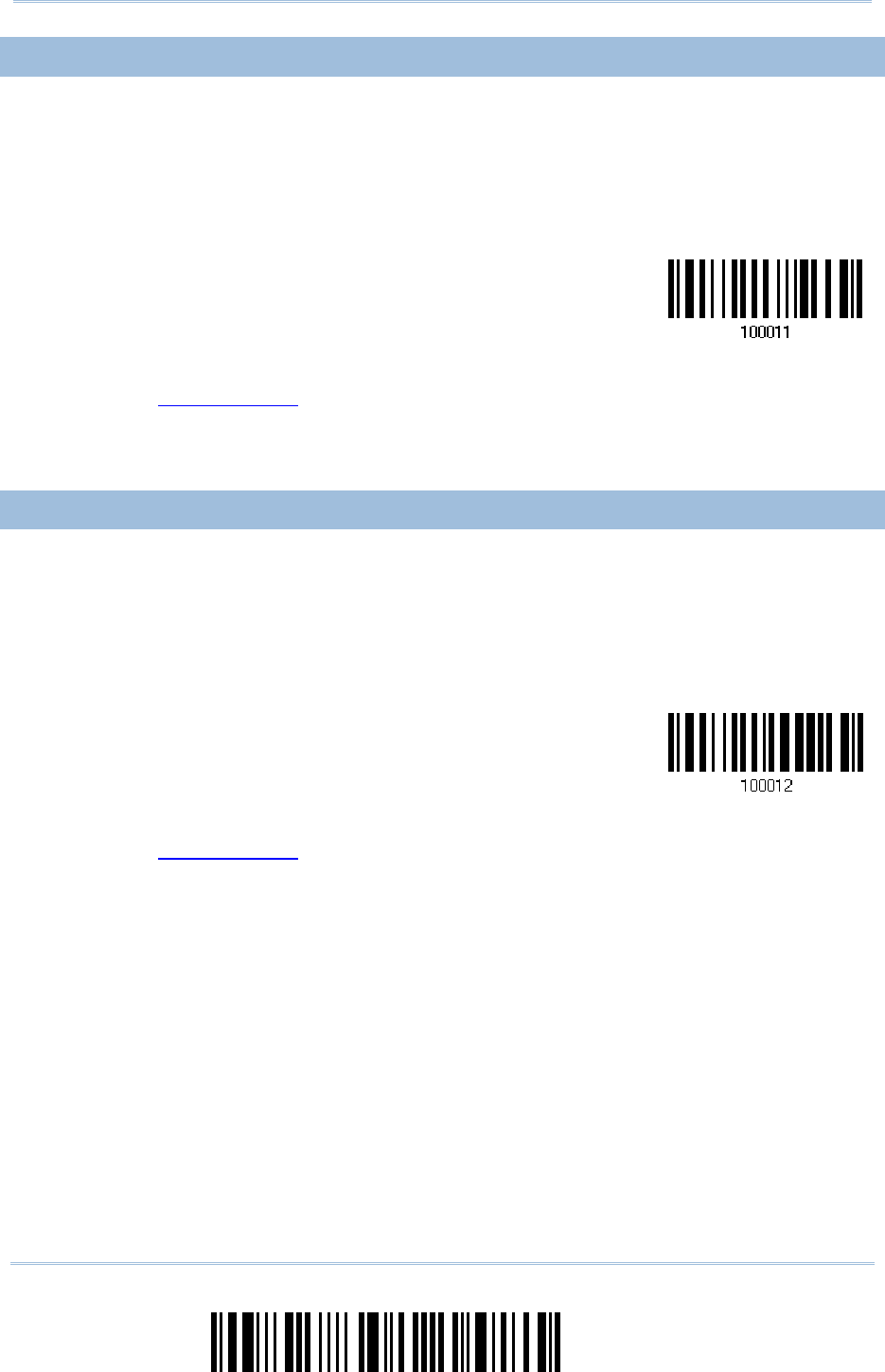
98
Enter Setup
1662 L/1664 Barcode Scanner User Guide
2.6.3 INTER-CHARACTER DELAY
By default, the inter-character delay is set to zero. Specify a value, ranging from 0 to
254 in units of milliseconds, to match the computer response time of the keyboard
interface. Such delay time is inserted between every character being transmitted. The
longer the delay time is, the slower the transmission speed will be.
Inter-Character
Delay… (*0~254)
1) Read the barcode above to specify the inter-character delay.
2) Read the “Decimal Value” barcode on page 錯誤! 尚未定義書籤。 for the desired
inter-character delay (in milliseconds).
3) Read the “Validate” barcode on the same page to complete this setting.
2.6.4 INTER-FUNCTION DELAY
By default, the inter-function delay is set to zero. Specify a value, ranging from 0 to 254
in units of milliseconds, to match the computer response time of the keyboard interface.
Such delay time is inserted between every function code (0x01 ~ 0x1F) being
transmitted. The longer the delay time is, the slower the transmission speed will be.
Inter-Function
Delay… (*0~254)
1) Read the barcode above to specify the inter-function delay.
2) Read the “Decimal Value” barcode on page 錯誤! 尚未定義書籤。 for the desired
inter-function delay (in milliseconds).
3) Read the “Validate” barcode on the same page to complete this setting.

99
Update
Chapter 2
Selecting Output Interface
2.6.5 HID CHARACTER TRANSMIT MODE
By default, HID interface sends data to the host in batch, or use the scanner to read the
“By Character” barcode to process data one character at a time.
*Batch Processing
By Character
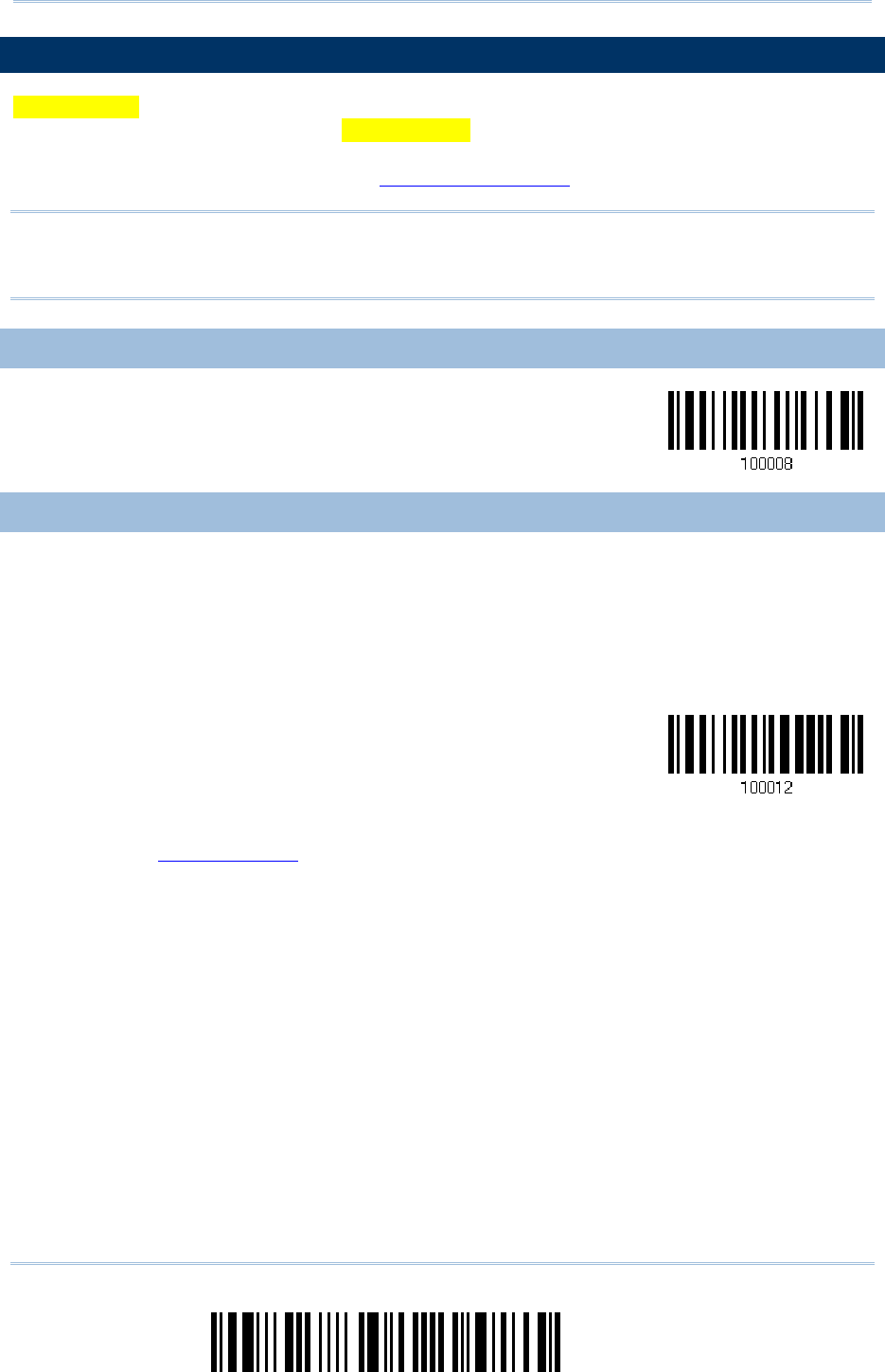
100
Enter Setup
1662 L/1664 Barcode Scanner User Guide
2.7 DIRECT USB VIRTUAL COM
1662 L/1664 supports “Direct” USB Virtual COM interface for memory mode. Use the
provided USB cable to connect 1662 L/1664 to the USB port of PC. You may run
HyperTerminal.exe on a computer to view and capture the scanned data being
transmitted to the computer. Refer to 1.2.2 Memory Mode.
Note: If using USB Virtual COM for the first time, install its driver from the CD-ROM.
Driver version 5.3 or later is required. Please remove older versions before
installing new ones!
2.7.1 ACTIVATE USB VIRTUAL COM
*
Activate Direct USB
Virtual COM
2.7.2 INTER-FUNCTION DELAY
By default, the inter-function delay is set to zero. Specify a value, ranging from 0 to 254
in units of milliseconds, to match the computer response time of the keyboard interface.
Such delay time is inserted between every function code (0x01 ~ 0x1F) being
transmitted. The longer the delay time is, the slower the transmission speed will be.
Inter-Function
Delay… (*0~254)
1) Read the barcode above to specify the inter-function delay.
2) Read the “Decimal Value” barcode on page 錯誤! 尚未定義書籤。 for the desired
inter-function delay (in milliseconds).
3) Read the “Validate” barcode on the same page to complete this setting.
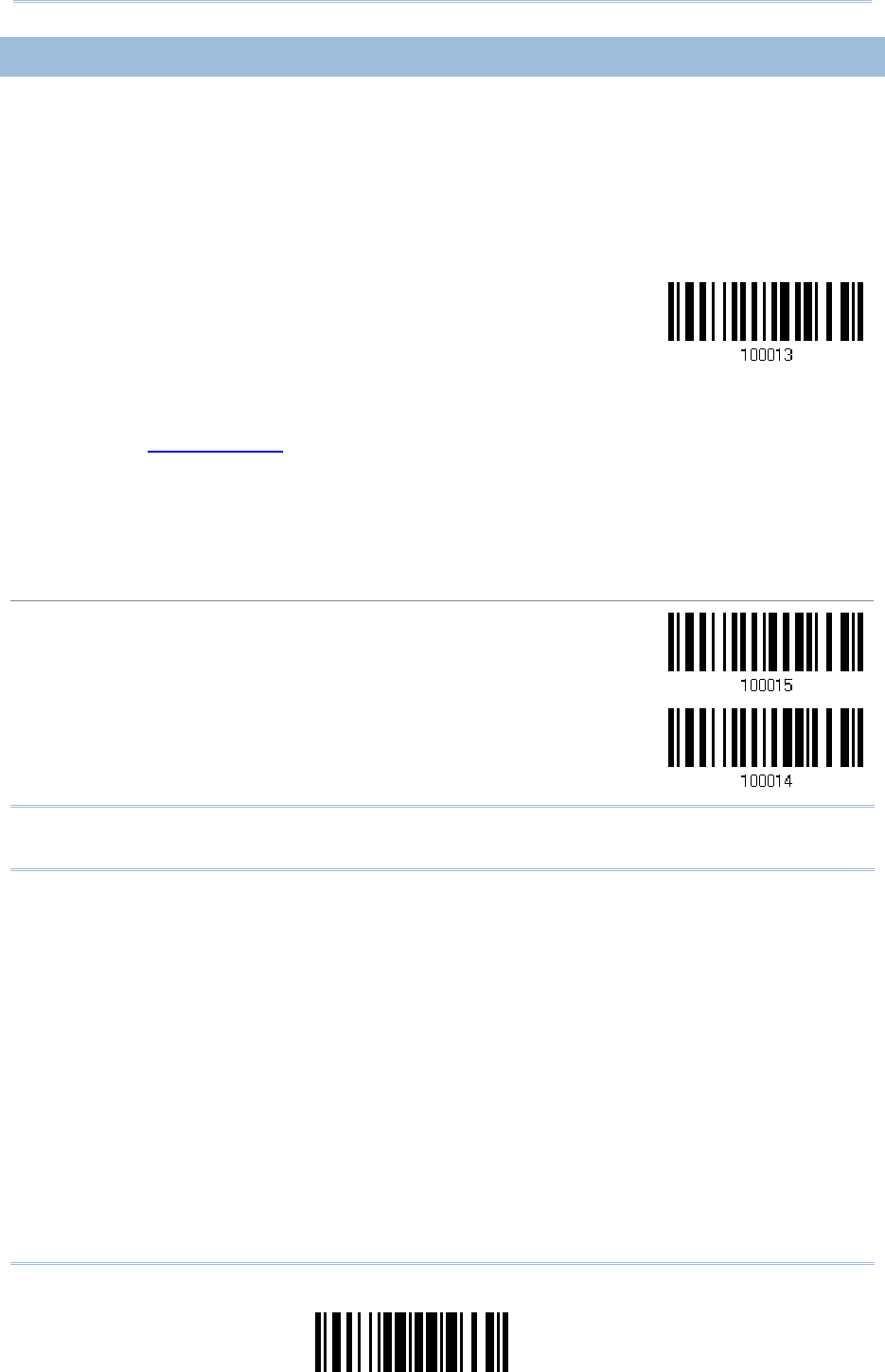
101
Update
Chapter 2
Selecting Output Interface
2.7.3 ACK/NAK TIMEOUT
By default, the scanner sends data to the host without waiting for an ACK/NAK response
before sending more data. Specify a value, ranging from 1 to 99 in units of 0.1 second. If
no response within the specified period of time, the scanner will attempt to send the
same data two more times. If all three attempts fail without any notification, data loss
will occur.
ACK/NAK Time-out
after … (*0~99)
1) Read the barcode above to specify the time interval for the scanner to send data and
wait for a response from the host.
2) Read the “Decimal Value” barcode on page 錯誤! 尚未定義書籤。. For example, read “1”
and “0” for the scanner to automatically shut down after being idle for 1 second.
3) Read the “Validate” barcode on the same page to complete this setting.
ACK/NAK Error Beep
Enable Error Beep
*Disable Error Beep
Note: We suggest enabling the error beep so that data loss is notified and the scanner
re-read data.

102
Enter Setup
1662 L/1664 Barcode Scanner User Guide
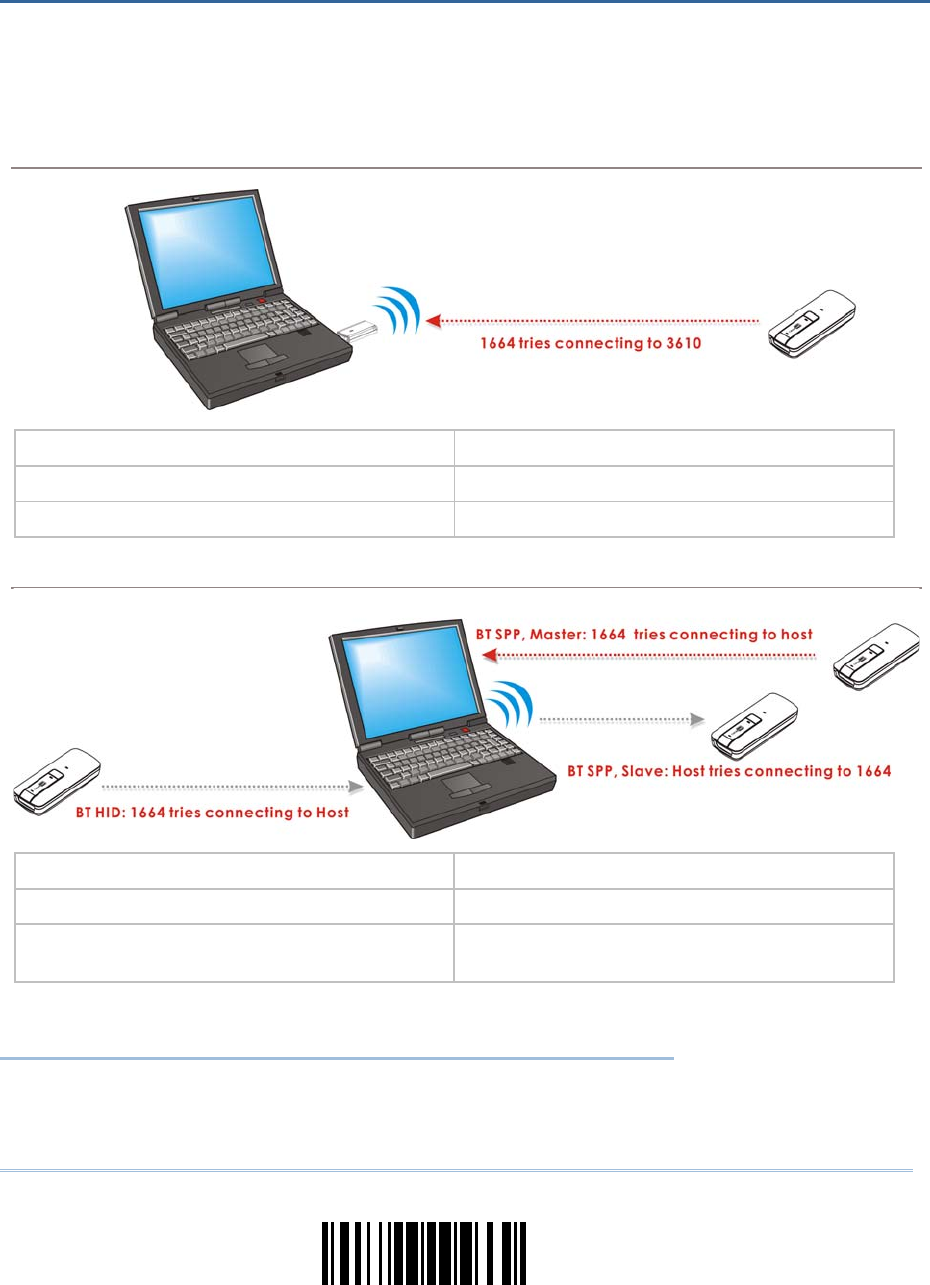
103
Update
The scanner can be configured to send data to a host computer wirelessly via the 3610
dongle, or to a notebook computer or PDA with Bluetooth® wireless technology. Upon
powering up, the scanner will be ready to establish a WPAN connection.
To establish a connection via 3610 after reading “Set Connection” and “Serial No.” labels …
Interface Option Reference
USB HID 2.4 USB HID via 3610
USB Virtual COM 2.5 USB Virtual COM via 3610
To establish a connection via Bluetooth® dongle after pairing…
Interface Option Reference
Bluetooth® HID 2.1 Bluetooth® HID
Bluetooth® SPP 2.2 Bluetooth® SPP Slave, 2.3 Bluetooth®
SPP Master
IN THIS CHAPTER
3.1 Connecting via 3610 ................................................. 102
3.2 Connecting via Bluetooth® Dongle ............................... 105
Chapter 3
SET UP A WPAN CONNECTION
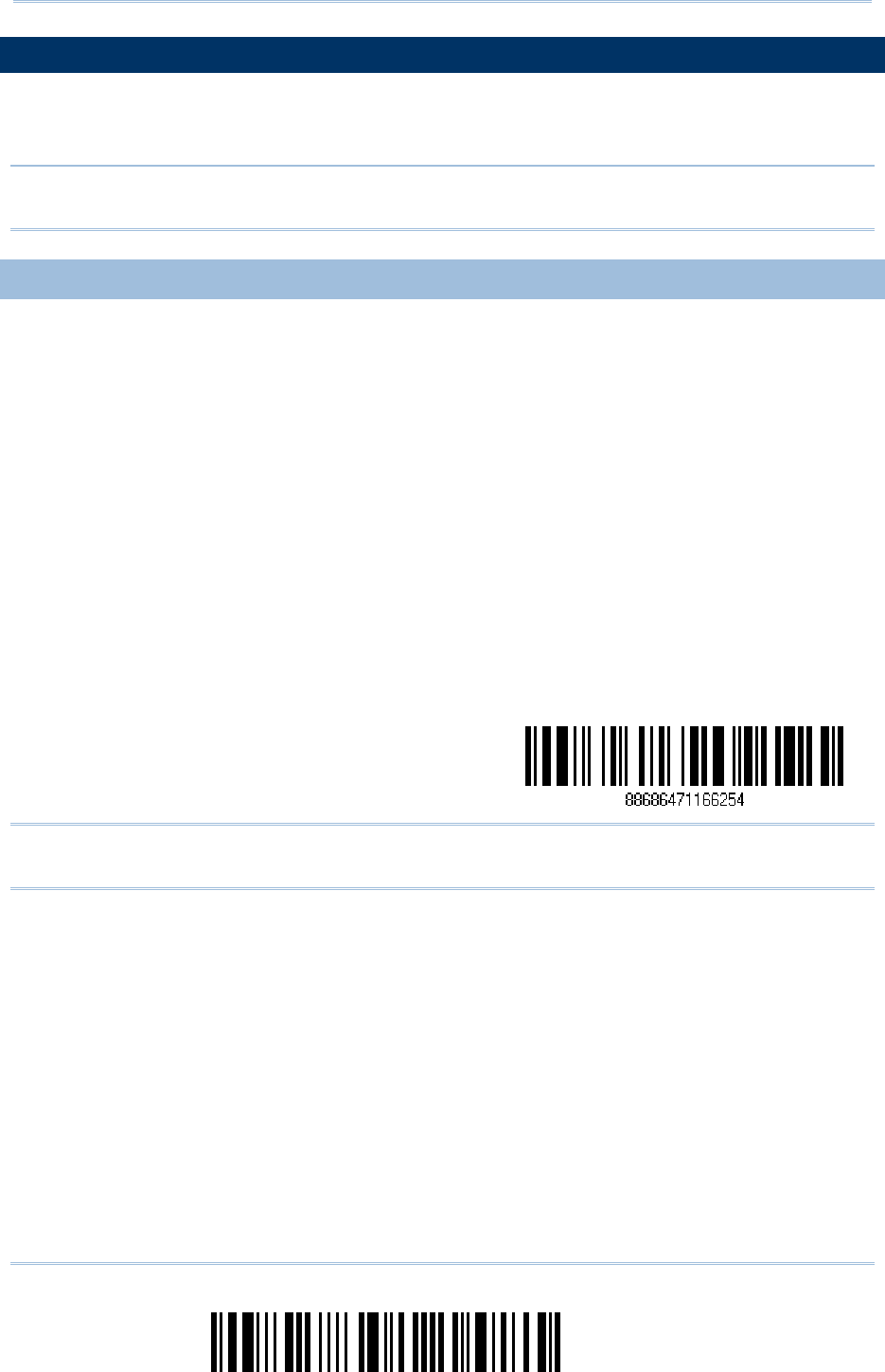
104
Enter Setup
1662 L/1664 Barcode Scanner User Guide
3.1 CONNECTING VIA 3610
By default, the interface of 3610 is set to “USB HID”. You can have up to seven scanners
connected to one computer at the same time.
Note: If you are using USB Virtual COM for the first time, you must install its driver from
the CD-ROM. Driver version 5.3 or later is required. Please remove older versions!
3.1.1 CONNECT TO 3610
Connect any scanner to 3610 by reading the two labels at the back of 3610. The scanner
will respond with one beep upon reading each of the labels.
“Set Connection” label
“Serial Number” label
After reading these labels, the scanner will stay active for a specified period of time (2
minutes by default) trying to connect to the 3610 while its LED is flashing blue (On/Off
ratio 0.5 s: 0.5 s). Once connected, the scanner will respond with three beeps (tone
ascending from low to high), and the LED flashes blue (On/Off ratio 0.02 s: 3 s). When
out of range, the scanner will respond with three short beeps (tone descending from high
to low).
Read the “Set Connection” label first, and then the “Serial Number” label. If the “Set
Connection” label on 3610 is illegible, try this one —
Set Connection
Note: The 3610 settings will overwrite the interface-related settings on the scanners that
are currently connected to 3610.
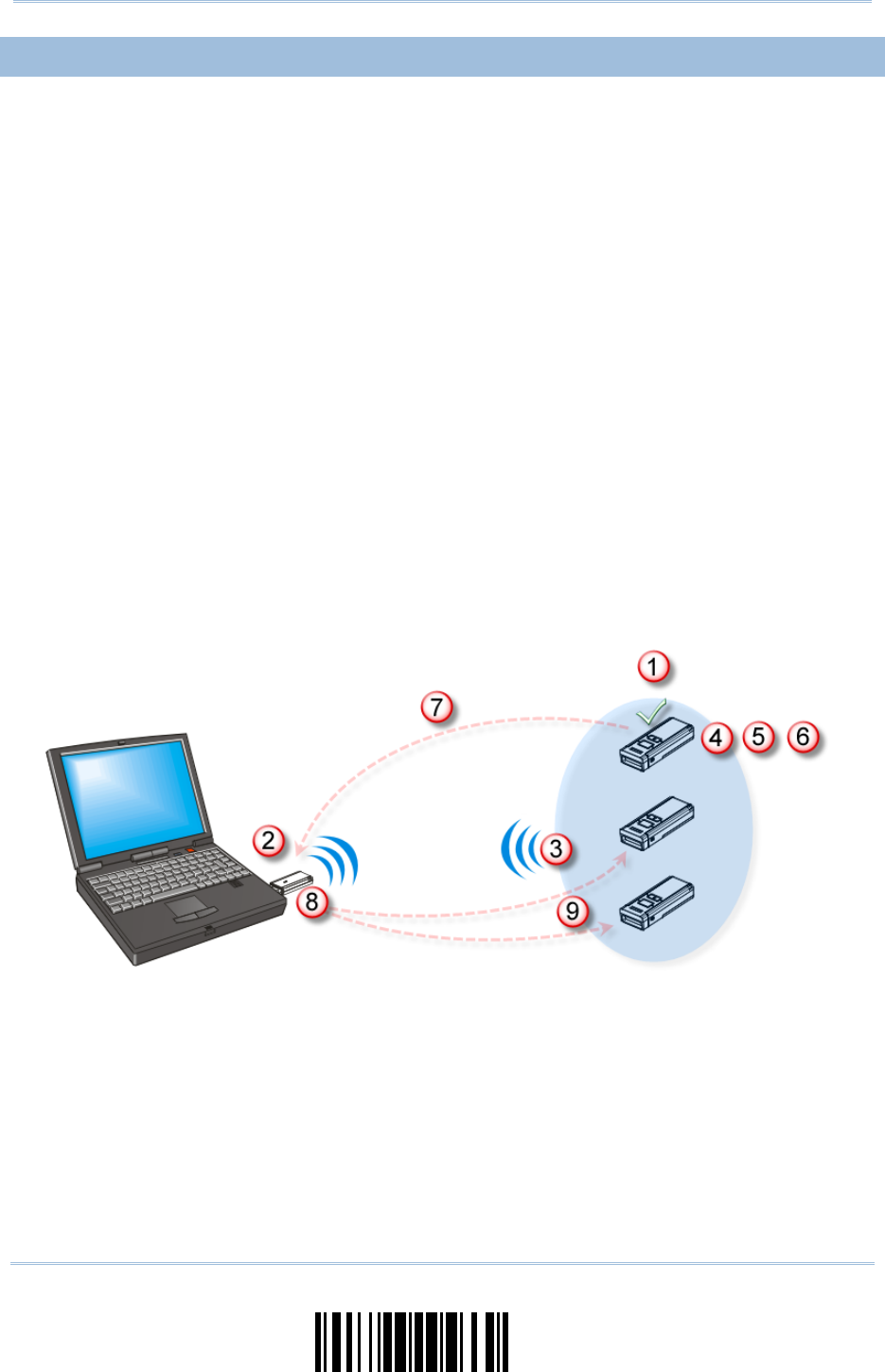
105
Update
Chapter 3
Set up a WPAN Connection
3.1.2 CHANGE INTERFACE
If want to change the interface 3610, use one of the connected scanners to configure the
interface-related settings and it will pass the new settings to 3610, which will then
initialize and pass the settings to any other connected scanners.
1) Read the “Set Connection” and “Serial Number” labels at the back of 3610.
2) Within two minutes, connect 3610 to the USB port of PC. For USB Virtual COM, you
will need to install its driver first!
3) The scanners will connect to the computer via 3610.
4) Read the “Enter Setup” barcode to enter the configuration mode.
5) Read the desired interface barcode and configure its related settings –
“Activate USB HID & Select Keyboard Type”
“Activate USB Virtual COM”
6) Read the “Update” barcode to exit the configuration mode.
7) After the scanner resumes connection with 3610, it will pass the interface-related
settings to 3610.
8) Upon receipt of the new settings, 3610 will initialize itself.
9) Updated with new settings, 3610 will pass the settings to other connected scanners.

106
Enter Setup
1662 L/1664 Barcode Scanner User Guide
3.1.3 CONFIGURE RELATED SETTINGS
Sniff Mode (Power-saving)
By default, this feature is enabled, meaning the scanner will listen to the wireless network at a
reduced rate.
*Enable
Disable

107
Update
Chapter 3
Set up a WPAN Connection
3.2 CONNECTING VIA BLUETOOTH® DONGLE
3.2.1 CHANGE INTERFACE
Below is the procedure to configure the scanner before establishing a WPAN connection
via Bluetooth® dongle.
1) Read the “Enter Setup” barcode to enter the configuration mode.
2) Read the desired interface barcode –
“Activate Bluetooth® HID & Select Keyboard Type”
“Activate Bluetooth® SPP Slave Mode”
“Activate Bluetooth® SPP Master Mode”
3) Read the barcodes related to WPAN settings, such as Device Name Broadcasting,
Authentication & PIN Code, etc.
4) Read the “Update” barcode to exit the configuration mode.
5) The scanner will stay active for a specified period of time (2 minutes by default)
waiting for a connection request from the host (SPP Slave Mode) or trying to connect
to the host (HID or SPP Master Mode). Its CPU is running at full speed, and the LED is
flashing blue (On/Off ratio 0.5 s: 0.5 s).
Once connected, when out of range, the scanner will respond with three short beeps
(tone descending from high to low).
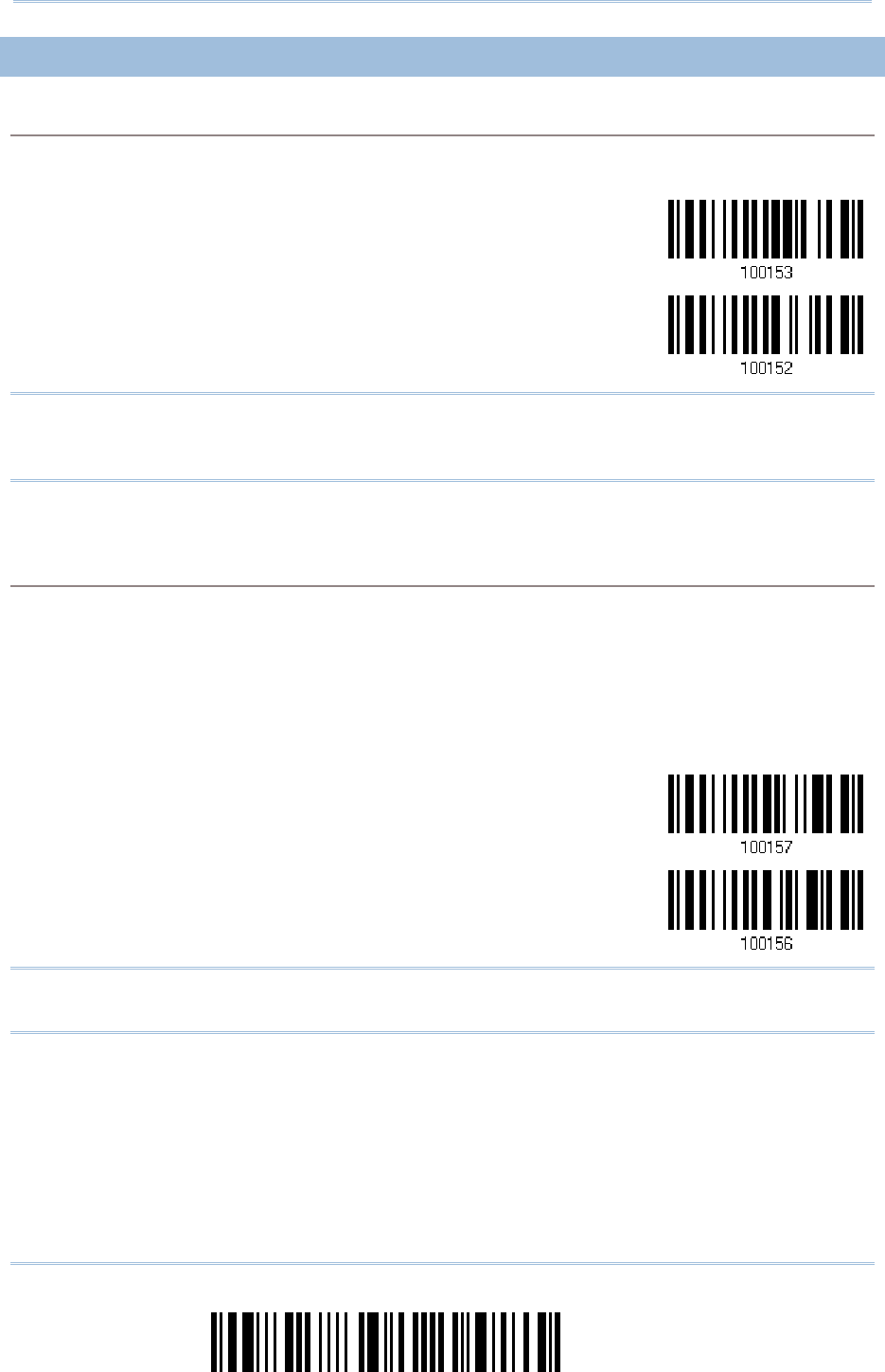
108
Enter Setup
1662 L/1664 Barcode Scanner User Guide
3.2.2 CONFIGURE RELATED SETTINGS
Sniff Mode (Power-saving)
By default, this feature is enabled, meaning the scanner will listen to the wireless network at a
reduced rate.
*Enable
Disable
Note: When connecting more than two scanners to a notebook computer or PDA with
Bluetooth® wireless technology, we suggest that you disable the power-saving
setting for a more reliable connection.
Device Name Broadcasting
The scanner can be configured to hide itself from other devices equipped with Bluetooth® wireless
technology. Simply disable the device name broadcasting setting so that it won’t be discovered by
any other computer or PDA. However, broadcasting must be enabled for establishing an initial
connection with the scanner. For example, disable device name broadcasting after successfully
connecting the scanner to WorkStation1. Such connection will be maintained automatically unless
the scanner is removed from the paired device list (called unpairing) by WorkStation1 or any
changes made to authentication and the PIN code. If you want WorkStation2 to connect to the
scanner, you have to enable device name broadcasting first.
*Enable
Disable
Note: By default, device name broadcasting is enabled (which is required for initial
connection).
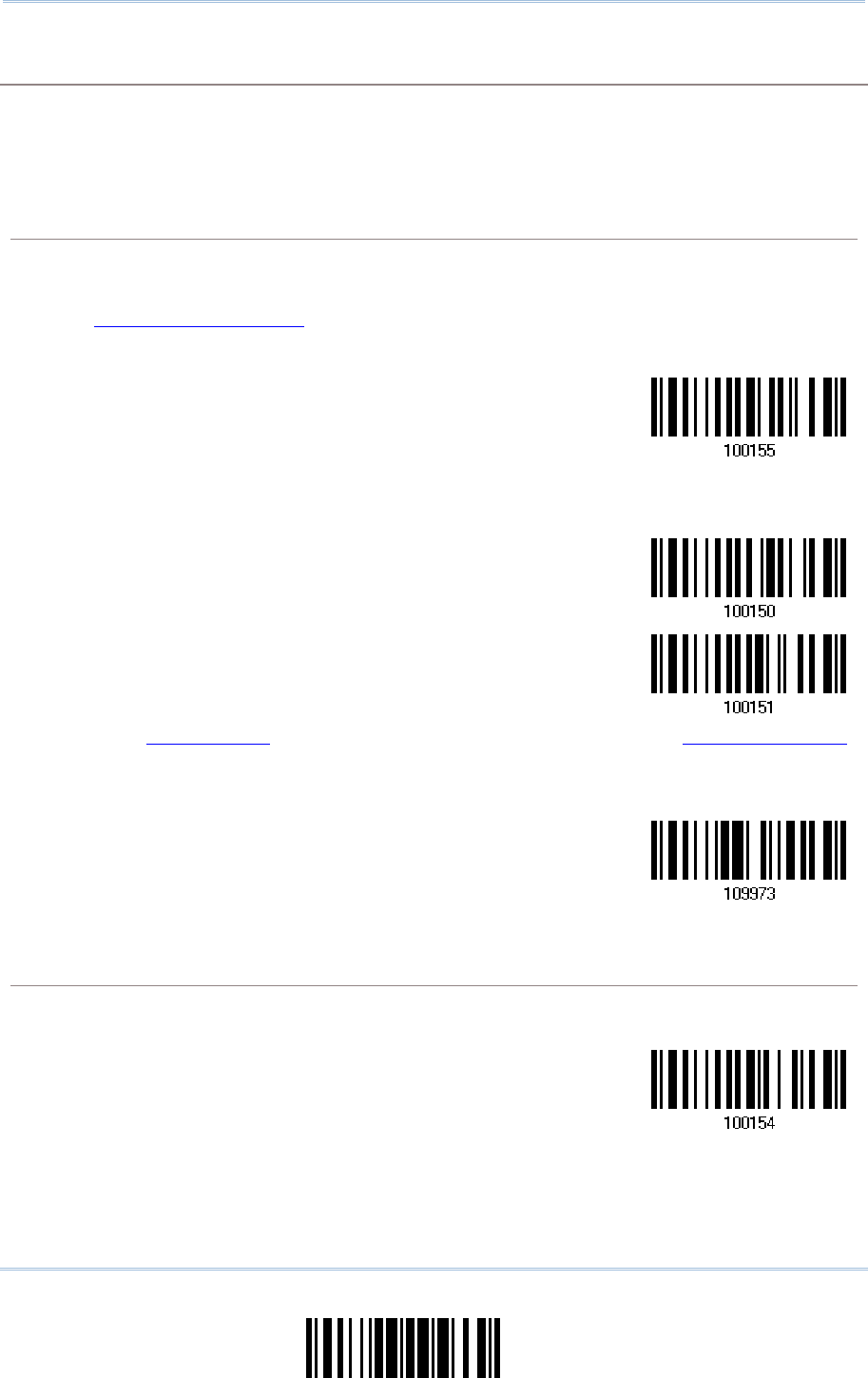
109
Update
Chapter 3
Set up a WPAN Connection
Authentication
When any changes are made to authentication and PIN code on the scanner side, you will have to
remove the scanner from the paired device list (called unpairing) and go through the whole process
to re-establish the connection.
The scanner allows up to 16 characters for a PIN code and provides two options for authentication:
Enable Authentication with Preset PIN
Read the “Use preset PIN” barcode, and change the preset PIN if necessary. This means you will
have to enter exactly the same string for your computer or PDA to connect to the scanner. If the
PIN or passkey is incorrect, any connection attempt will be turned down by the scanner. See
step 8 in 3.2.3 Connect to Dongle.
1) Read the “Use preset PIN” barcode to enable authentication with a preset PIN.
Use Preset PIN
2) Read one of the barcodes to specify the PIN code, in decimal or hexadecimal.
By default, the PIN code is set to “0000”. Maximum 16 characters are allowed.
Enter PIN in
Hexadecimal …
Enter PIN in
Decimal…
3) Read the “Decimal Value” barcode on page 錯誤! 尚未定義書籤。 or the “Hexadecimal Value”
barcode on page 錯誤! 尚未定義書籤。 for the desired digits or character string.
Read the “Clear PIN Code” barcode first if you need to re-input the PIN code.
Clear PIN Code
4) Read the “Validate” barcode to complete this setting.
Enable Authentication with Random PIN or No Authentication
By default, it is set to “No PIN or use random PIN”, which depends on the setting of the target
device. (No PIN = No authentication.)
*
No PIN or
use random PIN
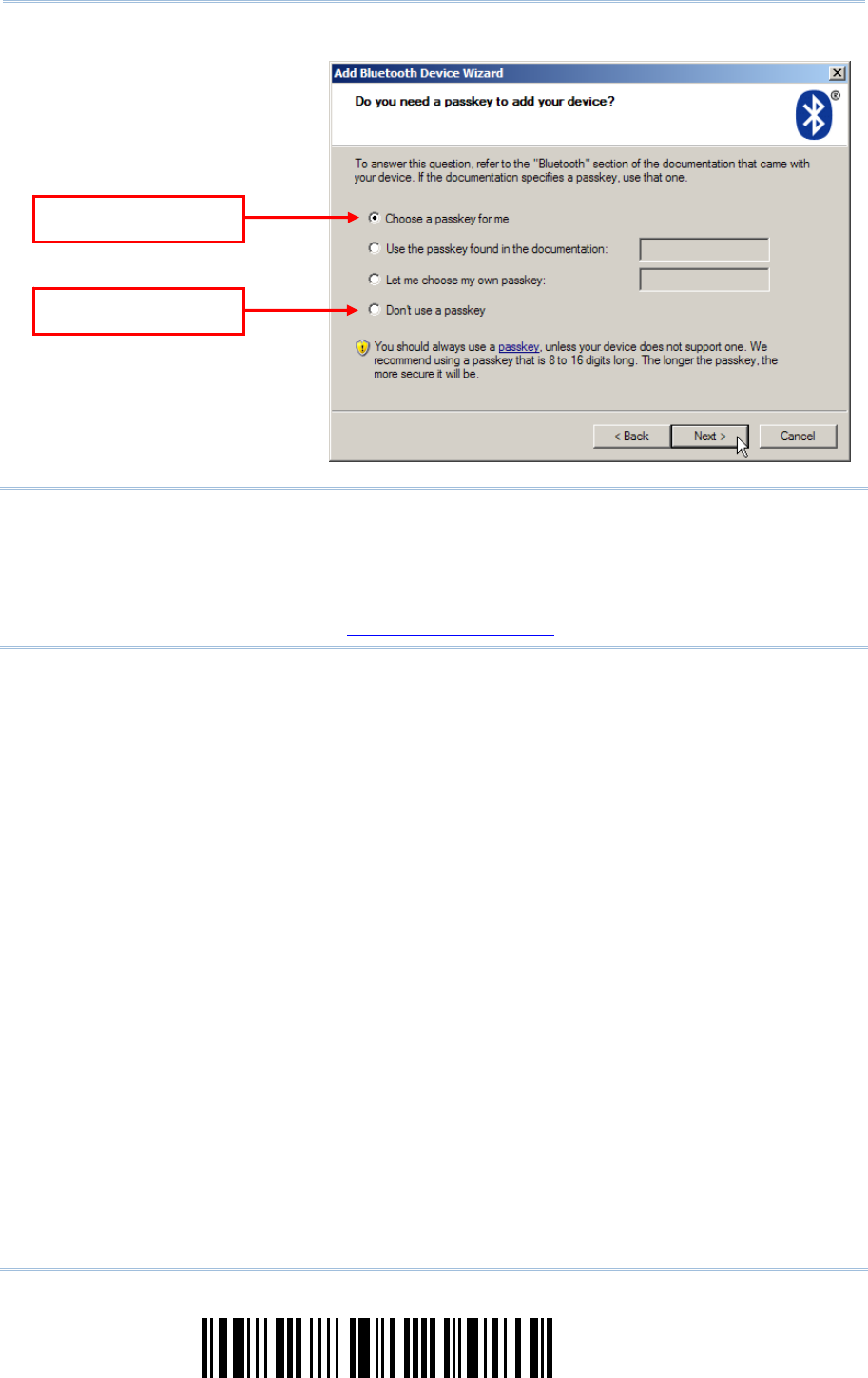
110
Enter Setup
1662 L/1664 Barcode Scanner User Guide
Note: When using Bluetooth® HID, some device driver may not support pre-defined PIN
code for authentication. In this case, make sure you have the scanner set to “No
PIN or use random PIN” before pairing. While pairing, the host PIN code will be
displayed on the computer screen. Have the scanner read the setup barcode
“Enter PIN Code in Decimal” or “Enter PIN Code in Hexadecimal” to input the
matching PIN code. Refer to 錯誤! 找不到參照來源。.
Use random PIN
No PIN required
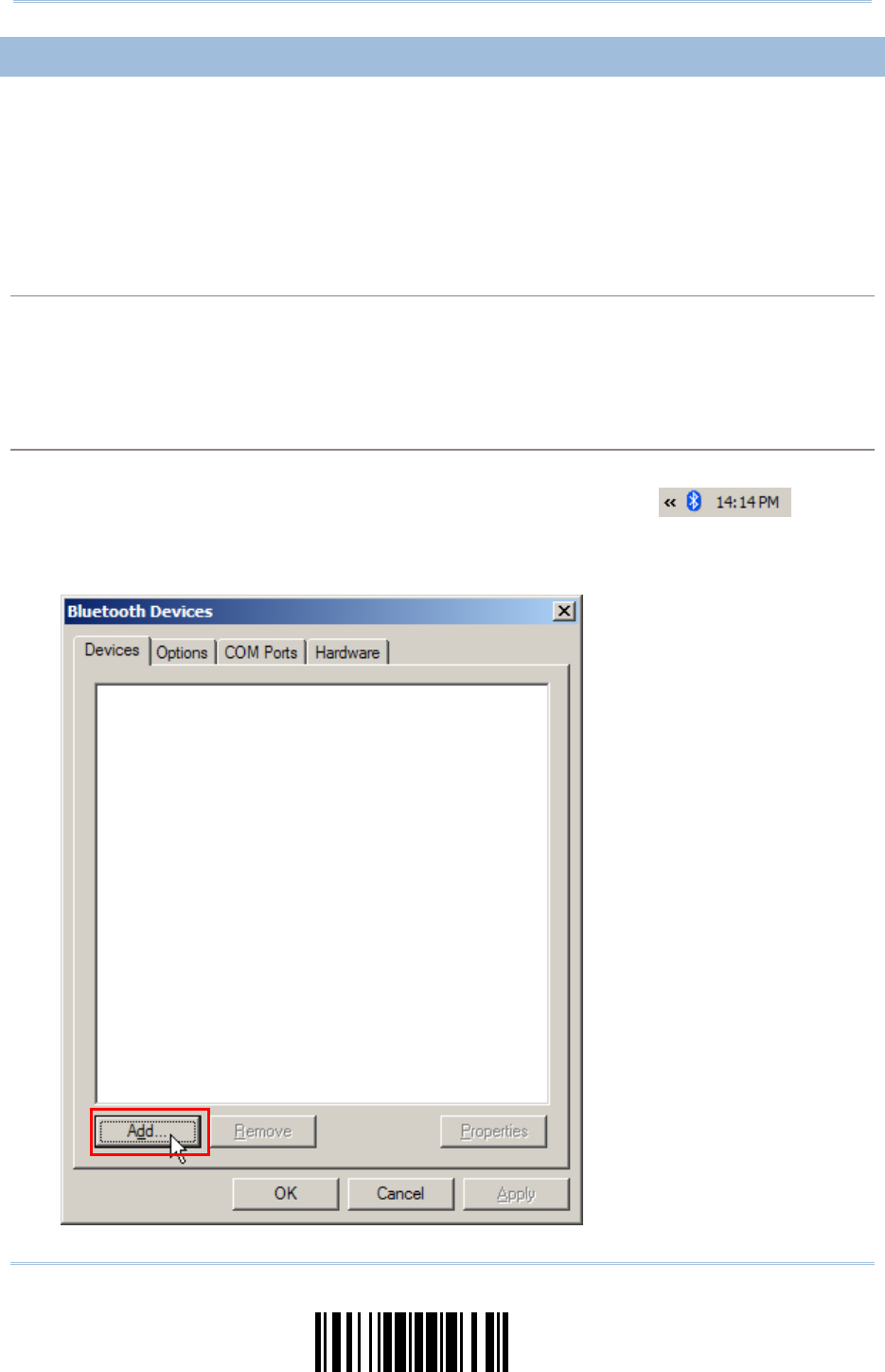
111
Update
Chapter 3
Set up a WPAN Connection
3.2.3 CONNECT TO DONGLE
The procedure goes through associating devices for establishing a WPAN connection,
which is pretty much the same except for the software you are using. If your computer is
running Microsoft® Windows® XP (SP1 to SP3), Windows Vista® Service Pack 1 (SP1) and
Windows 7, you can use the software support that Windows® includes, or you can use
the driver that the device manufacturer provides. Now, let’s try using the software
support that Windows® XP Service Pack 2 includes.
Bluetooth® HID Procedure
By default, Bluetooth® HID is activated on the scanner, and the keyboard type is set to PCAT (US).
When Bluetooth® HID is re-activated, you will have to select a keyboard type to complete this
setting.
The procedure is the same as for Bluetooth® SPP. Refer to steps 1~11 below.
Bluetooth® SPP Procedure
1) Turn on the Bluetooth® function on your computer, running Windows XP SP2.
2) Double-click the Bluetooth® icon from the lower right of the taskbar.
Alternatively, you may go to Control Panel > Bluetooth Devices.
3) Click [Add] to search devices nearby.
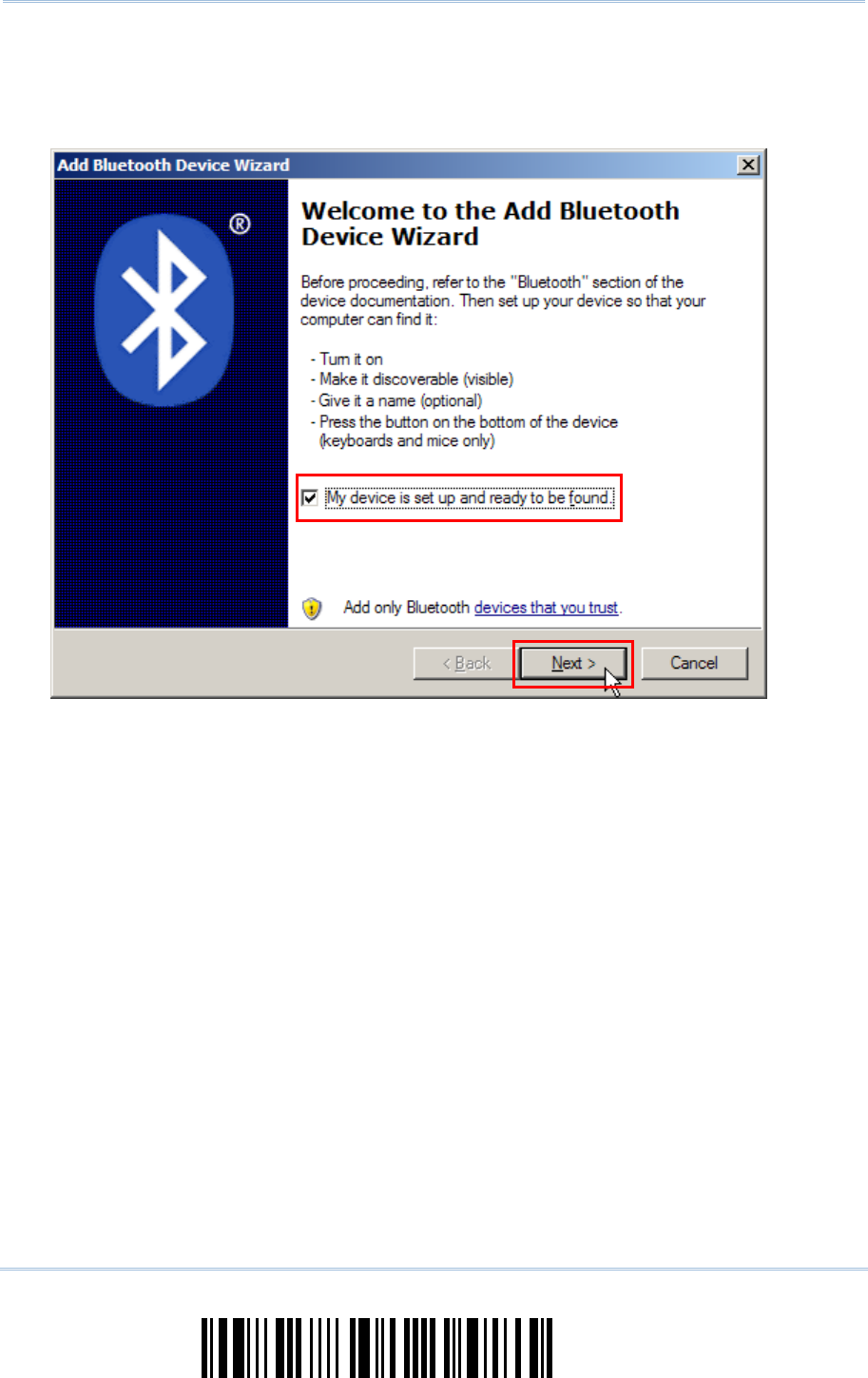
112
Enter Setup
1662 L/1664 Barcode Scanner User Guide
4) Turn on the scanner with correct WPAN settings, such as select Bluetooth® SPP or Bluetooth®
HID, broadcasting enabled, authentication enabled, and PIN code specified, etc. Select the
check box of [My device is set up and ready to be found] on your computer.
5) Click [Next].
6) Wait for a few seconds for the Wizard to search available devices nearby.
The scanner will appear with its “serial number” as the device name. You may double-check
the “Serial Number” label on the scanner to ensure connecting with the correct scanner.
Select the target scanner. If the target scanner does not appear on the list, click [Search
Again] to refresh the list. The scanner might enter Suspend Mode now, and you can press the
trigger to have it active again (=discoverable). It will then stay active for a specified period of
time (2 minutes by default) and wait for PC to establish a connection.
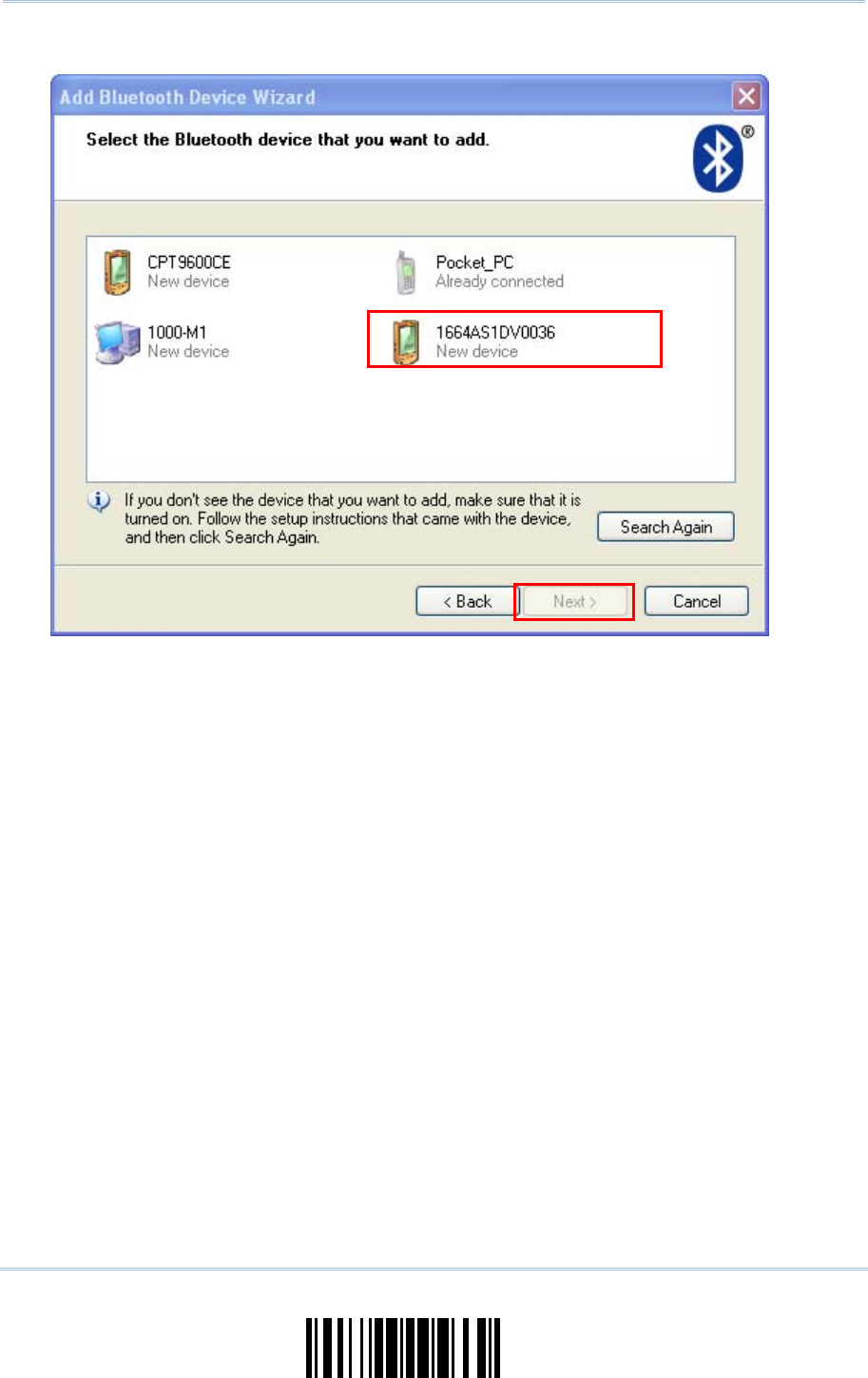
113
Update
Chapter 3
Set up a WPAN Connection
7) Click [Next].
8) Enter the passkey for authentication, which must be exactly the same as configured for the
scanner.
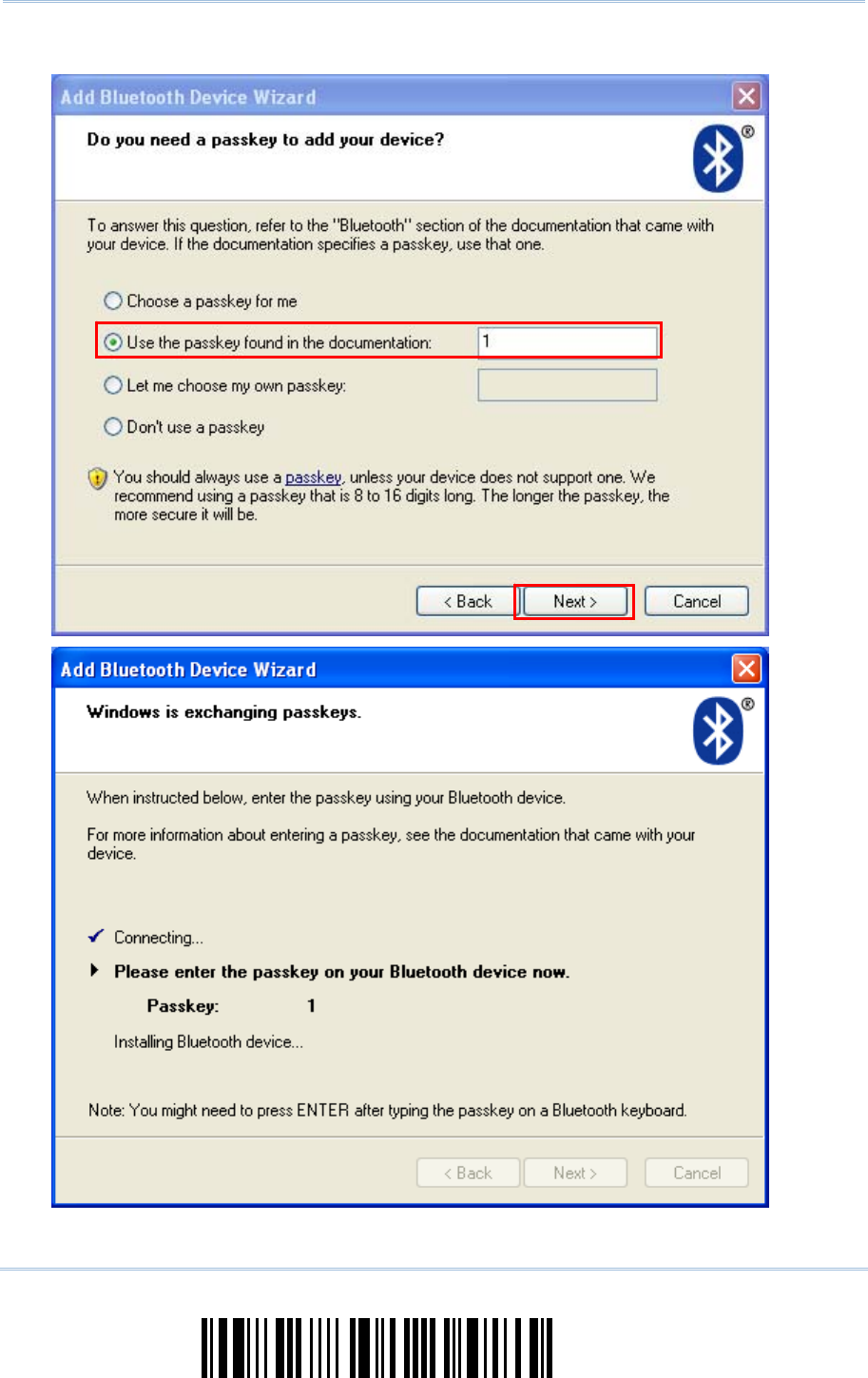
114
Enter Setup
1662 L/1664 Barcode Scanner User Guide
9) Click [Next]. Wait for a few seconds for Windows to exchange passkeys.
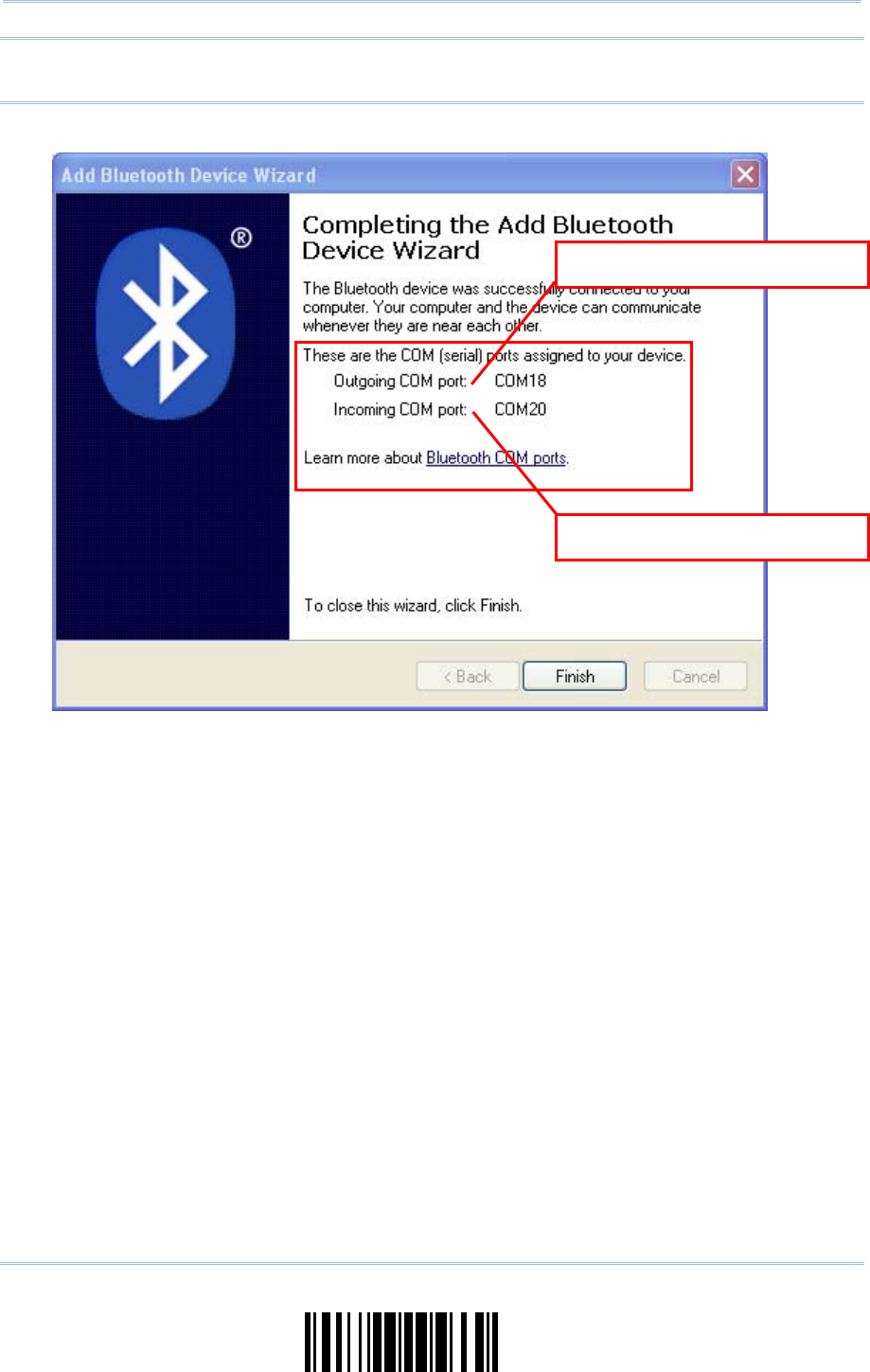
115
Update
Chapter 3
Set up a WPAN Connection
Note: When Bluetooth security is enabled without providing a pre-set PIN code, dynamic
input of PIN code is supported.
10) Click [Finish].
1664 as Bluetooth
®
SPP Slave
1664 as Bluetooth
®
SPP Master
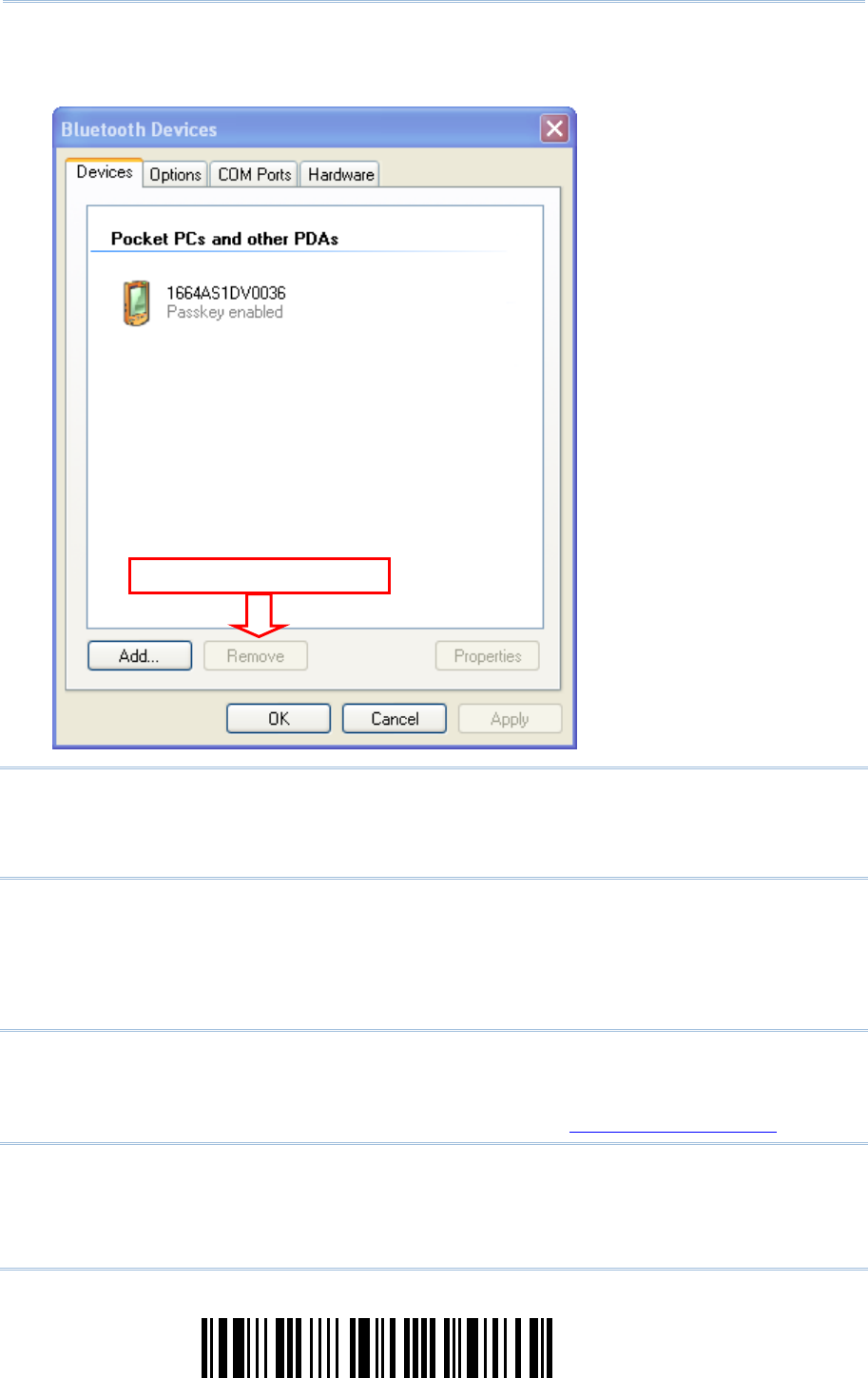
116
Enter Setup
1662 L/1664 Barcode Scanner User Guide
11) Now the target scanner will be listed as shown below.
You can have up to seven scanners connected to one computer at the same time.
Note: When any changes are made to authentication and PIN code on the scanner side,
or you want to change to use Bluetooth® HID, it is suggested that you remove the
scanner from the paired device list (called unpairing) and go through the whole
process to re-establish the connection.
12) Run the desired application on your computer, such as HyperTerminal.exe if using Bluetooth®
SPP or Notepad.exe if using Bluetooth® HID.
The status of the scanner listed on the device list will be updated to “Connected”, indicating
the WPAN connection is established successfully via the outgoing COM port if using
Bluetooth® SPP.
Note: Even though the scanner is connected to the host with authentication disabled (=
no PIN code required), the host may still request a PIN code while the application
is opening COM port. Dynamic input of PIN code is supported so that you may
input a matching PIN code on the scanner. Refer to 錯誤! 找不到參照來源。.
Select and Remove
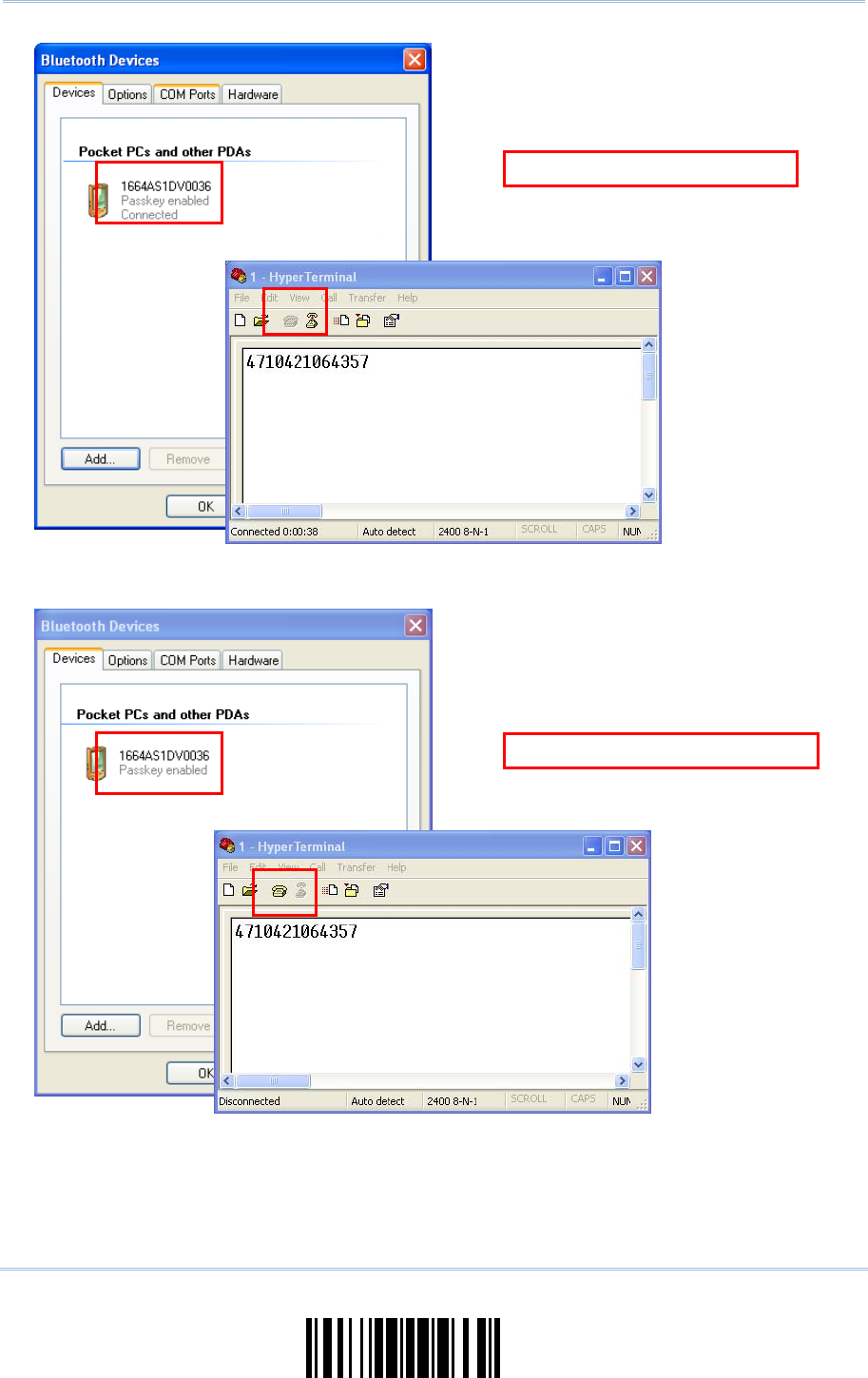
117
Update
Chapter 3
Set up a WPAN Connection
B
luetooth
®
S
PP Connecte
d
B
luetooth
®
S
PP Disconnecte
d

118
Enter Setup
1662 L/1664 Barcode Scanner User Guide
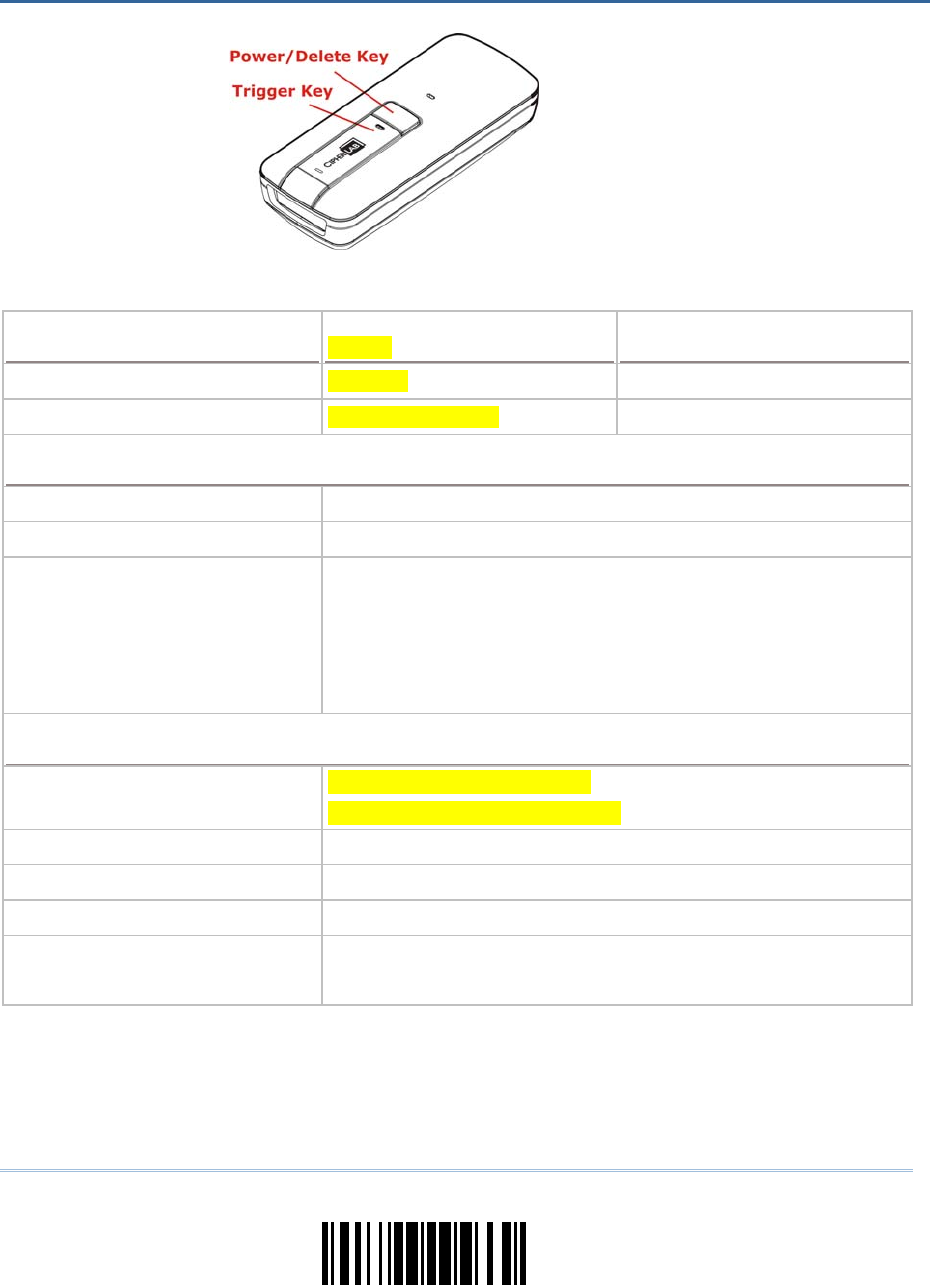
119
Update
Optical Characteristics 1662 L 1664
Scan Engine 1D Laser 2D Imager
Light Source Visible Laser Diode Visible Red LED
RF Characteristics
WPAN Module Bluetooth® Class 2 compliance
Coverage (line-of-sight) 20 meters with 3610
Interface Supported Serial Port Profile (Bluetooth® SPP)
Human Interface Device Profile (Bluetooth® HID)
3610
Direct USB HID
Direct USB Virtual COM
Physical Characteristics
Memory 10 KB for transmit buffer
4MB flash for memory mode
Switch Push-button switch for [Trigger] key, plus [Power/Delete] key
Indication Triple-color LED (Red/Green/Blue) and beeper
Dimensions 113 x 44.9 x 29.9 mm
Weight 106g (With Battery)
83g (Without Battery)
SPECIFICATIONS

120
Enter Setup
1662 L/1664 Barcode Scanner User Guide
Electrical Characteristics
Battery Rechargeable Li-ion battery — 3.7 V, 850 mAh
Environmental Characteristics
Temperature Operating
Storage
0 °C to 50 °C
-20 °C to 60 °C
Humidity
(Non-condensing) Operating
Storage
10% to 90%
5% to 95%
Resistance
Electrostatic Discharge ± 15 kV air discharge, ± 8 kV contact discharge
Programming Support
Configuration via Setup Barcodes Use setup barcodes or host serial commands.
Software Windows®-based ScanMaster
Firmware upgradeable Download firmware updates via the download utility.
Accessories (√ means “supported”)
CipherLab Dongle(3610) √
Rechargeable Li-ion Battery √
Direct USB Cable √
Wristband √
Protective Cover (Pouch) √
Single Battery Charger √

121
Update